







MAGAZINE
Anno 2022 numero 3
Direttore Editoriale: Paola Cacianti

Direttore Responsabile: Enzo Millepiedi
Editore: NERO Lifestyle Srl
Piazza Castello, 26 - 20121 Milano Tel +39 0187 599737 info@nerolifestyle.com
Redazione: NERO Lifestyle Srl Piazza Castello, 26 - 20121 Milano info@nerolifestyle.com
Responsabile Progetto: Beatrice Bellotto Grafica e impaginazione: DigiSide
Copertina: Armando Intignano
Hanno collaborato: Armando Intignano, Gianluca Luciani, Giulia Buzzi, Giulia Filiè, Renato Palazzi, Virginia Zullo
Photo: Alessandro Giannaccini, Azure, Beatrice Pilotto, Brambilla e Serrani, Damaride Arzà, Droneactivity, Federigo Salvadori, Francesca Pagliai, Ftfoto, Gaia Menchicci, Giuliano Sargentini, Lavinia Colonna Preti, Luca Dini, Matteo Carassale, Meschina, Nicola Gnesi, Piredda Studio, Simone Tarca, Stefano Butturini, Stefano Marinari, Studio Reskos, The Italian Sea Group, We Wealth
Traduzioni: Verto Group Stampa: Seven Seas Srl, Faetano Repubblica di San Marino
Info pubblicità: NERO Lifestyle Srl
Nero Lifestyle Magazine Autorizzazione Tribunale della Spezia n. 2/2016 - Registro Stampa Prot. N. 1417/16 del 18.09.2016
L’articolo della pagina 160 è stato gentilmente concesso da YLM. Tutti i diritti riservati. È vietata la riproduzione di testi e immagini di proprietà senza il permesso scritto dell’editore.
IL SOGNO ITALIANO
di/by Paola Cacianti
L’anima, lo stile, diciamo pure il “sogno” italiano, il modo in cui gran parte del mondo vorrebbe vivere è da sempre riferito al quotidiano. Cosa facciamo ogni giorno? Ci vestiamo, mangiamo, cerchiamo di costruire attorno a noi una casa il più possibile bella e confortevole. La moda, il design, la nostra cucina sono la stella polare del buon vivere. Poi abbiamo intorno, ovunque il “fuori”, il contesto di un paese che custodisce il settanta per cento dei beni culturali del mondo e non c’è piccolo o piccolissimo centro che non comunichi sorpresa, meraviglia e bellezza. Se poi tutto questo si lega alla fantasia, al coraggio di buttare il cuore oltre l’ostacolo, al senso gioioso e profondo che gli italiani hanno per la famiglia, ecco che il quotidiano diventa progetto imprenditoriale. Non solo un progetto economico/imprenditoriale ma la realizzazione di una concezione di vita. Le storie personali di un certo tipo di italiani, come quella di Antonino Cannavacciuolo, sono quelle che, più del marchio, affascinano il mondo. Analogamente a un Armani o a un Del Vecchio, il nostro mirabile Chef parte dalla provincia, affronta un duro apprendistato, coniuga nord e sud, pasta e pesce della Campania con formaggi e carne del Piemonte, il mare e il lago, la modernità e la sorpresa con il recupero di un meraviglioso bene culturale come Villa Crespi. Un luogo che diventa la sua casa e anche la “casa” di chi ospita. Un’avventura (quotidiana) inimitabile, chiamata ITALIA.
THE ITALIAN DREAM
The Italian soul, the style, the - let’s put it that way - dream, the way that many people all over the world would like to live has always referred to everyday life. What do we do on a daily basis? We get dressed, we eat, we attempt to build around us a home that is as lovely and comfortable as possible. Our fashion, our design, our cuisine are the guiding star of good living. Around us, we also have the “outside”, the context of a country that holds seventy per cent of the world’s cultural heritage, where there is no small or very tiny hamlet that fails to provide us with awe, wonder and beauty. If, in addition to all this, we also add creativity, the courage to overcome obstacles, the deep and joyful sense that Italians have for their families, then our everyday life becomes an enterprise project. Not only a business/economic venture, but the fulfilment of an idea of living. The personal stories of a certain type of Italian, like that of Antonino Cannavacciuolo, are those that, more than the brand itself, fascinate the world. Similarly to Armani or Del Vecchio, our amazing Chef begins in the province, goes through a hard apprenticeship, conjugates north and south, pasta and seafood from the Campania region with Piedmont cheese and meat, sea and lake, modernity and awe with the recovery of a marvellous cultural asset such as Villa Crespi. A place that becomes his home as much as the “home” of those it hosts.
An (everyday) adventure without equal, called ITALY.
3
EDITORIAL
Centro


When you want to catch your breath. When you want to lose it. New Taycan Sport Turismo. Soul, electrified. Life is the most exciting sport. Face it with a partner who knows when to accelerate like you and when it is time to enjoy your own spaces. Discover it in the Porsche Centers of Bologna, Modena and Mantova. Combined power consumption (model variants): 24,0 - 22,5 kWh/100 km. Emissions CO₂ combined: 0 g/km Centro Porsche Bologna Vanti Sport S.r.l. Via Monterumici 15, Bologna Tel. 051 3145811 www.bologna.porsche.it Centro Porsche Modena Vanti Sport S.r.l. Via Emilia Est 1463, Modena Tel. 059 2862011 www.modena.porsche.it
Porsche Mantova Vanti Sport S.r.l. Via Parigi 4, Porto Mantovano Tel. 0376 408715 www.mantova.porsche.it
IL RINASCIMENTO ITALIANO nell’arte dell’ospitalità
di/by Andrea Delfini

C
reatività e gusto ci appartengono. Non ci sono paragoni che possano reggere al confronto nell’arte dell’ospitalità, grazie certo ad un luogo fortunatamente e fantasticamente unico, ma grazie anche a noi e all’intelligenza del saper vivere bene e del saperlo donare e condividere con amabile saggezza e cortesia. Il mondo ce lo riconosce. E ci apprezza e ci ammira per questo essere maestri nella ricettività che segna quest’epoca di Rinascimento ancora una volta tutto italiano. Non avviene per caso che i più grandi gruppi internazionali stiano investendo sull’Italia come non era mai accaduto. Di questo NERO Lifestyle vuole essere testimonianza e racconto dei tanti pregi di questa contaminazione felice e ricca di originalità delle quali essere orgogliosi. E così ha voluto che fosse Antonino Cannavacciuolo ad interpretare e rappresentare questo nostro modo di essere. Perché Antonino non solo è uno dei più grandi Chef riconosciuti a livello mondiale, ma è anche il personaggio che incarna lo spirito italiano del fare e di inventare resort negli ambienti più originali con quel coraggio e con quella capacità imprenditoriale che sono l’emblema della nostra concezione e del nostro sentire il piacere e il gusto dell’ospitalità.
THE ITALIAN RENAISSANCE IN THE ART OF HOSPITALITY
Creativity and style belong to us. There are no comparisons that can stand up to our art of hospitality, thanks to a - fortunately and fabulouslyunique venue, but also thanks to us as people, and our ability to live well and share this gift with loving wisdom and courtesy. The world recognises this in us. And appreciates and admires us for our exquisite hospitality, that distinguishes this era of Renaissance, which is once again fully Italian. It is no coincidence that the largest international groups are investing in Italy as never before. NERO Lifestyle wishes to bear witness of this and serve as an example of the many merits of this happy and profoundly original combination we are so proud of. For this reason, we have asked Antonino Cannavacciuolo to interpret and represent our way of being. Because Antonino is an icon not only as one of the world’s greatest Chefs, but he is also the person that embodies the Italian spirit of creating and inventing resorts in the most original environments with that courage and with that entrepreneurial ability that are the emblem of our approach and of our enjoyment and flair for hospitality.
5
THE EDITOR
The Italian Sea Group, Giovanni Costantino, la passione per le sfide
apassionforchallenges
I monti del marmo Marble mountains
Carrara e la bianca pietra Carrara and the white stone
Alpemare, dove riscoprire la Dolcevita Alpemare,redescoveringtheDolcevita
Penske Automotive Italy PenskeAutomotiveItaly
L’esperienza unica dell’immersive art experience
Il teatro mentale di Marco Nereo Rotelli The mental theatre of Marco Nereo Rotelli
Il gusto del futuro - Antonino Cannavacciuolo
Thetasteoffuture-AntoninoCannavacciuolo
Guardiamo (e proteggiamo) il mare con Neptune Welookat(andprotect)theseawithNeptune
Deepseaker. Vivere il mare in modo nuovo Deepseaker.Experiencetheseainanewway
194 L'atelier Liverano & Liverano AtelierLiverano&Liverano
206 Antonio Signorini. Dall’archeologia all’incanto AntonioSignorini.Fromarchaeology to enchantment
226 Villa Brasini Brauty Clinic, l’eccellenza al servizio della bellezza VillaBrasiniBeautyClinic,excellenceat theserviceofbeauty
242 Per volare in alto là dove osano le Aquile. Toflywayup,wheretheEaglesdaretogo.
258 Fondazione Cotarella. Alimentarsi di vita FondazioneCotarella.Feedingonlife
264 Catrinel Marlon, testimonial Nero Lifestyle, nuovo direttore creativo per Nanàn CatrinelMarlon,testimonial ofNeroLifestyle,newcreativedirector for Nanàn
Borgo Antichi Orti
Borgo Scopeto Wine & Country Relais Siena
Borgobrufa SPA Resort Torgiano
Botania Relais & Spa Ischia
Colonna Resort Porto Cervo
D.O.M Hotel Roma
Glass House & SPA Monferrato
Grand Hotel et de Milan Milano
Grand Hotel Imperiale Forte dei Marmi
Grand Hotel Royal & Golf Courmayeur
Hotel Metropole Venezia
La Sommità Relais Ostuni
Laqua by the Lake Lagod’Orta
Laqua by the Sea Golfo di Sorrento
Laqua Countryside Golfo di Sorrento
Laqua Vineyard Casanova di Terricciola
Li Finistreddi Exclusive Country Retreat Costa Smeralda
Masseria Palombara Salento
Minareto Siracusa
Miramare The Palace Hotel Sanremo
Palazzo Dama Roma
Palazzo Manfredi Roma
Palazzo Scanderbeg Roma
Piccolo Sant’Andrea Luxury Suite Hotel & SPA Praiano
Punta Tragara Capri
Relais La Costa Siena
Sextantio Le Grotte della Civita Matera
Sikelia Pantelleria
Tenuta Le Cave Verona
The Place Firenze Firenze
Therasia Resort Sea & Spa Vulcano
Villa Cortine Palace Hotel Sirmione
24 Obélisque Dosage Zero ObélisqueDosageZero
6 28
Assisi 32
44
48
60
64
74
78
96
100
112
116
126
130
152
156
166
170
180
184
188
198
202
214
218
222
234
238
250
254
266
270
274 SOMMARIO Summary 3 Editoriale Editorial 5 Intro The Editor 6 Sommario Summary 10
TheItalianSeaGroup,GiovanniCostantino,
38
52
69
84
104
Theuniqueimmersiveartexperience 120
136
160
175
ALPINE EAGLE
Con il suo design essenziale e raffinato, Alpine Eagle reinterpreta in chiave contemporanea uno dei nostri modelli storici. La cassa di 41 mm ospita il calibro automatico Chopard 01.01-C con Certificato di Cronometria COSC. Realizzato in Lucent Steel A223, un acciaio esclusivo e ultraresistente risultato di quattro anni di ricerca e sviluppo, questo straordinario segnatempo, progettato e fabbricato dai nostri artigiani, è la quintessenza della maestria e della creatività della nostra Manifattura.




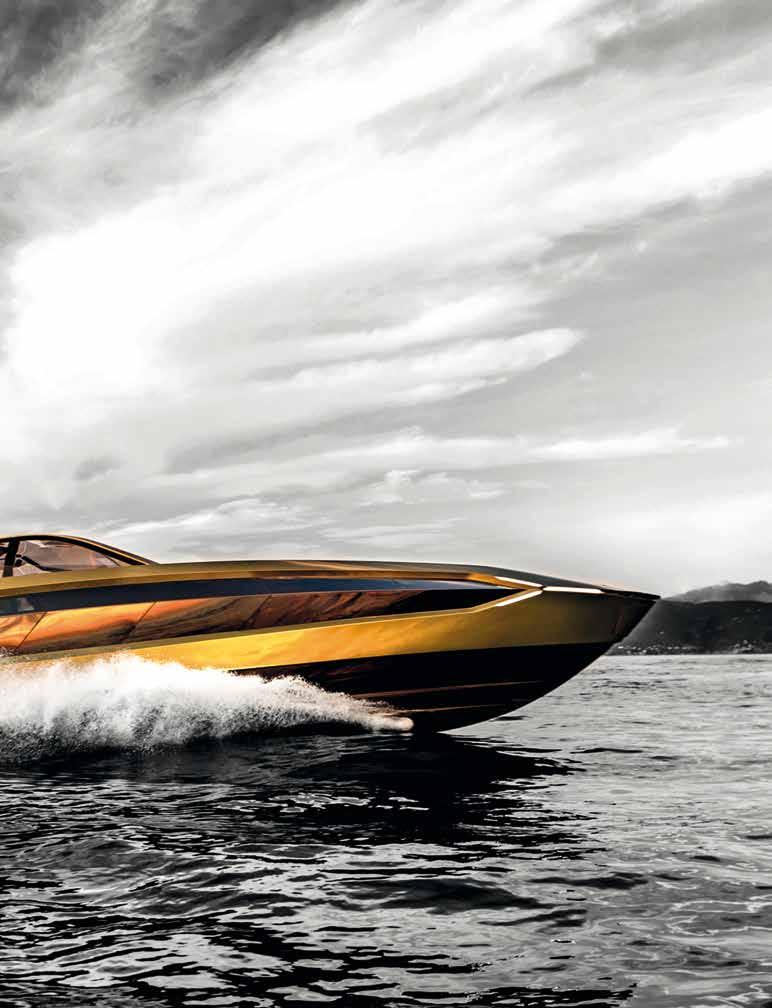
THE ITALIAN SEA GROUP
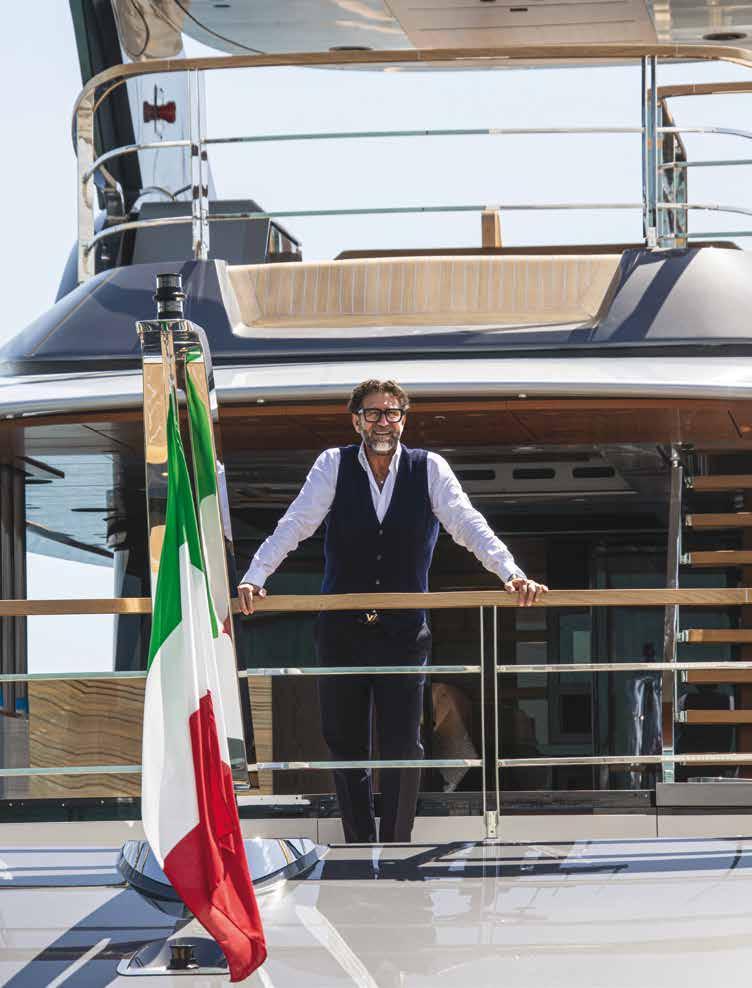 di/by Enzo Millepiedi
di/by Enzo Millepiedi
10 GIOVANNI COSTANTINO, LA PASSIONE PER LE SFIDE
photo: Azure, Droneactivity, Giuliano Sargentini, Luca Dini, Piredda Studio, Simone Tarca, Studio Reskos, The Italian Sea Group,
We Wealth
Potrebbe apparire come la storia di un self made manager quella di Giovanni Costantino, Founder e CEO di The Italian Sea Group, ma è la straordinarietà della sua irresistibile ascesa, a tutto tondo, che la rende non tipica e non comune per la sua originalità nella capacità mai tattica ma sempre strategica di vedere oltre l’orizzonte, senza lasciare mai nulla al caso. Come ha dimostrato, stando agli eventi più recenti, con la consegna del primo Tecnomar for Lamborghini 63 a Miami, in perfetta linea con il piano di espansione commerciale negli USA già avviato a inizio stagione, con l’apertura del primo flagship store a East Hampton, Long Island, zona di riferimento per la nautica della costa orientale americana. Come aveva dimostrato lo scorso anno quando ha giocato la sua partita fino in fondo rilevando lo storico e blasonato brand Perini Navi, leader
mondiale nella progettazione e realizzazione di navi a vela di grandi dimensioni, già proprietario di Picchiotti Yacht, altro storico brand della nautica italiana. Operazione che ha completato l’offerta di prodotto di The Italian Sea Group che dai 20 dipendenti che aveva all’acquisizione di Tecnomar nel 2009, ha raggiunto 530 dipendenti in Italia, oltre 1.000 risorse dell’indotto, nonché 1200 risorse all’estero. È arrivato ad operare su una superficie di 250.000 metri quadrati tra Marina di Carrara, Viareggio e La Spezia, oltre ad avere sedi commerciali negli Stati Uniti, America del Sud, Cina, Asia, Hong Kong, Grecia, Cipro, Turchia, Egitto, Emirati Arabi, Dubai - Abu Dhabi, Libano e Azerbajan. Da aggiungere, per completezza, che attraverso la controllata The Italian Sea Group Turkey, è operativa su cinque siti produttivi in Turchia. Basterebbero questi indiscutibili successi per spiegare la capacità decisionale e la dinamica
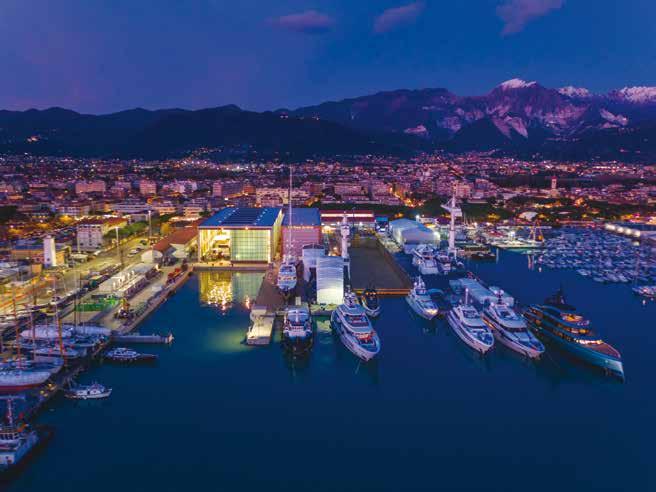
11
creatività imprenditoriale per riassumere - come tratti distintivi - tutta la storia di Giovanni Costantino, classe 1963, che a 19 anni dà vita a un’azienda di ristrutturazioni edili e attività commerciali, specializzandosi - vocazione sartoriale innata - negli arredi su misura. Per altri pur bravi imprenditori quello potrebbe essere il suo futuro, non per lui che ha lo sguardo lungo che lo porta ad aprire un punto vendita a Parigi, dove è tra i fornitori della Bibliotèque Nationale de France. Non passa inosservata la sua intraprendenza che attira l’attenzione di Pasquale Natuzzi, fondatore e “patron” dell’omonimo gruppo quotato nella Borsa di New York. Lo vuole con sé in azienda. Una nuova sfida? Pronto. Nel 1998 Costantino cede la sua attività per assumere il ruolo di Direttore R&S e della nascente “Business Unit Furniture” della Natuzzi S.p.A. della quale diventa, nel 2000, Direttore Generale e Amministratore Delegato della “Business Unit Furniture”. Ancora una volta quello potrebbe essere il suo futuro. Ma non per Costantino che ha nella testa e nel cuore l’insopprimibile sogno che nel 2009 gli fa lasciare

la Natuzzi per tornare alle sfide di un progetto da sviluppare ex-novo, dove poter esprimere al meglio le sue capacità, la passione, le competenze e le conoscenze acquisite. Ed è la svolta vera, quella che Giovanni Costantino attendeva. Cambia prospettiva, entra nella cantieristica nautica con decisione e dinamismo per creare - ha le idee chiare - un modello di business lungimirante e del tutto nuovo per il mondo dello yacthing, basato su una filiera produttiva totalmente insourcing, in grado di controllare in maniera chirurgica ogni minimo dettaglio dalla fase di progettazione all’after sale. E da allora il ritmo diventa sostanza di un processo che a un osservatore distratto potrebbe apparire frenetico ma che è invece costruzione coraggiosa ma oculata, per step, di un disegno di chi ha avuto la voglia e la forza di sfidare il mercato, per lui nuovo, della nautica, introducendo strategia e processi nuovi, con decisioni a volte controcorrente ma sempre risultate vincenti, anche grazie alla costanza, tenacia e una totale dedizione. Punta alla qualità dell’alta gamma Costantino da subito. Lo si capisce quando nel 2009 acquista dal Fondo Palladio Tecnomar, storica azienda della nautica italiana, conosciuta per la sportività, il design all’avanguardia e le alte performance dei suoi yacht fino a 45 metri. Nel 2011 acquisisce il brand Admiral, rinomato per la produzione di superyacht oltre i 50 metri. Nel 2012 rileva dal Ministero dello Sviluppo Economico, attraverso Invitalia, la società Nca, Nuovi Cantieri Apuania, storico cantiere navale di Marina di Carrara. Non perde tempo. Non è da lui. Studia, valuta, allunga lo sguardo e l’anno successivo, nel 2013, avvia un programma pluriennale di investimenti per ristrutturare il vecchio cantiere e creare, come punto di partenza, un’area destinata alle attività di refit diventata la più grande struttura nautica del Mediterraneo consentendo all’azienda di sostenere nel tempo l’incremento dimensionale delle commesse.
Ed ecco che arriva il momento più atteso: la nascita di The Italian Sea Group, oggi operatore globale della nautica di lusso per la costruzione e il refit di motoryacht e navi fino a 140 metri con i brand Admiral, Tecnomar e NCA Refit, affermandosi sempre più come punto di riferimento per una clientela internazionale altamente sofisticata. Ma The Italian Sea Group non deve essere solo un
12
cantiere della grande nautica, deve essere un Luogo, sì con la elle maiuscola, nel quale, in coerenza con la sua visione e la sua cultura imprenditoriale, si esprima il rispetto e l’attenzione verso i clienti e i collaboratori, che per Costantino sono fondamentali. Nasce, all’interno del cantiere, il “The Village”, area dedicata al benessere e all’intrattenimento di manager, dipendenti, armatori, comandanti ed equipaggi, con a disposizione un ristorante gourmet, un lounge bar, una palestra attrezzata, una Spa e un centro estetico. Nel rispetto ovviamente della migliore italianità. Così impostato The Italian Sea Group è pronto a volare sempre più in alto. Seguendo la sua passione per il design e in linea con la strategia di brand extension con marchi del luxury (fashion e high technology italiani) coerenti con l’elevato posizionamento di TISG, nel 2020 Giovanni Costantino dà vita al progetto “Tecnomar for Lamborghini63”, yacht di 63 piedi disegnato con la casa automobilistica Automobili Lamborghini di Sant’Agata Bolognese, ispirato alla Sian FKP 37 in grado di raggiungere i 60 nodi. A giugno 2021
viene varato il primo yacht, definito “l’avanguardia delle luxury speed boat”, la perfetta unione di performance, tecnologia e alto design italiano, un progetto dal successo di levatura internazionale. Nel 2021 un’altra partnership d’eccellenza viene con Giorgio Armani per progettare nuovi motor yacht Admiral. È così che suscita una grande curiosità a livello internazionale mentre si conferma la capacità di realizzare progetti unici con brand con cui condivide gli stessi valori e italianità. L’azienda, conquistato il quarto posto nel ranking mondiale tra i costruttori di navi oltre 50 metri, debutta, nel giugno 2021, sul Mercato Telematico Azionario di Borsa Italiana S.p.A. Il debutto è strepitoso: il titolo TISG chiude con un +7,16% sul prezzo di offerta e una domanda tre volte superiore alla stessa offerta, includendo due cornerstone investors: l’imprenditore belga Marc Coucke, con il 10% circa dell’azienda e Giorgio Armani, entrato in gioco con il 5% della società. Il giovane intraprendente che è stato non dimentica e gioca d’anticipo sulla formazione ed è per creare opportunità per giovani intraprendenti
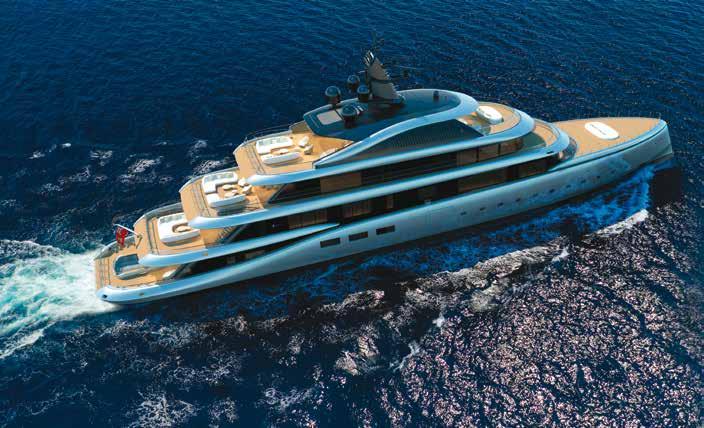
13
M/Y Kensho 75 Admiral
che nella primavera del 2021 inaugura la TISG Academy dedicata a percorsi di approfondimento per i dipendenti dell’azienda e per studenti laureandi delle facoltà di Ingegneria Nautica e di Ingegneria Meccanica a indirizzo Meccatronico e del corso di laurea magistrale in Yacht Design, delle Università di Genova e della Spezia, l’Università di Trieste e di Napoli. Va anche oltre: promuove la nascita di diversi progetti formativi oltre che percorsi di ricerca e tirocinio per i giovani, a cui rivolge grande attenzione ed energie. Ed infatti, nel 2022 il 65% delle assunzioni è “under 35” e ciò favorisce la crescita di un team estremamente dinamico, propositivo e qualificato. Gioca d’anticipo anche per la nuova sfida dei tempi sia in azienda sia nel prodotto. Fa installare un impianto di pannelli fotovoltaici su tutti i capannoni industriali con i quali copre il 25% del consumo energetico del cantiere e riduce le emissioni di CO2 per 1.208 tonnellate ogni anno e prevede l’installazione di colonnine elettriche da 22kW per alimentare il parco auto, e produce navi quasi esclusivamente con motori ibridi con bassissime immissioni sia in mare sia in atmosfera, continuando a investire in ricerca e sviluppo per arrivare a yacht full electric e a propulsione ad idrogeno. È guardando i modelli dei suoi yacht che si scopre in Costantino il culto
e il gusto della bellezza funzionale della quale solo un mecenate e un cultore dell’arte, quale è, vuole godersi e far godere a ospiti e dipendenti nella azienda trasformata in una galleria a cielo aperto con l’esposizione di opere, di artisti emergenti e galleristi, collocate in tutto il cantiere creando un ambiente estremamente dinamico e stimolante, con un’unicità riconosciuta in tutto il mondo. Resta la non meno importante attenzione alla responsabilità sociale dell’impresa estesa alla socialità, alla comunità, alle istituzioni e al territorio, in cui l’azienda vive e prospera. E che Giovanni Costantino sente forte. Dal 2018 Giovanni Costantino è Presidente della Commissione nautica di Confindustria Toscana e da sempre sostiene iniziative ad elevato valore sociale da parte di istituzioni laiche e religiose, tra cui il sostegno alle famiglie bisognose del Comune di Carrara, anche nei momenti di emergenza sanitaria, e attività di solidarietà verso la popolazione ucraina, oltre a fare donazioni ad organizzazioni per la prevenzione e il sostegno dei pazienti oncologici, a quelle che si occupano di disagio sociale e ad associazioni per la tutela delle donne, oltre a rivolgere una particolare attenzione alle dipendenti presenti in azienda. Sostiene infine interventi per il miglioramento urbano e a sostegno delle attività locali di concerto con
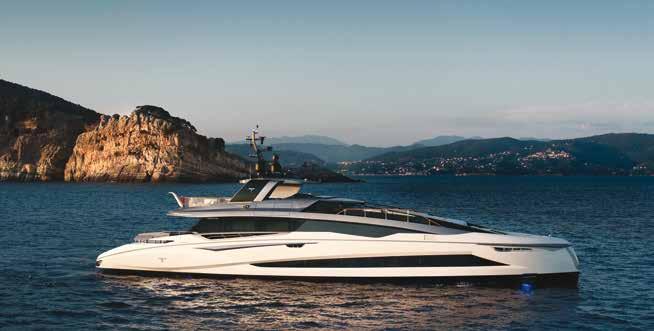
14
M/Y Tecnomar EVO 120
le amministrazioni civiche. E intanto gli ottimi risultati registrati nel primo semestre del 2022 sono - ha dichiarato un soddisfatto e orgoglioso Costantino - la conferma della solidità del nostro progetto di sviluppo aziendale in linea con la guidance 2022, nonostante un contesto macroeconomico e geopolitico complesso. E continua il rafforzamento dei nostri brand in nuovi mercati, con entusiasmanti prospettive di crescita e grande energia commerciale per tutti i prodotti, come dimostrato dalle nuove partnership con i più importanti broker internazionali e dall’espansione della nostra presenza commerciale in location strategiche, come il flagship store aperto a giugno a Porto Cervo, nel cuore di una delle mete più rinomate della nautica e del lusso internazionale”.
E per Perini Navi e Picchiotti? “Nei prossimi mesi proseguiranno le attività di rilancio dei due brand che continuano a suscitare forte interesse da parte degli Armatori di tutto il mondo, soprattutto
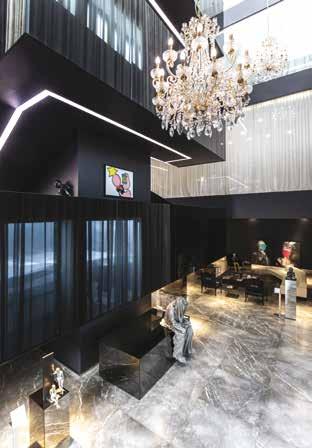



15
The Italian Sea Group Headquarter
M/Y Geco 55 Admiral
M/Y Panorama Admiral
M/Y Geco 55 Admiral
in America, Asia e Medio Oriente. La nuova flotta Picchiotti è un ampliamento strategico del nostro range di prodotti e rende omaggio ad un brand riconosciuto come patrimonio storico dell’industria nautica, rivolgendosi a una nicchia di clienti che amano l’eleganza senza tempo delle linee classiche. Per la fine dell’anno, presenteremo la flotta Perini Navi completamente rinnovata nello stile, svelando inoltre il modello del “nuovo Maltese Falcon”, che sarà iconico e innovativo nell’estetica e nella tecnologia.” Da notare, a proposito di tempistica, che è arrivato a soli sei
mesi dalla sua acquisizione l’annuncio della nuova flotta che riporta in auge il marchio Picchiotti, nome che dal 1575 rappresenta l’eccellenza e l’eleganza della tradizione navale italiana. Il progetto, nato dalla collaborazione con Luca Dini e la sua Design & Architecture rappresenta l’intesa tra le idee ed esigenze di rilancio di TISG, che aveva l’obbiettivo di ripercorrere l’essenza stilistica storica di Picchiotti, con la partecipazione di Kurt Lehman e la sua Yacht Moments Consultant. La flotta, con il nome “Gentleman”, introduce TISG nel segmento della produzione in serie di yacht e
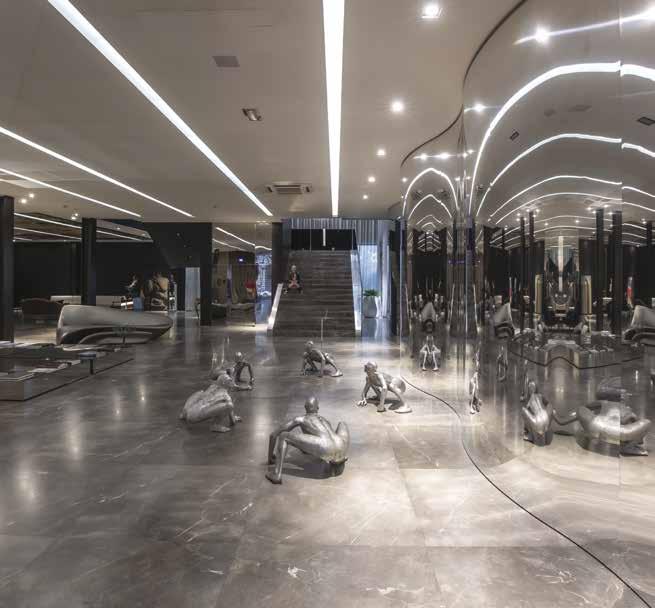
16
The Italian Sea Grop Headquarter
superyacht, mantenendo fermo il posizionamento ultra high-level. Il progetto nasce dall’ambizione di creare un prodotto ispirato alla silhouette dei panfili americani degli anni ’60 declinando con esclusività ed eleganza le linee classiche senza tempo, con soluzioni ingegneristiche innovative e un design unico e distintivo. Come dire un invito a una navigazione più a misura d’uomo, un tuffo nell’aristocrazia del dopoguerra, sinonimo di libertà in mare, con il plus di confort e lusso di un superyacht. La ricerca stilistica di Luca Dini ha incontrato la visione di Giovanni Costantino: “Questa nuova linea, ispirata agli anni d’oro dello yachting del dopoguerra, sia per il layout che per i materiali, mi ha conquistato perché rende omaggio a modelli storici come la Serie Giglio o la Serie Mistral di Picchiotti, esaltandone i valori stilistici e la cultura del mare. Sono molto orgoglioso di dare nuova voce ad un brand patrimonio di tutta l’industria nautica, uno dei cantieri più antichi al mondo”. Il 15 Luglio è stata posata la chiglia del primo Gentleman Picchiotti che andrà in consegna già nell’estate del 2024 e ne sono già programmati altri 15. Non possiamo congedarci dal significativo incontro con questa
realtà imprenditoriale spumeggiante senza un omaggio a “Panorama”, il progetto del nuovo superyacht di 50 metri della flotta Admiral, flagship brand di The Italian Sea Group, profilo elegante e senza tempo, autentico capolavoro made in Italy per forme, linee e soluzioni stilistiche, nate dalla collaborazione di TISG con il team dello studio Piredda & Partners che ne ha curato il design degli esterni e degli interni. “Grazie all’acquisizione di Perini Navi e all’ampliamento dei siti produttivi, si è reso possibile un importante aumento della capacità produttiva - afferma Giovanni Costantinoe con il progetto Panorama anche Admiral, così come Picchiotti, entra nel segmento della produzione seriale, sempre - facciamo notare il richiamo - con altissima qualità e cura maniacale dei dettagli degli impianti e degli interior. La produzione seriale ci consentirà di ampliare le vendite evitando il coinvolgimento della capacità progettuale del Gruppo impegnata verso i grandi yacht custom made. Nonostante la serialità restiamo fedeli alla strategia, ovvero la produzione di ogni singolo yacht viene avviata solo sul venduto e senza permute”.

17
M/Y Panorama Admiral



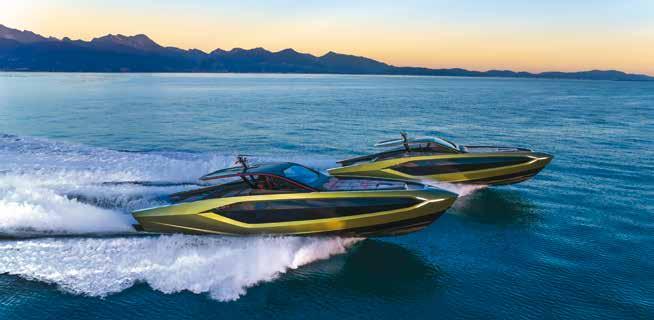
18


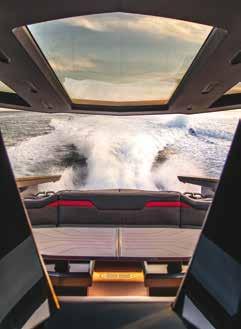
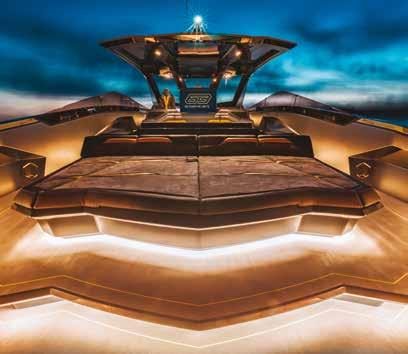
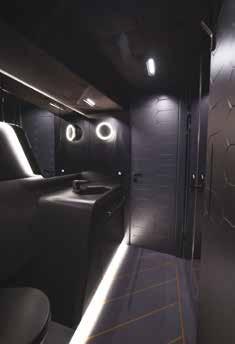
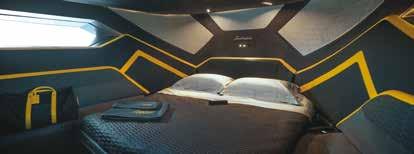

19 M/Y Tecnomar for Lamborghini 63
THE ITALIAN SEA GROUP GIOVANNI COSTANTINO, A PASSION FOR CHALLENGES
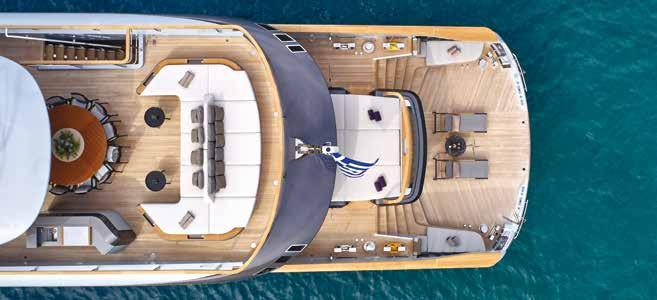
That of Giovanni Costantino, Founder and CEO of The Italian Sea Group, might seem like the story of a self-made manager, but it is the extraordinary nature of his irresistible, all-round ascent that makes it unique and uncommon due to his authenticity in his never tactical but always strategic ability to see beyond the finish line, never leaving anything to chance. This was demonstrated, according to the most recent events, with the delivery of the first Tecnomar for Lamborghini 63 in Miami, in perfect harmony with US market expansion plan initiated at the beginning of the season with the opening of the first flagship store in East Hampton, Long Island, a point of reference area for the East Coast yachting industry. He also proved this last year when he showed his hand, taking over the historic and coveted Perini Navi brand, a world leader in the design and construction of large sailing yachts, already owner of Picchiotti Yacht, another historic Italian yacht brand. Operation that completed the “The Italian Sea Group” product range, growing from its 20 employees when Tecnomar was purchased in 2009, to 530 employees in Italy, over 1,000 resources in the related sector, as well as 1,200 resources abroad. It now operates in a 250,000 square-metre area between Marina di Carrara, Viareggio and La Spezia, in addition to having business offices in the United States, South America, China, Asia, Hong Kong, Greece, Cyprus, Turkey, Egypt, United Arab Emirates, Dubai – Abu Dhabi, Lebanon and Azerbaijan. To boot, for completeness, it operates in five production sites in Turkey through the “The Italian Sea Group” Turkey subsidiary. These unquestionable successes would be enough to narrate the decision-making capacity and the dynamic entrepreneurial creativity to summarise - as distinctive traits - the whole story of Giovanni Costantino, born in 1963, who at the age of
19 created a building renovations and sales company, specialising –with his innate tailoring vocation - in custom furnishings. For other good businessmen, that could have been their future but not for him whose long gaze led him to open a store in Paris, where he was among the Bibliotèque Nationale de France suppliers. His initiative does not go unnoticed and attracts the attention of Pasquale Natuzzi, founder and “patron” of the group of the same name listed on the New York Stock Exchange. He wants him with him at the company. A new challenge? Ready. In 1998, Costantino sold his business to take on the role of R&D Director and the nascent Natuzzi S.p.A. “Business Unit Furniture”, where, in the year 2000, he became General Manager and “Business Unit Furniture” Chief Executive Officer. Once again, that could have been his future. But not for Costantino who has an irrepressible dream in his head and heart, driving him to leave Natuzzi in 2009 to return to the challenges of a project to be developed from scratch, where he can best express his abilities, passion, skills and acquired know-how. And it is the real turning point, the one that Giovanni Costantino was waiting for. He changed perspective, entering the shipbuilding industry with determination and dynamism to create – with his clear ideas – a forward-looking and entirely new business model for the world of yachting, totally insourcing the production chain and surgically controlling every detail from the design phase to after-sales. Since then, rhythm became the substance of a process that could seem frenetic to a distracted observer but that is, instead, a courageous but careful, step-by-step construction of a design by someone who had the desire and the strength to challenge the yachting market, for him new, introducing new strategies and processes, with decisions sometimes against the grain but always winning, also thanks to his constancy, tenacity and a total dedication. Right from the start, Costantino focused on the top range quality. This can be seen
20
M/Y Geco 55 Admiral
when he bought Tecnomar from Palladio in 2009, a historic Italian yachting company, known for its sportiness, cutting-edge design and the high performance of its yachts up to 45 metres. In 2011 he acquired the Admiral brand, renowned for the production of superyachts over 50 metres. In the 2012 he took over Nca, Nuovi Cantieri Apuania, historical ship yard in Marina di Carrara, from the Ministry of the Economic Development, through Invitalia. He doesn’t waste time. It’s not like him at all. He studied, evaluated, looked beyond and, the following year, 2013, he initiated a multiyear investment plan to renovate the old construction site and create, as a starting point, an area for refit activities that has now become the largest ship yard in the Mediterranean, allowing the company to support the increase in the size of orders over time. The most anticipated moment finally arrived: the establishment of The Italian Sea Group, today a global operator of luxury yachts for the construction and refit of motor yachts and ships up to 140 metres with the Admiral, Tecnomar and NCA Refit brands, increasingly establishing itself as a point of reference for a highly sophisticated international clientèle. But The Italian Sea Group is not intended to only be a great yachting shipyard, but a Place – yes with a capital letter – where, in line with his vision and entrepreneurial culture, the elements key to Costantino, respect and attention to
customers and collaborators, are expressed. “The Village”, an area dedicated to the well-being and entertainment of managers, employees, shipowners, commanders and crews, was created within the construction site, with a gourmet restaurant, a lounge bar, an equipped gym, a spa and a beauty centre. Obviously respecting the best of Italy. In these settings, The Italian Sea Group is ready to soar even higher. Following his passion for design and in line with the brand extension strategy with Italian luxury brands (fashion and high technology) consistent with TISG’S lofty positioning, in 2020 Giovanni Costantino gave life to the “Tecnomar for Lamborghini63” project, a 63-foot yacht designed with the Lamborghini automotive company in Sant’Agata Bolognese, inspired by the Sian FKP 37 capable of reaching 60 knots. The first yacht was launched in June 2021, called “the forerunner of luxury speed boats”, the perfect combination of performance, technology and top Italian design, a project with international success. In 2021 another excellent partnership came with Giorgio Armani to design new Admiral motor yachts. This is how he arouses great curiosity at an international level while confirming his ability to create unique projects with brands that share his same values and Italian background. The company, ranked fourth among yacht builders over 50 metres, débuts, in June 2021, on the Borsa Italiana S.p.A. Electronic Stock Market.

21
S/Y Perini 47
The début is a hit: the TISG stock closes with +7.16% over the offer price with a demand three times higher than the offer, including two cornerstone investors: the Belgian entrepreneur Marc Coucke, with about 10% of the company and Giorgio Armani, who came into play with 5% of the company. He hasn’t forgotten his days as a young entrepreneur and gets one step ahead in training to create opportunities for young entrepreneurs, inaugurating the TISG Academy in the spring of 2021, dedicated to in-depth courses for company employees and for Nautical Engineering and Mechanical Engineering undergraduates studying Meccatronico and Yacht Design post-graduate students at the University of Genoa and La Spezia, the University of Trieste and Naples. He goes even further: he promotes the birth of several training projects as well as research and internships for young people, devoting great attention and energy. In fact, in 2022, 65% of new hires are “under 35” and this promotes the growth of an extremely dynamic, proactive and qualified team. He is also one step ahead in meeting the new challenges of our times both in the company and in the product. He installed photovoltaic panels on all industrial warehouses to cover 25% of the yard’s energy consumption and reduced CO2 emissions by 1,208 tons each year. He also provided for the installation of 22kW electric columns to power the car fleet, and almost exclusively produced ships with hybrid engines with very low emissions both at sea and in the atmosphere, continuing to invest in research and development to arrive at full electric and hydrogen propelled yachts. Looking at his yacht models reveals Costantino’s beliefs and bent for functional beauty that only an art patron and lover, such as himself, wants to enjoy for himself and his guests and employees in a company transformed into an open-air gallery exhibiting works, emerging artists and gallery owners, placed throughout the yard to create an extremely dynamic and stimulating environment, with a uniqueness recognised throughout the world. This does not take away from the company’s focus on social responsibility extended to the society, community, institutions and territory where the company lives and thrives and which Giovanni Costantino holds dear. Since 2018, Giovanni
Costantino has been President of the Nautical Commission of Confindustria Toscana and has always supported initiatives of high social value by secular and religious institutions, including support for families in need of the Municipality of Carrara, even in times of health emergency, and solidarity activities towards the Ukrainian population, in addition to making donations to organisations for the prevention and support of cancer patients, those dealing with social hardship and associations for the protection of women, as well as paying particular attention to company female employees. Finally, he supports urban improvements and supports local businesses in conjunction with civic administrations. Meanwhile, the excellent results recorded in the first half of 2022 are – declared a satisfied and proud Costantino – confirmation of the solidity of our business growth plan in line with the 2022 guidelines, despite a complex macroeconomic and geopolitical context. And the strengthening of our brands in new markets continues, with exciting growth prospects and great commercial energy for all products, as demonstrated by the new partnerships with leading international brokers and the expansion of our market presence in strategic locations, such as the flagship store opened in June in Porto Cervo, in the heart of one of the most renowned yachting and international luxury destinations”. What about Perini Navi and Picchiotti? “In the coming months, efforts continue to relaunch the two brands which still arouse strong interest from Shipowners around the world, especially in America, Asia and the Middle East. The new Picchiotti fleet is a strategic extension of our product range and pays tribute to a brand recognised as a historic heritage of the yachting industry, tailoring to a niche of customers who love the timeless elegance of classic lines. We will introduce the completely restyled Perini Navi fleet by the end of the year, also revealing the “New Maltese Falcon” model which will be iconic and innovative in aesthetics and technology.”
Speaking of timing, just six months after its acquisition, a new fleet was announced to return the Picchiotti brand to its former glory, a name that has represented the excellence and elegance of the Italian naval tradition since 1575. The project, arising from the partnership with Luca Dini and his Design & Architecture, represents the harmony between the TISG’S renovation ideas and needs, aimed at revisiting the historical stylistic essence of Picchiotti, with the participation of Kurt Lehman and his

Moments

22
Yacht
M/Y
Gentlmen 33 Picchiotti S/Y Perini 47
Consultant. The fleet, named “Gentleman”, introduces TISG in the yacht and superyacht mass production sector, maintaining the ultra high-level positioning. The project arose from the ambition to create a product inspired by the 1960’s American yacht silhouette, deftly and elegantly restyling the timeless classic lines with innovative engineering solutions and a unique and distinctive design. As if to say an invitation to a more user-friendly navigation, a dive into the post-war aristocracy, synonymous with freedom at sea, with the added comfort and luxury of a superyacht. Luca Dini’s stylistic research met Giovanni Costantino’s vision: “This new line, inspired by the golden years of post-war yachting, both in terms of layout and materials, has won me over because it pays homage to historical models such as Picchiotti’s Giglio Series or the Mistral Series, highlighting their stylistic values and love for the sea. I am very proud to give a shed a new light on this legendary yachting brand and one of the oldest shipyards in the world.” On July 15, the keel of the first Picchiotti Gentleman was laid and will be delivered by the summer of 2024. Another 15 are already in the making.
We cannot say goodbye to our significant encounter with this sparkling entrepreneurial reality without a tribute to “Panorama”, the new 50-metre superyacht project for the Admiral fleet, The Italian Sea Group’s flagship brand, an elegant and timeless profile, an authentic masterpiece made in Italy for shapes, lines and stylistic solutions, conceived by the partnership between TISG and the Piredda & Partners studio team that took care of the exterior and interior design. “Thanks to the acquisition of Perini Navi and the expansion of production sites, a significant increase in production capacity has become possible - said Giovanni Costantino – and, with the Panorama project, Admiral, as well as Picchiotti, will enter the mass production sector, always – we reiterate – with the highest quality and maniacal care of system details and interior design. Mass production will allow us to expand sales avoiding the involvement of the Group’s design capacity committed to large custom-made yachts. Despite mass production, we remain faithful to the strategy, meaning that each single yacht is built to order and without trade-ins”.

23
M/Y Geco 55 Admiral
OBÉLISQUE
Dosage Zero
La nuova Cuvée XIV

NERO Lifestyle Champagne che punta su eleganza, raffinatezza e purezza
La nuova referenza della collezione nasce nell’Aube: il terroir della Côte des Bar che può beneficiare di un microclima unico e di un terreno dalla interessante composizione minerale. Una combinazione vincente quella tra habitat speciale, clima temperato e il sottosuolo gessoso che dona grande vigore e protezione alle radici del vigneto, dando un peso importante alla vigna rispetto alle fasi di cantina. Qui nasce Obélisque, una Grand réserve, Dosage Zero, Blanc de Noirs, 100% Pinot Noir, prodotto in soli 1000 esemplari. Il Pinot Noir è considerato il più nobile ed elegante tra tutti i vitigni a bacca rossa del mondo, ma anche il più difficile da interpretare e che rappresenta una bella sfida per gli enologi. L’espressione “Blanc de Noirs” in ambito vinicolo, e in special modo in quello dello Champagne, indica un vino “bianco” ottenuto da uve a bacca nera, principalmente da uve Pinot Meunier o Pinot Noir come in questo caso. Vini quindi dalla struttura più importante e con una maggiore complessità rispetto agli altri spumanti, e che nel caso di Obélisque mette in luce un’elegante complessità, unita ad equilibrio e raffinatezza. Uno champagne Dosage Zero (anche detto Brut Nature o Pas Dosé) che, non prevedendo l’aggiunta della liqueur d'expedition prima della tappatura, rappresenta l’essenza più pura delle bollicine.
NERO LIFESTYLE CHAMPAGNE PRESENTS OBÉLISQUE – DOSAGE ZERO
THE PRESTIGIOUS CHAMPAGNE COLLECTION WELCOMES THE NEW CUVÉEXIV,FOCUSING ON ELEGANCE, REFINEMENT AND PURITY
The collection’s new Cuvée originates from Aube: the terroir of the Côte des Bar which enjoys a unique microclimate and soil with an interesting mineral composition. This winning combination - a special environment, a moderate climate and a chalky subsoil which gives great vigour and protection to the vine roots - gives an important weight to the vineyard vis-a-vis the winemaking phase. It is here that Obélisque is made, a Grande Réserve, Dosage Zero, Blanc de Noirs, 100% Pinot Noir, with just 1000 bottles produced. The Pinot Noir is considered the most noble and elegant of all the varieties of red grape, but also the most difficult to interpret, and one which represents a good challenge for winemakers. The expression “Blanc de Noirs” in winemaking circles and in particular those in Champagne means a “white” wine that is obtained from red grapes, mainly the Pinot Meunier variety or Pinot Noir, as in this case. So these are wines that have a more important structure and greater complexity than other sparkling wines, and which, in the case of Obélisque, exhibit elegant complexity, together with balance and refinement. A Dosage Zero champagne (also known as Brut Nature or Pas Dosé) does not involve the addition of any liqueur d’expédition before the corking process, and thus represents the purest form of bubbles.
24
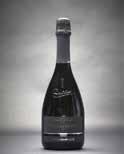
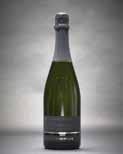

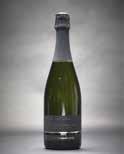


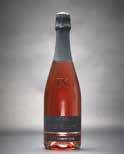




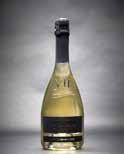
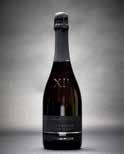



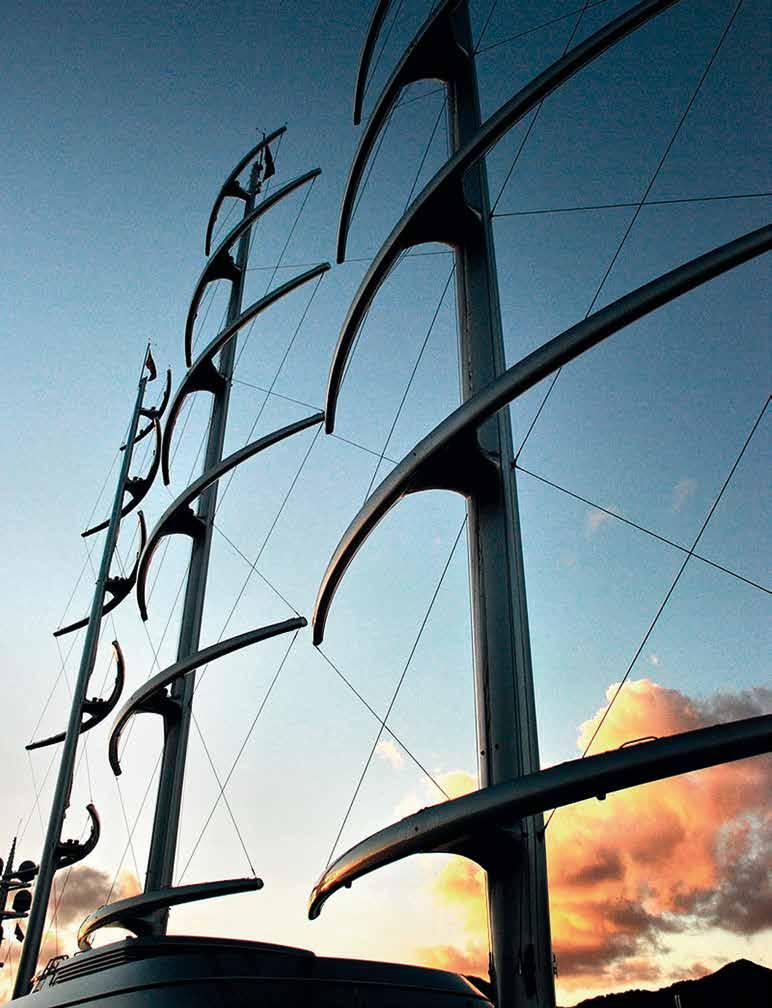
ANTICHI ORTI un viaggio nelle radici del passato a journey into the roots of the past
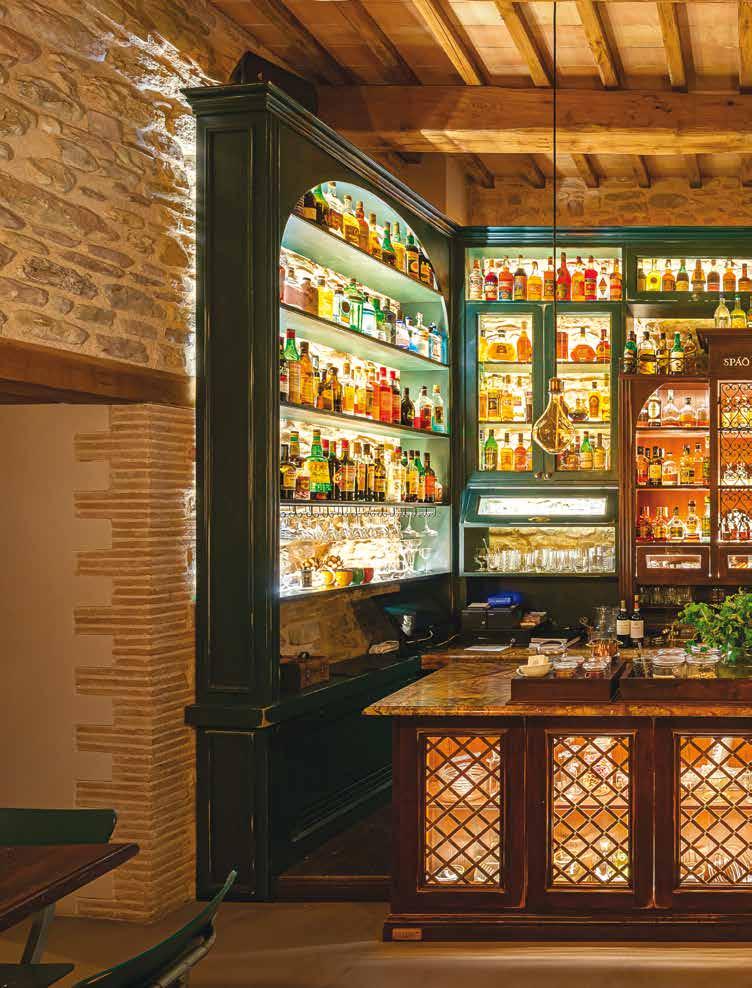
BORGO
ASSISI
Borgo Antichi Orti
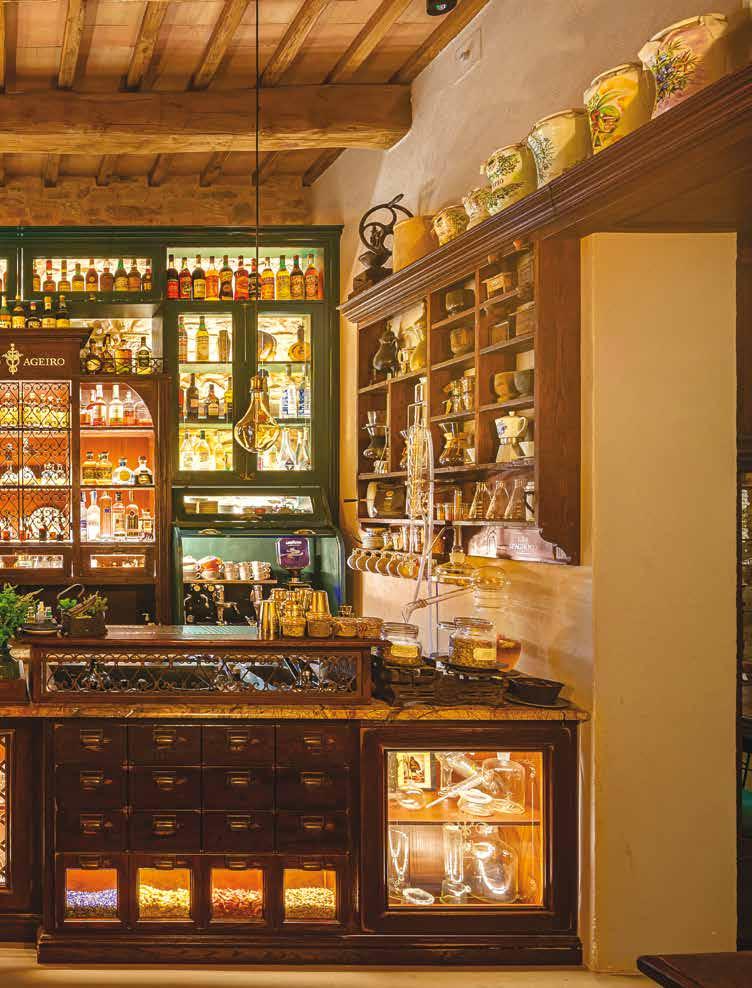
UMBRIA
UN LUOGO AUTENTICO dove passato, presente e futuro si incontrano
Intorno al 1444, nacque il Monastero Benedettino sotto il Sacro Convento di San Francesco a cui si aggiunsero altri insediamenti che crearono un piccolo borgo.
Dopo 6 secoli il Borgo è rinato ed invita i propri ospiti a riscoprire le “memorie dei sensi”, godere di una vista mozzafiato dall’alba al tramonto, respirare a pieni polmoni per percepire i profumi delle stagioni, assaporare gustosi cibi di antichi sapori e restare in silenzio per udire i suoni della natura. Dodici stanze dalla forte personalità con autentici dettagli di arredo recuperati dal monastero e dai materiali da costruzione. Il tutto con grande rispetto della sostenibilità ambientale. Borgo Antichi Orti ospita una locanda custode del patrimonio della cucina tradizionale, contadina e convenutale presentata in chiave moderna, oltre a 650 mq attrezzati per convegni, meeting, corsi professionali, team building aziendali, attività sportive, nonché una fattoria didattica. È presente anche il caratteristico Lab Spagirico, il cocktail bar dalle atmosfere alchemiche dove 120 specie di erbe e spezie danno vita a 18 combinazioni che permettono di riscoprire i sensi più profondi. Un posto autentico tramandato dai Monaci per donare agli ospiti benessere e piacere. Un posto denso di sensazioni dove tutto può accadere, tutto è agevolato, tutto è possibile.
AN AUTHENTIC PLACE WHERE PAST, PRESENT AND FUTURE MEET
The Benedictine Monastery was built in 1444 at the foot of the Sacred Convent od Saint Francis and over the time a settlement grew, creating a small village.
After 6 centuries the Borgo has been brought back to life with the help of expert master artisans, rediscovering the “sense memories”, enjoying a breath-taking view from dawn to sunset, breathing deeply to perceive the smell of seasons, tasting delicious and nutritious food of ancient flavours, remaining silent to list to nature’s sounds.
Twelve rooms, each one defined by décor and details of strong aesthetics, retrieved from the Monastery and building materials. All off this in the spirit of great respect to environmental sustainability. Borgo Antichi Orti includes a restaurant that preserves the treasure of traditional rural and conventual cuisine presenting it in a modern key, in addition to 650 sqm quipped to host conventions, meetings, events, professional training course, business team building events, sport activities, as well as an educational farm.
There is also the Lab Spagirico, a cocktail bar with an alchemical appeal where 120 species of herbs and spices are combined in 18 creations to connect with the deepest senses.
An authentic place handed down from the Monks to offer our guests well-being and pleasure. A place overflowing with sensations, where everything can happen, everything is encouraged, everything is possible.

30
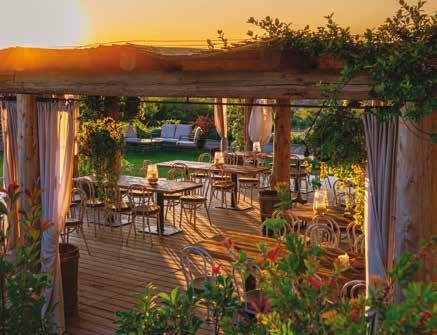
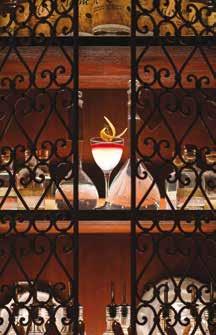
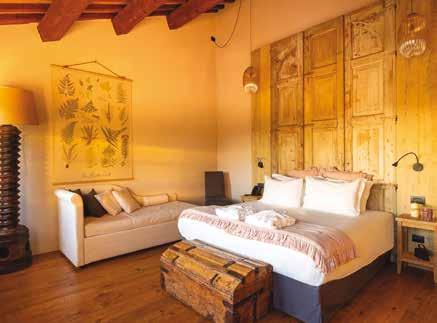



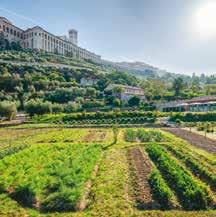
31

BORGO SCOPETO WINE & COUNTRY RELAIS fascino trecentesco 14th century charm SIENA 32
Borgo Scopeto

Wine & Country Relais

TOSCANA
ELEGANTE ATMOSFERA di un tempo
Borgo Scopeto Wine & Country Relais, avvolto dalla maestosa bellezza delle dolci colline del Chianti, si affaccia con un panorama mozzafiato su Siena. Un angolo di paradiso di origine trecentesca con vista sulla Torre del Mangia e sul Campanile del Duomo, dove tutto intorno si aprono a perdita d’occhio vigneti, oliveti e splendidi boschi di lecci dove cresce tutt’oggi l’Erica Scoparia, l’arbusto usato per fabbricare le scope, alla quale si deve l’origine del nome del luogo. Il relais è una caratteristica tenuta toscana finemente restaurata, abitata per cinque secoli dalla illustre dinastia senese dei Sozzini, che conserva nei propri ambienti l’autentica atmosfera di un tempo impreziosita da arredi di design dallo stile wine & country. Dispone di 52 eleganti camere, suites e ville, ognuna diversa dall’altra, dotate dei più moderni comfort. La tenuta possiede al suo interno un orto biologico, un apiario, un frutteto, campi di lavanda e elicriso, un Roccolo - giardino settecentesco di querce nane -, due piscine, una SPA con centro benessere e linea cosmetica propria, dove potersi rilassare a contatto con la natura. Propone una cucina di alto livello, con un bistrot e un ristorante gourmet, che prediligono prodotti tipici del territorio di alta qualità e a km 0, e che sappia abbinarsi perfettamente ai vini delle quattro cantine della proprietà. Il vino, infatti, è al centro delle esperienze offerte da Borgo Scopeto, grazie a tour, degustazioni guidate e wine class con il sommelier, eventi a tema e un programma benessere dedicato alla vinoterapia.

THE ELEGANCE OF YESTERDAY
Borgo Scopeto Wine & Country Relais is enveloped by the majestic beauty of the rolling hills of Chianti, overlooking a breathtaking view on Siena. A corner of paradise of fourteenth-century origin with a view of the Torre del Mangia and the Campanile of the Duomo, where all around open as far as the eye can see vineyards, olive groves and splendid holm oak woods where Erica Scoparia, the shrub, that still grows today, that was used to make brooms, to which we owe the origin of the name of the place. The relais is a finely restored characteristic Tuscan estate, inhabited for five centuries by the illustrious Sienese dynasty of the Sozzini, which preserves in its rooms the authentic atmosphere of the past, embellished with design furnishings in a wine & country style. It has 52 elegant rooms, suites and villas, each different from the other, equipped with the most modern comforts. The estate has an organic vegetable garden, an apiary, an orchard, fields of lavender and helichrysum, a Roccolo - eighteenth-century garden of dwarf oaks -, two swimming pools, a SPA with wellness center and its own cosmetic line, where you can relax in contact with nature. It offers a high-level cuisine, with a bistrot and a gourmet restaurant, which favours high-quality local and 0 km products and pairs well the wines of the four property’s wineries. In fact, wine is at the center of the experiences offered by Borgo Scopeto, thanks to guided tours, tastings and wine classes with our sommelier, themed events and a wellness program dedicated to wine therapy.
34
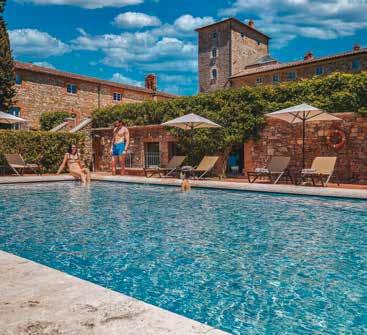
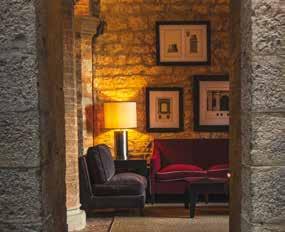
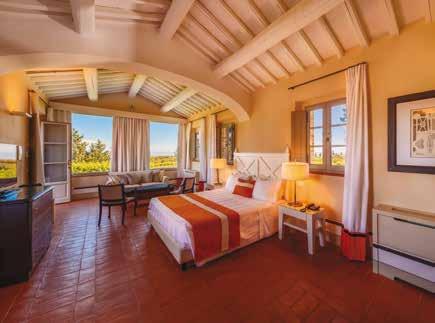




35


DISCOVER THE NEW GRECALE TROFEO. THE FASTEST GRECALE WITH 530 HP ENGINE AND MAXIMUM SPEED OF 285 KM / H. BLUVANTI Via S. Donato, 3/2 - 40057 Granarolo dell’Emilia (BO) Italy T. +39 051 6039272 - info@bluvanti-bologna.it bluvanti.penskeautomotive.it Everyday Exceptional Grecale Trofeo. Consumo di carburante in ciclo misto max (l/100km) 11.2; emissioni di CO2 in ciclo misto max (g/km) 254. I dati corrispondono ai test eseguiti in conformità al regolamento (UE) 2017/1151, tuttavia l’omologazione definitiva non è ancora stata ultimata, di conseguenza i dati possono essere soggetti ad ulteriori adeguamenti. I dati definitivi saranno presto disponibili sul sito Maserati e presso i concessionari ufficiali Maserati. New Grecale Trofeo.
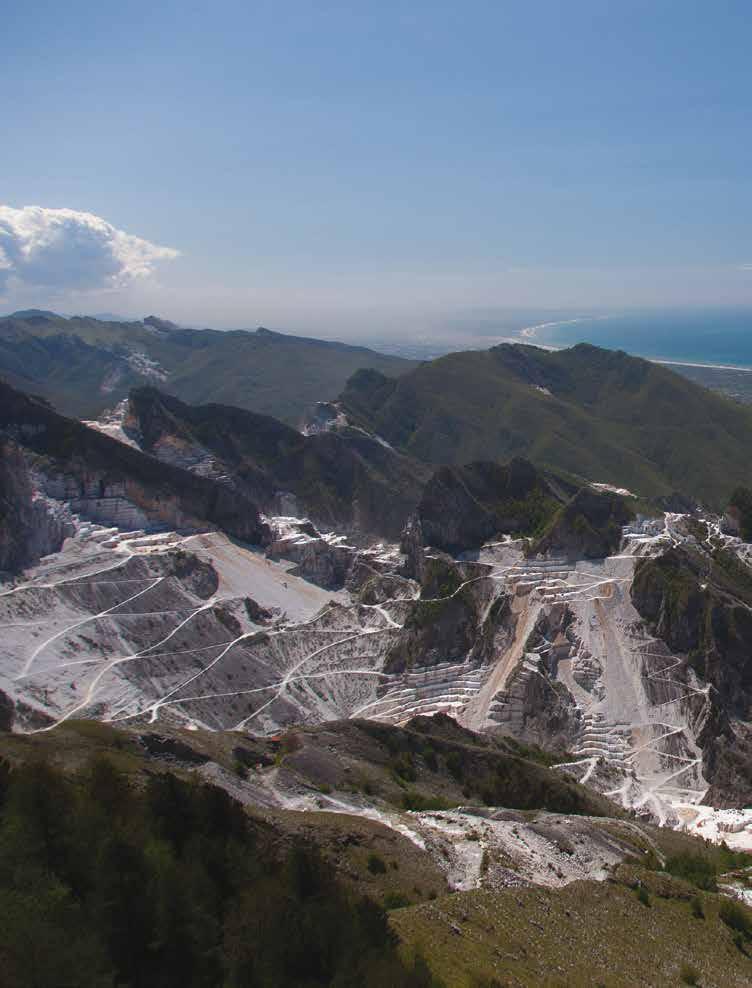

di/by:
Giulia Buzzi
photo:
Federigo Salvadori
SUGGESTIVE MERAVIGLIE NEL CUORE DELLE ALPI APUANE MONTI del MARMO I
Si affaccia imponente sul mare dell’Alto Tirreno la catena di creste montuose che si stagliano, nitide nel loro splendore, sul resto dell’Appennino. Per questo sono chiamate Alpi, le Alpi Apuane, che disegnano un paesaggio unico al mondo, scolpito, più che dipinto, spettacolo nello spettacolo di una natura che racconta oltre duemila anni di storia del suo rapporto con l’uomo. Le Alpi Apuane sono “i monti del marmo”, sono la pietra che qui si impone, con i riflessi del bianco nitido delle cave a cielo aperto, sull’azzurro e sul verde, per quella strana evoluzione delle cose che finisce in un appagamento estetico e suggestivo nel rappresentare quella unicità che non troveresti altrove. Ricche di bacini marmiferi, si sa che la preziosa pietra bianca viene estratta dalle cave delle Apuane, materia prima destinata a trasformarsi, dalla più semplice oggettistica alle grandi opere d’arte e di architettura, e che è stata la prediletta, per i loro capolavori, di Michelangelo e di Canova.
E sono secoli che il marmo di Carrara si è affermato sia per le sue varietà di bianco sia per le varietà colorate, dal bardiglio al paonazzo, dal fior di pesco al cipollino e all’arabescato, ancora richiestissimo in ogni angolo del pianeta per costruire ville, pavimentazioni, rifinire interni, per opere d’arte, monumenti e statue.
Fu Giulio Cesare a dare impulso a questa attività estrattiva - comunque già attiva in età preromanache, a periodi alterni, è stata meno (Alto Medio Evo) o più (Rinascimento) intensa.
Per il trasporto via mare si utilizzava prima il porto della allora rigogliosa città di Luni poi l’altro porto dedicato di Marina di Carrara. I blocchi di marmo venivano trasportati con un’antica tecnica manuale: la “lizzatura” e ancor oggi nei laboratori e nel Museo del marmo a Carrara si può conoscere quale è stata nel tempo la tecnica di lavorazione e di trasporto del marmo. Ma è salendo alle cave che si entra in una suggestione di rara meraviglia. E se già a Campocecina si gode di un’ampia veduta dall’alto sulle cave e si possono seguire le fasi di trasporto del marmo a valle, è entrando, in visite guidate, nei bacini di Colonnata, Torano e soprattutto Fantiscritti (e altre), che l’indimenticabile diventa patrimonio di conoscenza indelebile. È già in sé spettacolare il viaggio in auto lungo il tracciato della ex Ferrovia Marmifera, il passaggio sui ponti di Vara (splendida opera architettonica di fine ‘800 sulla quale arrancavano i treni a vapore) e il transito all’interno delle gallerie scavate nella roccia.
Sono strade polverose quelle che portano alle cave di marmo, strade che scivolano a serpentina sulle pendici delle Apuane e che regalano scorci unici dalle forti emozioni.
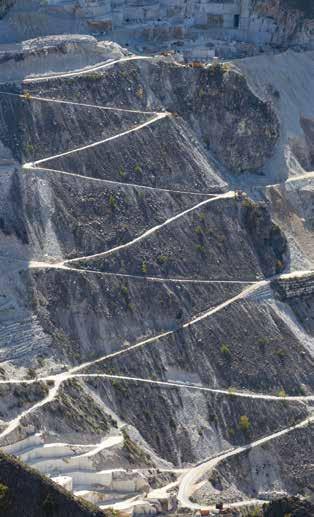
Si procede dentro le buie gallerie e su sentieri affacciati sugli strapiombi, dove la cautela deve essere massima. Ed è qui che bisogna fare mente locale sul fatto che dall’età imperiale alla metà del XX secolo, quando furono costruite le prime strade, i blocchi erano trasportati a valle con il pericoloso metodo della lizzatura, arrivavano al porto di Luni (per i Romani era infatti marmor lunensis , “marmo di Luni”) percorrendo la via Carraia sopra carri trainati dai buoi.
Rientrati nell’attualità, arrivati alla cava, si entra nel ventre della montagna, tra altissime pareti, sotto soffitti e sopra pavimenti in marmo, dove le gocce d’acqua cadono al suolo con suono ingigantito che rompe l’incanto dell’assordante silenzio.
Chiudete gli occhi e lavorate di immaginazione, immedesimatevi e capirete quello che stiamo raccontando.
40
Nelle immense cave è come trovarsi all’interno di una cattedrale, una cattedrale tutta di marmo, con una acustica che in passato è stata propizia a location per musicisti e cantanti famosi, tra cui David Bryan, tastierista dei Bon Jovi, che suonò su un pianoforte in marmo. Chi non può o non vuole vivere una esperienza mozzafiato può comunque andare alla scoperta di questo affascinante mondo visitando i Musei del Marmo che raccolgono ricche collezioni e che a loro volta offrono una immagine comunque completa di un patrimonio di sculture e materiali didattici su una cultura millenaria oggi raccontata dalle nuove tecnologie audio visive e informatiche. Resta un’ultima annotazione: la definizione della lizzatura. Con questo termine si indica il metodo che dall’antichità fino agli anni Sessanta del secolo scorso si trasportavano a valle dalla cava i blocchi di marmo riquadrati. Lizzatura a sua volta deriva dalla slitta sulla quale i blocchi legati venivano fatti scivolare su travi di legno dalla cava fino a valle lungo le strade che erano chiamate vie di lizza.
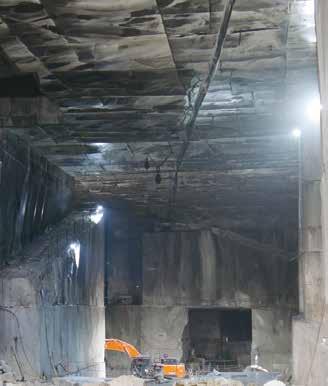
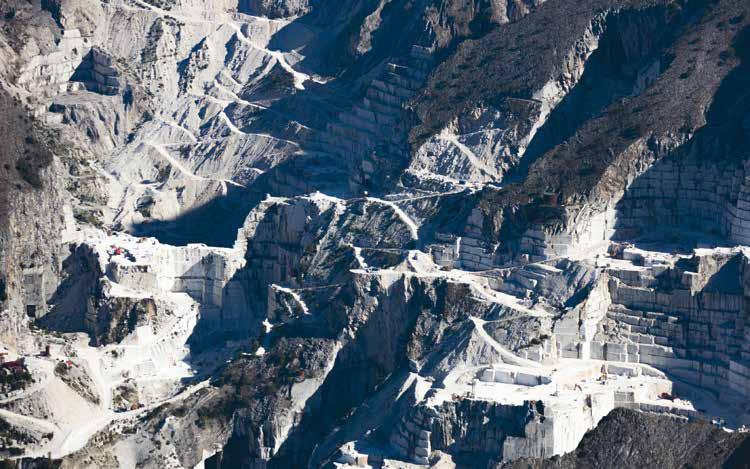
41
MARBLE MOUNTAINS, EVOCATIVE MARVELS IN THE HEART OF THE APUAN ALPS

The range of mountainous ridges that majestically overlook the High Tyrrhenian Sea stands out, sharp in its splendour, from the rest of the Apennines. This is why they are called the Alps, the Apuan Alps, mountains that outline a unique landscape in the world, less painted than sculpted, a spectacle within the spectacle that is nature and which tells over two thousand years of history of its relationship with humans. The Apuan Alps are called “the marble mounts”; they are the stone that rules here, with the white reflexes of the open-air
quarries stark against the azure and the green, through that strange evolution of things that ends up in an aesthetic and evocative fulfilment in the representation of the uniqueness one cannot find elsewhere.
The precious white stone is extracted from the Apuan quarries, rich in marble basins, and it is a raw material destined to be transformed, from simple objects to great artworks and architecture items. It was the favourite material of Michelangelo and Canova, who used it for their masterpieces.
Carrara marble has been, for centuries, a prized product due to its varieties of white as well as for its coloured versions,
42
from bardiglio to purple, from peach blossom to cipolin and arabesque, still very desired in all corners of the planet to build villas, to tile floors, to finish interiors, as well as for artworks, monuments and statues.
It was Julius Caesar who boosted this extraction industry, which was already active in pre-Roman times and later alternated between more (Renaissance) or less (High Middle Ages) intense. Sea transportation initially used the port of the thriving city of Luni, then the other dedicated harbour of Marina di Carrara. The marble blocks were transported using an ancient manual technique called lizzatura. To this day, in marble workshops and at the Marble Museum at Carrara visitors can get to know how marble working and transportation have evolved over time. But It’s climbing to the quarries that one steps into a rare marvel. Just climbing to Campocecina will reward visitors with a wide bird’s eye view of the quarries. It is possible to follow the transportation phases from uphill, but it is taking a guided tour in the basins of Colonnata, Torano and especially Fantiscritti (and others) that what is unforgettable becomes heritage of indelible knowledge. The car trip along the former Marble Railway itinerary is spectacular, as well as the bridges of Vara, a splendid architectural work dating to the late 19th century that was used by steam trains and driving through the tunnels dug into the rock. The roads that go into the marble quarries are dusty, roads that snake down the Apuan cliffs and that provide travellers with unique glimpses and plenty of excitement.
The way continues along the dark tunnels and narrows into overhang tracks, where extreme caution is required. This is
where one should keep in mind that from the Imperial age all through the mid-20th century, when the first roads were built, marble blocks were transported downhill using the dangerous lizzatura method. They arrived at the port of Luni (the Romans called this marble marmor lunensis, “Luni marble”) after following the Via Carraia, carried in ox-driven carts.
Back in the present day, once we get to the quarry, we step into the bowels of the mountain, between extremely tall walls, with marble ceilings above and marble floor under our feet, where water drips on the floor, its sound intensified by the surroundings and breaking the spell of the deafening silence. Close your eyes and let your imagination work. Visualise yourself there and you will understand what we mean. In the immense quarries one feels like inside a cathedral all made of marble, with acoustics that have been put to service by musicians and famous singers, including David Bryan, who played the keyboard for Bon Jovi, who played a marble piano once.
Those who cannot or do not wish to live a breathtaking experience can still discover this fascinating world by visiting the Marble Museums, which contain rich collections and offer a full picture of a legacy of sculptures and learning material on this ancient culture, now told with new audio, visual and digital technologies.
One last note remains: the definition of lizzatura . The term is used to define the method employed from Antiquity to the late 1960’s to transport squared marble blocks from the quarries. The cut blocks were made to slide on sledges over wooden beams from the quarry along the roads, which were called lizza .
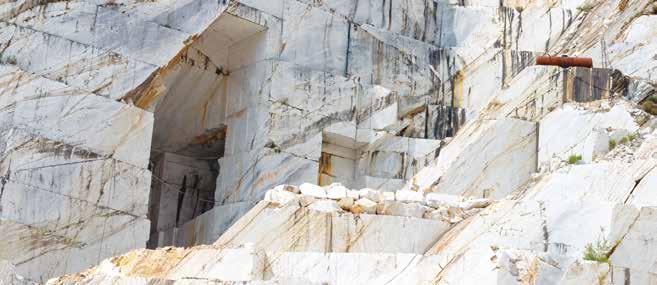
43

BORGOBRUFA SPA RESORT natura, benessere ed esclusività totale nature, well-being and total exclusivity TORGIANO
Borgobrufa SPA Resort

UMBRIA
DOVE LA NATURA VI CIRCONDA e il benessere vi avvolge
Borgobrufa SPA Resort è un Resort 5 stelle situato a Torgiano, nel cuore verde dell’Italia in Umbria, su una collina che domina Assisi e Perugia. Esteso su una proprietà di 4 ettari di verde, vigneti e uliveti, Borgobrufa SPA Resort è un regno di lusso, tranquillità, ospitalità e privacy. Con ampi spazi interni completamente rinnovati nel 2019, il Resort è aperto solo ad ospiti di età superiore ai 18 anni per godere al meglio della caratteristica quiete del luogo. 49 Suite e Camere offrono viste panoramiche, patio o balcone. Le suite dispongono di piscina idromassaggio interna o esterna di coppia, o piscina privata interna riscaldata e sauna privata. La Borgobrufa SPA è tra le più grandi del centro Italia: 3.000 m² interamente dedicati al benessere e al relax, con piscina panoramica interna-esterna riscaldata, piscina estiva, aree relax panoramiche, saune, 4 Private SPA e trattamenti SPA. I 2 Ristoranti “Quattro Sensi” ed “Elementi Fine Dining” propongono sapori autentici e piatti a base di ingredienti stagionali di prima qualità esclusivamente forniti da produttori locali. Servizi personalizzabili: cooking class, wine tasting, tour e-bike, caccia al tartufo e visita alle cantine.

WHERE NATURE SURROUNDS YOU AND WELL-BEING ENVELOPS YOU
Borgobrufa SPA Resort is a 5-stars Resort located in Torgiano, in the green heart of Italy and Umbria, on a hill overlooking Assisi and Perugia. Spread on a property of 10 acres of green land, vineyards and olive groves, Borgobrufa SPA Resort is a realm of luxury, tranquility, hospitality and privacy. With spacious indoor areas completely renovated in 2019, the Resort is only open to guests over 18 years of age so that the characteristic quietness of the location can be enjoyed to its fullest. 49 Suites and Rooms offer panoramic views, patios or terraces. The suites feature indoor or outdoor hydromassage pool for two people, or private indoor heated pool and private sauna. The Borgobrufa SPA is one of the biggest SPA in center Italy: 3,000 m² entirely dedicated to wellness and relaxation, with the indoor-outdoor heated panoramic pool, summer pool, panoramic relax areas, saunas, 4 Private SPAs and SPA treatments. The 2 Restaurants “Quattro Sensi” and “Elementi Fine Dining” offer authentic flavors and dishes based on prime, seasonal ingredients from local producers only. Customizable services: cooking class, wine tasting, e-bikes tour, truffle hunting and wineries tour.
46
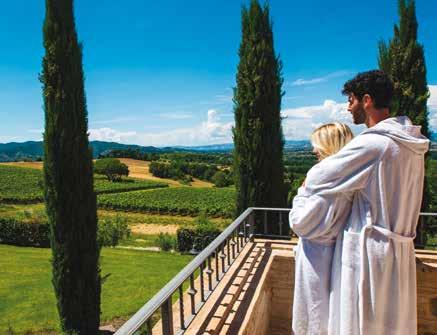

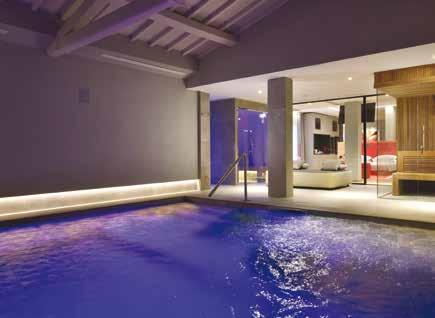




47
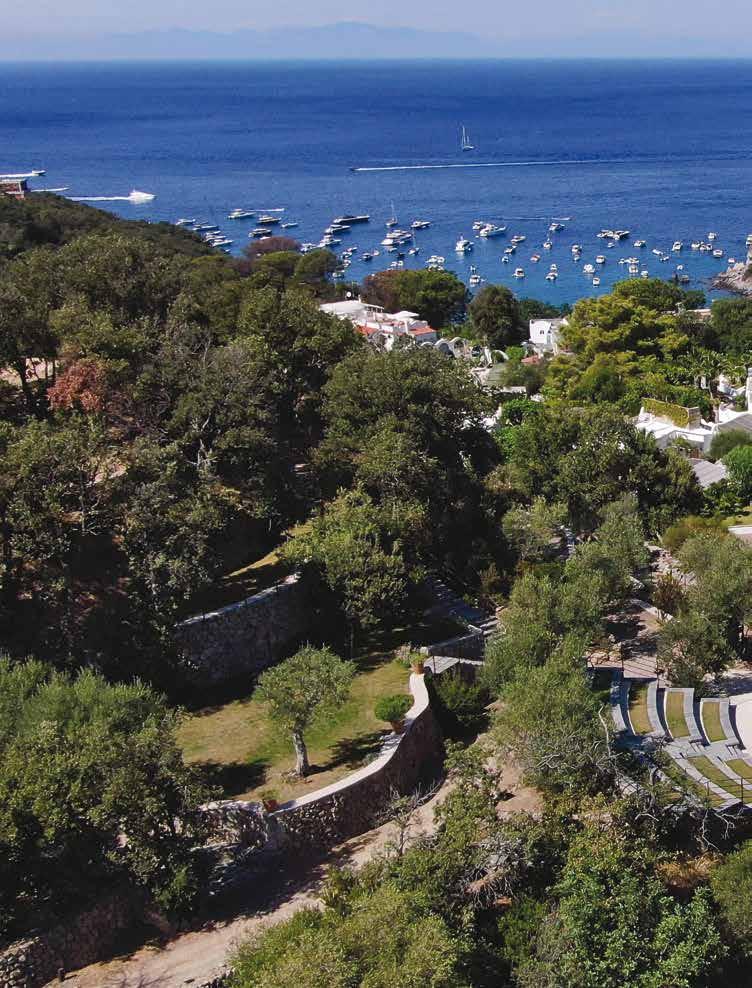
BOTANIA RELAIS & SPA Ischia, giardino del Mediterraneo Ischia, Mediterranean garden ISCHIA
Botania Relais & Spa
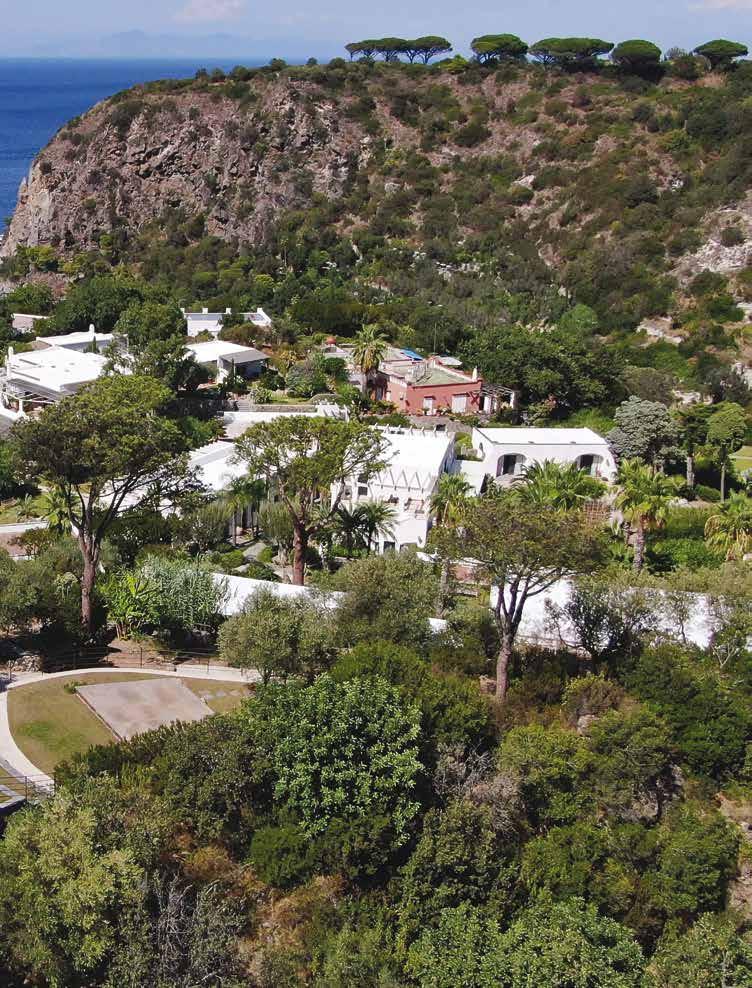
CAMPANIA
una vera e propria
OASI DI VERDE
Il Botania Relais & Spa è l’unico albergo ad Ischia a disporre di un parco di 3 ettari, una vera e propria oasi di verde dove si susseguono armoniosamente olivi secolari, carrubi, corbezzoli, pini, lecci e tantissime varietà di fiori. È composto da 10 ville in tipica architettura locale, circondata dalla ricca vegetazione mediterranea. In armonia con lo stile delle ville, a bordo piscina troviamo il ristorante: “il Corbezzolo” dove lo Chef propone, dall’antipasto al dessert, un viaggio attraverso le tradizioni ischitane con materie prime sempre fresche. La struttura presenta il primo ristorante veg-veg dell’isola: “Il Mirto”, dove gustare deliziosi piatti a base di verdure ed ortaggi che seguono, rigorosamente, l’alternanza delle stagioni. In un’atmosfera rilassante che renderà il vostro aperitivo unico, troviamo il Wine bar “La Grotta”, scavato nella tipica pietra tufacea. All’esterno, oltre ad una piscina semi olimpionica a 28°, due piscinette di acqua sorgiva con cascata, incastonate nel verde della collina con splendida vista sul mare. Infine, per un viaggio nel benessere attraverso giochi d’acqua, due piscine a 32 e 34 gradi con vari tipi di idromassaggio, compreso quello benefico ai piedi. Completano il percorso della Garden Spa la doccia cromatica, il bagno di vapore in una grotta naturale e la palestra.

A REAL OASIS OF GREENERY
The Botania Relais & Spa is the only hotel in Ischia with a 3-hectare park, a true green oasis where secular olive trees, carob trees, strawberry trees, pines, holm oaks and many varieties of flowers follow one another harmoniously. It consists of 10 white villas in typical local architecture, surrounded by rich Mediterranean scrub. In harmony with the style of the villas, there is a restaurant by the pool: “il Corbezzolo” where the Chef proposes, from appetizer to dessert, a journey through Ischia’s traditions with only fresh ingredients. The Relais also offers the first veg-veg restaurant on the island: “Il Mirto”, where you can enjoy delicious dishes based on vegetables that strictly follow the changing seasons. In a relaxing atmosphere that will make your aperitif unique, we find the wine bar “La Grotta”, carved into the typical tuffaceous stone. Outside, in addition to a 28° semi-Olympicsize swimming pool, there are two small pools of spring water with a waterfall, set in the green hillside with a wonderful view of the sea. Finally, for a journey into wellbeing through water games, two 32°and 34° swimming pools with various types of hydromassage, including a benifical one for the feet. A chromatic shower, a steam bath in a natural grotto and a gym complete the Garden Spa experience.
50


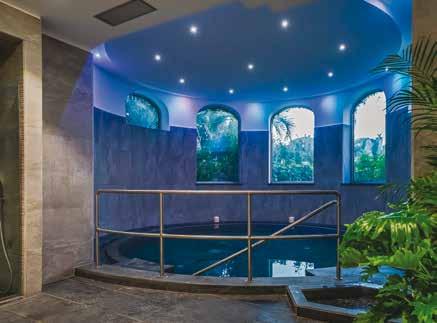

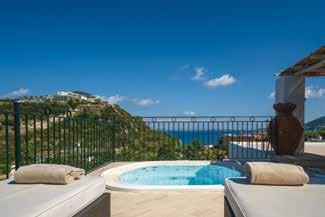
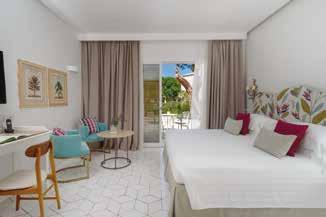

51
CARRARA e la BIANCA PIETRA
L’ULTIMA BOTTEGA D’ARTE DI UNA DINASTIA DI SCALPELLINI


52
Si può dire che alla modernità è stato solo concesso l’involucro, una tensostruttura a grandi vele bianche, di quella che è rimasta l’ultima bottega-laboratorio nella quale, nel cuore di Carrara, la città del marmo, si onora, tramandandola, la millenaria lavorazione artistica della pietra bianca, bianca come le tende che ti attraggono in Viale XX Settembre. Sì, perché qui non sono entrati e non entrano macchine di nessun genere, né a controllo numerico né la robotica. È il luogo questo della tradizione. Da perpetuare
rigorosamente. E a fare scuola. Non a caso si è scelto, come motto, il latino “Ars gratia artis”, l’arte per l’arte, che qui sta come purezza - anche per il solo piacere che può dare - dal disegno alla lavorazione in creta fino alla realizzazione di quel marmo che dà vita alle copie perfette delle più famose sculture della classicità o che traduce, in marmo, soprattutto bianco, le opere di artisti da modelli originali. Se è vero come è vero che classico è per sempre, in questa atmosfera che può apparire fuori dal tempo ma che è nella storia e della storia, a stupire è la potenza della creatività che
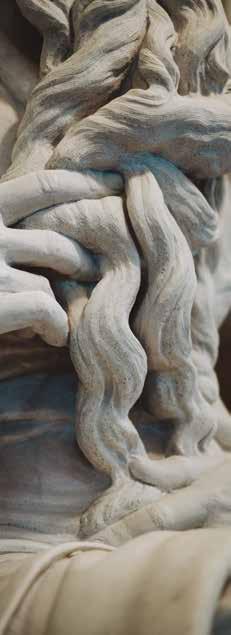

53
photo: Damaride Arzà @damaridea
va oltre il tipico repertorio del laboratorio artigianale, dalle opere a tutto tondo ai bassorilievi di soggetto religioso con sfondi architettonici o del paesaggio a opere uniche. Che tradotto significano originalità, esclusività, raffinatezza, classe, eleganza, ma anche essenzialità, e ancora purezza di linee, forme e volumi, cura dei materiali e dei particolari. È un mondo magico, insomma, che si racconta narrando la storia non comune dell’ideatore e fondatore di questo capolavoro.
Occorre allora fissare un luogo e una data. Il luogo non poteva che essere Carrara, la data è il 15 giugno 1937. Entrambi segnano la nascita di Lucio in una famiglia, i Carusi Cybei, che, originaria di Moneta, antico borgo murato dominato da un possente castello e non lontano dalla città, si tramanda di generazione in generazione non solo le tecniche di lavorazione della “bianca pietra”, della quale conosce tutti i segreti, ma anche una notevole vena artistica. Come quella di Demetrio Carusi, rivale di Pietro Tenerani, pure lui di Carrara, nel concorso per il Pensionato a Roma nel 1810; come quella di Antonio Carusi Cybei, le cui opere sono tuttora esposte all’Hermitage di San Pietroburgo.
Lucio è dunque il rampollo di questa dinastia di statuari, i Carusi e i Carusi Cybei, fatta da ricchi possidenti di cave e terreni, poi coinvolti nel disastro economico degli anni ’30 che segnò la fine di molte fortune di magnati del marmo come i Marchetti e i Fabbricotti. Cresce a pane e scalpello il ragazzo che poi frequenta l’Istituto del Marmo e i corsi serali dell’Accademia di Belle Arti. Completa la sua formazione lavorando in laboratori, tra cui gli studi Beretta, Andreani e Andrei, e partecipa a mostre e concorsi internazionali. Scultore affermato e autore di opere pregevolissime, Lucio Carusi ha ventinove anni quando, nel 1966, è chiamato a scolpire il granito nel Vermont. Partito con la famiglia per gli Stati Uniti non smette di respirare la polvere impalpabile di pietra che esce dagli scalpelli e le gradine del Vermont, vive a contatto con artisti e con la materia grezza che dalla loro mano si trasforma in una metamorfosi perpetua. Quella che, tornato in Italia, lo spinge ad aprire il laboratorio “Carusi Sculture”. Nel quale, indifferente alle sirene del modernismo, ha scelto di continuare a lavorare il marmo artigianalmente, rigorosamente a mano, come quando dagli scalpellini erano create opere uniche, nelle quali è l’artista, il vero artista, ad emergere con la sua abilità manuale.
È così diventato uno studio il laboratorio “Carusi Sculture” nel quale i migliori artisti del mondo vengono a esprimersi nella loro creatività. Ma “l’ultima bottega d’arte di Carrara” è anche e soprattutto un laboratorio di famiglia nel quale lavorano il fondatore, l’ottuagenario Lucio e i suoi figli Roberto e Cristina, entrambi artisti promettenti, assieme ad altri maestri scalpellini. L’eredità dell’antica dinastia è stata così ben riposta, ai piedi delle sovrastanti Alpi Apuane, nel cuore della capitale mondiale del marmo per tradizioni artistiche legate a una millenaria attività estrattiva. Quella che ha fornito materiali pregiati e unici alle opere dei massimi scultori e dell’immenso Michelangelo Buonarroti. E quella nella quale sono nati alcuni tra i maggiori statuari di fama nazionale come Domenico Guidi e il già citato Pietro Tenerani.

54


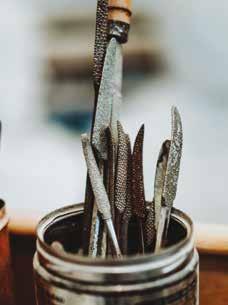
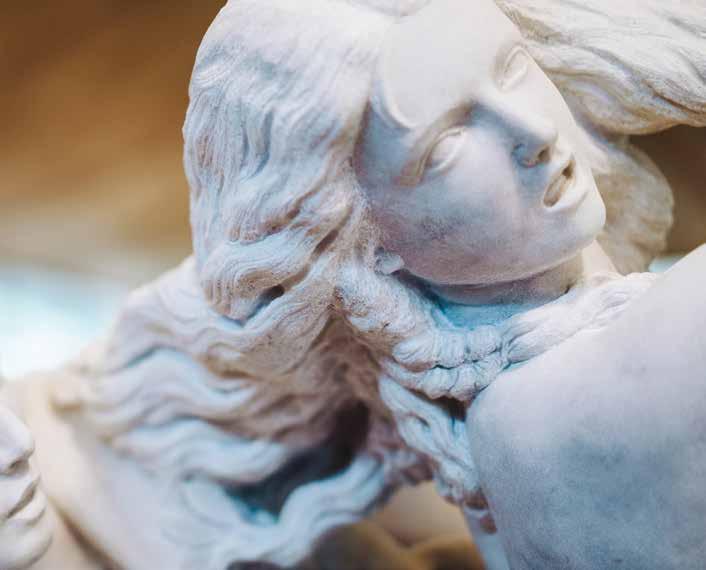
55
CARRARA AND THE WHITE STONE
THE LAST ARTIST WORKSHOP OF A DYNASTY OF STONE-CUTTERS

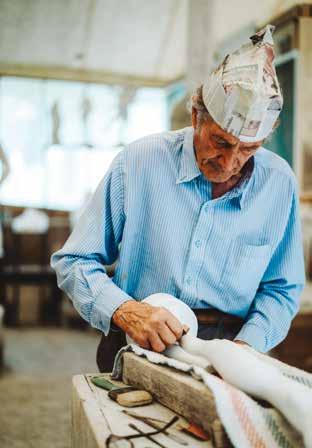
It can be said that all modernity has been allowed is the outer shell, a tensile structure with large white sails, of what is still the last workshop-laboratory in which, in the heart of Carrara, the marble city, the millennial artistic working of white stone is honoured and handed down - the stone that is as white as the curtains that draw your attention at Viale XX Settembre. Yes, because here no machines have ever been allowed: no numeric control, no robotics. This is a place of tradition. To be strictly perpetuated. And to be taught. It is no coincidence that their chosen motto is “Ars gratia artis”, in Latin, which translates as “art for art’s sake”. Here it means pureness - including just for the pleasure it may provide - from the design to the clay working, all the way to the creation of the marble that gives life to perfect copies of the most famous classic statues, or which translates into marble, especially the white kind, the work of artists based on original models. If, as the saying goes, classics are forever, in this atmosphere that may seem out of time but is very much within history and part of it, what inspires awe is the power of creativity, going beyond the typical repertoire of artisan workshops, from all-round works to religious-themed bas-relief items with architectural or landscape background, and including unique products. In a few words, they mean originality, exclusiveness, sophistication, class, elegance, as well as essentialness, and also pureness of lines, forms and volumes, excellent selection of materials and attention to details. This is, to sum it up, a magical world which tells its own story by telling the uncommon history of the creator and founder of this masterpiece. It is therefore necessary to determine a where and a when. The where could only be Carrara; the when is 15 June, 1937. Both mark the birth of Lucio to a family, the Carusi Cynei, which, originally from Moneta, an ancient walled hamlet overshadowed by a powerful castle and yet not far from the town, hands down from generation to generation not only the techniques to work the “white stone”, which holds no secrets from them, but also a remarkable artistic streak. Like that of Demetrio Carusi, rival of Pietro Tenerani, himself from Carrara as well, in the contest for the Pensionato, in Rome, in 1810; or like that of Antonio Carusi Cybei, whose works are, to this day, in exhibition at St. Petersburg’s Hermitage Museum.
Lucio is the scion of this dynasty of statue-makers, the Carusi and the Carusi-Cybei, made up of rich owners of quarries and lands, later involved in the 1930’s economic disaster that marked the end of many a fortune of marble tycoons, such as
56
the Marchettis and the Fabbricottis.
Brought up on cheese and chisel, he later attended the Marble Institute and the evening courses of the Academy of Fine Art. He completed his education working at workshops, including Beretta, Andreani and Andrei, and participated in international exhibitions and contests.
An accomplished sculptor and the author of very precious works of art, Lucio Carusi was twenty-nine when, in 1966, he was commissioned to sculpt granite in Vermont.
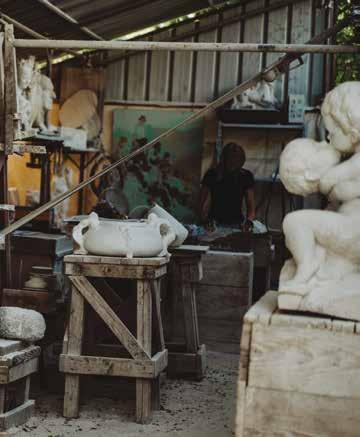
After leaving with his family to the United States, he never stopped breathing the impalpable rock dust released by chisel and gradine in Vermont; he lived in contact with artists and with the raw material their hands turn into a perpetual metamorphosis. The same material which, once he returned to Italy, made him open the “Carusi Sculture” laboratory. Here, indifferent to the mermaid’s song of modernism, he has chosen to continue working with marble as a craftsman, rigorously by hand, just like back when chisels released unique works in which it is the artists, the true artists, who emerge with their manual skills.
The “Carusi Sculture” laboratory has therefore become a study, where the world’s best artists come to express their creativity. But “Carrara’s last art workshop” is also, and
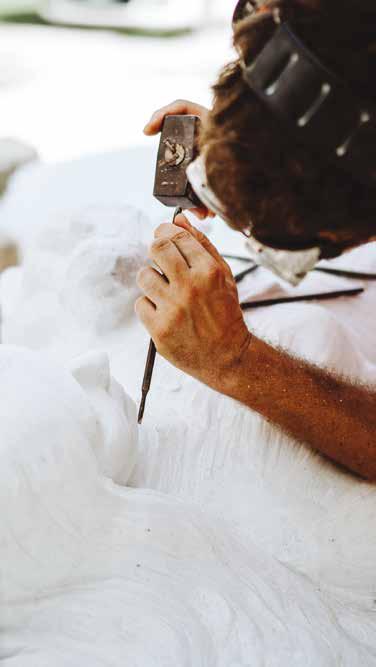
especially, a family laboratory where its founder, 80-yearold Lucio, and his children, Roberto and Cristina, both successful artists, work together with other chisel masters.
The legacy of this old dynasty is therefore well placed, at the feet of and overlooked by the Apuan Alps, in the heart of the world’s marble capital in terms of artistic traditions related to a millennial extraction activity. The city that has provided precious and unique materials for the works of superlative sculptures, including the one and only Michelangelo Buonarroti. The birthplace of some of the most famous Italian statue-makers, such as Domenico Guido and the already mentioned Pietro Tenerani.

The New Range Rover, Fuel consumption (l/100 km): combined cycle 0,8 - 12 (WLTP). Emissions CO2 (g/km): combined cycle 18 - 272 (WLTP). The values are indicated for comparative purposes. A true leader never stops looking to the future. New Range Rover, true to its history but in continuous evolution, is once again an inspiration for his iconic style, sustainable materials that combine ethics and aesthetics and its unrivaled capabilities. Ready to break new ground again. Via Isonzo 16, Casalecchio di Reno - 051 6113301 concierge.bolognapremium@landroverdealers.it bolognapremium.landrover.it THE NEW RANGE ROVER PEERLESS REFINEMENT AND LUXURY.


CERVO
un’oasi di relax e piacere a truly relaxing oasis of pleasure

PORTO
COLONNA RESORT
Colonna Resort

SARDEGNA
COSTA SMERALDA, atmosfera unica ed esclusiva
Il Colonna Resort, hotel 5 stelle lusso a Porto Cervo, è una delle destinazioni più esclusive della Costa Smeralda e della Sardegna. Si estende in un parco verde di circa 60.000 metri quadrati, in prossimità della spiaggia di Cala Granu. Questo splendido Resort 5 stelle offre 250 camere immerse in un’atmosfera unica ed esclusiva, con ambienti eleganti e raffinati che ripropongono la tradizionale ospitalità dell’isola. Una vera oasi di relax e di piacere per tutti coloro che sono alla ricerca di un hotel di lusso sul mare del Nord Sardegna.

Al suo interno ottimi servizi 5 stelle, raffinate e lussuose camere, una spiaggia privata, 7 incantevoli piscine di acqua marina e 2 eleganti ristoranti con vista mare, in cui gustare eccellenti specialità gastronomiche.
Il Colonna Resort dispone di 250 Camere tutte finemente arredate in stile sardo, con mobili color pastello e impreziosite dai ricami della tradizione tessile dell’isola. Le camere si suddividono tra vista mare e vista giardino, regalano atmosfere calde, raccolte ed accoglienti. Le Suites, rigorosamente vista mare, offrono gli ambienti più lussuosi ed esclusivi dell’hotel. Il Colonna Resort è dotato di una SPA e Centro Benessere e Fitness di circa 1.000 mq interamente dedicato alla bellezza e al benessere di mente e corpo.
COSTA SMERALDA, UNIQUE AND EXCLUSIVE ATMOSPHERE
The Colonna Resort, a 5-star hotel in Porto Cervo, is one of Sardinia’s and the Costa Smeralda’s most exclusive destinations. It stretches along approximately 60,000 square metres of green parkland, near the beach of Cala Granu.
This splendid 5-star Resort has 250 elegant, refined rooms set in a unique and exclusive atmosphere, offering the traditional hospitality of the island. A truly relaxing oasis of pleasure for all those people seeking a luxury hotel by the sea in Northern Sardinia.
Inside, excellent 5-star services, refined, luxurious rooms, a private beach, 7 delightful seawater swimming pools and 2 elegant restaurants with a sea view, in which you can savour the excellent culinary specialties. The Colonna Resort has 250 Rooms, all tastefully furnished in typical Sardinian style, with pastel-coloured furniture embellished with the island’s traditional decoration.
The rooms are divided into sea view rooms and garden view rooms all have a warm, cosy, welcoming atmosphere.
The Suites all have a sea view and are the most luxurious and exclusive in the hotel. The Colonna Resort has a SPA and a Wellness and Fitness Centre of approximately 1,000 sqm dedicated entirely to the beauty and well-being of the mind and the body.
62

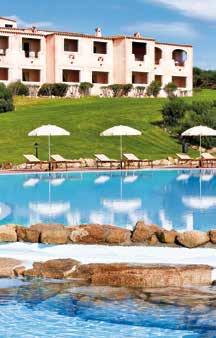



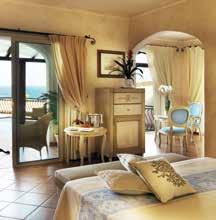
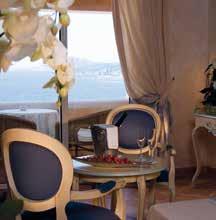
63
D.O.M HOTEL
uno spazio senza tempo a timeless space

ROMA
D.O.M Hotel


LAZIO
LUSSO NON CONVENZIONALE nella storica Via Giulia a Roma
Il D.O.M Hotel è un lussuoso palazzo storico con 18 camere e suite, ognuna con un’esclusiva vista sulla storica Via Giulia. In origine un palazzo del XVII secolo trasformato in monastero clarettiano, D.O.M è l’abbreviazione di “Deo Optimo Maximo”, un’iscrizione latina presente sulla chiesa adiacente alla proprietà. Il boutique hotel di lusso comprende offerte e comfort unici come la caratteristica suite D.O.M che vanta una terrazza privata di oltre 25 metri quadrati immersa tra i tetti e i campanili del celebre quartiere Regola di Roma. Il carattere inimitabile degli interni del D.O.M dissipa rapidamente ogni cliché del lusso convenzionale, progettato con cura con l’intenzione di creare un’atmosfera intima e raffinata tipica delle dimore private aristocratiche italiane. Il VERVE Restaurant dell’hotel D.O.M rappresenta la tradizione e la ricerca gastronomica ed è il perfetto connubio tra servizio di alto livello e calda ospitalità. La sua coinvolgente atmosfera invita gli ospiti a gustare drink e cene intime accompagnate da menu con ingredienti di provenienza locale e prodotti di stagione. Una terrazza incredibilmente romantica, una delle sorprese uniche dell’hotel, attende gli ospiti sul tetto.
NON-CONVENTIONAL LUXURY IN THE HISTORIC VIA GIULIA IN ROME
D.O.M Hotel is a luxury historic property with 18 guest rooms and suites, each with direct views over the historic Via Giulia. Originally a 17th century palace turned Claretian monastery, D.O.M is an abbreviation of “Deo Optimo Maximo,” a Latin inscription found on the church adjacent to the property. The boutique luxury hotel includes unique offerings and comforts such as the distinctive D.O.M suite which boasts a private terrace spanning over 25 square meters with exclusive views of the rooftops and bell towers of Rome’s celebrated Regola quarter. The inimitable character of D.O.M’s inviting interior quickly dispels any clichés of conventional luxury, thoughtfully designed with the intention of creating an intimate and refined atmosphere typical of Italy’s private aristocratic homes. The VERVE Restaurant at D.O.M Hotel represents the tradition and the gastronomy research in Rome and it is the perfect blend of high-level service and warm hospitality. The restaurant’s warm and engaging atmosphere invites guests to enjoy early evening drinks and intimate dinners accompanied by menus featuring locally sourced ingredients and seasonal produced. A wonderfully romantic terrace, one of the hotel’s unique surprises, awaits guests on the rooftop.

66
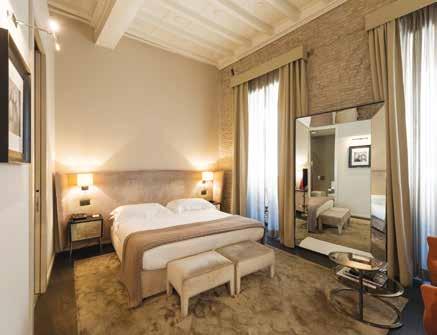





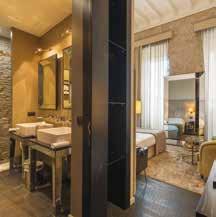
67

HAPPY HEARTS Handcrafted in Ethical Gold
FORTE DEI MARMI
ALPEMARE
DOVE RISCOPRIRE LA DOLCEVITA
di/by: Beatrice Bellotto photo: Alessandro Giannaccini, Stefano Marinari
Già nel nome, Alpemare, non c’è solo l’esaltazione di un simbolo ma c’è anche e soprattutto l’identificazione con l’essenza stessa di un luogo che, adagiato tra il Mare Tirreno e le Alpi Apuane, ha avuto in dono dalla natura un ambiente più unico che originale.
E la potenza delle combinazioni ha avuto così buon gioco nel trasformare un tradizionale stabilimento balneare in una location che è diventata punta di diamante, come comunemente riconosciuto, di Forte dei Marmi e della Versilia.
Il Bagno Alpemare è stato l’avverarsi, infatti, di un sogno della famiglia Bocelli, di Veronica e di Andrea e dei loro figli, che questo tesoro non aspettava

altro che esprimersi in nuova e potente bellezza e grazia, di trasformarsi in quello che amore per il territorio, senso di appartenenza, passione, voglia di fare, sensibilità e gusto lo hanno saputo rendere semplicemente speciale.
Con il senno del poi verrebbe da dire che Alpemare era, per la famiglia di Andrea Bocelli, nell’ordine stesso delle cose, una scelta, si potrebbe dire, naturale, di esprimersi in quello stabilimento balneare che la storia lo aveva posto davanti alla loro residenza.
E l’idea non poteva, nel suo diventare realtà, che esprimere a sua volta il portato dei valori e di un modo di pensare la raffinatezza autentica del “Bon Vivre”.
69
È
quello star bene che assapori già all’ingresso del Bagno che affida il benvenuto agli ospiti a una meravigliosa pineta che sostituisce gli scontati parcheggi, qui non più necessari, grazie all’esclusivo servizio di car service. Entrando nel giardino, gli ospiti si trovano poi immersi nei profumi e nel verde di un percorso sensoriale, tra natura e opere d’arte, che li accompagna e conduce fino al cuore della struttura. E alla spiaggia dove non trovi gli altrettanto scontati ombrelloni, ma la teoria ordinata di cinquantaquattro splendide tende (con disponibilità di cabine dotate di cassaforte, rete Usb e kit di cortesia) che si sviluppa delicatamente fino a lambire il mare. Il ristorante è a completa disposizione degli ospiti nella quotidiana proposta di una cucina raffinata, basata sulla freschezza delle materie prime. L’Executive Chef Mirko Caldino predilige la scelta dei colori del Mediterraneo, colori accuratamente accostati nei piatti. È una cucina genuina, spontanea, semplice ma non scontata, tradizionale ma anche sperimentale, fatta di accostamenti particolari, raffinati e ricchi di creatività che vanno ad esaltare i cinque sensi. Un bar riccamente fornito è continuativamente operativo, dalla colazione all’aperitivo, e anche
per party esclusivi e privati. Non poteva mancare e non manca il pianoforte, né la musica e un carnet di eventi serali, tali da creare intriganti occasioni di svago. E chissà che non risuoni anche la voce del Maestro Andrea Bocelli, che all’Alpemare trascorre sovente i momenti di relax.

Non solo bagno, non solo spiaggia, non solo riposo, non solo svago.
Alpemare è ancora di più, a completamento del suo altro modo di intendere l’ospitalità e di essere luogo dove ognuno sia contento, si offre splendida cornice e location ideale ed esclusiva per matrimoni, eventi aziendali e privati, dai party ai compleanni, dalle feste alle cerimonie, mettendo a disposizione l’alta qualità del suo staff e della sua struttura, dalla magia della pineta all’eleganza della spiaggia.
È da tutto quello che abbiamo raccontato che si capisce perché il Bagno Alpemare è diventato in pochi anni tra i più ambiti gioielli della Versilia. Terra che deve l’inizio della sua fama mondana a un Papa Medici, Leone X, e che è assurta a meta prediletta del bel mondo italiano e internazionale, oltre che di grandi poeti quali Eugenio Montale, Giuseppe Ungaretti e Gabriele D’Annunzio, e di grandi cantanti, da Edith Piaf a Mina e Ray Charles.
70
Andrea Bocelli
FORTE DEI MARMI ALPEMARE, REDESCOVERING THE DOLCEVITA
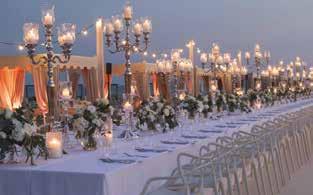

Its name, Alpemare - Alps and Sea, in Italian - is not only the glorification of a symbol; it is also, and most of all, the identification with the essence of a place that, positioned between the Tyrrhenian Sea and the Apuan Alps, has been gifted by nature with an environment that is truly one of a kind. The power of this combination has successfully transformed a traditional beach resort into a location that has become the crown jewel, as it is com monly acknowledged, of Forte dei Marmi and Versilia.
Bagno Alpemare is in fact the realisation of the dream of the Bocelli family - of Veronica, Andrea and their children. This treasure was simply waiting to be able to express itself in new and powerful beauty and grace, to transform into something that love for the territory, sense of belonging, passion, willingness to get things done, sensitivity and good taste have managed to convert into something truly special.
In hindsight, one could say that Bagno Alpemare was, for Andrea Bocelli’s family, right in the order of things; a quite natural choice to express themsel ves in this beach resort that history had placed right across from their home. As it became reality, the idea could not fail to express the baggage of values and of a way of thinking the authentic refinement of “Good Living”. This is that feeling well that you can taste right as you enter Bagno Alpemare, which entrusts its guest-welcoming to a marvellous pine grove that replaces the all-too-present car parks, not necessary here thanks to the exclusive car service. As they step onto the garden, guests find themselves immersed in the scents and in the green of a journey for the senses, among nature and works of art, which will follow them and take them all the way to the heart of the establishment. And then on to the beach itself, where not just the usual parasols are in-

71
stalled, but also the ordered theory of fifty-four splendid tents (with cabins available with safe, USB ports and shower/beach kits) that gently go down the shore until they are lapped by the sea.
The restaurant is at the full disposal of guests in its everyday proposal of a refi ned cuisine based on the freshness of its raw materials. Executive Chef Mirko Caldino gives preference to Mediterranean colours, accurately arranged in the dishes. This is a genuine, spontaneous cuisine, simple and yet not to be taken for granted, traditional but also experimental, made up of particular, refined and very creative combinations that enhance all five senses.
A richly supplied bar is open non-stop from breakfast to aperitif, and is also available for private and exclusive parties. Of course, it also has a piano, as well as live music and a choice of evening events, to create intriguing entertainment occasions. Who knows, the voice of maestro Andrea Bocelli himself may even be heard in the venue - he comes often to Alpemare to enjoy moments of relaxation.
Not just swimming, not just beach-going, not just resting, not just leisure. Alpemare is even more, to complete its other way of understanding hospitality and of being a place where everyone is content. A splendid frame and an ideal and exclusive location for weddings, corporate and private events, from parties to birthdays, from soirées to ceremonies, offering a high-quality staff and establishment, from the magic of the pine grove to the sophistication of the beach.

From everything we have just described, it is understandable why Bagno Alpemare has become, in just a few years, one of the most coveted gems of Versilia. A land whose mundane fame began with a Medici pope, Leo X, and which was raised to destination of choice of the Italian and international bel mondo, not only of great poets such as Eugenio Montale, Giuseppe Ungaretti and Gabriele D’Annunzio, but also of extraordinary singers, from Edith Piaf to Mina and Ray Charles.
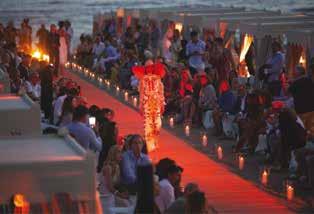
72
Nusret Göçke

GLASS HOUSE & SPA in armonia nella natura in harmony with nature
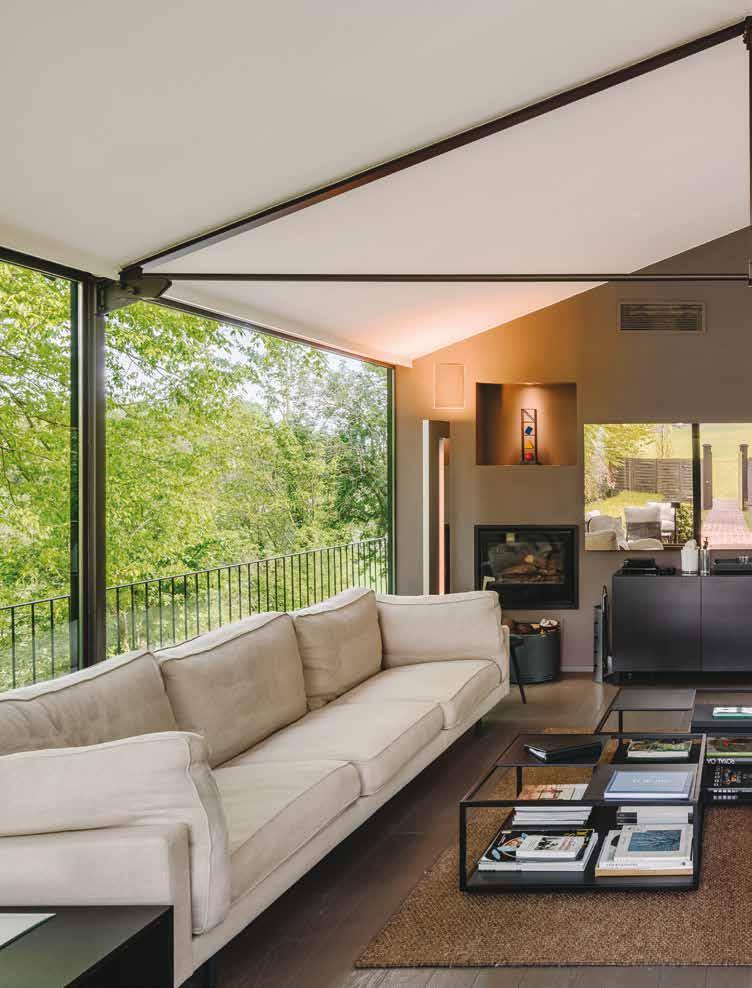
74 MONFERRATO
Glass House & SPA


75 PIEMONTE
VETRO, ACCIAIO E LEGNO in un paesaggio che cambia ad ogni stagione
Tecnologia, sostenibilità e comfort si fondono nella natura di questo paradiso in mezzo al patrimonio Unesco del Monferrato, terra di tartufi, grandi vini, natura e cucina impareggiabile.
La Glass House & SPA si trova su una collina in Monferrato compresa nella lista del Patrimonio dell’Umanità Unesco; un’area di grande bellezza, storia millenaria, tradizione culinaria e famosa per il suo tartufo bianco considerato il più pregiato del mondo. È il luogo ideale per celebrare un momento di coppia importante, un anniversario, un compleanno, una luna di miele o un weekend in pieno relax, privacy e intimità. Disponibile anche per eventi esclusivi in un paesaggio che cambia in ogni stagione creando sempre nuove esperienze, dai fiori della primavera alla luce intensa dell’estate, ai colori dell’autunno al contrasto del clima temperato interno rispetto alla neve o alla natura dell’inverno circostante.
La suite è circondata da 2000 m² di giardino botanico, con centinaia di specie di fiori e piante appositamente selezionate e integrate per regalare un’esperienza unica in ogni stagione. Costruita interamente in vetro, acciaio e legno, vincitrice del Best Bio Spa Award 2021 e certificata DCA nella massima categoria relativa alla sostenibilità, con i servizi di Sauna, Jacuzzi Virtus esterna, Bagno Turco e Cromoterapia, la suite utilizza solo energia verde. È inoltre dotata di un impianto fotovoltaico TESLA ad alto

GLASS, STEEL AND WOOD IN AN ENVIRONMENT THAT SEASONALLY CHANGES
Technology, sustainability and comfort come together in the nature of this paradise in the midst of the UNESCO heritage of Monferrato, land of truffles, great wines, nature and incomparable cuisine. The Glass House & SPA is located on a hill in Monferrato included in the UNESCO World Heritage list; an area of great beauty, millenary history, culinary tradition and famous for its white truffle considered the most precious in the world. The suite is the perfect place to celebrate an important moment as a couple, an anniversary, a birthday, a honeymoon or for a weekend in complete relaxation, privacy and intimacy. It is also available for exclusive events in a landscape that changes in every season, always creating new experiences from spring flowers to the intense light of summer, to the colours of autumn to the contrast of the internal temperate climate compared to winter snow or the surrounding nature. The suite is surrounded by 2000 m² of botanical garden, with hundreds of species of flowers and plants specifically selected and integrated to give a unique experience in every season. Entirely built in glass, steel and wood, winner of the Best BIO Spa Award 2021 and certificated CDA for sustainability requirements, the suite uses only green energy for the services of Sauna, external Virtus Jacuzzi, Turkish Bath and Chromotherapy. It is also equipped with a high-potential Tesla photovoltaic system which makes it energy independent.
76
potenziale che la rende energeticamente indipendente.



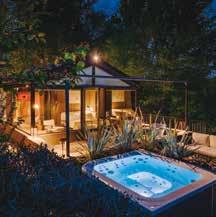



77
GRAND HOTEL ET DE MILAN tutto il fascino di un’antica casa milanese all the charm of an old Milanese town mansion


MILANO
Grand Hotel et de Milan


LOMBARDIA
ATMOSFERA IRRIPETIBILE di ambienti custodi del tempo
Il Grand Hotel et de Milan, un luogo ricco d’atmosfera che conserva tutto il fascino di un’antica “casa” milanese, è nato nel 1863 ed ancora oggi è l’hotel prediletto dalle celebrità della cultura, dello spettacolo, della moda, della musica e del business nazionale ed internazionale. La struttura è guidata dalla famiglia Bertazzoni ed è una gestione tutta al femminile. Le 95 camere, disposte su 5 piani, sono eleganti e raffinate e conquistano con l’atmosfera irripetibile di ambienti arricchiti nel tempo con oggetti e arredi esclusivi. Spiccano tra queste le suite dedicate a personaggi illustri tra cui Eleonora Duse, Maria Callas, Lucio Dalla e molti altri. La suite Giuseppe Verdi fu scelta dal Maestro come dimora per 27 anni e proprio qui vennero composte alcune delle sue opere più importanti. Presso i rinomati ristoranti del Grand Hotel et de Milan è possibile intraprendere un percorso tra i sapori della città meneghina. Il ristorante Don Carlos è un luogo intimo e raffinato dove cenare a lume di candela, incorniciato da quadri, bozzetti e scenografie provenienti dal museo del Teatro alla Scala. La sua cantina vanta circa 200 tra le più prestigiose etichette. Il Caruso, con la sua accogliente veranda e il suo dehor immerso nel verde della Piazzetta Croce Rossa, è un ampio spazio luminoso che propone specialità home-made e tradizionali rivisitate in chiave moderna. Il Gerry’s con il suo American bar è il luogo ideale per un aperitivo nel cuore di Milano.

UNIQUE ATMOSPHERE OF A TIME KEEPING PLACE
The Grand Hotel et de Milan, a place rich in atmosphere that retains all the charm of an old Milanese town mansion, was born in 1863 and it continues to attract leading figures from international culture, show-business, fashion, the world of music and business. The property is led by the Bertazzoni family with an all-female management. The 95 rooms situated on 5 floors are elegant and refined with the captivating atmosphere of interiors that have been wisely furnished over the years with exclusive furniture. Among those rooms, the suites dedicated to illustrious people stand out, like Eleonora Duse, Maria Callas, Lucio Dalla e many others. The Giuseppe Verdi suite has been chosen by the Maestro as his personal apartment and here he composed some of his most important works. In the renowned restaurants of the Grand Hotel et de Milan it is possible to undertake a culinarian path through the flavours of the city. The Don Carlos restaurant is an intimate and refined place where to dine by candlelight and it is framed with paintings, sketches and scene-paintings from the La Scala Theatre Museum. His cellar has around 200 of the most prestigious wines. The Caruso, with its cozy veranda and its dehor surrounded by green and facing the Piazzetta Croce Rossa, The Caruso Rastaurant is a bright and wide place, which proposes home-made and traditional specialties, revisited in a contemporary key. The Gerry’s and its American bar are the ideal place where to enjoy an aperitivo in the heart of Milan.
80





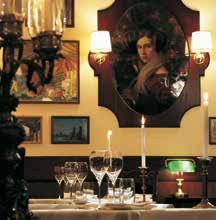

81


Penske

Automotive Italy
di/by: Enzo Millepiedi 85
I PRIMI DIECI ANNI DI SUCCESSO
Penske Automotive Italy è la filiale italiana del colosso americano Penske Automotive Group Inc., con sede a Bloomfield Hills - Michigan, società internazionale che gestisce concessionari automobilistici e commerciali in tre continenti e nove paesi rappresentando più di 40 marchi con oltre 27.000 collaboratori in tutto il mondo. La filiale italiana, che ha festeggiato quest’anno i suoi primi dieci anni, è il più importante Dealer Automotive Italiano del segmento Premium e Luxury, con venti sedi concentrate tra Emilia-Romagna e Lombardia, è nata nel febbraio 2012 dalla joint venture tra Penske Automotive e le famiglie Vanti-Mantellini e conta su oltre 630 collaboratori. Il suo business, storicamente legato ai marchi BMW e MINI, si è allargato negli anni con l’acquisizione di Concessionarie rappresentanti i brand Audi, Jaguar-Land Rover, Lamborghini, Maserati, Mercedes-Benz e Smart, Porsche e Volvo e, ad oggi, rappresenta undici brand Premium e Luxury.
Andrea Mantellini, CEO e Managing Director ed Elena Alberti, Managing Director e CFO di Penske Automotive Italy, hanno festeggiato questa prima decade di successi con questi commenti che svilupperemo insieme a loro nelle interviste dedicate.

Andrea Mantellini: “Sono molto contento della scelta strategica fatta 10 anni fa. La Joint Venture con Penske Automotive ci ha portato a espanderci e affermarci sul territorio italiano come più importante Dealer Automotive del segmento Premium e Luxury. Le cose che più mi rendono fiero sono la crescita del nostro team, la soddisfazione che ci manifestano i nostri clienti e le ottime relazioni create con le case costruttrici dei brand che rappresentiamo. I prossimi anni? Saranno molto sfidanti per il mercato Automotive, ma siamo pronti ad affrontarli al meglio.”
Per Elena Alberti: “A distanza di dieci anni dall’investimento sono estremamente orgogliosa sia per i risultati che per il team. Negli anni abbiamo affinato le competenze e costruito un team manageriale giovane, molto solido e professionale. Adesso siamo pronti a nuove sfide, per offrire ai nostri clienti un’esperienza Penske sempre più unica e a 360° gradi. Stiamo lavorando per rendere le nostre strutture e le nostre organizzazioni sempre più all’avanguardia, ma sono i nostri valori di etica, trasparenza ed affidabilità a contraddistinguerci a livello mondiale, perché la soddisfazione del cliente, interno ed esterno, è da sempre al centro della nostra strategia mondiale.”
86
Da sinistra/from left: Roger Penske, Elena Alberti, Andrea Mantellini
INTERVISTA A ELENA ALBERTI
Italia-Stati Uniti-Italia, passando per la Germania, è un percorso che le ha dato opportunità non certo scontate mettendola a confronto con diverse mentalità e soprattutto diversi valori. Quali di questi valori manageriali vissuti nell’esperienza americana, e poi teutonica, sono adattabili alla cultura (e mentalità) italiana?
Io ritengo che non esistano regole precise e valori che sono adattabili e non adattabili. Il mio approccio, ovunque sono andata, è stato quello di cercare di prendere il meglio di ciò che quel posto aveva da offrirmi: “take the best of all worlds”. Dall’America ho portato a casa principalmente 3 cose: la meritocrazia, l’atteggiamento sempre vincente davanti ai problemi e il saper andare avanti concentrandosi sul futuro. Mai guardare indietro nello specchio retrovisore, ma sempre solo davanti nel parabrezza. Dalla Germania ho imparato il rispetto delle regole
e delle strutture, il rigore e la massima serietà nel mantenere la parola data. In Italia ho cercato di prendere le cose che funzionavano dove ero stata e di implementarle insieme. Applicare in un paese come l’Italia la meritocrazia, all’inizio è complicato, ma è un approccio che dà risultati molto positivi e fa crescere una squadra molto forte.
Quale è secondo lei il punto di incontro e di forza tra il pragmatismo americano dell’effort equals results e la fantasia creatrice italiana come risorsa non aggiuntiva ma originale del team di Penske Automotive?
La cosa molto interessante è la combinazione di queste due cose. È un mix invincibile che porta a grandi risultati. Mettere l’ingegno italiano in un contesto di maggiore rigore, struttura e orientamento al risultato come quello americano, porta a risultati eccezionali. Abbiamo cercato di ricreare un ambiente pseudo americano in termini di regole in Italia, e
ROGER PENSKE - “THE CAPTAIN”
Conosciuto come “The Captain”, Roger Penske, classe 1937, fondatore del Gruppo, diventa un famoso pilota automobilistico statunitense negli anni Cinquanta. Nel 1961 è eletto pilota dell’anno dello Sports Car Club of America. Dopo il ritiro dalle corse fonda uno dei team più vittoriosi della IndyCar Series e del campionato Nascar, il Team Penske e acquista il Circuito di Indianapolis (2019). Il Team Penske è anche uno dei nomi più vincenti anche nella 500 Miglia di Indianapolis, con 18 successi. Oltre alla pista si afferma anche come imprenditore di successo fondando la Penske Automotive Group, Inc, di cui è il CEO, sviluppando un business che attualmente opera nell’Automotive, nei trasporti, nella logistica e nel mondo delle corse. Venuto in visita a fine marzo in occasione della celebrazione dei dieci anni di Penske Automotive Italy, ha portando come sempre una carica di energia a tutta la squadra, esemplare modello di leadership, rispetto delle persone e instancabile spirito imprenditoriale, sempre focalizzato sull’attenzione al dettaglio e sulle risorse umane. Che si tratti di clienti o di collaboratori, “perché sono le persone l’elemento fondamentale e più importante per un business vincente”.
Known as The Captain, Roger Penske, class 1937 and founder of the Group, became a famous American racer in the 1950’s. In 1961 he was elected pilot of the year by Sports Car Club of America. Following his retirement from the race tracks, he founded one of the most successful teams of IndyCar Series and Nascar, Team Penske, and acquired the Indianapolis Circuit in 2019. Team Penske is also one of the most successful names in the 500 Miles of Indianapolis, with 18 victories. Beyond the race track, Penske also successfully founded the Penske Automotive Group, Inc, of which he is the CEO, developing a business that currently operates in the automotive industry, transportation, logistics, and in the racing world. During his visit to Italy, in March, for the celebration of the tenth anniversary of Penske Automotive Italy, he brought, as he usually does, an energy boost for the entire team, an exemplary model of leadership, of respect for people and of tireless entrepreneurial spirit, always focusing on attention to detail and on human resources. Whether they are clients or employees, “because people are the fundamental and most important element for a successful business”.
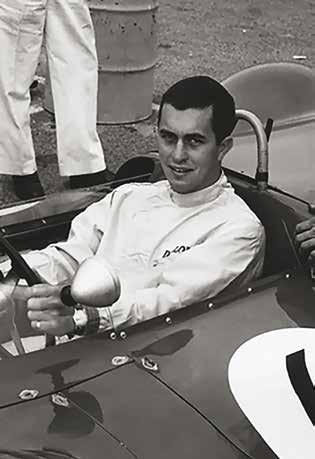
87
vediamo che in questo contesto si performa meglio e si raggiungono maggiori obiettivi.
Quando si danno consigli ai giovani per il loro futuro gli si dice: studiare, crederci, applicarsi. Lei che cosa aggiungerebbe?
Ai giovani direi di cercare di presentarsi sempre sicuri di se stessi, se si può di fare almeno un’esperienza all’estero e la cosa più importante in assoluto: avere sempre un atteggiamento sempre positivo. Essere positivi è la cosa che più fa la differenza in qualsiasi approccio al mondo.
Si parla molto, in Italia, di “cervelli” in fuga e di “cervelli” da fare rientrare, addirittura anche a norma di legge di favore. Che pensa di questo fenomeno? Che consigli darebbe ai giovani in Italia e nel mondo? Sono andata via dall’Italia a 22 perché avevo un’idea molto precisa di cosa volevo ed ero molto ambiziosa. L’ambiente meritocratico dell’America mi ha consentito di crescere e avviare la mia carriera. Stavo benissimo all’estero, ma ad un certo punto si sono create delle condizioni per le quali ho capito che volevo tornare in Italia che è un Paese meraviglioso. Io ho scelto di tornare, perché volevo portare in Italia
quello che ho trovato in America, quell’ambiente che mi ha aiutato a livello personale e professionale. Il mio consiglio è che tutte le persone in carriera dovrebbero andare all’estero per un periodo, è un’esperienza che ti fortifica e ti fa crescere più di ogni altra cosa. L’allontanarsi per un periodo ti aiuta ad apprezzare ancora di più il nostro Paese, ti mette in una prospettiva dalla quale vedi tutte le cose positive dell’Italia. Quindi è giusto andare via, ma anche tornare. Il regalo più grande che mi ha fatto l’America è stato quello di tornare in Italia e vederla con occhi diversi e amarla ancora di più.
INTERVISTA AD ANDREA MANTELLINI
Ad oggi quali risultano essere, secondo lei, i punti di forza espressi dal mix dei valori italo-americani acquisiti dal vostro dna manageriale?
Dopo 10 anni dalla firma della Joint Venture tra il Gruppo Penske e la mia famiglia, posso affermare con soddisfazione che la strategia è stata azzeccatissima per tutte le parti coinvolte. Gli americani sono molto diretti e pragmatici, noi italiani siamo più riflessivi e restii al cambiamento. La miscela di queste caratteristiche ha portato un enorme valore aggiunto per la crescita dell’azienda.

88
Andrea Mantellini, Elena Alberti
Il mondo dell’Automotive sta vivendo una profonda trasformazione dai contorni ancora sfumati: quale è il suo punto di vista?
Negli ultimi anni il settore automotive ha affrontato diverse situazioni di carattere straordinario, in particolare la crisi dei semiconduttori e la conseguente scarsità di auto disponibili; l’avvento dell’elettrico con tutte le dinamiche che ne conseguono. Se poi a ciò aggiungiamo la pandemia, la guerra in Ucraina e la problematica dei costi dell’energia, diciamo che le sfide non sono mancate!
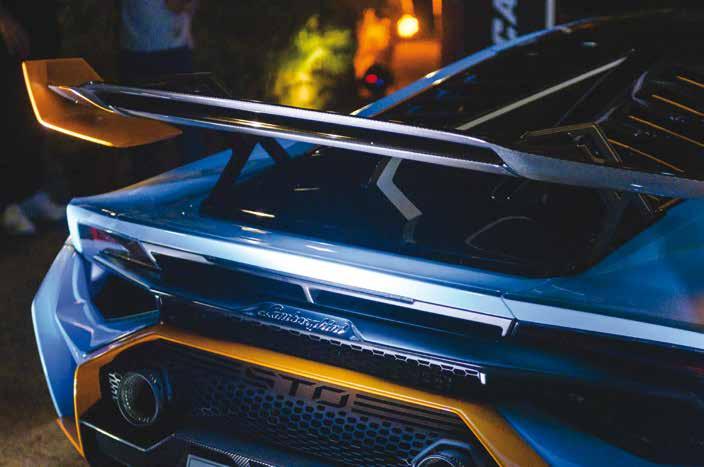
A prescindere, ritengo che il percorso verso l’elettrico sia un dato di fatto, anche se in Italia siamo ancora indietro rispetto ad altri paesi europei. Il ritardo principale è da attribuire alla carenza delle infrastrutture di ricarica delle vetture. Nel contempo, non escluderei lo sviluppo di fonti alternative (ad es. l’idrogeno) e perchè no, una parziale rivisitazione di scenari a favore delle motorizzazioni tradizionali di ultima generazione ed a basso impatto ambientale.
Di quali attenzioni avrebbero bisogno i gruppi e le aziende, in particolare del vostro target, per costruire il nuovo futuro?
Il settore automotive con il suo indotto rappresenta circa il 10% del Pil in Italia, è pertanto uno dei settori trainanti per il nostro paese. In questa fase di transizione epocale, con il graduale passaggio dalle vetture termiche alle vetture elettriche, saranno fondamentali interventi centrali per supportare la trasformazione dell’intera filiera. Diversamente, corriamo il rischio di perdere aziende da sempre protagoniste del settore.
Qual è il contributo che potete dare voi all’economia e allo sviluppo?
In virtù della trasformazione in atto citata sopra (elettrificazione), si stanno aprendo svariate opportunità sia per le aziende del settore, ma anche e soprattutto per aziende “new entry”, che daranno un forte impulso all’economia. Si sta producendo tanta nuova tecnologia, orientata alla salvaguardia del pianeta nel futuro.
89
PENSKE AUTOMOTIVE ITALY
THE FIRST TEN YEARS OF SUCCESS
Penske Automotive Italy is the Italian branch of North American colossus Penske Automotive Group Inc., with headquarters in Bloomfield Hills - Michigan, an international company that manages automobile and commercial dealerships in three continents and nine countries, representing more than 40 brands with over 27,000 employees throughout the world.
The Italian branch, which celebrated its tenth anniversary this year, is the most important Italian Automotive Dealer in the Premium and Luxury sector, with twenty dealerships concentrated between the regions of Emilia-Romagna and Lombardy. It was established in February 2012 from the joint venture between Penske Automotive and the Vanti-Mantellini families, and has more than 630 employees. Its business, historically related to the BMW and MINI brands, has expanded over the years with the acquisition of dealerships representing Audi, Jaguar-Land Rover, Lamborghini, Maserati, Mercedes-Benz and Smart, Porsche, and Volvo. Today, it represents eleven Premium and Luxury brands.

Andrea Mantellini, CEO and Managing Director, and Elena Alberti, Managing Director and CFO of Penske Automotive Italy, have celebrated this first decade of success with these comments, which we will be developing with them in their own interviews.
Andrea Mantellini: “I’m very happy with the strategic choice we made 10 years ago. The joint venture with Penske Automotive has led us to expand and to establish ourselves as the most relevant Automotive Dealer in the Premium and Luxury sector. The things that give me the most pride are the growth of our team, the satisfaction demonstrated by our clients, and the excellent relations created with the manufacturers and brands we represent. The upcoming years? They will be very challenging for the automotive sector, but we’re ready to face them the best way we can”.
For Elena Alberti: “Ten years after the initial investment, I’m extremely proud both of our results and of our team. Over the years we have fine-tuned our skills and built a young, very solid and professional managerial team. Now we’re ready for new challenges, to offer our clients an always unique and all-round Penske experience. We are working to make our structures and our organizations increasingly modern, but it’s our values of ethics, transparency and reliability that make us stand out at a global level, because the satisfaction of our clients, both internal and external, has always been the core of our global strategy” .
90
INTERVIEW WITH ELENA ALBERTI
Italy-United States-Italy, with a stop in Germany, is a trajectory that has given you opportunities not to be taken for granted, putting you in contact with different mindsets and, in particular, different values. Which of the managerial values you lived during your American experience, and later in Germany, can be adapted to the Italian culture and mentality?
I think there are no precise rules or values that can be adaptable or not adaptable. My approach, regardless of where I was, has always been that of attempting to grasp the best the place had to offer: to take the best of all worlds. From America I’ve brought home three main things: meritocracy, an always winning behaviour when facing problems, and knowing how to move forward while focusing on the future. Never look back on your rearview mirror; only look at the windshield in front of you. From the Germans I learned to respect rules and structures, rigour and maximum sobriety when it comes to one’s given word. In Italy I have attempted to take things that were not working where I had been, and to implement them together. Applying meritocracy in a country such as Italy is complicated at first, but it is an approach that yields very good results and ends up creating a very strong team.
What are, in your opinion, the meeting point and the strong point between American pragmatism (effort equals results) and the Italian creative imagination as a non additional resource, but as something original of the

Penske Automotive team?
The really interesting thing is the combination of these two things. This is an invincible mixture that leads to great results. Putting Italian ingenuity in a context of more rigour, structure and resultoriented mindset, such as the American context, leads to exceptional results. We have attempted to recreate in Italy a pseudo-American environment in terms of rule enforcement, and we can see that in this context we perform better and achieve higher goals.
When we give advice to the young, we usually tell them to study, to believe in it, to be dedicated. What else would you add?
To young people I say, always try to show you’re sure of yourself. If possible, spend some time abroad. And the absolutely most important thing of all: always have a positive attitude. Being positive is the thing that makes a difference in any approach to the world.
In Italy there is much talk of brain drain and of brains that should be made to return; some even talk of using legal tools to do so. What do you think of this? What advice would you give to young people in Italy and all over the world?
I left Italy at 22 because I had a very clear idea of what I wanted, and I was very ambitious. The meritocratic environment I found in America allowed me to grow and to kick-start my career. I was doing great abroad, but at a certain point the conditions were such that I
91



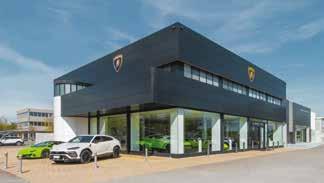

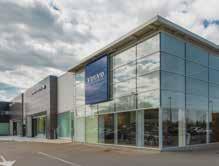

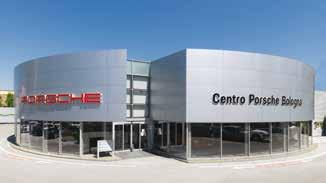



92
understood I wanted to return to Italy, which is a wonderful country. I chose to come back because I wanted to bring to Italy what I had found in America, that environment that had helped me on a personal and professional level. My advice is that all career-oriented people should spend some time abroad. It’s an experience that makes you stronger and will make you grow more than anything else. Staying away for a while helps you appreciate our country even more, and it places you in a perspective from which you can see all the positive things Italy has to offer. So it’s great to go away, but it’s also great to come back. The greatest gift America has given me was that of coming back to Italy ad seeing it with different eyes, and loving it even more.
INTERVIEW WITH ANDREA MANTELLINI
What do you believe are, today, the strong assets expressed by the blend of Italian-American values acquired by your managerial DNA?
After 10 years of the joint venture between the Penske Group and my family, I can gladly state that the strategy has been incredibly successful for all parties involved. Americans are much more pragmatic and straightforward, while Italians tend to be more reflexive and resistant to change. The mixture of these characteristics has led to an incredible amount of added value for the company’s growth.
The automotive world is going through a profound transformation whose outlines are yet a little blurred. What is your viewpoint on this?
In the past few years the automotive sector has faced many extraordinary situations, especially the semiconductor crisis and the

consequent scarcity of available vehicles; the advent of electric cars and all the consequent dynamics. Add to those the pandemic, the war in Ukraine, and the problems related to electricity costs, and, well, we’ve had our share of challenges, let’s put it that way! In any case, I believe that the shift to electric vehicles is a given fact, although Italy is still lagging behind other European countries. The main reason for this is the lack of recharging infrastructure. At the same time, I cannot rule out the development of alternative sources (such as hydrogen) and, why not, a partial revisitation of scenarios that favour traditional lastgeneration motorisations with low environmental impact.
What do you think groups and companies need, especially considering your target, in order to build a new future?
The automotive sector represents about 10% of Italy’s GIP, and is one of the country’s driving forces. In this momentous transition phase, with the gradual shift from thermal vehicles to electric vehicles, central interventions will be crucial to sustain the transformation of the entire production cycle. Otherwise, we risk losing companies that have always been protagonists in this sector.
How do you think you can contribute to the economy and to development?
Considering the ongoing transformation mentioned before (electrification), many opportunities are opening for companies in the sector, but first and foremost for “new entries”, new companies that will provide the economy with a strong boost. A lot of new technology is being produced, focused on the protection of the planet in the future.
93

94
dell’Industria,

95 100% electric Audi RS e-tron GT with 646 hp. Most powerful ever. Find out more in our Dealerships. Combined electric power consumption in kWh / 100 km¹: 21,7–20,7 (WLTP); combined CO2 emissions in g/km (g/mi): 0. Combined test cycle range (WLTP): 422 - 430 km; CO2 emissions combined test cycle: 0 g / km. Future in an attitude. Powered by ideas. Via
36 - Bologna Via Pola, 13 - Imola (BO) Via G. Rossa 2/4 - Casalecchio di Reno (BO) audibologna.penskeautomotive.it

FORTE DEI MARMI GRAND HOTEL IMPERIALE attenzioni esclusive ed impeccabili exclusive and impeccable care
Grand Hotel Imperiale

TOSCANA
LUSSO E STILE per vivere Forte dei Marmi
Il Grand Hotel Imperiale è un 5 stelle lusso situato in una splendida posizione nell’isola pedonale di Forte dei Marmi, in Versilia. Distante solo 200 metri dal mare, circondato dalle splendide Alpi Apuane, questo hotel offre agli amanti dello stile e del lusso la perfetta sistemazione per rilassarsi e ripristinare il loro benessere fisico e mentale. Il parcheggio coperto, sorvegliato 24 ore, permette agli ospiti di lasciare in totale sicurezza la propria auto ed usufruire delle biciclette a loro disposizione per vivere pienamente Forte dei Marmi. Il Grand Hotel Imperiale accoglie la sua clientela in camere esclusive, capaci di regalare momenti di elegante intimità in un ambiente accogliente, dove la cura di ogni dettaglio diventa impeccabile. Tinte pastello e inserti oro si alternano a pregiati tessuti dai colori naturali, impreziosendo gli interni e rendendoli unici nel loro genere. Inoltre, solo in una terra come la Toscana, circondati da memorie storiche, poteva nascere la più esclusiva delle Spa, un luogo dove il corpo e la mente trovano conforto in mani esperte, cultrici di una sapienza antica, tramandata fino ai nostri giorni.
STYLE AND LUXURY FOR LIVING FORTE DEI MARMI
The Grand Hotel Imperiale is a 5-star luxury hotel of recent construction situated in a splendid position in the pedestrian area of Forte dei Marmi, in Versilia. Only 200 metres from the sea, and surrounded by the splendid Apuan Alps, this hotel offers, to lovers of style and luxury, a perfect accommodation in which to relax and to recover their physical and mental wellbeing. The covered parking, under 24 hours a day surveillance, makes it possible for guests to leave their cars perfectly secure and to use the bicycles that are at their disposal, in order to enjoy the Forte dei Marmi experience to the fullest. The Grand Hotel Imperiale welcomes its clientele to its exclusive rooms, which offer elegant intimacy in comfortable surroundings, and where impeccable care is devoted to every detail. Pastel colours and gold panelling alternate with luxury fabrics in natural colours, creating rich interiors that are unique of their kind. The most exclusive of Spas could only be located in Tuscany, a land abounding in historic memories, the road leading past the famed marble quarries.

98
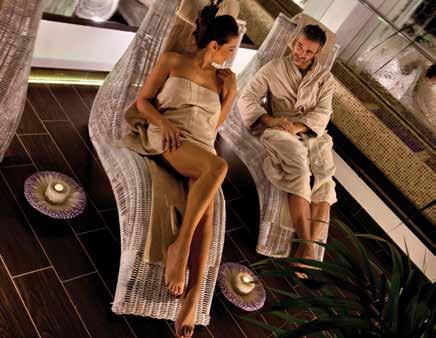

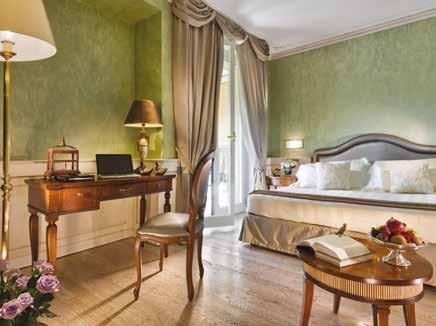




99
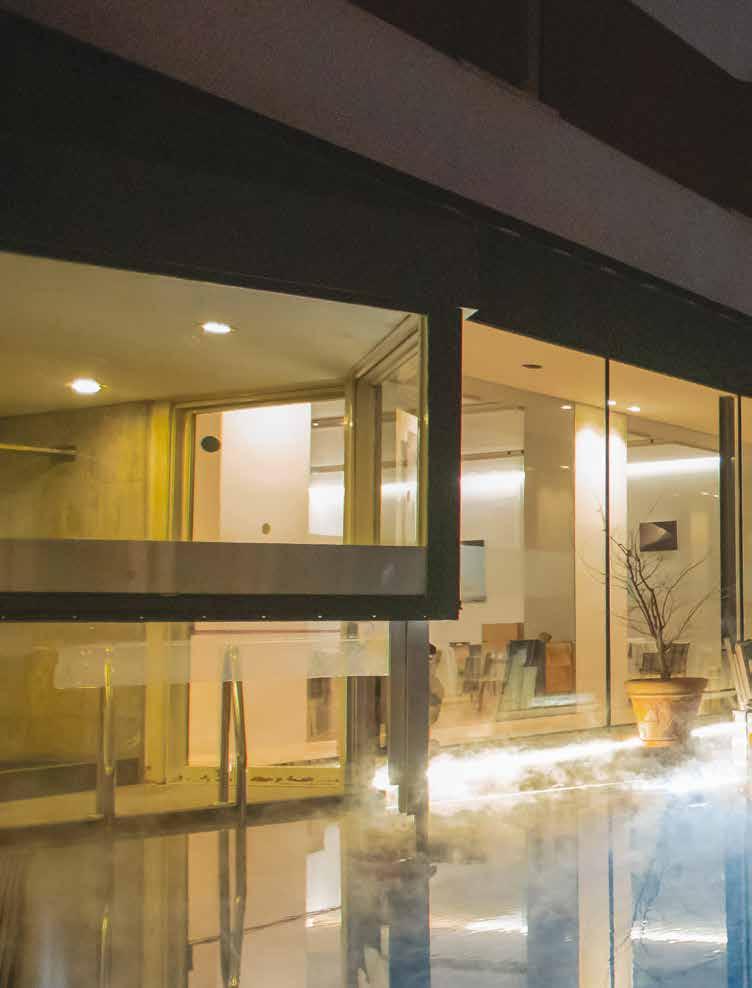
COURMAYEUR GRAND
HOTEL
ROYAL
E GOLF
punto di riferimento per ospiti illustri an ideal location for illustrious guests
Grand Hotel Royal e Golf

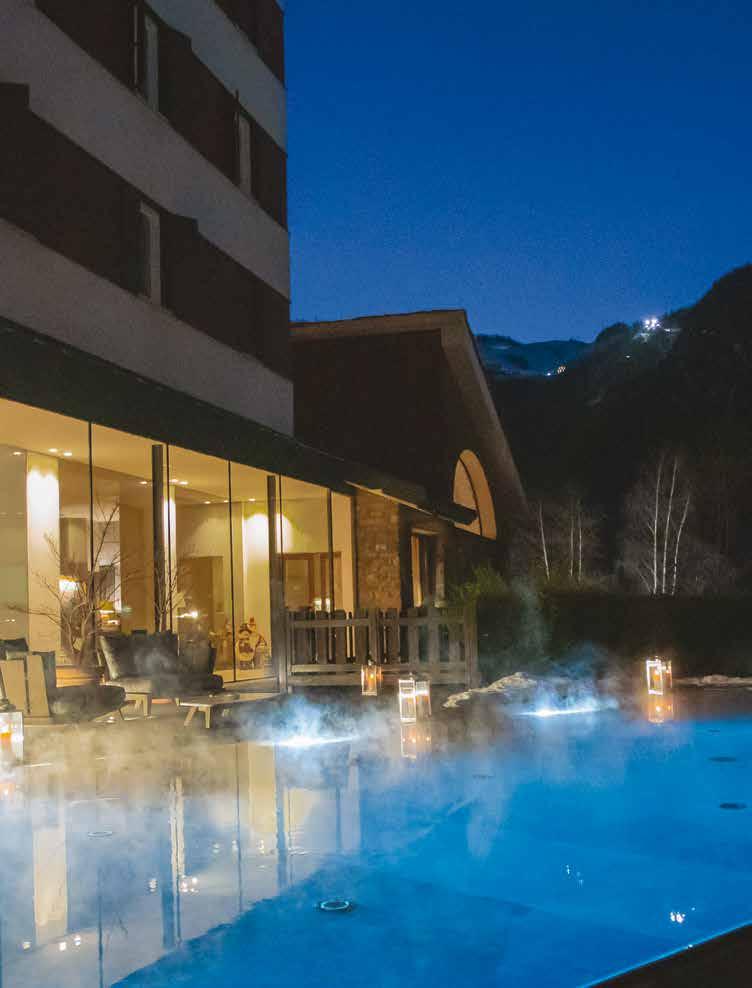
VALLE D’AOSTA
OSPITALITÀ REGALE nel cuore di Courmayeur
Il Grand Hotel Royal e Golf risale al 1854 e nella sua vita centenaria ha ospitato illustri personaggi, quali la Regina d’Italia Margherita di Savoia, in onore della quale fu dato il nome “Royal” all’albergo. Massimo Chiappo Buratti dirige abilmente la struttura portando l’esperienza pluriennale ed internazionale. La sua ospitalità propone stanza Deluxe, Prestige, Junior Suite e Suite, con lo charm discreto di un’eleganza senza tempo e la vista mozzafiato sul massiccio del Monte Bianco. Non manca l’esperienza culinaria e gastronomica ricercata e sorprendente: il Lounge Bar Royal, cuore pulsante della mondanità di Courmayeur con una selezione di cocktail e distillati unica, il Ristorante Grand Bistrot con proposte della tradizione valdostana, ricerca di prodotti autoctoni ed una carta dei vini dedicata alle meraviglie delle Valle d’Aosta; il Ristorante Royal, nella celebre sala disegnata da Giò Ponti, con una scelta di piatti della tradizione culinaria Italiana, strizzando l’occhio alle novità. Per concludere non manca di certo il luogo dove ritrovare se stessi: La Royal Spa, con la piscina esterna riscaldata, sauna finlandese a fuoco di legna, bagno turco e sauna interna, oppure la private Spa per coppia, unitamente a massaggi dedicati. Completa l’offerta un servizio concierge attento e personalizzato, per rendere unico e indimenticabile il soggiorno di ogni ospite.
REGAL HOSPITALTY IN THE HEART OF COURMAYEUR
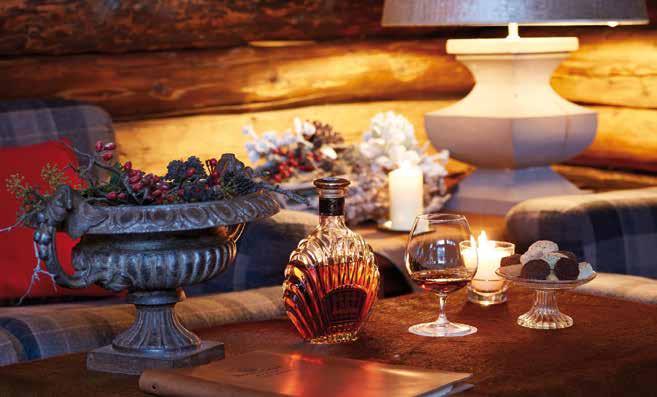
The Grand Hotel Royal e Golf dates back to 1854 and during its centenary life, has played host to illustrious names, such as Queen Margherita of Savoia, a historic stay that gave the hotel its royal name. Massimo Chiappo Buratti skilfully manages the hotel through a substantial worldwide experience.
The hospitality offering comprises deluxe, prestige, junior suite and suite rooms, boasting an elegant timeless charm and a breathtaking view of the Mont Blanc Massif. Then, a culinary and gourmet experience, carefully researched and always surprising: the Lounge Bar Royal, beating heart of the Courmayeur scene with a unique selection of cocktails and distillates; the Ristorante Grand Bistrot with a menu firmly grounded in the Aosta Valley tradition, offering autochthonous products and a wine list dedicated to the treasures of the Valley; the Ristorante Royal, housed in the famous room designed by Giò Ponti, with a menu selection focused on Italian culinary traditions, yet with a nod to innovation.
Last, but not least, the Royal SPA, a cocoon dedicated to mindfulness and wellbeing, with its heated open air swimming pool, Finnish wood fired sauna, Turkish bath and internal sauna, or even the private SPA for couples and a selection of personalised massage and beauty treatments.
Each guest’s stay is orchestrated by an attentive and personalised concierge service, to guarantee a unique and unforgettable experience at the Grand Hotel Royal e Golf.
102


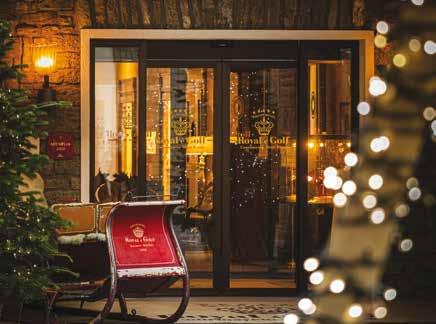



103
L’esperienza unica dell’IMMERSIVE ART EXPERIENCE

PROPOSTA DA EVER IN ART EXCLUSIVE PROJECTS 104

105
Imusei di New York, Amsterdam, Londra, Parigi e Firenze registrano sold-out alle mostre immersive: esposizioni che catapultano i visitatori nell’universo delle opere altrimenti fruibili in maniera bidimensionale. La magia di vivere anche nel proprio salotto un’atmosfera multisensoriale coinvolgente è alla base di Ever in Art Exclusive Projects, un’iniziativa rivoluzionaria che abbina la maestosità dell’opera fisica alle potenzialità del digitale per installazioni private - in ville, yacht, giardini - enfatizzando e valorizzando l’arte tradizionale nei salotti d’élite.
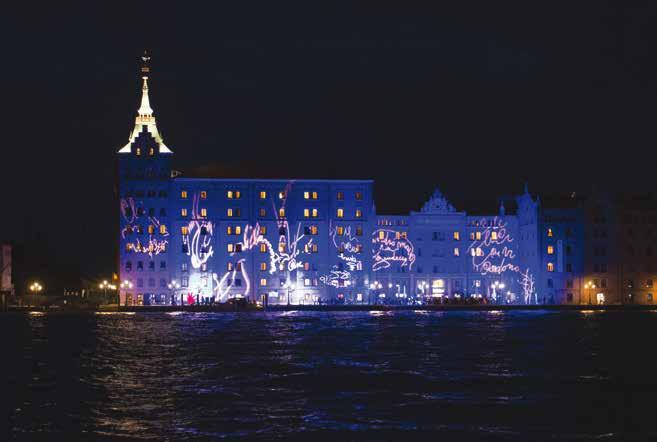
Grazie alla collaborazione con architetti ed interior designer, le forme d’arte immersiva proposte incontrano lo stile personale del committente, elaborate attraverso molteplici tecnologie per creare esperienze totalizzanti, che animano con armonia gli spazi domestici o gli esterni in modo coinvolgente, trasportando fuori dal tempo, in un’altra dimensione. Non solo: le installazioni artistiche possono spingersi oltre, con opere ibride, fatte di sculture o pittura, ma anche di testi, musica, illustrazioni e design progettuale.
Il nuovo modo di collezionare e fruire delle opere arte, alternativo e complementare a quello tradizionale, crea un punto di incontro tra spazio fisico e digitale, che possiamo leggere come l’inizio di esperienze phygital più significative, dove si fonderanno reale e virtuale. Il superamento dei limiti imposti dalla materia delle proposte artistiche di Ever in Art si inserisce in questo nuovo trend evolutivo, con installazioni personalizzate sulla base dello stile e della sensibilità artistica del committente e della sua abitazione, sfruttando l’immenso potenziale offerto dalla tecnologia applicata all’arte per enfatizzare e valorizzare ogni ambiente. Con l’avvento del Metaverso, uno dei mercati che sta emergendo maggiormente è quello immobiliare virtuale, e uno degli obiettivi principali della divisione Exclusive Projects di Ever in Art è portare all’interno di questo nuovo ecosistema - fatto di luoghi di aggregazione, case, uffici - l’integrazione tra arte e tecnologie creative digitali, dando ai collezionisti l’opportunità unica di possedere degli oggetti la cui copia digitale è fruibile anche nel loro personale spazio virtuale.
106
“Le forme d’arte immersiva che proponiamo ai nostri clienti manipolano immagini digitali attraverso molteplici tecnologie di carattere percettivo e partecipativo, dove suoni, colori e luci si fondono con l’arte fisica per creare installazioni artistiche rivoluzionarie, che inseriamo in maniera talora armonica, talora volutamente dirompente, creando atmosfere esclusive, raffinate, con palette cromatiche in grado di suscitare stupore ed emozioni”- racconta l’Architetto Celia Stefania Centonze, partner di Ever in Art a capo del team Exclusive Projects - “Grazie alle collaborazioni con artisti che utilizzano forme di avanguardia tecnologica, siamo in grado di fornire esperienze appaganti, polisensoriali e anche interattive. È possibile, infatti, spingersi fino a forme di arte avveniristica così evolute da consentire di manipolare e modificare le rappresentazioni”. Il progetto d’esordio di Ever in Art Clean Water, Please, è stato concepito dall’artista Marco Nereo Rotelli in collaborazione con l’Associazione Gondolieri Sommozzatori Volontari di Venezia, che in occasione della Biennale Arte Visiva si sono immersi in una performance per la raccolta dei rifiuti nei fondali della laguna. Gli oggetti riemersi, riposti sopra alla tipica imbarcazione veneziana e dipinti di blu Klein, il colore dell’infinito, hanno visto nascere la ‘gondola poetica’, esposta al Museo Storico Navale della Marina Militare, che ha poi proseguito il suo viaggio - reale e virtualeverso Milano, per la Design Week, fino a Genova per la Biennale Arte e Ambiente. Grazie ad un team internazionale di partner tecnologici, Ever in Art ha prodotto una serie di NFT - atti di proprietà e certificati di autenticità - su contenuti artistici legati alla gondola poetica e al suo percorso per la tutela dell’ambiente marino. La performance artistica è presente anche nel Metaverso, dov’è navigabile


tridimensionalmente dall’app Spatial.
Ever in Art ha chiuso la stagione estiva del Museo Poldi Pezzoli di Milano con una soirée dove un gioco di luci vibranti ha dato vita ad un’emozionante installazione artistica nel giardino interno, sulle facciate del palazzo e sulla preziosa fontana nel cavedio delle scale, anch’essa illuminata simulando il riverbero dell’acqua.

THE UNIQUE IMMERSIVE ART EXPERIENCE BY EVER IN ART EXCLUSIVE PROJECTS
Immersive exhibitions in museums in New York, Amsterdam, London, Paris and Florence have sold out. This kind of shows catapult visitors into the universe of works that can otherwise be seen in two-dimensions. Ever in Art Exclusive Projects specialise in the magical possibility of experiencing a mesmerising multi-sensory atmosphere even in one’s own living room. It is a revolutionary initiative which combines the majesty of physical work with the potential offered by the digital world and makes them available for private installations - in villas, yachts, gardens - bringing traditional art to the lounges of the elite.
Thanks to partnerships with architects and interior designers, the types of immersive art that are offered match the personal style of the client. They are developed using a wide range of technologies to create full-on captivating experiences, beautiful contributions to interior and exterior spaces, transporting viewers out of time and into another dimension. The artistic installations extend boundaries, with hybrid works made up of sculptures or paintings, but also of texts, music, illustrations and project designs.
This new, contemporary approach to collecting and enjoying art creates a meeting point between physical and digital space. It marks the beginning of more meaningful phygital experiences, where the
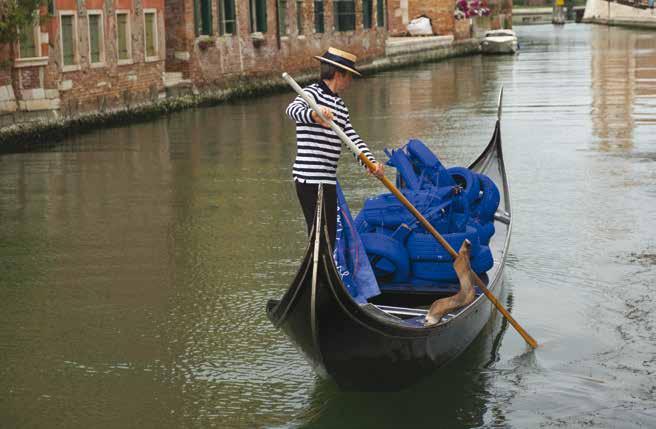
real and virtual blend together. In the art created by Ever in Art, overcoming the limits imposed by materials is part of this new evolutionary trend, with installations that are personalised according to the style and artistic sensitivity of the client and their home, taking advantage of the immense potential provided by technology applied to art to highlight and enhance all spaces. The advent of the Metaverse is being accompanied by a rapid development of the market for virtual real estate, and one of the main goals of the Exclusive Projects department at Ever in Art is to integrate art and creative digital technology into this new ecosystem, consisting of meeting places, houses, offices. This provides collectors with the unique opportunity of owning both physical objects and using digital copies in their personal virtual space.
“We offer our clients forms of immersive art that manipulate digital images through a large range of perceptive and participatory technologies, where sounds, colours and lights intermix with physical art to create revolutionary artistic installations. These occupy their space in a way that is sometimes harmonious, sometimes deliberately unsettling, creating exclusive, refined atmospheres with colour palettes that surprise and thrill,” says Celia Stefania Centonze, an architect and partner at Ever in Art and the
Exclusive Projects team leader. “By working alongside artists that use cutting-edge technology, we can deliver satisfying, multi-sensory and even interactive experiences. One can push oneself to futuristic forms of art that are so evolved that one can manipulate and modify what is depicted”.
108
Ever in Art’s debut project, Clean Water Please, was conceived by the artist Marco Nereo Rotelli in partnership with Venice’s Association of Gondoliers and Volunteer Scuba Divers who, for the Visual Arts Biennale created a performance diving to the bottom of the lagoon to collect rubbish. The objects that were brought up were piled onto a traditional Venetian boat and painted in Klein blue, the colour of the infinite, creating the ‘poetic gondola’ displayed at the Historic Naval Museum of the Italian Navy, before continuing its journey - both real and virtual - to Milan, for the Design Week, and on to Genoa for the Art and Environment Biennale.
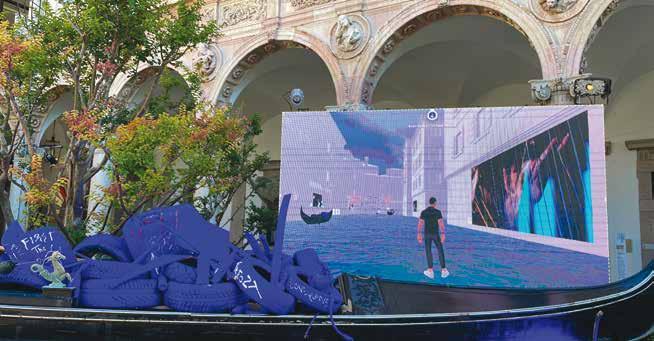
Thanks to its international team of technological partners, Ever in Art has produced a series of NFTs - deeds of ownership and certifications of authenticity - on artistic content linked to the poetic gondola and its mission to protect the marine environment. The artistic performance is also present in the Metaverse, where it can be navigated in three dimensions using the Spatial app. Ever in Art ended the summer season of the Poldi Pezzoli Museum in Milan with a soirée where a set of vibrant lights created an exciting artistic installation in the interior garden, on the façades of the palace and on its beautiful fountain in the stairwell, which itself was illuminated to simulate the reflections from the water.

109
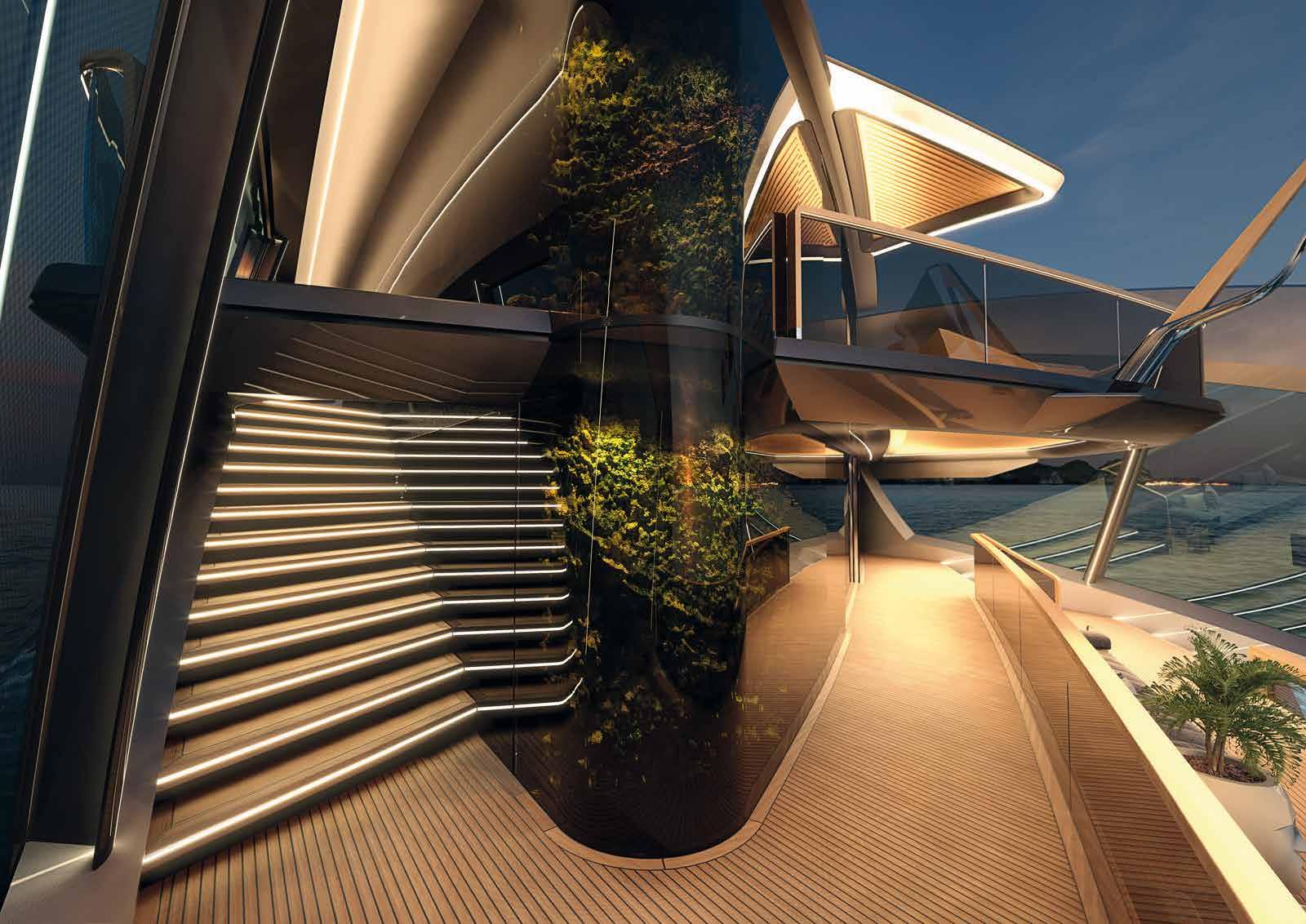
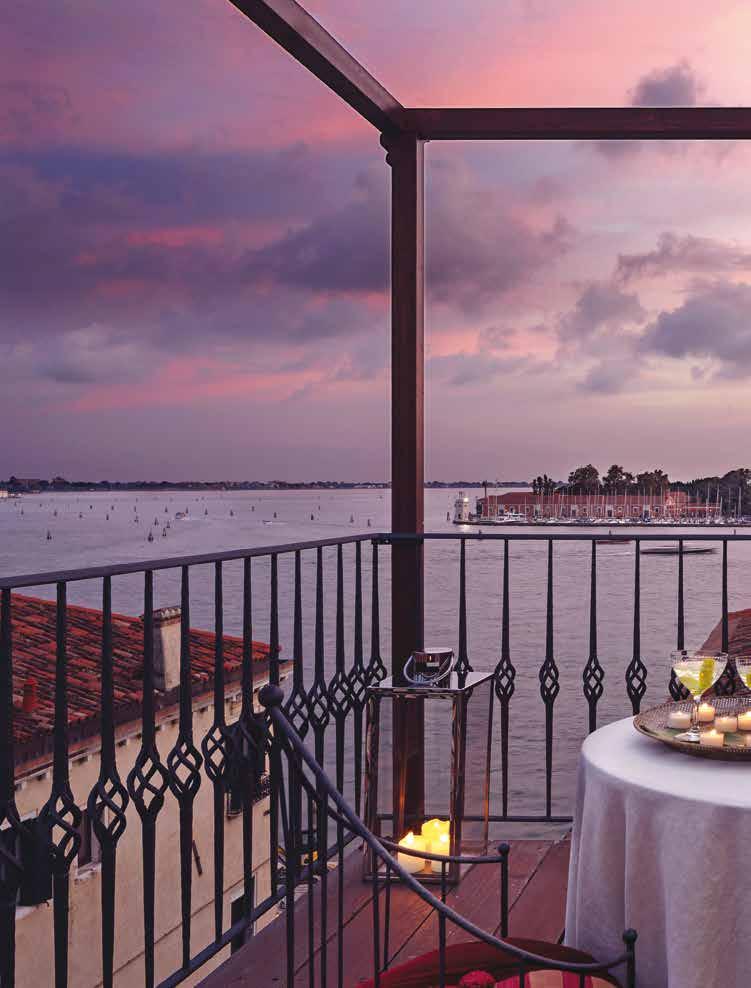
VENEZIA HOTEL METROPOLE atmosfera suggestiva e accogliente fascinating and welcoming atmosphere
Hotel Metropole


VENETO
ECCENTRICO, avvolgente, eclettico
Affacciato sulla laguna, dove la vista sull’Isola di San Giorgio è spettacolare, l’Hotel Metropole si trova a pochi passi dalla Biennale d’Arte e da Piazza San Marco. Eccentrico, avvolgente, eclettico, il luogo dove ogni dettaglio racconta una storia. L’atmosfera è suggestiva ed accogliente, creata da lumi di candele, profumi ed incensi che spargono ovunque delicate fragranze. Un 5 stelle che seduce grazie alle Suite semplicemente emozionanti, alla più sorprendente collezione d’antiquariato privata in mostra che un hotel abbia mai contemplato e a un giardino dal fascino esotico, contesto ideale per la colazione del mattino e piccoli eventi, dove fa mostra di sé una vera da pozzo che risale al 1500. 67 camere, tutte diverse, dove pregiati pezzi del ‘700 si alternano a mobili orientali e Art Deco, decorate con preziosi tessuti Fortuny e Bevilacqua, sete e velluti pregiati che richiamano la tradizione di Venezia. Un’esperienza di Ospitalità non convenzionale che si completa con l’Orientalbar & Bistrot, tappa immancabile di artisti e musicisti che si ritrovano qui per sorseggiare Martini Cocktail realizzati alla perfezione e cenare con piatti della cucina veneziana rivisitati in versione contemporanea. Per ritrovare il relax in ogni momento della giornata, la Spa offre un ambiente ad uso esclusivo dominato da una piscina d’acqua calda che riporta alle atmosfere degli antichi Hammam. Il mood che ne deriva è inimitabile, e nulla è lasciato al caso.
ECCENTRIC, WARM, ECLECTIC
Overlooking the lagoon, where the view over San Giorgio Island is spectacular, the Metropole Hotel is located few steps from the Biennale d’Arte and Piazza San Marco. Eccentric, warm, eclectic, the place where each detail tells a story. The atmosphere is fascinating and welcoming, created by candle lights, perfumes and incenses that spread a delicate fragrance everywhere. A 5 star hotel that seduces, with Suites that simply thrill, the most surprising collection of antiques ever to be found and a garden with exotic charm, an ideal setting for breakfast in the morning and small events, where a 16th century wellhead is placed. 67 rooms, all different, where fine 18th century antiques alternate with oriental furniture and art deco, decorated with rich Fortuny and Bevilacqua fabrics and fine silks and velvets, conjuring up images of the Venice tradition. An unconventional hospitality experience that is completed with the Orientalbar & Bistrot, an unmissable stop for artists and musicians who gather here to sip perfect Martini Cocktails and taste traditional Venetian cuisine with an intriguing twist of aromas and spices. To rediscover relaxation at any time of the day, the Spa offers an environment for exclusive use dominated by a warm water pool that takes you back to the atmosphere of the ancient Hammam. The resulting mood is incomparable and nothing happens by chance.

114

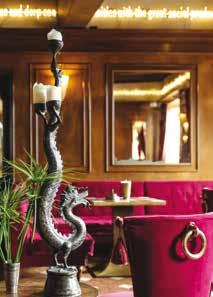
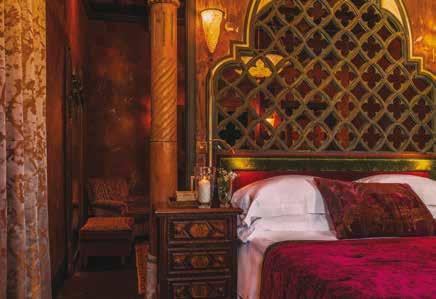
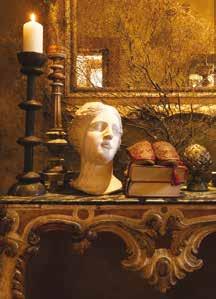


115
LA SOMMITÀ RELAIS

OSTUNI
minimalismo ascetico e lusso discreto ascetic minimalism and discreet luxury 116
La Sommità Relais

PUGLIA
117
UN INFINITO sogno nel bianco
Ostuni accoglie il suo visitatore con un insieme di edifici in pietra bianca raggruppati su una collina che si eleva sulla pianura della costa adriatica pugliese. Il Relais La Sommità occupa un palazzo con un portale in stile catalano discretamente celato sul punto più alto di Ostuni, a cui deve il nome, e alle spalle della Cattedrale. L’hotel a 5 stelle è poco visibile dall’esterno e si presenta come un articolato complesso di vari fabbricati in cui si propagano le bellissime 15 Suite e gli affascinanti ambienti del Relais. Con la sua vista su chilometri di ulivi e fino al mare e i tetti bianchi della città, la terrazza de La Sommità dà una sensazione di infinito, di trovarsi in un mondo nuovo. Gli interni di Relais La Sommità, al confine fra il minimalismo ascetico ed il lusso discreto, con tonalità crema e bianche, ispirano meditazione più di ogni altra cosa, facendo dell’Hotel la destinazione perfetta per una fuga, per trovare pace e benessere in Puglia, una terra che incanta. Al ristorante “Cielo”, una Stella Michelin, lo Chef elabora una cucina innovativa basata sulla qualità del prodotto locale in chiave di osmosi culinaria con preziosità provenienti da tutto il mondo.
AN ENDLESS WHITE DREAM
Ostuni welcomes its visitors with a group of white stone buildings standing on a hill rising up over plainland on Puglia’s Adriatic coast.
Relais La Sommità is housed in a building featuring a Catalanstyle portal, discreetly hidden away in the highest part of Ostuni, hence its name (La Sommità translates as the Summit in English), behind the town’s main church. The 5-star hotel is tucked away and comprises a number of buildings housing the 15 beautiful and charming suites and rooms of Relais La Sommità. With its view over endless stretches of olive groves down to the sea and the town’s white rooftops, the hotel’s terrace brings to mind the infinite, the sensation of finding yourself in a new dimension.
The interior design of Relais La Sommità, which borders between ascetic minimalism and discreet luxury, with shades of white and cream, inspires above all meditation, making the hotel the perfect destination to get away from it all, to find peace and wellbeing in the enchanting region of Puglia.
At the “Cielo” restaurant, one Michelin Star, the cuisine evokes distant memories, while at the same time guiding palates into uncharted territories.
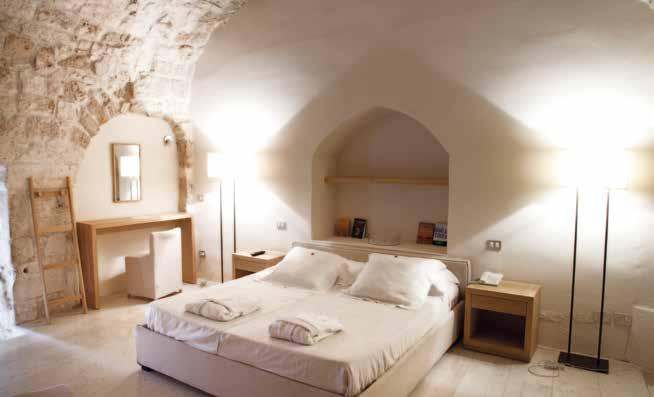
118


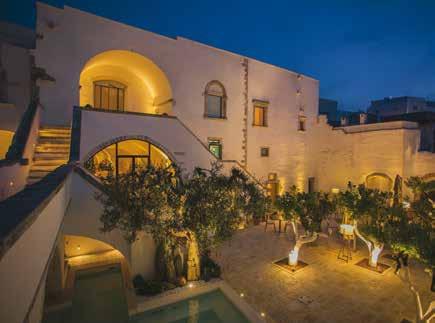




119

120
Il teatro mentale MARCO NEREO ROTELLI di
 di/by: Renato Palazzi photo: Lavinia Colonna Preti @lombardiasecrets
di/by: Renato Palazzi photo: Lavinia Colonna Preti @lombardiasecrets
121
Basta sostare un attimo di fronte all’ingresso che dalla strada conduce al nuovo studio milanese di Marco Nereo Rotelli, una porta dorata, istoriata con i suoi inconfondibili geroglifici, affacciata sui capannoni e le rimesse di via Quintiliano, ma già sottratta a ogni residuo della realtà quotidiana, per rendersi conto che attraverso di essa non si accede soltanto a un luogo fisico, ma si entra nello sguardo stesso dell’artista veneziano. Varcata la soglia del suo atelier rigorosamente collocato in una vecchia zona industriale, come avviene nelle grandi città europee, dove l’arte esce dai centri storici per andare a rivitalizzare periferie fino a ieri abbandonate, si avverte subito che questo ambiente sconfinato è ben più di un possente incubatoio di quadri e sculture, è una macchina produttrice di idee, è un prolungamento dell’interiorità di Rotelli, una sua emanazione, un suo “doppio” concreto.
L’enorme salone costituisce un caso esemplare di come la dimensione spaziale non sia un concetto inerte, una pura unità di misura, ma un’entità sensibile che interagisce attivamente con le visioni di chi la abita.
Le tele, le opere pittoriche e plastiche gigantesche o minuscole appoggiate alle pareti o dislocate sul

pavimento accostano, moltiplicano, dispongono in fila forme, colori, materiali diversi, ripercorrono epoche e stili, riportano in superficie curiosità e passioni legate a momenti stratificati nel tempo, e paiono concatenarsi in una sequenza di stimoli e suggestioni che generano altri stimoli e altre suggestioni in una germinazione spontanea che potrebbe protrarsi all’infinito. E’ chiaro che non è il semplice ambito in cui nascono le opere d’arte, ma è esso stesso un’immensa opera d’arte, un’opera aperta di cui i manufatti esposti non sono che le componenti staccate e ricomposte di un unico organismo vivo e mutevole, destinato a modificarsi di giorno in giorno.
Nereo ha marcato in modo ben visibile il proprio territorio, ha voluto lasciarvi un’impronta in qualche modo “privata” che a sua volta rientra in quello stesso flusso di impressioni, ne condivide la tensione inventiva. Ha recuperato e fatto installare delle antiche porte che appartenevano a una sua precedente residenza, ha collocato arredi vintage, un salottino di poltrone spaiate, un angolo di mobili di fòrmica da cucina anni cinquanta, e tavolini di plastica, paralumi, panchette, in un assemblaggio volutamente casuale. La sensazione, un po’ straniante, è di non essere nel laboratorio di
122
un pittore ma in un immenso appartamento, un appartamento che qualcuno ha sistemato in attesa dell’arrivo dei suoi occupanti. Ma quegli occupanti non arriveranno mai, sono fantasmi, presenze incorporee, e dunque il calore di questa finta casa è soltanto una concrezione dell’immaginario. E’ un’ideale scenografia dentro la quale Rotelli rappresenta se stesso, è il set che ha allestito per girarvi l’invisibile film delle proprie giornate. Forse è un’espressione del suo inconscio, l’archetipo di una possibile casa, forse è una costruzione onirica, la realizzazione pratica di un qualche vago sogno infantile. Comunque sia, si tratta pur sempre di un teatro della mente, di un personalissimo varco per raggiungere una sfera segreta e inaccessibile del proprio mondo fantastico.

In questo teatro della mente Rotelli può liberamente lavorare e giocare, può giocare a lavorare e lavorare a quell’interminabile, sottilissima giocosità intellettuale da sempre intimamente connessa alla sua natura. Questa componente ludica, questa capacità di unire ingegno e leggerezza ha costantemente attraversato il suo dipingere, il suo decorare, il suo manipolare la materia e gli oggetti, il suo ideare apparati e situazioni
in cui collocare luci e parole, il suo spostarsi senza sosta da un lato all’altro del mondo, sempre in viaggio, mai in nessun luogo. Se dovesse essere severo con se stesso, rinuncerebbe probabilmente a una buona parte della sua identità creativa.
La peculiare fisionomia di questo spazio esercita una penetrante influenza che finisce col coinvolgere anche i visitatori, sottoposti a una sorta di spaesamento, investiti da un bizzarro senso di sproporzione. A causa dell’ampiezza della sala, ad esempio, le prospettive variano da soggetto a soggetto, l’occhio fatica a coglierne l’insieme, i suoni si dissolvono, tendono a perdersi in misteriosi labirinti aerei. Così, seppur seduti gli uni accanto agli altri, si fatica a far sentire le proprie voci, il che produce uno strano effetto divaricante, come se ciascuno parlasse agli altri da molteplici distanze: non si avvertono sensazioni di solitudine, di isolamento, ma sembra di trovarsi chiusi dentro campi di energia diversi, immersi nella percezione di un proprio immaginario che è forse prossimo a quello di chi ci sta intorno, ma al tempo stesso rimane del tutto separato da esso. È raro trovare un luogo capace di esercitare una simile forza. Se ne esce sorpresi, colpiti, spiazzati, scombussolati.
123
THE MENTAL THEATRE OF MARCO NEREO ROTELLI
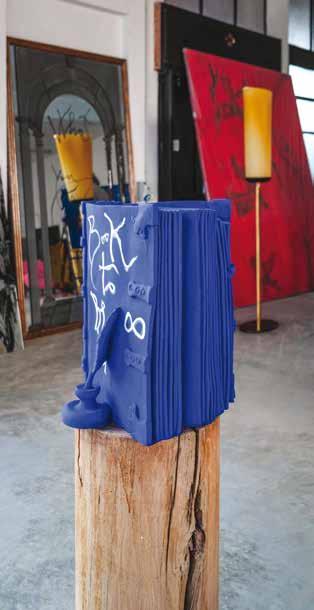
Simply standing for a couple of minutes at the entrance to the new Milan studio of Marco Nereo Rotelli, a golden door marked with its unmistakeable hieroglyphs, facing the warehouses and depots of Via Quintiliano but already snatched from all remains of everyday life, is sufficient to realise that this door will lead you to more than a physical place: it will take you within the gaze of Rotelli himself. Once stepping inside the Venetian artist’s atelier, strictly located in an old industrial neighbourhood as in any other big European city, where art leaves the historical centres and goes on to revitalise peripheral areas that had been abandoned up to yesterday, visitors immediately realise that this vast place is much more than a powerful incubator of paintings and sculptures. It is a machine that chugs out ideas; it is an appendix of Rotelli’s interior life, one of his emanations, a concrete “double” of his.
The huge hall is an example of how the spatial dimension is not an inert concept, a pure unit of measurement. Rather, it is a sensitive entity that actively interacts with the visions of those who inhabit the place. The canvases, the paintings and the works of plastic art, be they gigantic or tiny, leaning against the walls or resting on the floor, put together, multiply, arrange in rows and lines different shapes, colours, and materials; go through different time periods and styles; bring to the surface curiosities and passions related to moments stratified in time; and seem to be connected to each other in a sequence of stimuli and suggestions that generate other stimuli and other suggestions in a spontaneous germination that might go on forever. It becomes clear that this is not simply the place where the works of art are born, but the place itself is an immense work of art, an open work of which the items in exhibition are nothing but the detached and recomposed parts of a single living and mutating organism, destined to change on an everyday basis. Nereo has marked his territory in a very visible fashion; his intention was to leave in this place a somehow private marking that would then become part of that same flow of impressions, sharing its creative tension. He refurbished and installed ancient doors that belonged to one of his previous homes, decorated the place with vintage items, came up with a small sitting-room with mismatched armchairs, a corner with furniture from a 1950’s Formica kitchen, plus little plastic tables, lampshades, benches, in a purposefully casual arrangement. The somewhat estranging sensation is that of being not in the workshop of a painter, but in a huge flat, a flat that someone has tidied up as they wait for its occupants. But these occupants will never come, they are nothing but ghosts, incorporeal presences, so that the warmth of this fake home is just a concretion of the imagination. This is an ideal backdrop where Rotelli represents himself; it is the set he has installed to shoot the invisible film of his own days. Perhaps it is an expression of his subconscious, the archetype of a possible home. Perhaps it is a dreamlike construction, the practical realisation of a vague childhood dream. Whatever it is, it is definitely a theatre of the mind, of a very personal crossing through which one reaches a secret and inaccessible sphere of his own fantasy world. In this theatre of the mind, Rotelli is free to work and play; he can pretend work and actually work on the endless, very subtle intellectual playfulness that has always been intimately connected to his nature. This playful component, this ability to blend ingenuity and lightness has always been a constant in his painting, in his decorations, in his handling of matter and objects, in his creation of devices and situations in which he places lights and words, his tireless shifting from one part of the world to another, always on the move, never anywhere. If he were to be strict with himself, he would likely give up a good part of his creative identity.
124
The peculiar physiognomy of this space has a penetrating influence that ends up involving visitors as well, who are submitted to a sort of disorientation, hit by a bizarre sense of disproportion. For instance, as the hall is very large, perspective changes from subject to subject and our eyes find it hard to catch the ensemble; sounds are dissolved and tend to get lost in mysterious aerial labyrinths. Thus, even when sitting next to each other, visitors find it hard to hear their own voices. The result is a strange “spreading” effect, as if each person were speaking to the others from multiple distances. The sensation is not of solitude, of isolation, but it feels like being enclosed within different energy fields, immersed in the perception of one’s own imagination, which is perhaps close to that of the people around us, but all the while remains completely separated from it.
There are very few places that can exercise such a power. When we leave it, we are surprised, awestruck, floored, discombobulated.
Marco Nereo Rotelli è nato a Venezia nel 1955, dove si è laureato in architettura nel 1982. Da anni persegue una ricerca sulla luce e sulla dimensione poetica che Harald Szeemann ha definito come “un ampliamento del contesto artistico”. Rotelli ha creato negli anni una interrelazione tra l’arte e le diverse discipline del sapere. Da qui il coinvolgimento nella sua ricerca di filosofi, musicisti, fotografi, registi, ma principalmente il suo rapporto è con la poesia che, con il tempo, è divenuta un riferimento costante per il suo lavoro. Nel 2000 ha fondato il gruppo Art Project, oggi diretto da Elena Lombardi e composto da giovani artisti ed architetti, con il quale realizza numerosi interventi e progetti di installazione urbana. Questo suo impegno gli è valso la partecipazione a nove edizioni della Biennale di Venezia, oltre a numerose mostre personali e collettive. È stato invitato dalla Northwestern University (Chicago) come artist-in-residence (inverno 2013). Le sue opere sono presenti in musei e importanti collezioni private di tutto il mondo. Di lui hanno scritto alcuni tra i più importanti critici d'arte, oltre a poeti, scrittori, filosofi e personalità della cultura internazionale, alimentando un’importante raccolta bibliografica sul suo lavoro.
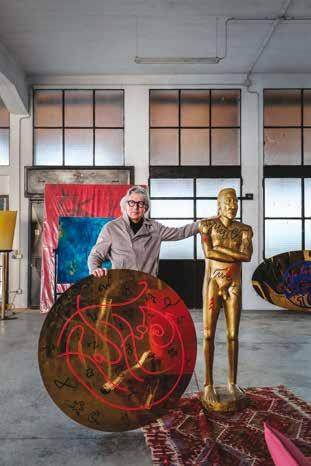
Marco Nereo Rotelli was born in Venice in 1955, where he graduated in architecture in 1982. Now he works and lives in Milan and Paris. For years Rotelli researched light and the poetic dimension, which Harald Szeemann has defined “an expansion of the artistic contest”. Rotelli has created a solid relationship between art and other disciplines of knowledge for years. Involving in his research as a consequence, philosophers, musicians, photographers, film directors, but mainly the relationship is between his art and poetry, which has become a constant reference to his work. In 2000 he founded the group Art Project, directed by Elena Lombardi and composed by young artists and architects with whom he realizes numerous interventions and urban installation projects. He was invited by Northwestern University as artist-in-residence (Winter 2013). This involvement has seen him participate to nine editions of the Biennale di Venezia, as well as numerous individual and collective exhibitions. His works of art are in important museums and private collections all over the world. Important art critics, as well as poets, writers, philosophers and international cultural celebrities have written about him, increasing an important bibliographic collection on his work.

125
WWW.MARCONEREOROTELLI.IT
LAQUA BY THE LAKE per vivere il lago da una nuova prospettiva a way to experience the lake from a new perspective

126
LAGO D’ORTA
Laqua by the Lake


127 PIEMONTE
UN ESCLUSIVO RESORT sulle coste del Lago d’Orta
Sedici appartamenti immersi in una baia che gode di una rigogliosa natura e di un’esposizione luminosa privilegiata, un beach club con infinity pool riscaldata e due attici con Jacuzzi, perfetto per soggiorni all’insegna del relax e dell’avventura.
Gli appartamenti, dotati di una o due camere da letto, zona living con angolo cottura, terrazza panoramica o giardino privato, offrono agli ospiti tutti i comfort di casa, garantendo la totale privacy in ambienti minimal e moderni, ma accoglienti e familiari allo stesso tempo.
Il bistrot gourmet firmato da Chef Antonino Cannavacciuolo accompagna gli ospiti lungo tutta la giornata, con proposte gastronomiche che si adattano ai palati più disparati (colazioni, club sandwich, primi piatti tradizionali, menù degustazione).
Completa l’offerta un’ampia gamma di attività ricreative e rigeneranti, offerte dal beach club e dalla SPA: dagli sport acquatici insieme a istruttori esperti, al noleggio della prima barca elettrica sul Lago d’Orta, per vivere il lago da una nuova prospettiva; e ancora, una palestra con personal trainer, trattamenti esclusivi di crioterapia e percorsi detox personalizzati.
AN EXCLUSIVE RESORT ON THE SHORES OF LAKE ORTA
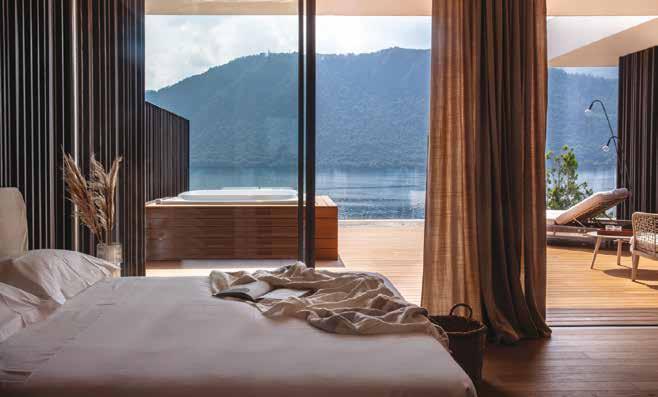
16 apartments nestled in a bay that benefits from lush nature and privileged light exposure, a beach club with heated infinity pool and two penthouses with Jacuzzi, perfect for relaxing and adventurous stays.
The apartments, equipped with one or two bedrooms, living room with cooking area, panoramic terrace or private garden, offer all the comforts of home, providing total privacy in minimal and modern settings, yet cozy and familiar at the same time.
The gourmet bistrot signed by Chef Antonino Cannavacciuolo accompanies the guests throughout the day with gastronomic proposals that suit the most diverse palates (breakfasts, club sandwiches, traditional first courses, tasting menus).
A wide range of recreational activities, offered by the beach club and the SPA, completes the offer: from water sports with expert instructors, to the rental of the first electric boat on Lake Orta; from a gym with personal trainers, to exclusive cryotherapy treatments and personalized detox paths. A way to experience the lake from a new perspective.
128

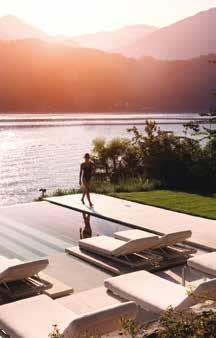





129
BY THE SEA tra l’acqua cristallina e la roccia dei monti between the crystal-clear water and the rock of the mountains

LAQUA
GOLFO DI SORRENTO
Laqua by the Sea

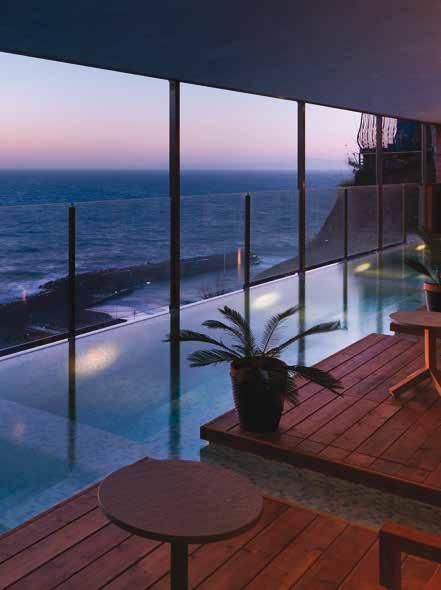
CAMPANIA
UNA FINESTRA sulla costa Sorrentina
Sei camere sul golfo di Sorrento, in una posizione privilegiata a pochi chilometri da piazza Tasso, sospese tra l’acqua cristallina e la roccia dei monti Lattari che si tuffano a capofitto nel mare. Le camere sono state progettate seguendo l’arte cinese del Feng Shui, dove design e benessere si incontrano per donare all’ambiente una sensazione di pace. Dotate di tutti i comfort, si suddividono in cinque camere Deluxe, con vista sul romantico golfo della penisola Sorrentina, ed una camera Classic con vista mare parziale. I letti king size sono progettati con legni naturali senza parti metalliche, per offrire un completo relax ai viaggiatori, mentre le docce in vetro fumé lasciano vasto respiro al meraviglioso panorama. Ogni camera dispone di terrazza privata con piccolo angolo lounge e infinity pool con idromassaggio, perfetta per godersi colazioni o aperitivi immersi nella rara bellezza della penisola Sorrentina. Completa l’offerta il centro benessere dotato di sauna finlandese, doccia tropicale e vasca con acqua salina riscaldata a 34 gradi. L’area wellness offre inoltre agli ospiti accessi esclusivi con massaggi olistici e trattamenti corpo e viso personalizzati.
A WINDOW ON THE SORRENTO COAST
Six rooms on the Gulf of Sorrento, in a privileged location a few kilometers from Piazza Tasso, suspended between the crystal-clear water and the rock of the Lattari mountains that plunge deep into the sea. The rooms have been designed following the Chinese art of Feng Shui, where design and wellness meet to give the environment a feeling of utter peace. Equipped with all comforts, they are divided into five Deluxe rooms, overlooking the romantic gulf of Sorrento, and one Classic room with a partial sea view. The king-size beds are designed with natural woods with no metal parts to provide complete relaxation for travelers, while the smoked glass showers allow ample exposure to the wonderful panorama. Each room has a private terrace with a small lounge corner and infinity pool with Jacuzzi, perfect for enjoying breakfast or aperitifs surrounded by the rare beauty of the Sorrento Peninsula. Completing the offer is the wellness center equipped with Finnish sauna, tropical shower and pool with saline water heated to 34 degrees. The wellness area also offers guests exclusive access with holistic massages and personalized face and body treatments.

132



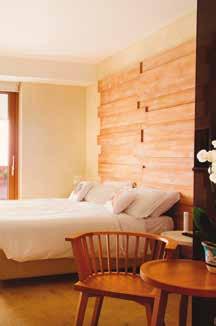



133

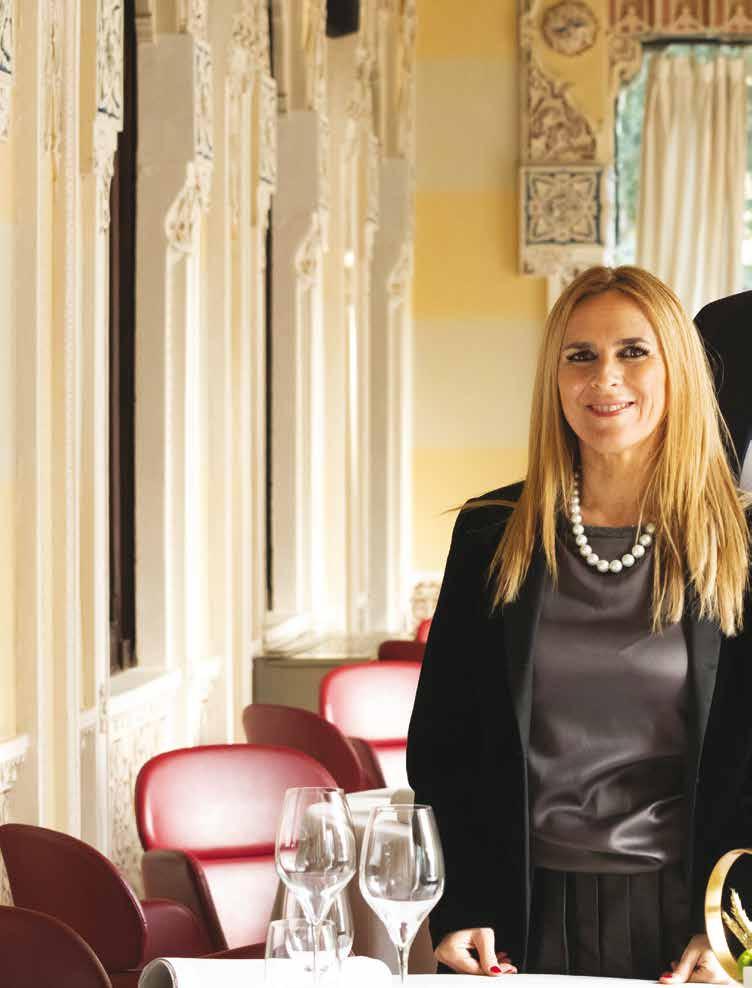
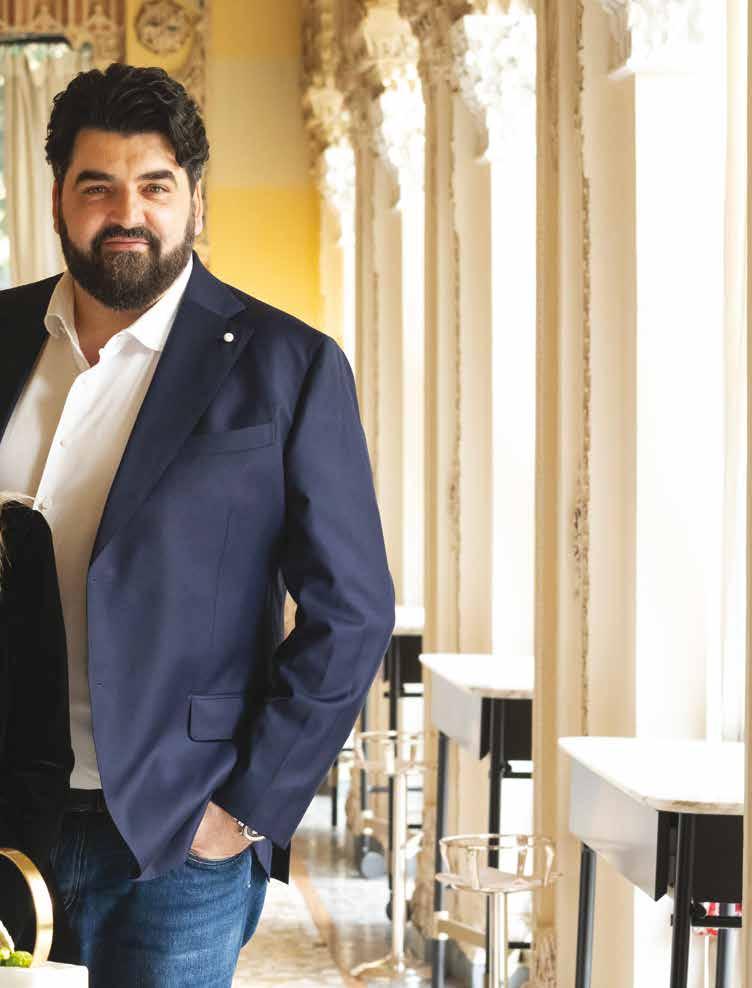 di/by:
di/by:
by Paola Cacianti photo: Stefano Butturini, Matteo Carassale, FTfoto, Gaia Menicchi, Meschina, Francesca Pagliai, Beatrice Pilotto, Brambilla e Serrani ANTONINO CANNAVACCIUOLO - NOTO E AMATO VOLTO TELEVISIVONON È SOLO LO CHEF PATRON DEL RISTORANTE 2 STELLE MICHELIN A VILLA CRESPI, MA CON LA MOGLIE CINZIA PRIMATESTA È OGGI ANCHE UNO DEI PIÙ DINAMICI IMPRENDITORI ITALIANI ALLA GUIDA DI UN GRUPPO CHE CONTINUA AD ESPANDERSI E INAUGURARE NUOVI INDIRIZZI DI RISTORAZIONE E RICETTIVITÀ, CHE CELEBRANO DIVERSI TERRITORI IN ITALIA E IL CONNUBIO PERFETTO TRA CUCINA E OSPITALITÀ. GUSTO IL DEL FUTURO
E
ssere imprenditori significa sapere, ragionevolmente, rischiare. Ma una buona dose di immaginazione, fantasia, coraggio e amorevolezza sono quella marcia in più che producono sorprendenti avventure - e clamorose riuscite - di certa imprenditoria “Made in Italy”. Antonino Cannavacciuolo, ha coniugato tutto questo con un attento uso della comunicazione (Masterchef) ed è diventato, insieme ad altri, (ma con molta più simpatia) un personaggio televisivo noto nel mondo. L’idea un po’ “al contrario” di creare attorno al ristorante un resort, un luogo dove unire al piacere del cibo quello del relax, del riposo, dello stare insieme, oltre che originale, disegna uno stile di vita che abbraccia tutti i sensi. È una precisa idea di qualità della vita che lo porta a restaurare e fare di Villa Crespi un luogo unico, dove condividere la sua stessa vita. Non è un ristorante ma il suo luogo del cuore che vive insieme alla moglie Cinzia, sua preziosa collaboratrice, e ai figli Elisa e Andrea. La qualità del suo progetto lo porta a ricevere prima una poi due stelle Michelin. Il successo, da vero imprenditore ad investire in altre strutture. Laqua Charme e Boutique - oggi Laqua by the Sea e parte della collezione Laqua Resorts - a Meta di Sorrento, Il Cannavacciuolo Cafè e Bistrot a Novara, il Bistrot di Torino, entrambi una stella Michelin, lo shop on line.
La sua origine mediterranea e campana, la simbiosi con l’elemento acqua generano una impresa che oggi vanta diverse strutture: da Laqua by the Lake sul Lago d’Orta alle Colline Sorrentine dove si trova Laqua Countryside, la sua casa d’infanzia, fino a Laqua Vineyard, un casolare del Seicento in piena campagna toscana. Il suo percorso è fatto di dura gavetta, dall’istituto alberghiero dove era insegnante suo padre, alle esperienze con i più grandi Chef del mondo, fino a diventare lui l’anima di una Chef Academy.
ESSERE IMPRENDITORI SIGNIFICA SAPERE, RAGIONEVOLMENTE, RISCHIARE.
Poi l’incontro con Cinzia Primatesta, l’incontro tra Campania e Piemonte, nata proprio su quel Lago d’Orta che ora è il fulcro del loro mondo: un’unione di culture e di esperienze. Cinzia viene da una famiglia di albergatori e ha avuto un ruolo fondamentale nella messa a punto dei comuni progetti. Del resto, era destino: si sono incontrati in un hotel ristorante dal nome che sa di pace e di punto di arrivo: L’Approdo.
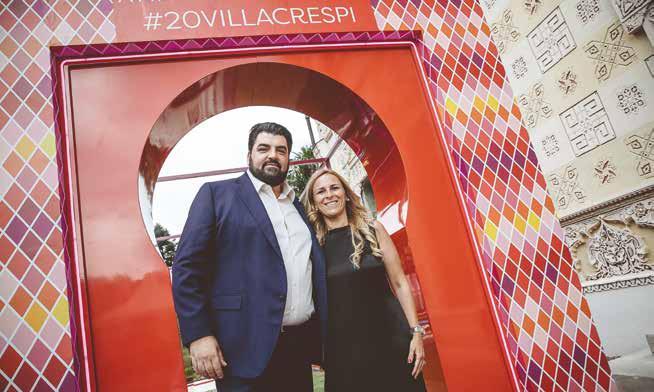
138
Com’è diventato Chef Antonino Cannavacciuolo?

Credo che sia stata una scelta naturale. Sicuramente mio padre ha avuto una componente importante. Per me lui è il più bravo di tutti, l’ho sempre ammirato fin da ragazzino per la determinazione e l’impegno che metteva nel suo lavoro. Lui ha fatto di tutto per scoraggiarmi, perché mi diceva che era un lavoro durissimo e non voleva che anche io facessi tutte le feste comandate lontano dalla famiglia. Ma alla fine ho vinto io. Spero sia fiero di me. Ho lavorato molto, fin da ragazzino, per riuscire nella mia professione. Era quello che volevo fare. Sono nato cuoco, sono cresciuto cuoco e diventato cuoco. Mi piaceva giocare a pallone come tutti i bambini, ma quando stavo a casa, giocavo con il cibo, anche perché non c’erano i giochi di oggi. Ho creduto nei miei mezzi, ho avuto dei grandi maestri, e ho lavorato sodo. Quando gli altri andavano in vacanza, io lavoravo. Da ragazzino e pure oggi. Mi porto dietro ogni piccolo ricordo, da quelli più entusiasmanti a quelli meno belli.

139 INTERVISTA AD ANTONINO CANNAVACCIUOLO
Come nascono i suoi piatti?
La mia arma per realizzare sempre piatti nuovi e di grande gusto è la curiosità. Ogni Chef ma anche ogni persona che si avvicina con entusiasmo alla cucina, deve essere curioso. Se c’è questa caratteristica, sarà sempre stimolante stare in cucina, provare a fondere nuove sostanze, e farle diventare materia viva.
SONO UNO CHE NON SI ACCONTENTA, E CHE NON SI ACCONTENTA MAI.
Quali sono oggi gli elementi che determinano un successo come quello che avete ricevuto al Relais Villa Crespi?

La determinazione, la ricerca di esperienze uniche, sempre più umane dal punto di vista dell’ospitalità. La costante ricerca delle piccole cose porta alla creazione di percorsi gastronomici di alto livello, dove la materia prima è protagonista.
Celebrato, stella della Tv, imprenditore di talento. In che momento della sua vita ha capito che sarebbe arrivato in alto?
Non vorrei sembrare presuntuoso, ma in fondo l’ho sempre saputo. Non avrei certo mai immaginato di avere una così forte notorietà, questo no, ma ho sempre saputo che avrei fatto bene il mio mestiere e che avrei raggiunto dei traguardi importanti. Sono uno che non si accontenta, e che non si accontenta mai. Sono cresciuto così, e le parole di mio padre, quando ho deciso di intraprendere questa strada sono state queste: “Antonino, se vuoi fare questo mestiere devi farlo bene, devi dare il massimo, altrimenti lascia perdere”.
Il ricordo che Le è più caro? E la prima persona che ha creduto nel Suo talento?
Anche se forse faticherebbe ad ammetterlo, direi che proprio mio padre, sia stato tra i primi a credere e a riconoscere le mie capacità. L’ha sempre fatto a modo suo: non mi ha mai fatto un complimento, non mi ha mai esaltato, mi ha insegnato l’umiltà, il rispetto e la determinazione. Questo ha contribuito a darmi la carica per cercare di migliorarmi sempre.
Quali emozioni deve trasmettere, oggi, l’alta cucina? La cucina è passione, curiosità. L’alta cucina, ma la cucina in generale, deve incuriosire, deve piacere. Non deve stancare mai.
140
Qual è il piatto che la rappresenta di più?
Ogni mio piatto mi appartiene, e per me, è come se fosse un “figlio”. Cucinare significa esprimere emozioni e raccontarmi, ed ogni mia creazione rappresenta una parte di me. Un piatto che amo molto e che fatico ad abbandonare tra le proposte a Villa Crespi, sono le “Linguine di Gragnano, calamaretti, salsa al pane di segale”. Questa portata rappresenta l’unione tra il Sud, la mia terra d’origine che porto sempre nel cuore, ed il Piemonte, mia terra d’azione.
Ha detto spesso che la sua brigata è come una famiglia, e d’altra parte la sua famiglia l’ha sempre affiancata nel lavoro. Come trova il giusto equilibrio?
La mia brigata e tutte le persone che lavorano con me sono la mia famiglia. Senza di loro, non esisterebbe nulla di quanto ho creato. È un concetto molto semplice, ma fondamentale. Mia moglie è al mio fianco sempre, e parte integrante del mio lavoro. È tutto un equilibrio ottimale.
Fra le registrazioni dei programmi Tv a cui partecipa, impegni come testimonial e la gestione dell’offerta gastronomica del Gruppo Cannavacciuolo, i Bistrot, Laqua Resorts e il Relais Villa Crespi, quanto tempo riesce a dedicare alla sua brigata e agli Chef delle diverse realtà?
Il segreto è circondarsi di persone fidate che condividano con te passione, sogni e successi. Io credo che ogni Chef non sarebbe completo senza il sostegno ed il lavoro della propria brigata, e come in ogni relazione che si rispetti, fondamentale è il lavoro di squadra e la reciproca fiducia. Alla luce di questo, circondandomi di collaboratori attenti e professionali, posso permettermi ogni tanto di non essere fisicamente presente nelle realtà da me gestite e di sfruttare al meglio il tempo a disposizione.
Cosa la fa sentire davvero a casa? Poter lavorare con serenità, andare a pescare, vivere i miei cari. Questa è la mia vita.
Il suo ultimo progetto, Laqua Resorts, propone un concetto di ospitalità a tutto tondo. Ha detto bene, sono i luoghi del cuore. In ogni posto che io e Cinzia abbiamo voluto, c’è una parte di noi. Ci siamo impegnati moltissimo, insieme al nostro staff, per creare delle offerte nuove ai nostri clienti. Siamo stanchissimi ma felici di ciò che abbiamo realizzato. Vogliamo che la gente che verrà possa sentirsi a casa propria. Se così non sarà, vorrà dire che abbiamo
sbagliato qualcosa. Io sono sempre stato votato a questo. Quando venti anni fa abbiamo aperto Villa Crespi, ci siamo indebitati. Quando abbiamo iniziato a guadagnare qualcosa, i soldi non li tenevamo, ma li investivamo, perché per noi è fondamentale evolversi. Non ci siamo mai fermati da allora. Non potrei fermarmi adesso. Ogni nuova apertura, prelude a una nuova idea, a un nuovo progetto. Non voglio fermarmi mai.
Perché avete scelto questo nome per la vostra nuova realtà imprenditoriale, LAQUA RESORTS?
L’acqua è un elemento che lega la nostra vita, quella mia e di Cinzia, e per questo abbiamo deciso di celebrarlo chiamando così il nostro nuovo progetto. Ci piace pensare che Laqua Resorts sia il frutto di tanti anni di sacrifici, dedizione e amore per l’accoglienza, in termini di servizio, gastronomici e di relazione con i nostri ospiti. Dopo aver celebrato il ventesimo anniversario al Relais Villa Crespi e affrontato un momento storico senza precedenti, che ha coinvolto il mondo intero, abbiamo pensato di creare dei nuovi, intimi punti di riferimento per la ricettività in Italia. E siamo rimasti fedeli alle nostre origini, il Piemonte e la Campania, e all’ospitalità fatta di piccoli ma grandiosi luoghi dove ritrovare la gioia e la vita. Abbiamo inaugurato Laqua Resorts lo scorso anno, aprendo a luglio del 2021 Laqua by the Lake e ad agosto Laqua Countryside - a distanza di un anno abbiamo dato vita a Laqua Vineyard, che racchiude il DNA di questa collezione e nonostante la Toscana sia per noi una inedita destinazione, abbiamo cercato una location che potesse rispecchiare il senso del luogo e di casa, che desideriamo trasmettere ai nostri ospiti - e come in ogni casa, il cuore pulsante è la cucina. Nel 2021 Laqua Resorts - nonostante fosse l’anno della “ripresa” post pandemia, ci ha dato grandi soddisfazioni, incontrando il favore dei nostri clienti - molti dei quali tornano spesso e scelgono anche di viaggiare tra le nostre diverse “case”, da Meta di Sorrento, Ticciano, il Lago d’Orta.
STATE TRANQUILLI, NON MI FERMO QUI!
Le 2 stelle a Villa Crespi, i bistrot stellati, i Laqua Resorts, i libri, i programmi tv… qual è il suo prossimo obiettivo? Ne ho diversi, la notte penso a quello che mi devo inventare l’indomani. State tranquilli, non mi fermo qui!
141

LA MIA BRIGATA E TUTTE LE PERSONE CHE LAVORANO CON ME SONO LA MIA FAMIGLIA.
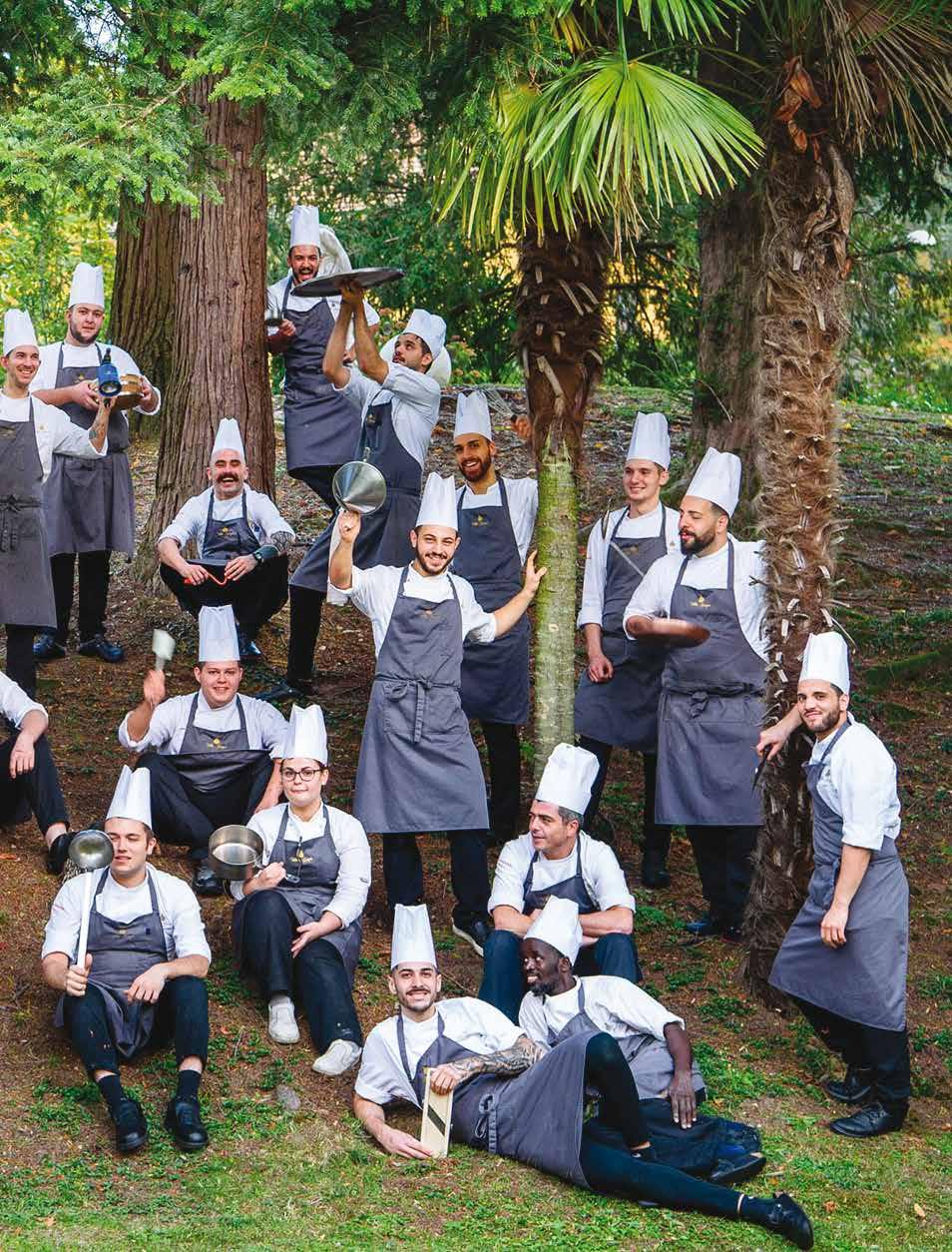
PRIMATESTA
Cosa significa per Antonino e Cinzia fare ospitalità?

Fare ospitalità oggi significa condividere con chi accogliamo, quello che siamo, senza filtri, condizionamenti, essere autentici, noi stessi, accogliere con l’anima, il cuore, con la pura intenzione di fare stare bene la persona che abbiamo avanti, perché ci ha scelto, è venuta da noi e per questo noi ci sentiamo di doverle donare tutto quello che sappiamo dare, che abbiamo imparato negli anni a dare. È un lavoro che si fa sia interiormente che esteriormente, ma che poi la persona sente e si porta a casa qualcosa e perché no, anche il desiderio di ritornare. Pensando a Villa Crespi - aggiunge Cinzia - già nel 1999 quando abbiamo aperto eravamo ospitalità ed eravamo anche finedining, è vero. Più che una spinta a pensare è stata una spinta ad essere, perché sia io che Antonino proveniamo da una formazione che è sia ristorativa che
IN ITALIA VINCE IL CUORE E IL CALORE UMANO, NOI A VOLTE LO DIAMO PER SCONTATO.
di ospitalità, siamo fortemente convinti che le due cose siano un valore aggiunto l’una per l’altra, fanno leva l’uno all’altra, danno valore l’una all’altra. Questi due elementi rendono più completa l’esperienza - come lo yin e yang, il maschile e il femminile - quindi quando abbiamo il connubio di entrambi gli elementi possiamo dire che l’esperienza è veramente completa. Un pranzo o una cena ci permettono di “staccare” una giornata, ma il fatto di poter anche dormire, disconnettere la testa dai pensieri quotidiani, pernottare in una realtà che è diversa da quella di ogni giorno, oggi è ancora più importante di 20 anni fa perché ti permette di rigenerarti. Non solo, ti permette anche di andare a fare un imprinting importante nell’esperienza ristorativa, perché restando li hai il tempo di interiorizzarla, di coglierne tante sfumature, tutti aspetti importanti che ci portano ad un rallentamento ed a un saper vivere - quando la vita oggi, al contrario, ci porta sempre a fare le cose di corsa.
144 INTERVISTA A CINZIA
Qual è il filo conduttore di tutti i progetti dei Resort?

La collezione Laqua Resorts è nata dal forte desiderio mio e di Antonino di offrire un’ospitalità che unisce l’accoglienza alla cucina, come a casa. Tutte le nostre “case” voglio trasmettere agli ospiti la semplicità delle emozioni che proviamo quando stiamo bene, siamo accolti e
onorando i prodotti e i vini del territorio. È uguale agli altri invece nello spirito che identifica tutti i resort della collezione Laqua. La cura maniacale da parte mia e di Antonino dei dettagli, ci mettiamo davvero l’anima in tutto ciò che creiamo per gli ospiti. Desideriamo che possano sentirsi a casa, deve sentire
coccolati, da tante piccole attenzioni, quando siamo immersi nel luogo in cui ci troviamo e ci sorprendiamo dai sapori della nostra favolosa cucina mediterranea. Volevamo realizzare un progetto che abbracciasse Nord e Sud Italia, ed è per questo che abbiamo desiderato dar vita a nuovi intimi punti di riferimento per l’ospitalità dedicati ai nostri ospiti, per permettere loro di ritrovare tempo, dimensione ed equilibrio mentale e fisico.
Parliamo del nuovissimo LAQUA VINEYARD, in cosa si differenzia dagli altri Resort della collezione?
Laqua Vineyard, il nuovo resort in Toscana si differenzia per la localizzazione, geograficamente si trova in un posto diverso dalla Campania e Piemonte. Cerchiamo sempre di assorbire la cultura, il DNA e l’atmosfera del luogo, sia nello stile dell’interior design che nella scelta del team che lavora all’interno del resort che deve trasmettere quell’autenticità del luogo e anche nella scelta della materia prima
il cuore di chi lo serve e lo accoglie, deve mangiare bene con prodotti di altissima qualità ed una cucina interessante, che stimoli e anche deve stare bene nello spazio dell’ospitalità, deve dormire bene, avere una camera accogliente. Vogliamo che riesca a cogliere tutto ciò che sappiamo dare con autenticità e con uno spirito italiano e riferito a quel territorio di appartenenza.
In cosa la ricettività italiana è a livelli di eccellenza? L’Italia rappresenta l’eccellenza turistica - stiamo molto apprezzando lo sviluppo del turismo esperienziale a 360° gradi che permette di dare risalto alle piccole realtà locali, alle botteghe, alle arti e ai tanti borghi e luoghi piccoli che racchiudono le preziose tradizioni del nostro meraviglioso paese. Ogni paese osserva le tendenze turistiche, le idee e le esperienze che vengono create, ma alla fine ognuno di questi ha un proprio modello. In Italia vince il cuore e il calore umano, noi a volte lo diamo per scontato ma gli stranieri lo sentono, eccome.
145
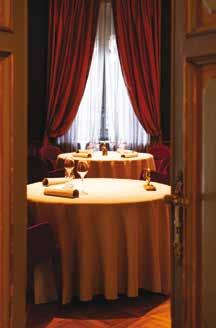

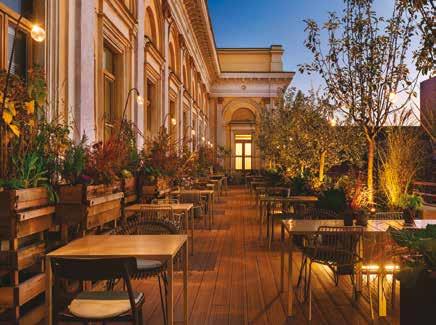
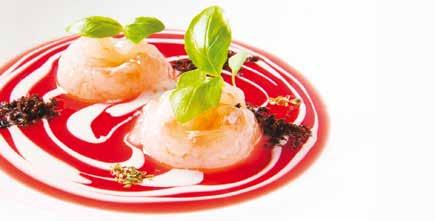
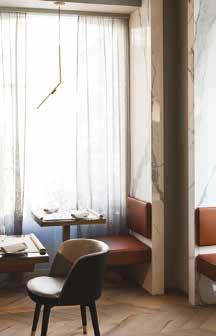
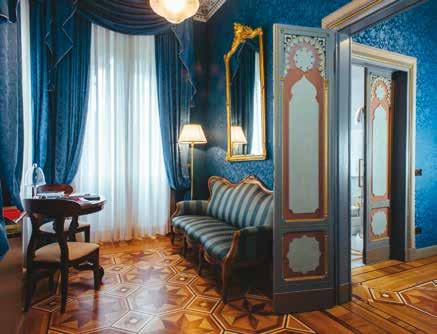
146
THE TASTE OF FUTURE
ANTONINO CANNAVACCIUOLO, A BELOVED AND MUCH FAMOUS TV PERSONALITY, IS NOT ONLY THE PATRON CHEF OF THE 2-STAR MICHELIN RESTAURANT IN VILLA CRESPI, BUT TOGETHER WITH HIS WIFE CINZIA PRIMATESTA HE IS CURRENTLY ONE OF ITALY’S MOST DYNAMIC ENTREPRENEURS, THE HEAD OF A GROUP THAT CONTINUES TO EXPAND AND TO INAUGURATE NEW RESTAURANT AND HOTEL VENUES THAT CELEBRATE, IN DIFFERENT TERRITORIES WITHIN ITALY, THE PERFECT BLEND OF CUISINE AND HOSPITALITY.
Being an entrepreneur means knowing when to take risks, within reason. But a good pinch of imagination, creativity, courage and tenderness are all extras that result in surprising adventures - and in resounding successes - of a certain Italian-made entrepreneurship. Antonino Cannavacciuolo has mixed all this with a careful use of communication (Masterchef), and has become, together with others (albeit with much more pleasantness), a TV character known all over the world.
The somewhat “upside down” idea of creating a resort around a restaurant, a place where the pleasure of food is combined with that of relaxation, of resting, of being together, which is not only original, but also outlines a lifestyle that embraces all senses. It was a precise concept of quality of life that led him to restructure Villa Crespi and to turn it into something unique where he could
share his own life. This is not a restaurant. It is his beloved place, where he lives with his wife Cinzia, his precious collaborator, and their children, Elisa and Andrea.
The quality of his project led to first one, then two Michelin stars. Success made him invest in other structures, like a true entrepreneur. Laqua Charme e Boutique - now Laqua by the Sea and part of the Laqua Resorts collection - in Meta di Sorrento, the Cannavacciuolo Cafè e Bistrot in Novara, the Bistrot di Torino, both with one Michelin star, the online shop.
Its Mediterranean and Campania origin and the symbiosis with the water element generate a business that today boasts several venues: from Laqua by the Lake to Lago d’Orta to Laqua Countryside in the Sorrento Hills, his childhood home, all the way to Laqua Vineyard, a 17th-century cottage right in the middle of the Tuscan countryside.
His story consists of apprenticeship and hard work, from the hospitality institute where his father was a teacher to his experience with the world’s greatest Chefs, until he became the soul of a Chef Academy.
Then his meeting with Cinzia Primatesta, the meeting between Campania and Piedmont, born at Lago d’Orta, which is now the centre of their world: the union of culture and experiences. Cinzia comes from a family of hotel owners and has played a crucial role in the development of their shared projects. In any case, it was fate that brought them together: they met at a restaurant-hotel with a name that sounds like peace and arrival: L’Approdo (The Haven).
BEING AN ENTREPRENEUR MEANS KNOWING WHEN TO TAKE RISKS, WITHIN REASON.
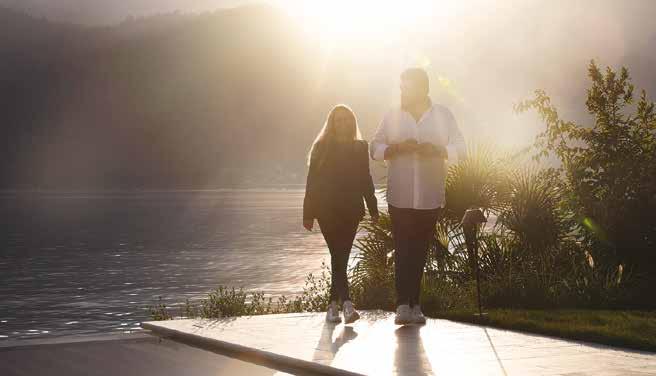
147
INTERVIEW WITH ANTONINO CANNAVACCIUOLO
How did Antonino Cannavacciuolo become a Chef?

I think it was a natural choice. My father certainly played an important role. For me, he’s the best of the best. I’ve always admired him, since I was a boy, for the determination and the effort he applied to his work. He did everything he could to discourage me, saying it was a very hard job and he didn’t want me to spend all public holidays away from my family. But in the end I got what I wanted. I hope he’s proud of me. I’ve worked very hard, since I was little, to be successful in my profession. This is what I’ve always wanted to do. I was born a cook, I grew up a cook, and I became a cook. I loved playing football, like all children, but when I was home, I would play with food - also because we didn’t have, back then, all the toys children have today. I believed in my potential, I’ve had great teachers, and I’ve worked hard. When everyone else was out on vacation, I was working. When I was little and still today. I carry with me every tiny single memory, from the most exciting ones to those that are less pleasant.
How are your dishes born?
My weapon to come up with new and tasty recipes is curiosity. Every Chef, but also every person who approaches the act of cooking with enthusiasm must be curious. If this trait is present, being in the kitchen will always be stimulating; trying to melt new substances and turning them into living matter.
What are the elements that today result in the level of success you have achieved with Relais Villa Crespi?
Determination, the search for unique experiences that are increasingly humane from the point of view of hospitality. Constant search for small things leads to the creation of high-level gastronomic itineraries, where raw materials are the protagonists.
A celebrity, a TV star, a talented entrepreneur. At what moment of your life did you understand you would have gotten so far?
I wouldn’t want to sound arrogant, but deep down I’ve always known. Of course, I could never have imagined to become this famous, no, but I’ve always known I was going to be good at my job and to reach important milestones. I’m a person who’s never satisfied, never. I grew up like this, and my father’s words when I made this professional choice for my life were: “Antonino, if you
148
I’M A PERSON WHO’S NEVER SATISFIED, NEVER.
want to do this job you must do it well. You must do your best. Otherwise, it’s not worth it”.
What’s your fondest memory? And who was the first person to believe in your talent?
Even if he probably wouldn’t admit it, I think my father was one of the first to believe in me and to acknowledge my skills. He always did things his way: he never complimented me, never exalted me, he taught me to be humble, respectful and determined. This has helped me find the incentive to better myself, always.
What emotions do you think haute cuisine should transmit today?
Cooking is passion, it’s curiosity. Haute cuisine, but pretty much any cuisine, should make us curious, should please people. It should never be tiring or tedious.
REST ASSURED THIS IS NOT THE END OF THE LINE FOR ME!
What dish best represents you?
Each one of my dishes belongs to me. For me, it’s as if they were my offspring. Cooking means expressing emotions and telling my own story. Each of my creations represents a part of me. A dish that I really love and that I find it hard to leave behind from among those offered at Villa Crespi is “Gragnano linguine, squid, rye bread sauce”. This recipe represents the union of the South, my birthplace, which I always carry in my heart, and Piedmont, the land where I work.
You have often stated that your brigade is like a family. On the other hand, your family has always been on your side in your work. How do you find the proper balance?
My brigade and everyone who works with me are my family indeed. Without them, nothing I have created would exist. This is a very simple, yet fundamental concept. My wife is at my side at all times, and in integral part of my job. It’s all an optimal balance.
Between shooting the TV programs you participate in, endorsement campaigns and the gastronomic offer of the Cannavacciuolo Group - the Bistrots, Laqua Resorts, and Relais Villa Crespi - how much time do you manage to dedicate to your brigade and to the Chefs of the different venues?
The secret is to surround yourself with trusted people who share the same passions, dreams and successes as you. I believe that no Chef would be complete without support and the work of their own brigade. Just like in any proper relationship, teamwork and two-way trust are crucial. In this sense, having surrounded myself with careful
and professional employees, I can give myself the luxury of not being physically present at the venues I manage, every now and then, so I can use my free time the best possible way.
What makes you feel truly at home?
Being able to work with tranquillity, going fishing, spending time with my loved ones. This is my life. Your latest project, Laqua Resorts, proposes an all-round hospitality concept. Just like you said, these are the places that I love. In every place that Cinzia and I have wanted, there’s a part of us. We make a huge effort, together with our staff, to create new offers for our clients. We’re super tired, but happy with what we’ve accomplished. We want that those who come can feel at home. If this doesn’t happen, it means we did something wrong. I’ve always had this vocation. When we opened Villa Crespi twenty years ago, we went into debt. When we began making some money, we didn’t keep any of it to ourselves, because for us it’s crucial to evolve. Since then, we’ve never stopped. I couldn’t stop now. Every new opening is a prelude to a new idea, a new project. I don’t ever want to stop.
Why did you choose this name for your new entrepreneurship, Laqua Resorts?
Water is an element that binds our life, mine and that of Cinzia, which is why we decided to celebrate it naming our project after it. We like to think that Laqua Resorts is the result of many years of sacrifice, dedication and love for hospitality, in terms of service, of gastronomy, and of relationship with our guests. After celebrating our twentieth anniversary at Relais Villa Crespi and facing an unprecedented historical moment that involved the entire world, we decided to create new, intimate reference points for hospitality in Italy. And we have remained loyal to our origins, Piedmont and Campania, and to hospitality made up of small but grandiose places where one can once again find joy and life. We opened Laqua Resorts last year: Laqua by the Lake in July 2021 and Laqua Countryside in August. One year later we opened Laqua Vineyard, which contains the DNA of this collection. Although Tuscany is a new destination to us, we attempted to find a location that could reflect this sensation of place and of home that we wish to transmit to our guests - and, as in each and every home, the beating heart is the kitchen. In 2021, considered the “recovery” year after the pandemic, Laqua Resorts gave us plenty of satisfaction, being well received by our guests, many of which return often and also choose to travel between our different “homes”, Meta di Sorrento, Ticciano, Lago d’Orta.
The 2-star in Villa Crespi, the starred bistros, Laqua Resorts, the books, the TV shows... What’s next? I have other goals, yes. At night I keep thinking on something new to do the next day. Rest assured this is not the end of the line for me!
149
CINZIA PRIMATESTA
What does hospitality mean for Antonino and Cinzia?
Working with hospitality today means sharing with those we host what we are, without filter or conditioning. It means being authentic, being ourselves, welcoming with our heart, with our soul, with the pure intention of making sure the other person feels good, because that person has chosen us, has come to us, and we feel obliged to donate everything we can donate, everything we have learned to share over the years. This is a job that is as internal as it is external, so that guests can feel it and take home something from us with them and, yes, perhaps also the wish to return to us someday. Cinzia adds: Thinking of Villa Crespi, already in 1999, when we opened, we were hospitality and we were fine dining too, actually. More than motivation to think, it was motivation to be, because both me and Antonino come from a restaurant and hospitality education. We are strongly convinced that both things add value to each other, they lift each other up, they give value to each other. These two elements make the experience more complete - like yin and yang, male and female - so when we
care, when we’re immersed in the place where we are, and we’re surprised by the tastes of our fabulous Mediterranean cuisine. We wanted to come up with a project that embraced northern and southern Italy, which is why we wanted to give life to new intimate points of reference for hospitality dedicated to our guests, to allow them to find their own time, dimension and mental and physical balance again.
Let’s talk about the brand-new Laqua Vineyard. How is it different from the other resorts of the collection?
Laqua Vineyard is our new resort in Tuscany. It stands out for its location; from the point of view of geography, it’s in a different place than Campania and Piedmont. We always attempt to absorb the culture, the DNA and the atmosphere of the place, both in the interior design and in the choices of the team working within the resort, which must transmit the authenticity of the location, and in the selection of raw materials, honouring the products and the wines of the territory.
On the other hand, it’s just like the others when it comes to the spirit that identifies all Laqua resorts. The maniacal attention to details that I share with Antonino, for example; and the fact
IN ITALY, HEART AND WARMTH HAVE THE UPPER HAND.
have a combination of both elements, we can say the experience is truly complete.
A nice lunch or dinner allows us to unwind after a long day, but also being able to sleep, disconnect our minds from everyday worries to lodge in a place that is not the one where we spend most of our days, is even more relevant today than it was 20 years ago, because it allows us to regenerate. Not only that; it allows you to have an important imprinting that is important in the restaurant experience: when you lodge with us, you have time to internalize your experience, to grasp its many hues, all important aspects that lead to a slowing down and to a savoir vivre, exactly when today’s life makes us do the opposite, to live in a rush.
What is the lifeline that connects all projects of the Resorts?
The Laqua Resorts collection was born out of our strong desire, mine and Antonino’s, to offer hospitality combined with food, just like home. All our “homes” attempt to transmit to our guests the simplicity of the emotions we experience when we’re well, when we are welcomed and pampered by many little signs of
that we pour our souls into everything we create for our guests. We want our guests to feel at home, to feel the heart of those who serve and welcome them, they must be able to eat well with top-quality products and an interesting cuisine, we want them to feel stimulated and to feel well in the hospitality space. They must be able to sleep well, we want them to have a cosy room. We want them to be able to absorb everything we can share with authenticity and with an Italian spirit, all referring to the territory to which the location belongs.
In what aspects does Italian hospitality reach excellence levels?
Italy represents tourism excellence - we’re very much appreciating the development of 360-degree experience tourism that gives small businesses and venues the relevance they deserveworkshops, arts and many little hamlets and towns that contain the precious traditions of our wonderful country. Each country has its own tourism trends, ideas and experiences that are created, but in the end each country has its own model. In Italy, heart and warmth have the upper hand. We sometimes take it for granted, but foreigners really do feel it.
150 INTERVIEW WITH
AutoVanti Monza

AutoVanti Bologna
AutoVanti Brianza
AutoVanti Milano
Viale
Dealership
BMW
Del Ghisallo, 20 - Milano
BMW Dealership Viale Sicilia, 130 - Monza
BMW Dealership Via Milano, 33 - Desio (MB)
BMW Dealership Via Guido Rossa, 8 - Casalecchio di Reno (BO) Via del Lavoro, 1 - Quarto Inferiore (BO) CONFIGURE IT AND BOOK IT IN OUR DEALERSHIPS, WE ARE WAITING FOR YOU. THE NEW BMW X1 REDEFINES THE AESTHETIC STANDARDS OF THE SEGMENT AND IMPRESSES FOR VERSATILITY AND FUNCTIONALITY. WITH A RENEWED LOOK, IT IS AN EVOLUTION EVEN MORE DYNAMIC AND TECHNOLOGICAL THAN THE PREVIOUS MODEL. New BMW X1: Fuel consumption 1/100 km (combined cycle): 4,9-7.3: COz emissions a/km (combined cycle): 129-161. The consumption fuel and CO2 emissions reported were determined on the basis of the WLTP procedure referred to EU Regulation 2017/1151. The data indicated may vary depending on of the equipment chosen and any additional accessories. For the purpose of calculating taxes and eco-incentives that are based on COz emissions, could be applied values other than those indicated. New BMW X1: deliveries from October 2022.

152 LAQUA COUNTRYSIDE atmosfera conviviale tipicamente italiana typically Italian convivial atmosphere GOLFO DI SORRENTO
Laqua Countryside


153 CAMPANIA
Il volto inedito DELLA PENISOLA SORRENTINA
LAQUA Countryside è la casa d’infanzia di Chef Antonino Cannavacciuolo sulle colline di Vico Equense. Sei camere da letto disposte su due piani di una grande villa tradizionale campana, dove l’orto, il frutteto e il fresco pergolato fanno da protagonisti ancora oggi, ricreando quell’atmosfera conviviale tipica delle famiglie italiane e mettendo al centro un elemento fondamentale: la buona tavola, interpretata magistralmente dal ristorante 1 Stella Michelin.

Ogni camera è ispirata a una persona dell’infanzia dello Chef ed è finemente decorata con pezzi di design e complementi d’arredo capaci di trasportare l’ospite in sei storie diverse. Di particolare nota la suite Marina, che occupa l’intero piano mansardato da 107 mq, con una conformazione unica che si adatta alle volte delle cupole del piano inferiore e una terrazza panoramica con vista mare. Il resort è infine dotato di una piscina incastonata tra la dimora e il grande orto, usato regolarmente dalla brigata e protagonista del corso di cucina proposto dal resort.
Un luogo dove riconnettersi con un’atmosfera autentica e rigenerare corpo e anima a contatto con le tradizioni.
THE UNSEEN FACE OF THE SORRENTO PENINSULA
LAQUA Countryside is Chef Antonino Cannavacciuolo’s childhood home in the hills of Vico Equense. Six bedrooms located on two floors of a large traditional Campanian villa, where the vegetable garden, the orchard and the wisteria pergola are the centerpieces, recreating that convivial atmosphere typical of Italian families and focusing on a fundamental element: good food, masterfully interpreted by the 1 Michelin-starred restaurant. Each room is inspired by a person from the Chef’s childhood and is finely decorated with design pieces and furniture that can transport guests into six different tales. Of particular note is the Marina suite, which occupies the entire 1150-square-feet attic floor, with a unique conformation that adapts to the vaulted domes of the lower floor and a panoramic terrace with sea view. Finally, the resort has a swimming pool nestled between the mansion and the large vegetable garden, which is regularly used by the brigade and is the star of the cooking class offered by the resort. A place to reconnect with an authentic atmosphere and regenerate body and soul in contact with traditions.
154
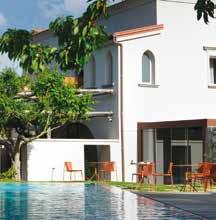



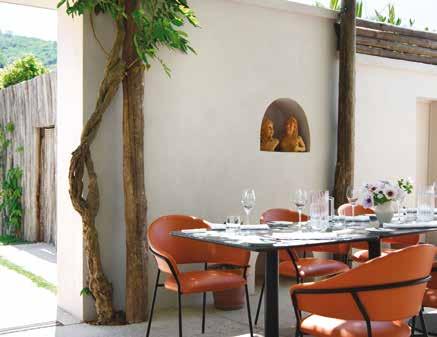
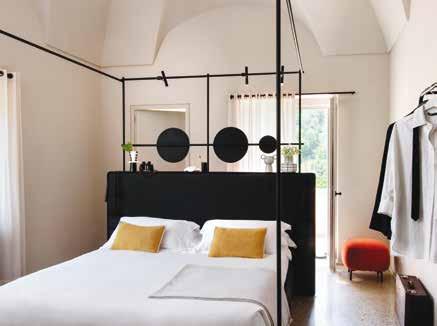

155
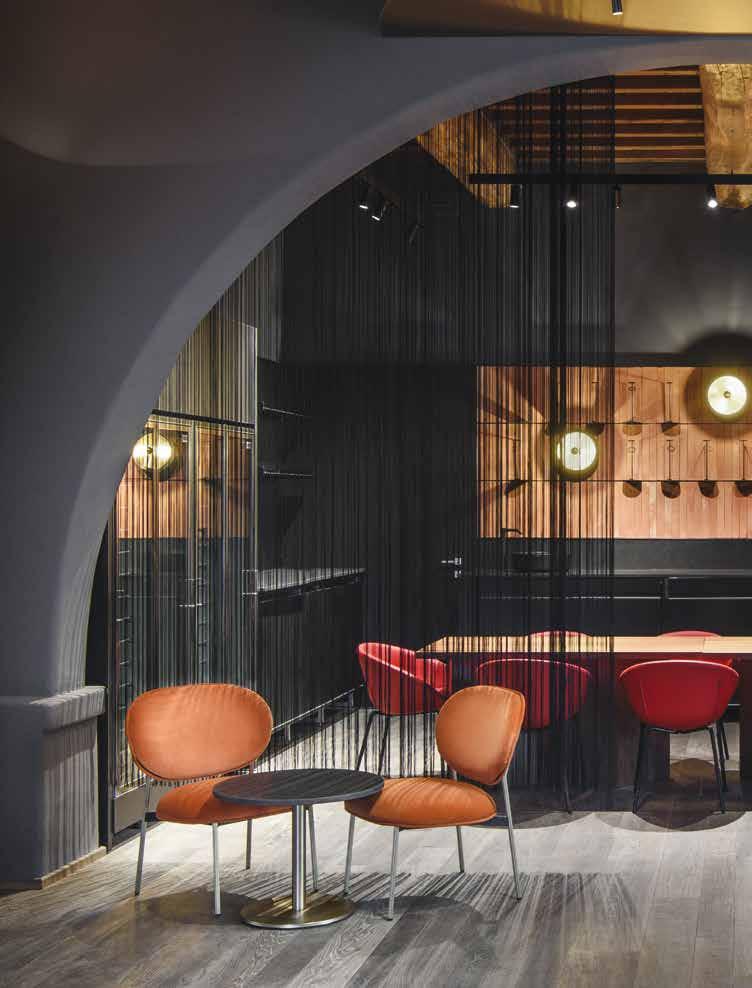
LAQUA VINEYARD uno stile squisitamente toscano an exquisitely Tuscan style CASANOVA DI TERRICCIOLA
TOSCANA Laqua Vineyard


DESIGN E LUSSO
nella più autentica campagna toscana
LAQUA Vineyard, il nuovo resort di Cinzia e Antonino Cannavacciuolo sorge in un antico casolare del 1.600 ristrutturato secondo uno stile squisitamente toscano, all’interno del borgo etrusco di Casanova di Terricciola, nelle colline tra Pisa e Volterra.
La casa ospita sei ampi appartamenti, tutti dotati di una zona living con cucina privata, una o due camere da letto e uno o due bagni, per godersi lunghi rilassanti soggiorni nella più autentica campagna toscana, in un ambiente famigliare e intimo, che non rinuncia però al design e al lusso.
La cucina del ristorante Cannavacciuolo Vineyard celebra uno dei temi più cantati dai grandi poeti di questa terra: l’amore. Un intimo setting teatrale, luci soffuse, un imponente arco: è qui che va in scena ogni giorno la leggendaria danza di corteggiamento tra arte culinaria ed enologia, in piatti che esplorano il genio creativo dello Chef e il suo incontro con i sapori locali. Completa l’offerta una piccola SPA con bagno turco e trattamenti speciali, come il massaggio corpo con olio di vinaccioli prodotto in Toscana, per un’immersione totale nel territorio, capace di coinvolgere tutti i sensi.
DESIGN AND LUXURY IN THE MOST AUTHENTIC TUSCAN COUNTRYSIDE

LAQUA Vineyard, Cinzia and Antonino Cannavacciuolo’s new resort, stands in an old 17th-century villa renovated in an exquisitely Tuscan style, within the Etruscan village of Casanova di Terricciola, in the hills between Pisa and Volterra. The mansion is home to six spacious apartments, all with a living area with private kitchen, one or two bedrooms and one or two bathrooms, to enjoy long relaxing stays in the most authentic Tuscan countryside, in a family and intimate setting that does not, however, give up on design and luxury.
The Cannavacciuolo Vineyard restaurant celebrates one of the themes most sung about by the great poets of this land: love. An intimate theater setting, soft lighting, an imposing archway: this is where the mythical courtship between culinary art and oenology is staged every day, in dishes that explore the Chef’s creative genius and his encounter with local flavors.
Completing the offer is a small wellness area with a steam bath and special treatments, such as a body massage with grape seed oil produced in Tuscany, for a total immersion in the territory, that would engage all the senses.
158






159

160
GUARDIAMO (E PROTEGGIAMO) IL MARE CON NEPTUNE
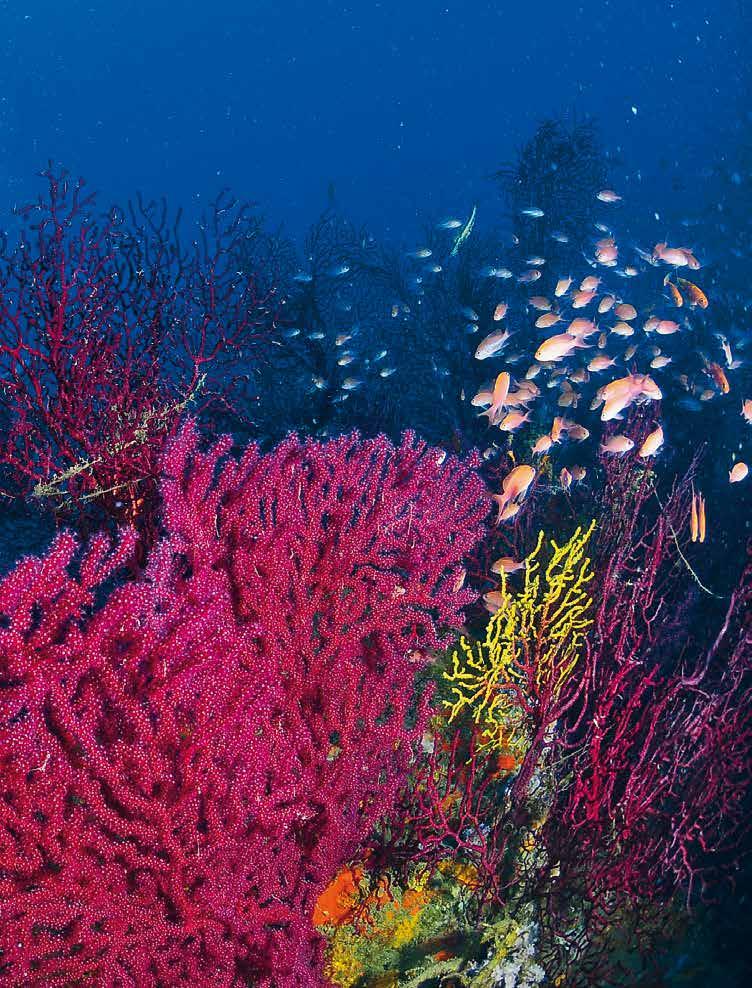
161
“ “ di/by: YLM photo: SEA Ty
Ogni subacqueo, apneista, snorkelista ma anche “semplice” bagnante che abbia messo, anche solo per un attimo, la testa sott’acqua può capire quanto affermava J-Y Cousteau: “Dopo l’istante magico in cui i miei occhi si sono aperti nel mare, non mi è stato più possibile vedere, pensare, vivere come prima”. Eppure, nonostante la sua straordinaria bellezza e la sua importanza per la sopravvivenza dell’intero pianeta, il mare resta ancora uno degli ambienti meno esplorati (poco più del 5%), più sfruttati ed esposto ad eventi estremi frequenti. Anche attività sportive da sempre legate al mare come la subacquea, se praticate non correttamente, possono avere impatti negativi causati dal danneggiamento, dalla raccolta indebita, dall’inquinamento.
Per favorire lo sviluppo sostenibile delle attività
ricreative e professionali subacquee, garantendo allo stesso tempo la tutela degli habitat marini e costieri ad elevato valore naturalistico e culturale, è nato NEPTUNE (acronimo di PatrimoNio naturalE e culTUrale sommerso e gestione sosteNibile della subacquEa ricreativa), un progetto cofinanziato dal Programma Marittimo 2014-2020 di cooperazione transfrontaliera Italia Francia, con a capofila l’Area Marina Protetta di Portofino, in partenariato con Regione Liguria, Regione Sardegna, Parco Nazionale dell’Arcipelago Toscano, Parc National de Port-Cros, Région Sud Provence - Alpes - Côte d’Azur e il Centre de Découverte du Monde Marin. Grazie al progetto, sono stati realizzati strumenti per formare e informare chi frequenta il nostro mare sui valori ambientali del patrimonio marino e sulla necessità di una maggiore sostenibilità.
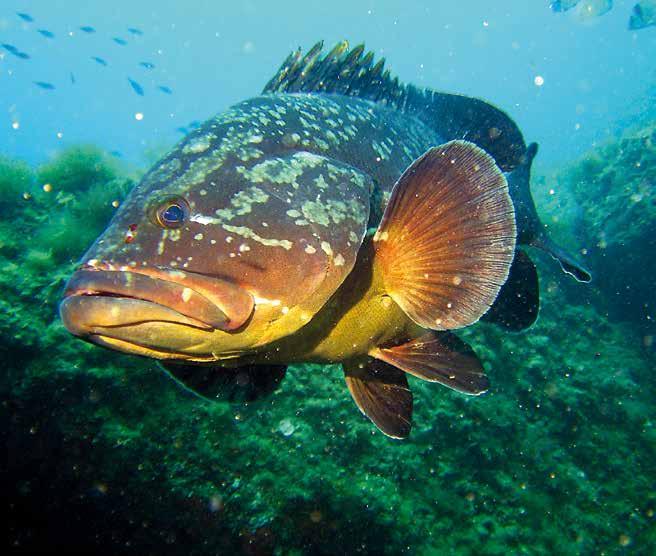
162
PER FAVORIRE LO SVILUPPO SOSTENIBILE DELLE ATTIVITÀ RICREATIVE E PROFESSIONALI SUBACQUEE È NATO NEPTUNE.
“
Sono stati mappati e descritti, con schede tecniche e fotografiche, siti di immersione e snorkeling, chiamati “Percorsi blu”, aree meno conosciute ma estremamente ricche in termini di biodiversità dove immergersi accompagnati da diving locali. Il portale www.neptuneproject.eu, quasi concluso, permetterà di condividere news, curiosità ma anche buone pratiche per essere subacquei sostenibili. Sarà possibile godere e condividere foto e video dei siti più belli dello spazio marino transfrontaliero, anche grazie ai social di progetto, implementando così la curiosità e la conoscenza sui temi ambientali, primo passo per una maggiore tutela e protezione. Infine, il progetto sta dando largo spazio al “Sistema di distretto ligure della subacquea”, il primo accordo nazionale che vuole mettere in rete tutte le attività operanti nel settore della subacquea.

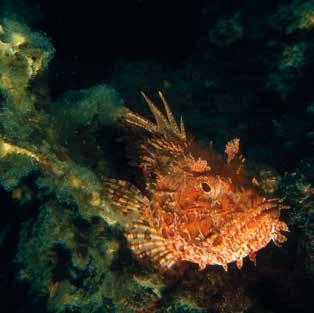
163
NEPTUNE WAS CREATED TO PROMOTE THE SUSTAINABLE DEVELOPMENT OF RECREATIONAL AND PROFESSIONAL DIVING
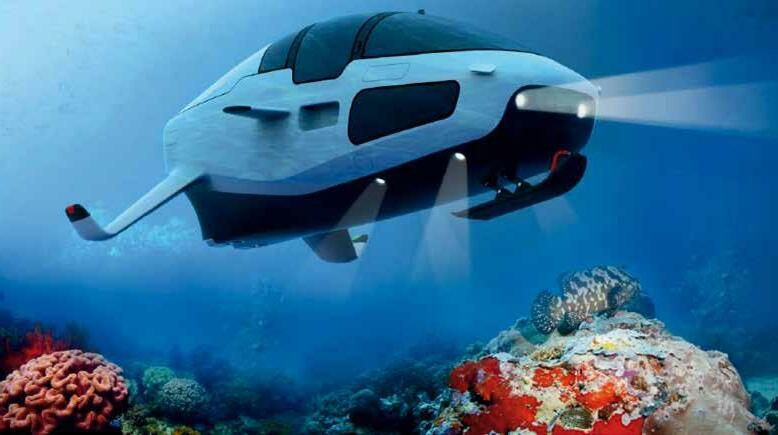
WE LOOK AT (AND PROTECT) THE SEA WITH NEPTUNE


Any scuba diver, freediver, snorkeller, swimmers too, who has put his head underwater, even just for a moment, can understand what J-Y Cousteau said: “after the magical moment when my eyes opened in the sea, it was no longer possible for me to see, think or live as before”. Yet, despite its extraordinary beauty and its importance for the survival of the entire planet, the sea remains one of the environments least explored (little more than 5%), most exploited and exposed to frequent extreme events. Even sports activities that have always been linked to the sea such as scuba diving, if not practised correctly, can have negative impacts caused by damage, inappropriate collecting and pollution. To promote the sustainable development of recreational and professional diving, while ensuring the protection of marine and coastal habitats of high natural and cultural value, NEPTUNE (acronym meaning the submerged natural and cultural heritage, and sustainable management of recreational diving) was founded, a project co-financed by the Italy-France Cross-Border Maritime Cooperation Programme 2014-2020, led by the Portofino Marine Protected Area, in partnership with the Liguria Region, the Sardinia
Region, the Tuscan Archipelago National Park, the Port-Cros National Park, the South Provence - Alps - Côte d’Azur Region and the Marine World Discovery Centre. Thanks to the project, tools have been created to train and inform those who frequent our sea about the environmental values concerning the marine heritage and the need for greater sustainability.
Diving and snorkelling sites have been mapped and described, with technical and photographic documentation, called “Blue Routes”, less well-known areas but extremely rich in terms of biodiversity where you can dive accompanied by local divers. The portal www.neptuneproject.eu, almost completed, will allow for sharing news, curiosities and good practices to promote sustainable diving. It will be possible to enjoy and share photos and videos of the most beautiful sites in the cross-border marine space, also thanks to the social networks of the project, thus establishing curiosity for and knowledge of environmental issues, a first step for greater defence and protection. Finally, the project is giving ample space to the “Ligurian Diving District System”, the first national agreement aiming to network all the activities going on in the diving sector.
164
“ “



165
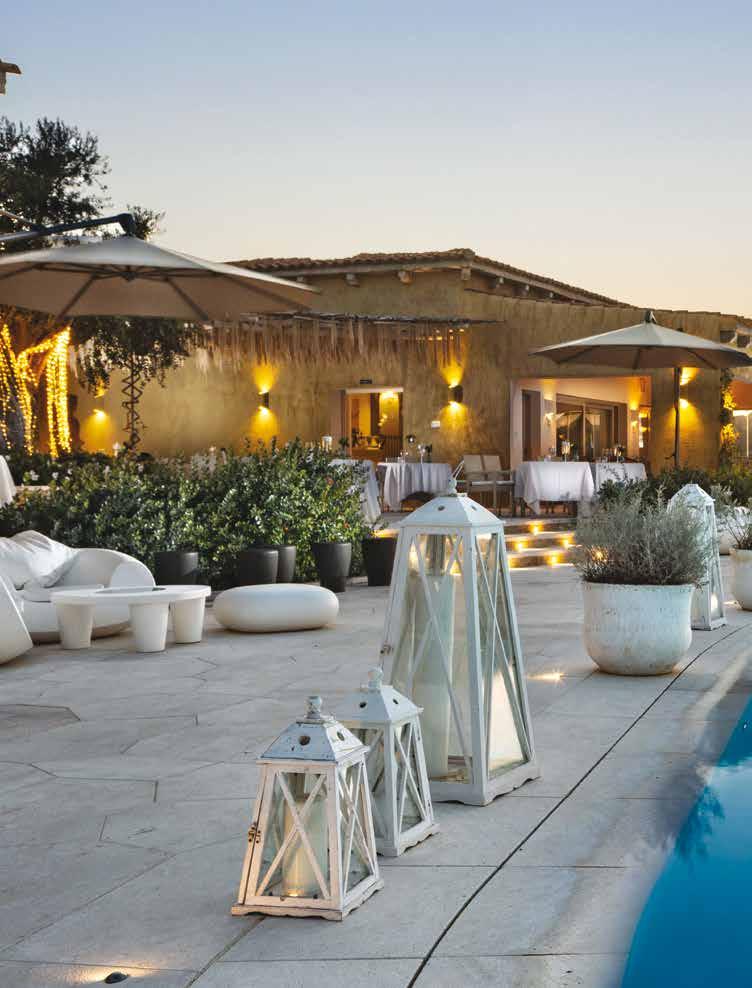
LI FINISTREDDI EXCLUSIVE COUNTRY RETREAT lusso e semplicità nel cuore della Costa Smeralda luxury and simplicity in the heart of the Costa Smeralda COSTA SMERALDA
Li Finistreddi Exclusive Country Retreat

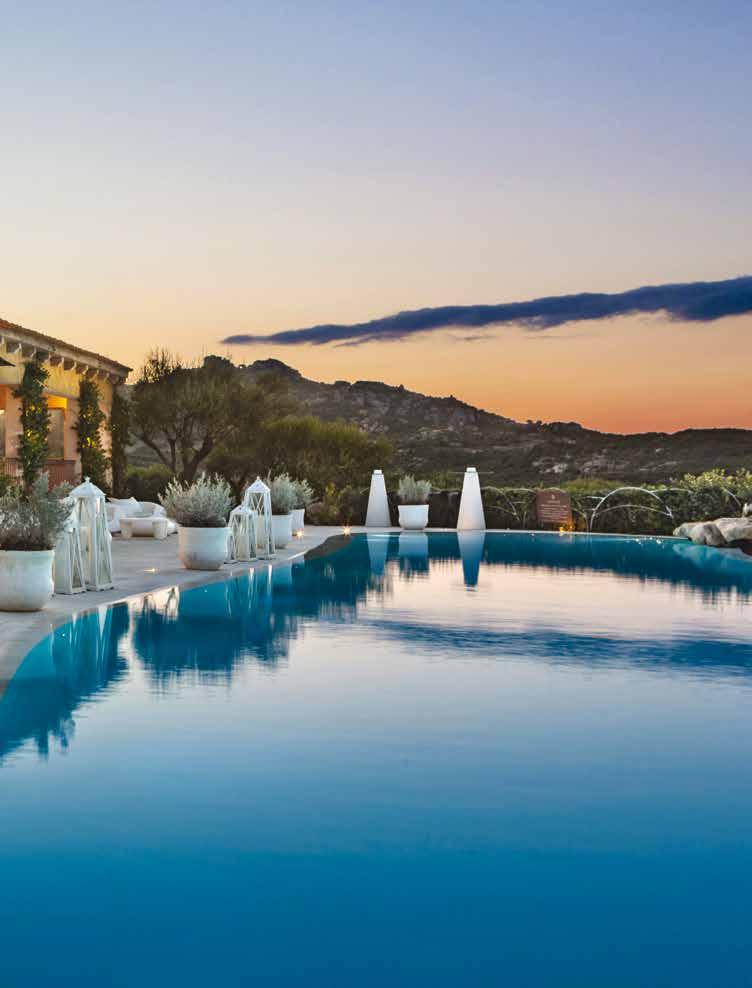
SARDEGNA
Dove il mare si tinge dei colori del cielo
E L’ORIZZONTE SPARISCE
Una proprietà di 6 ettari con vista panoramica, accogliente e confortevole sulla cima di un’altura che domina il mare della Costa Smeralda e l’arcipelago di La Maddalena: un sogno chiamato Li Finistreddi. 3 ville esclusive e 19 camere e suite indipendenti gravitano intorno alla Clubhouse che ospita la reception, il ristorante, il lounge bar e le due piscine disposte su terrazze panoramiche che vedono il mare. Le tre ville Inula, Ferula e Scilla innalzano a un nuovo livello l’accoglienza e il lusso di Li Finistreddi Exclusive Country Retreat. Ognuna gode della vista sull’arcipelago, sul parco del resort e sul giardino mediterraneo con piscina privata riscaldata. Di carattere moderno, lineare e funzionale, offrono ai loro ospiti tutti i servizi a cinque stelle dell’albergo: il ristorante Osteria Gourmet, il lounge bar, la Spa, il room service, il servizio spiaggia e il parcheggio coperto, oltre ad alcuni esclusivi su richiesta, tra cui le cene private in villa e la presenza di un butler dedicato. Per gli ospiti che desiderassero giungere direttamente in elicottero o provare l’esperienza di un volo panoramico è presente un eliporto privato.
WHERE THE SEA TAKES ON THE COLOURS OF THE SKY AND THE HORIZON DISAPPEARS
A 6-hectare property with panoramic view, welcoming and comfortable lifestyle on the crest of a hill, overlooking the waters of the Costa Smeralda and the archipelago of La Maddalena: a dream called Li Finistreddi. 3 exclusive villas and 19 independently accessed rooms and suites encircle the Clubhouse, which is home to the reception, restaurant, lounge bar and two swimming pools set on panoramic terraces with unparalled sea views. The three villas - Inula, Ferula and Scilla - take hospitality at Li Finistreddi Exclusive Country Retreat to a new level. Each of the villas offer views of the archipelago, the resort’s park and the Mediterranean garden with private heated pool. They have a modern, linear and functional feel, and guests of the villas enjoy all the five-star services of the hotel: the Osteria Gourmet restaurant, lounge bar, spa, room service, beach service and covered parking, as well as some exclusive services upon request, including private dinners in the villa and a dedicated butler. For guests who wish to arrive directly by helicopter or experience a panoramic flight, there is a private heliport.
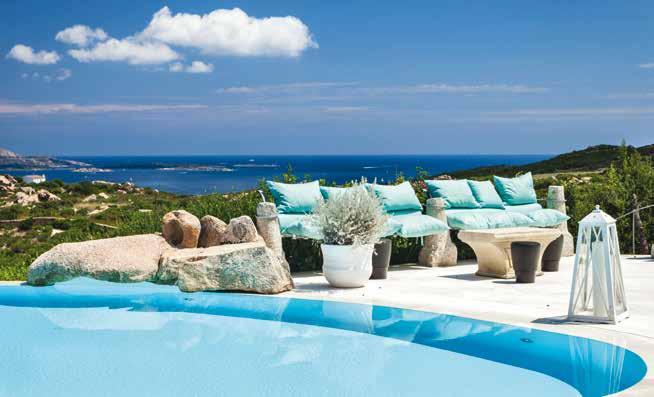
168



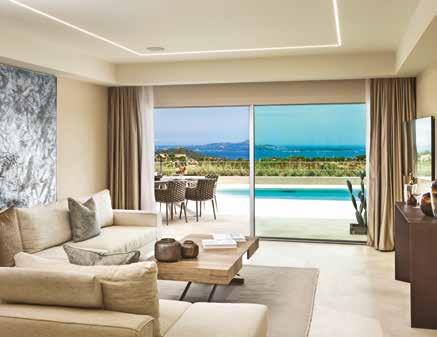

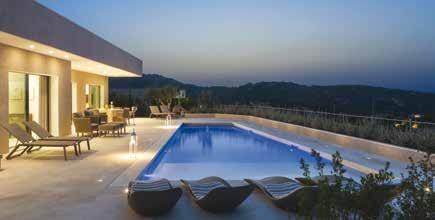
169
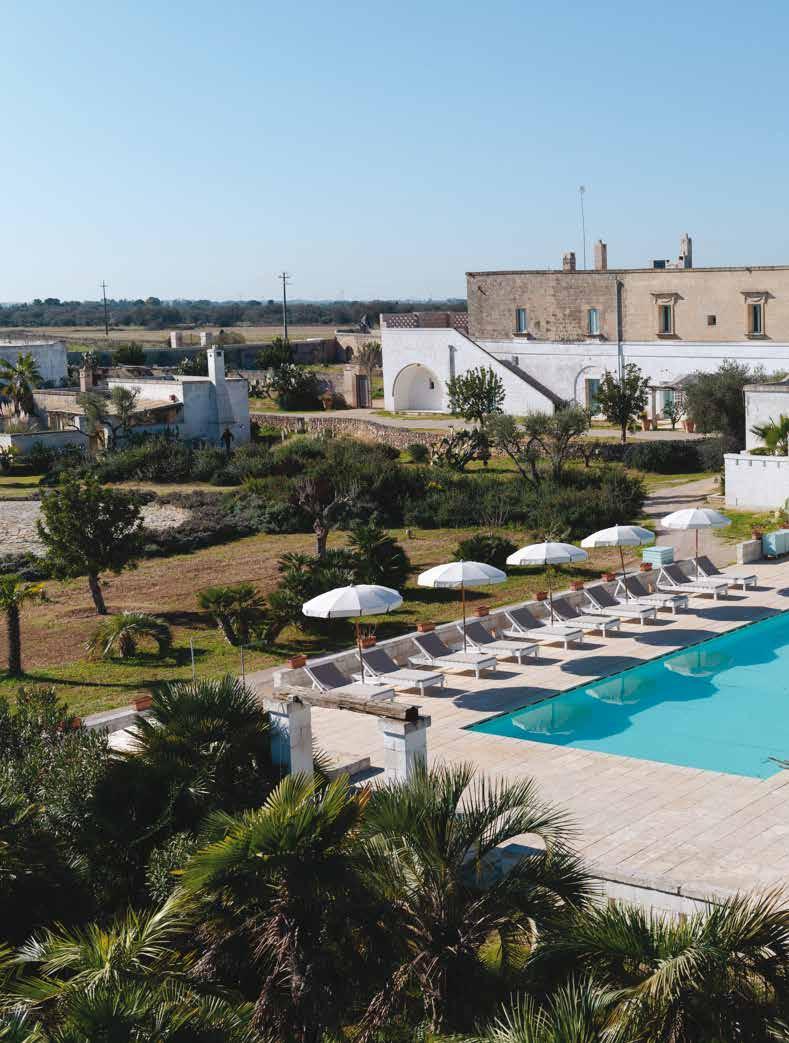
SALENTO MASSERIA PALOMBARA un’autentica Masseria pugliese dal lusso non convenzionale unconventional luxury at an authentic Apulian Masseria
Masseria Palombara


PUGLIA
NATURA INCONTAMINATA
nel cuore del Salento
Masseria Palombara è il recupero conservativo di un’autentica Masseria di Puglia del XVI secolo, tra Oria e Manduria - nel cuore del Salento - non lontana dal mare, immersa in circa 100 ettari di natura incontaminata, luogo ideale per gli amanti del relax, del benessere, della buona cucina, dei vini di eccellenza.
16 Camere e 4 Suite offrono intimità e privacy grazie a giardini e terrazze riservate. Arredate con gusto e mobili vintage, molte sorprendono gli ospiti con giardini segreti, piscine ed hammam privati.
Gli antichi granai della Masseria sono oggi una SPA di charme, un rifugio denso di calore, vapore e sensazioni, per il benessere dell’anima e del corpo.
Il ristorante è un luogo autentico, accogliente e informale, espressione del territorio locale grazie ai prodotti dell’orto biologico della Masseria. Lo Chef Francesco Lucati propone un menu stagionale da gustare al calore dei camini d’inverno, sotto il portico o a bordo piscina nelle calde sere d’estate. Masseria Palombara, è un’esperienza dal lusso non convenzionale, dove perdersi nello spazio e nel tempo immersi nella Puglia più bella e autentica.
UNSPOILT NATURAL SURROUNDINGS IN THE HEART OF THE SALENTO COUNTRYSIDE
Masseria Palombara is an authentic Apulian ‘masseria’, a limestone farmhouse originally built in the 16th century in the heart of the Salento countryside. The Masseria offers an immersive rural experience - a gentle retreat for adults only - surrounded by centuriesold olive groves, almond trees and 100-hectares of unspoilt natural surroundings.
The 16 rooms and 4 suites offer intimacy and privacy thanks to private gardens and terraces. Tastefully decorated with vintage furniture, many of them surprise guests with secret gardens, private pools and hammams.
The ancient granaries of the Masseria are now a charming SPA, a dense refuge of heat, steam and sensations, for the well-being of the soul and body.

The restaurant is an authentic, welcoming and informal place, expression of the local territory thanks to the products of the Masseria’s organic garden. Chef Francesco Lucati offers a seasonal menu to be enjoyed in the warmth of the winter fireplaces, under the porch or by the pool on warm summer evenings.
Masseria Palombara, is an unconventional luxury experience, where you can get lost in space and time immersed in the most beautiful and authentic Puglia.
172

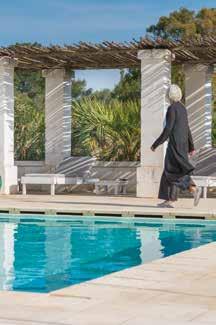





173


B 1.618 OPENWORK TOURBILLON BIANCHET SHOWROOM - NEUCHÂTEL SWITZERLAND
DEEPSEAKER VIVERE IL MARE IN MODO NUOVO
Il DeepSeaker DS1, un innovativo aliscafo/ sommergibile prodotto dalla startup italiana iSpace2o, apre una nuova categoria di imbarcazioni in grado non solo di sfrecciare sull’acqua ad oltre 30 nodi, ma anche di immergersi e godere delle meraviglie del fondale marino. Il DeepSeaker appartiene alla gamma dei toys di bordo dei grandi yacht, protagonista di gite turistiche sottomarine per ammirare i santuari archeologici sotto costa e le grandi barriere coralline che già in pochissimi metri d’acqua offrono incredibili spettacoli della natura sommersa, garantendo la massima sicurezza dei passeggeri a bordo e il massimo rispetto dell’ambiente circostante. Darà inoltre la possibilità di offrire ai visitatori di parchi marini un’esperienza immersiva, e questa volta in senso letterale. iSpace2o ha già raccolto manifestazioni d’interesse per il DeepSeaker da grandi gruppi di navigazione internazionali, che li utilizzeranno come mezzo di intrattenimento per i passeggeri sulle proprie navi da crociera. La mission di iSpace2o è sempre stata quella di

cambiare il modo di vivere e scoprire il mare nel massimo rispetto dell’ecosistema grazie alla propulsione elettrica, come spiega l’Ing. Giuseppe Carusi, CEO di iSpace2o.
Come descriveresti il DeepSeaker?
“È unico nel suo genere, si tratta del primo veicolo in grado di muoversi sull’acqua anche in modalità aliscafo, trasporta fino a 4 passeggeri ed è in grado di immergersi come un sottomarino fino ad una profondità di 50 metri. Con il DeepSeaker è possibile immaginare di esplorare magnifiche barriere coralline e relitti sommersi rispettando l’ambiente circostante”.
Come è nata l’idea di progettare un simile mezzo?
“Ho sempre avuto la passione per il mare, sono un velista e ho vissuto in acqua per tutta la vita, di conseguenza lavorare con barche è stato naturale per me. Tuttavia, come subacqueo ho sempre sentito che c’era bisogno di qualcosa che potesse trasportare le persone sott’acqua in modo sicuro, compresi i
175
soggetti con disabilità. Ovviamente si tratta di un prodotto di lusso dal prezzo considerevole (1,5 milioni di euro), ma è utilizzabile sia sugli yacht privati che in altre situazioni. Crediamo che anche le compagnie di crociera potrebbero offrire una nuova emozionante esperienza subacquea ai loro passeggeri con il DeepSeaker”.

Quali sono le innovazioni sul DeepSeaker?
“Quando lo abbiamo progettato la nostra priorità è stata il rispetto dell’ecosistema. Utilizziamo motori DeepSpeed a propulsione elettrica progettati da Sealence, un’innovazione che rivoluzionerà il settore delle barche elettriche. Si tratta di turbine molto potenti, posizionate all’esterno dell’imbarcazione, che muovono l’acqua e non danneggiano la fauna marina. La prima versione funzionerà a batterie, ma stiamo già lavorando ad un propulsore ibrido a idrogeno per il futuro. Inoltre stiamo mettendo a punto un sistema di respirazione rivoluzionario. Rispetto agli altri sottomarini che trasportano bombole di ossigeno ed hanno un sistema interno di ricircolo a circuito chiuso con filtri per la pulizia dell’aria dalla Co2, il nostro sistema brevettato, in fase di sperimentazione, prevede un sistema di estrazione di un mix d’ossigeno respirabile direttamente dall’acqua di mare. Il sistema denominato LAF (Like a Fish) recupera il 2% di ossigeno pulito che serve a reintegrare quello disperso dal rebreather
durante l’operazione di pulizia della Co2 e quindi possiamo utilizzare bombole molto più piccole per lo stoccaggio”.
Quanto è grande un DeepSeaker?
“Il DeepSeaker ha un peso di 3 tonnellate per 5 metri di lunghezza, il che lo rende abbastanza maneggevole, tanto da poter essere caricato e trasportato su un piccolo carrello per barche o sollevato da una piccola gru per una facile messa in acqua. Potrà inoltre essere ormeggiato in qualsiasi porto in modo tale da poterlo utilizzare come un normale tender”.
Quali altre possibilità di utilizzo potrebbe avere il DeepSeaker in futuro?
“Il veicolo potrebbe essere utilizzato per pattugliare le coste, per la ricerca scientifica, e naturalmente per il soccorso in mare, essendo in grado di muoversi velocemente sulla superficie e di immergersi. Siamo anche aperti alla progettazione e la produzione di mezzi per scopi specifici”.
Quando sarà disponibile al pubblico il DeepSeaker?
“Stiamo lavorando al prototipo sperimentale che dovrà essere sottoposto ai test e messo a punto per procedere al prototipo finale. Giancarlo Zema, designer incaricato del restyling del progetto, si occuperà dell’estetica e contiamo di essere pronti per la produzione nell’estate 2023”.
176
EXPERIENCE THE SEA IN A NEW WAY
The DeepSeaker DS1, an innovative hydrofoil/submarine produced by the Italian startup iSpace2o, opens up a new category of boats capable not only of speeding over the water at over 30 knots, but also of diving and enjoying the wonders of the seabed.
The DeepSeaker belongs to the range of toys on board large yachts, the protagonist of underwater tourist trips to admire the archaeological sanctuaries under the coast and the large coral reefs that already in a few meters of water offer incredible spectacles of submerged nature, guaranteeing maximum safety of the passengers on board and the utmost respect for the surrounding environment. It will also give the opportunity to offer marine park visitors an immersive experience, and this time in the literal sense. iSpace2o has already collected expressions of interest in the DeepSeaker from large international navigation groups, which will use it as a means of entertainment for passengers on their cruise ships.
The mission of iSpace2o has always been to change the way of living and discovering the sea with the utmost respect for the ecosystem thanks to electric propulsion, as explained by Eng. Giuseppe Carusi, CEO of iSpace2o.
How would you describe the DeepSeaker?
"It is one of a kind, it is the first vehicle capable of moving
on water even in hydrofoil mode, it carries up to 4 passengers and is capable of diving like a submarine to a depth of 50 meters. With the DeepSeaker it is possible to imagine exploring magnificent coral reefs and submerged wrecks while respecting the surrounding environment".
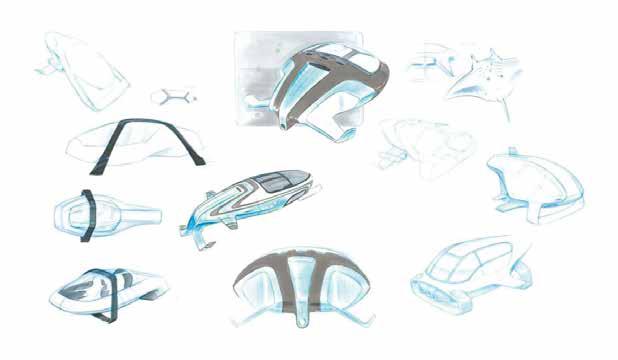
How did the idea of designing such a vehicle come about?
“I have always had a passion for the sea, I am a sailor and have lived in the water all my life, so working with boats was natural for me. However, as a diver I have always felt that there was a need for something that could transport people safely underwater, including those with disabilities. Obviously this is a luxury product with a considerable price (1.5 million euros), but it can be used both on private yachts and in other situations. We believe that cruise lines could also offer a new exciting diving experience to their passengers with the DeepSeaker".
What are the innovations on the DeepSeaker?
“When we designed it, our priority was respect for the ecosystem. We use DeepSpeed electric propulsion engines designed by Sealence, an innovation that will revolutionize the electric boat sector. These are very powerful turbines, positioned outside the boat, which move the water and do not damage the marine fauna. The first version will run on batteries, but we are already working on a hydrogen hybrid powertrain for the future. We are also developing a revolutionary breathing system. Compared to other submarines that carry oxygen cylinders and have an internal closed-circuit recirculation system with scrubbers for
177 DEEPSEAKER
cleaning the air from Co2 our patented system, currently being tested, provides for a system capable of extracting a mix of breathable oxygen directly from sea water. The system called LAF (Like a Fish) recovers 2% of clean oxygen which is used to replenish that dispersed by the rebreather during the CO2 cleaning operation and therefore we can use much smaller cylinders for storage".
How big is a DeepSeaker?
“The DeepSeaker weighs 3 tons by 5 meters in length, making it handy enough to be loaded and transported on a small boat trailer or lifted by a small crane for easy launching. It can also be moored in any port so that it can be used as a normal tender".
What other uses could the DeepSeaker have in the future?
“The vehicle could be used to patrol the coasts, for scientific research, and of course for search and rescue at sea, being able to move quickly on the surface and to dive. We are also open to the design and production of mission specific watercrafts".

When will the DeepSeaker be available to the public?
“We are working on the experimental prototype which will need to be tested and fine-tuned to proceed to the final prototype. Giancarlo Zema, designer in charge of the restyling of the project, will take care of the aesthetics and we hope to be ready for production in the summer of 2023".
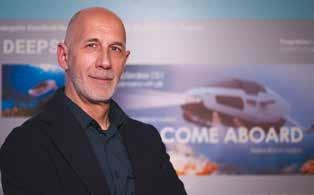
178

MINARETO
un’oasi di relax e piacere a truly relaxing oasis of pleasure
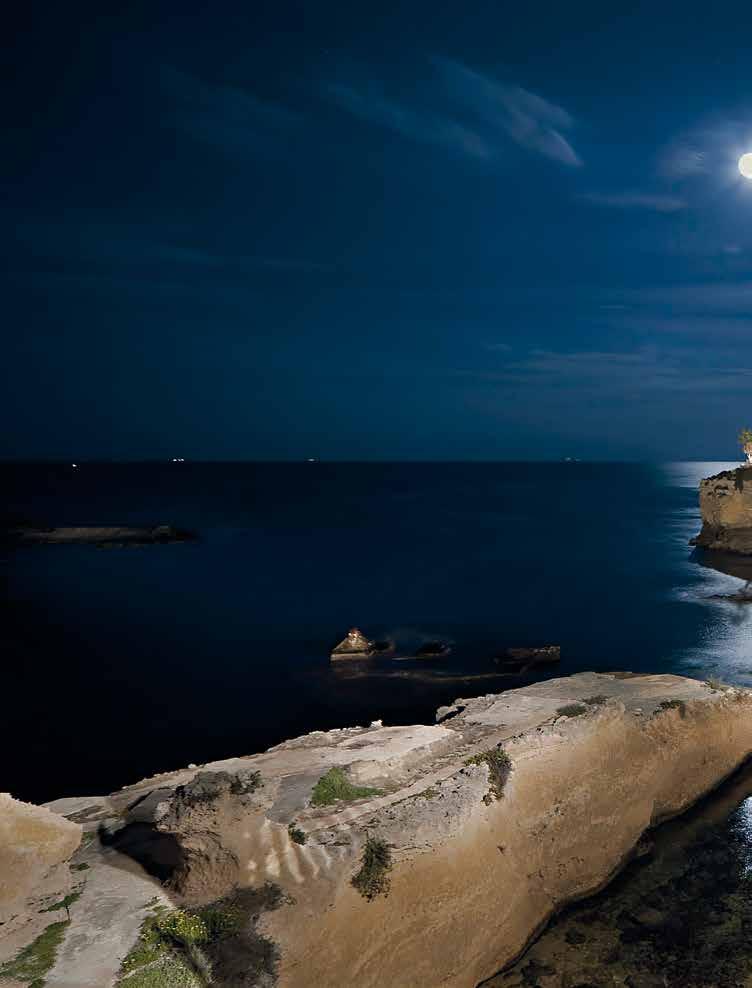
SIRACUSA
Minareto
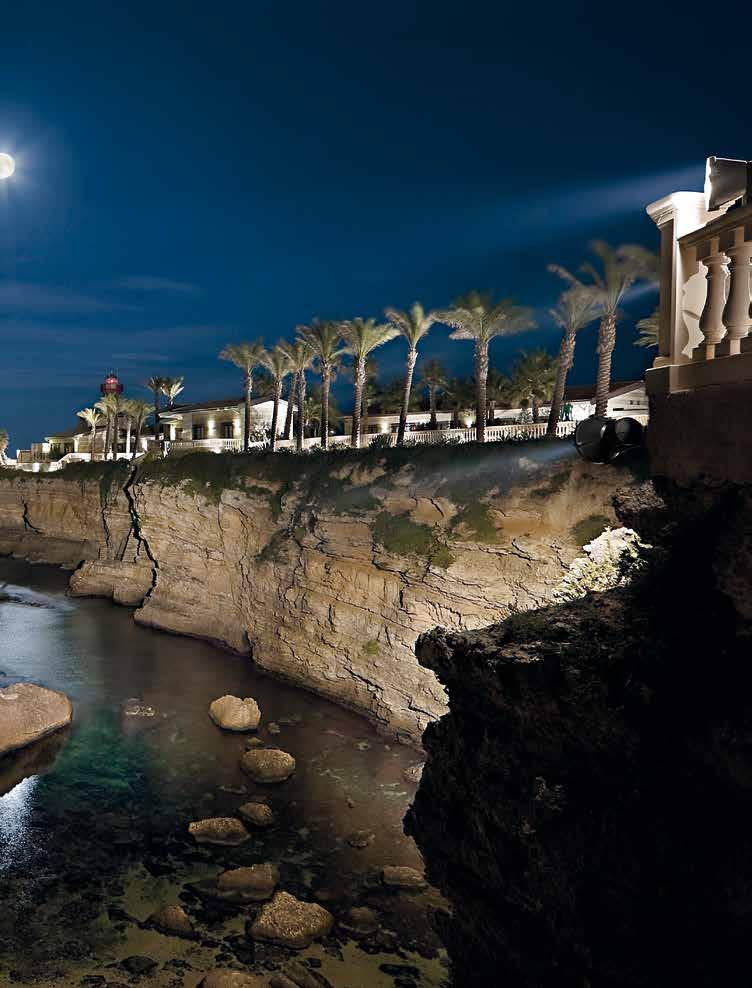
SICILIA
181
Esclusive ville sulle
ACQUE CRISTALLINE del Plemmirio con vista su Ortigia
Il Minareto sorge innanzi all’isola di Ortigia, su un promontorio bagnato dalle cristalline acque della riserva naturale del Plemmirio.
Il Resort consta di 67 camere, 19 Suites (tra cui: Panoramic Suite a strapiombo sul mare, Family Suite, Pool Suite, Jacuzzi Suite), 2 Grand Suite, 5 Ville e 3 Grand Ville.
Tutte le camere sono distribuite in riservati ed esclusivi Cottage circondati e protetti da una lussureggiante vegetazione mediterranea che fa da cornice ad un panorama dominato da mare e cielo.
Tutti gli ospiti del Minareto potranno decidere di farsi coccolare dalla soffice sabbia bianca della riservatissima spiaggia; immergersi nelle limpide acque della scogliera; rilassarsi a bordo piscina o vivere un’esperienza enogastronomica scoprendo i ristoranti e bar del resort.
Tutti i professionisti potranno ideare le proprie strategie all’interno di confortevoli sale riunioni ed illustrare le proprie idee nella spaziosa sala congressi (420 posti a sedere); potranno decidere di curare la propria immagine usufruendo della moderna palestra o semplicemente rilassarsi nelle spaziose sale massaggi.
EXCLUSIVE VILLAS ON THE CRYSTAL CLEAR WATERS OF PLEMMIRIO AND WITH A VIEW OF ORTIGIA

The Minareto is located right in front of the island of Ortigia, on a promontory in the midst of the crystal-clear waters of the Plemmirio Nature Reserve.
The Resort consists of 67 rooms, 19 Suites (including Panoramic Suite overhanging the sea, Family Suite, Pool Suite, Jacuzzi Suite), 2 Grand Suite, 5 Villas and 3 Grand Villas. All the rooms are in reserved and exclusive cottages scattered around the luxuriant Mediterranean grounds: a splendid setting dominated by the sea and the sky. Guests in the Minareto can decide to let themselves be pampered by the soft white sand of the reserved beach, relax beside the pool or delight in gastronomic experiences in the resort’s restaurants and bars.
Businessmen will find the ideal inspiration for new strategies in the resort’s meeting rooms and enjoy putting forward their ideas in the spacious congress room which can seat 420. They can also choose to perfect their image using the modern gym or, more simply, relaxing in the large massage rooms.
182
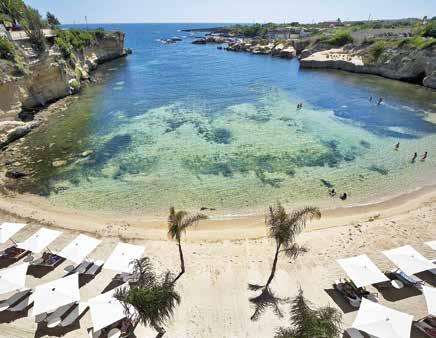

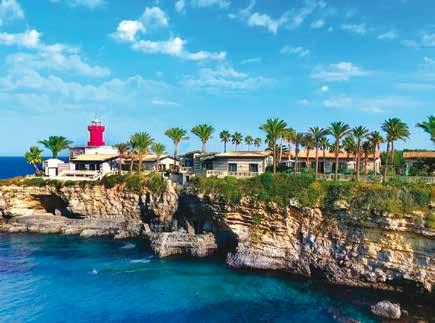


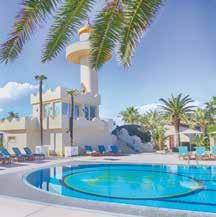

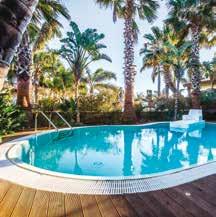
183

MIRAMARE THE PALACE HOTEL un viaggio dei sensi attraverso i profumi e i sapori della Riviera dei Fiori a journey of the senses through the aromas and flavors of the Flowers Riviera SANREMO 184
Miramare The Palace Hotel

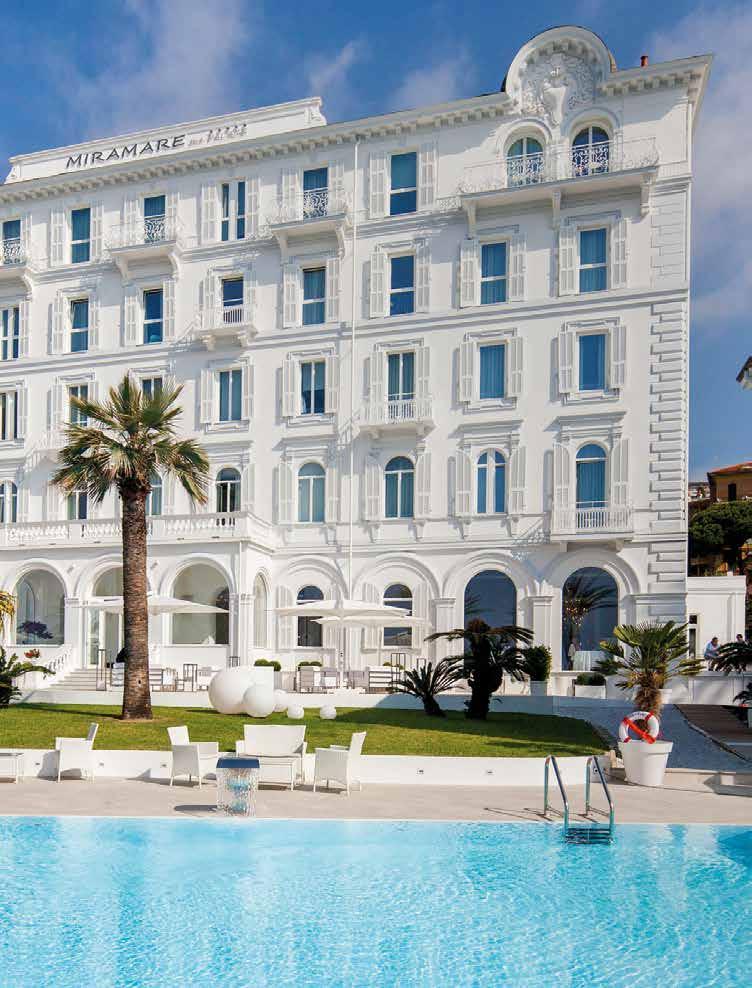
185 LIGURIA
IL LUSSO di essere se stessi
Il fascino di una grande dimora, senza tempo, per una struttura di origini antiche, dal 1870, un edificio bianco, dalle linee solide ingentilite da morbidi decori in pura Art Nouveau. Prospiciente alle spiagge del Golfo di Sanremo, il Miramare The Palace Hotel di Sanremo mostra verso il mare un candido bianco Liberty illuminato dal sole del Ponente Ligure. Ambienti ricchi di storia, che dopo un’accurata ristrutturazione hanno preservato l’elegante atmosfera “fin de siécle”. Il parco lussureggiante di alte palme secolari, è un piccolo paradiso dove ascoltare la natura. Un luogo ideale per il relax, che al tramonto si trasforma nel cuore di una serie di eventi che animano la location. La piscina a sfioro riscaldata, rappresenta un continuum visivo fra il terrazzo, il mare e il cielo azzurro. Il Ristorante offre un’esperienza gastronomica indimenticabile. Un viaggio dei sensi attraverso i profumi ed i sapori della Riviera dei Fiori. La colazione continentale a buffet servito e all’inglese, è una tentazione golosa dei pasticceri con le prelibatezze per stupire anche i palati più delicati. Un mood moderno in un’atmosfera carica di fascino ed eleganza, che trasmette agli ospiti prestigio ed armonia. Un servizio professionale e puntuale che si unisce al calore familiare dell’accoglienza conferendo al Miramare The Palace Hotel di Sanremo una personalità vincente.
THE LUXURY OF BEING YOURSELF
The charm of a large dwelling, a building of ancient, from 1870, a white building with solid lines gentled by soft decors in pure Art Nouveau. Overlooking the beaches of the Gulf of Sanremo, The Miramare The Palace Hotel in Sanremo shows a canded white light illuminated by the sun of the western Ligurian Riviera. Environments are rich of history, after a careful renovation they preserve the elegant “fin de siécle” atmosphere. The luxuriant park of tall old palms is a small paradise, where you can listen the nature. An ideal place for relaxation, which at sunset turns into the heart of a series of events that animate the location. The heated infinity pool is a visual continuum between the terrace of the sea and the blu sky. Continental served buffet and english breakfast is a delicious temptation of our confectioners with delicacies to amaze even the most delicate palates. The Restaurant offers an unforgettable gastronomic experience. A journey of the senses through the scents and flavors of the Flowers Riviera. A modern mood in an atmosphere full of charm and elegance, which transmits prestige and harmony to guests. A professional and punctual service that combines with the familiar warmth of the welcome giving Miramare The Palace Hotel in Sanremo a winning personality.
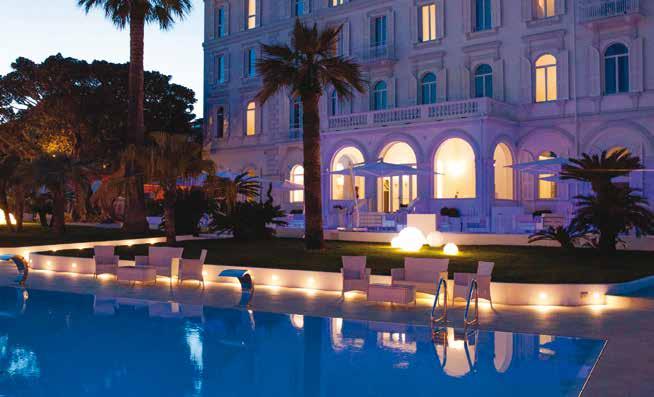
186
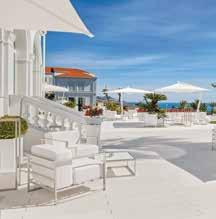
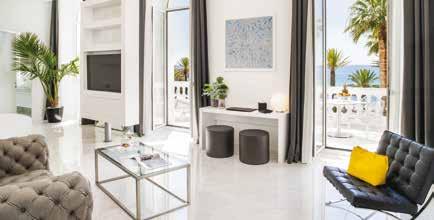

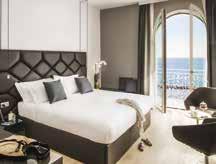


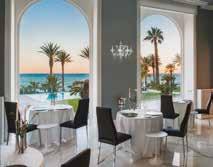
187
DAMA un sogno per gli occhi a feast for the eyes
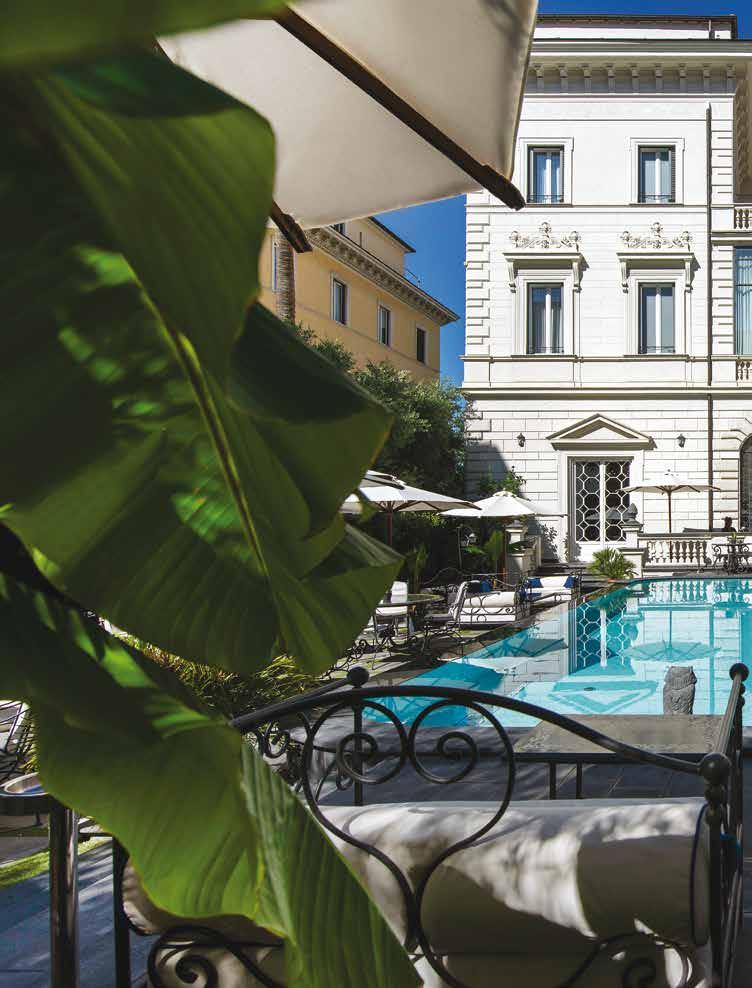
PALAZZO
ROMA
Palazzo Dama

LAZIO
189
RESIDENZA NOBILIARE dal design contemporaneo
Palazzo Dama, 5 stelle nel cuore di Roma occupa gli spazi dell’antica dimora della famiglia Malaspina, tutt’ora proprietaria del Palazzo. A pochi passi da Piazza del Popolo, Palazzo Dama coniuga l’agio di una residenza patrizia alla sorpresa di un design fortemente contemporaneo: 29 camere e suite, disposte su tre piani, dai toni del blu avion, verde salvia e tortora con lucenti dettagli e complementi d’arredo in ottone, aree comuni pensate per agevolare i contatti, il giardino privato con la piscina, dove la privacy è garantita da ulivi e limoni che delimitano l’intero perimetro. Fiore all’occhiello è PACIFICO, il brand del celebre Chef Jaime Pesaque, che sceglie Palazzo Dama per portare a Roma il suo sofisticato menu peruviano-nikkei: una cucina unica, ricca di suggestioni e contaminazioni, cui si aggiunge una carta alternativa e disponibile tutto il giorno, giocata su sapori internazionali. Il Bar, che ricalca lo stile eclettico dell’albergo, propone cocktail signature da degustare in spazi unici, illuminati dagli chandelier originali dell’Hotel Plaza di New York e circondati da preziose opere d’arte in un’alcova di pura estetica. Ad ottobre 2022 è inoltre stata inaugurata la nuova SPA con percorso benessere firmata Angelo Caroli.
ARISTOCRATIC HOME AND CONTEMPORARY DESIGN
Palazzo Dama, the 5 star hotel in the heart of Rome occupies the ancestral home of the Malaspina family, who have retained their ownership of the building. A stone’s throw from Piazza del Popolo, Palazzo Dama combines the comfort of an aristocratic home with surprisingly striking contemporary design: 29 rooms and suites on three floors, decorated in shades of avion blue, sage green and taupe with glittering brass detailing and furnishings, communal areas designed to facilitate interaction, the private garden with a swimming pool, where guests’ privacy is ensured by olive and lemon trees that surround the entire perimeter. A special news of 2017 is that the Chef Jaime Pesaque has chosen Palazzo Dama to bring his celebrated culinary project in Rome with his brand PACIFICO. In addition to the Peruvian-Nikkei menu, Chef Pesaque signature proposes an alternative with international flavors in an all day menu.
The Bar, which reflects the hotel’s eclectic style, offers signature cocktails to enjoy in unique spaces lit by the original chandeliers that once hung in New York’s Hotel Plaza, while surrounded by valuable works of art in this hideaway characterized by pure aesthetics. October 2022 saw the opening of the new SPA with wellness path signed by Angelo Caroli.

190
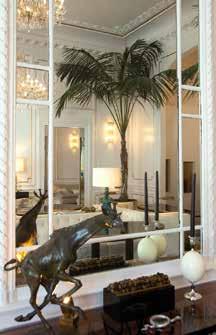
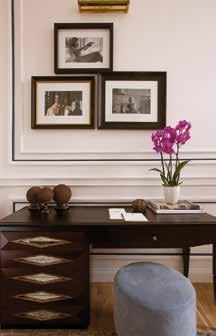





191
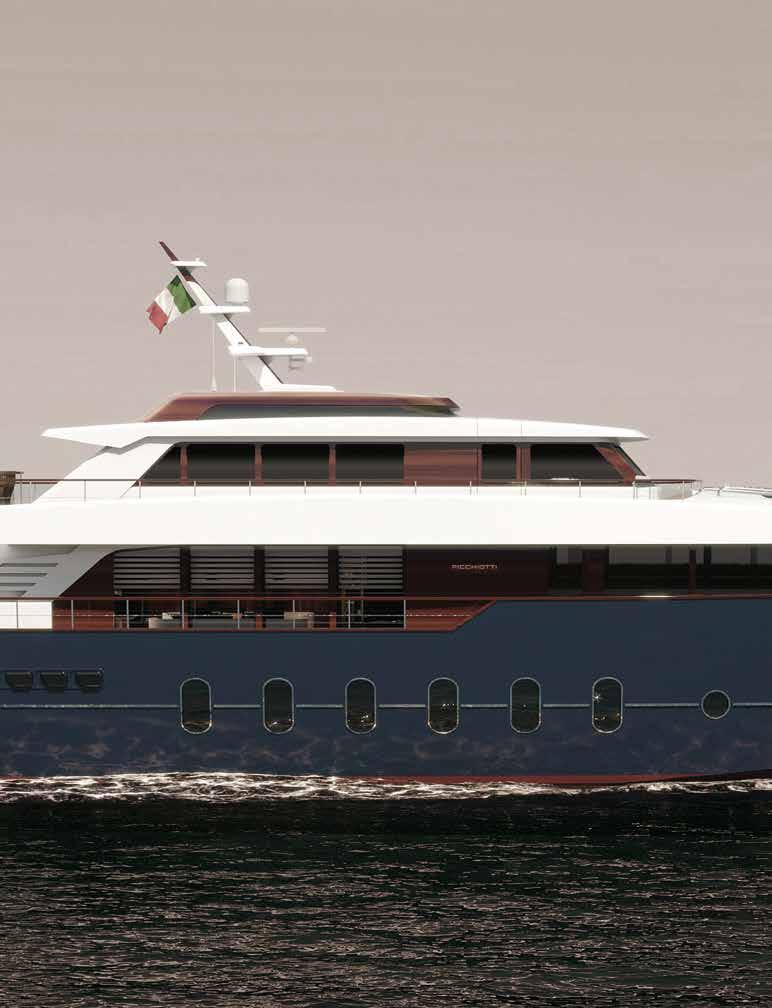

L’ATELIER LIVERANO & LIVERANO Noi non facciamo solo abiti, facciamo cultura ” “
Un’insegna tradizionale, una piccola porta che dal 1960 si apre su un universo inaspettato di storia, di dettagli e di perfezione un fantastico museo che brulica di vita e di lavoro. Un piccolo mondo aperto al mondo. È così che l’atelier Liverano & Liverano, dal cuore di Firenze, in Via dei Fossi 43, si fa ponte tra la più prestigiosa, rinomata e tradizionale sartoria fiorentina e il veloce, volubile e affascinante mondo della moda. “Noi non facciamo solo abiti, facciamo cultura”. Sta in questa frase l’orgoglio e la visione del Maestro Antonio Liverano. Che a 85 anni ancora taglia i tessuti per i suoi prestigiosissimi clienti internazionali, guida il suo team di giovanissimi sarti e gestisce un laboratorio di confezione sartoriale. Tramanda una saggezza antica. Non è il sarto che fa giacche e abiti seguendo quello che dice il cliente, ma il creatore di un’esperienza che deve essere ogni volta ineguagliabile, e perfino straordinaria, nella sua originalità creativa della scoperta di tessuti, di forme e di colori nella quale è “tutto ciò che si è, e che si vuole essere, ogni giorno, nella società, in famiglia, al lavoro o anche, semplicemente, bevendo un caffè”. Una realtà non rara ma unica al mondo, artigianale nel senso più nobile della parola e al tempo stesso di respiro internazionale, nella quale ogni nuova generazione porta avanti con forza, esperienza e inesauribile immaginazione l’arte del fatto a mano. È il prodotto sartoriale italiano sempre più ricercato accanto a una nuova collezione di abiti e giacche “sportive”. Un prêt-à-porter sempre più personalizzabile, in termini di tessuti e di misure e di tutte le possibilità e necessità che la vita propone e ripropone, interpretando le esigenze del cliente. Che “invitiamo a venire a parlare con noi, a toccare di persona con le sue mani ciò che lavoriamo e che l’atelier veste da capo a piedi, sempre su misura della sua umanità, scegliendo insieme quello che noi gli insegniamo che è il meglio per lui, abbinando la giusta camicia, il tessuto di cravatta, il fazzoletto, la bretella, il calzino e la scarpa”. È il segreto che rende Liverano & Liverano senza eguali. Perché a ogni realtà non basta essere solo irripetibile ma deve essere un’eccellenza di stile e total look in cui la tradizione non va mai fuori moda, diventa un gusto internazionale, adorato e imitato nelle forme e nei colori. Colori che solo Liverano osa tirare fuori dalle persone e dai tessuti. Una essenza che, si dice, non è raccontata mai abbastanza. Ma che forse, anche per questo, è quello che vuole e deve essere: unica.
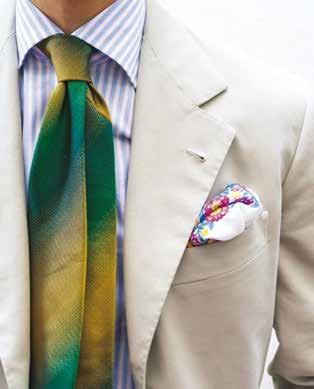
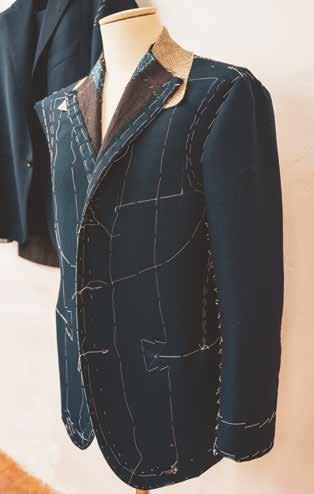
195
ATELIER LIVERANO & LIVERANO “WE DON’T JUST MAKE CLOTHES, WE CREATE CULTURE”

A traditional signpost, a small door that since 1960 opens onto an unexpected universe of history, attention to detail and perfection, a fantastic museum that is teeming with life and activity. A small world open to the world. This is how atelier Liverano & Liverano, from the heart of Florence, in Via dei Fossi 43, has become a bridge between the most prestigious, renowned and traditional Florentine tailoring and the fast, changing and fascinating world of fashion. “We don’t just make clothes, we create culture”. This statement encapsulates Master Antonio Liverano’s pride and vision. At the age of 85, he still cuts fabrics for his prestigious international customers and leads his team of young tailors, running a tailor workshop. He is the purveyor of ancient wisdom. He isn’t a tailor who sews jackets and garments merely following the customer’s instructions, but he creates an experience that must always be unique, and even extraordinary, with creative originality in the choice of fabrics, shapes and colours in which the customer is “everything that he is and that he wants to be, every day, surrounded by his family or society in general, at work, or even, simply, drinking coffee”. It is an approach that is not just rare but actually unique in the world, hand-crafted in the noblest sense of the word and at the same time international in scope, in which each new generation carries out the art of handmade production with strength, experience and inexhaustible imagination. It is Italian tailoring, a progressively soughtafter product alongside a new collection of sport jackets and suits. An increasingly customisable prêt-à-porter, in terms of fabrics and sizes and all the possibilities and needs that life offers and proposes, interpreting the needs of the customer. A customer who “we invite to come and talk to us, to discover our clothes in person, and try out how they can dress him from head to toe, always tailored to his personality, choosing together what we see as the best for him, combining the right shirt, the fabric of the tie, the handkerchief, the braces, socks and shoes”. This is the secret that makes Liverano & Liverano peerless. Because a unique approach is not enough. There must also be excellence, in style and the total look, where tradition never goes out of fashion. It becomes an international taste, adored and imitated in cuts and colours. Colours that only Liverano dares to use on people and in fabrics. An essence that, it is said, you can never get enough of. But that perhaps, also for this reason, is what is wanted and must be: unique.

196
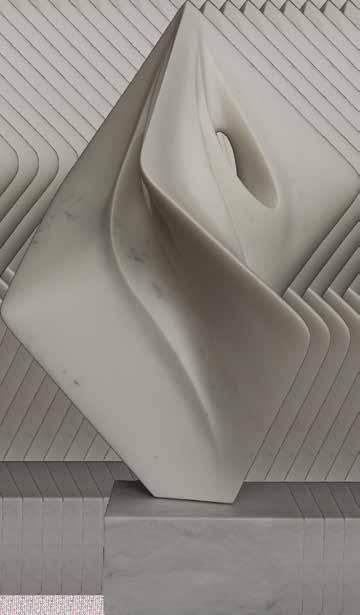


PALAZZO MANFREDI l’apice del lusso romano the height of roman luxury ROMA
Palazzo Manfredi

LAZIO
IL LUSSO al suo apice
Nel centro storico di Roma sorge Palazzo Manfredi Small Luxury Hotel, esclusiva dimora storica costruita nel XVII secolo, la sola a godere di una vista incomparabile sul Ludus Magnus, il Colosseo, i Fori Imperiali e la Domus Aurea. Palazzo Manfredi è stato, in passato, sede del casino di caccia della famiglia Guidi. Alla posizione unica e vista mozzafiato, l’hotel unisce un’ospitalità di lusso che si traduce in eleganti camere, suite e Grand View Colosseum Suites, dove arredi dal design contemporaneo si affiancano ad opere d’arte e dipinti antichi risalenti al XVI secolo. Fiore all’occhiello della dimora è la splendida e suggestiva Terrazza AROMA che ospita l’omonimo Ristorante stellato, affidato all’executive Chef Giuseppe Di lorio. The Court, posizionato al 49° posto nella nuova classifica Top 500 Bars 2021, è il cocktail bar con esclusiva vista sul Colosseo e Ludus Magnus fra le più prestigiose della capitale. La location è meta imperdibile per gli amanti del bere miscelato. Tra drink di ultima generazione e tecniche innovative eseguite dai bartender più famosi in Italia, negli spazi ai piedi dell’hotel, identificati con il famoso “Ludus Magnus”, la “Grande Palestra” della Roma imperiale diventa oggi la corte internazionale del beverage per un’esperienza al limite dell’alchimia.

ULTIMATE LUXURY LIFESTYLE
Palazzo Manfredi is an elegant hideaway in the center of what was once imperial Rome. The charming 17th century palace has spectacular views of the Colosseum, the Forum, and the Domus Aurea, combined with superb hospitality. Palazzo Manfredi was the hunting pavilion of the Guidi gardens. Today it is tastefully adorned with art ranging from 16th century antique paintings to contemporary pieces. The hotel offers an intimate experience, crowned only by a meal at the hotel’s Aroma restaurant where the unparalleled vistas of ancient Rome are beautifully matched by the culinary delights of the Michelin star Executive Chef Giuseppe Di lorio. The Court - the new Cocktail Bar inside Palazzo Manfredi, with a unique view of the Coliseum, one of the world’s wonders, the most prestigious address in Rome - offers a wide range of innovative drinks with revolutionary techniques by some of the most famous Italian mixologists, right in front of the “Ludus Magnus”, the largest Gladiator training camp in the Antique Rome now dubbed the “most exclusive location for innovative mixology”, where the bartender almost becomes an alchemist.
200

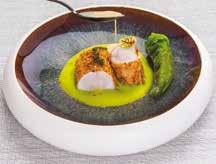
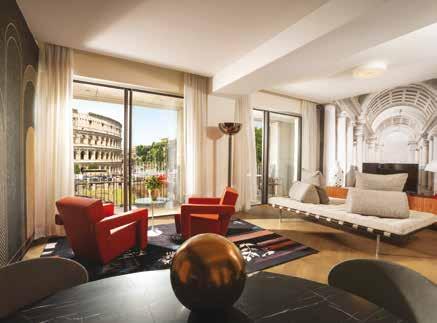
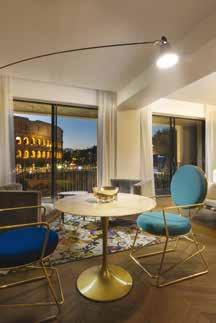
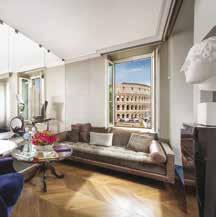

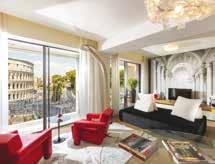
201
centro storico di Roma in central Rome

PALAZZO SCANDERBEG nel
ROMA 202
Palazzo Scanderbeg

LAZIO
203
ACCOGLIENTE, esclusivo e riservato
Palazzo Scanderbeg è una residenza del XV secolo situata nel centro storico di Roma, a soli due passi dalla famosa Fontana di Trevi. Per molti anni sede del Museo della Pasta, Palazzo Scanderbeg fu costruito nel 1466 dal Principe albanese e Re d’Epiro Giorgio Castriota, detto Scanderbeg, eroico condottiero distintosi nella lunga guerra contro l’espansione ottomana in difesa della Cristianità. Grazie ad un accurato restauro, l’antica residenza nobiliare è, ad oggi, la soluzione ideale per i viaggiatori che desiderano una casa lontano da casa, godendo di comfort e servizi di alto livello. Il Palazzo si articola intorno ad un cortile nel quale è presente una fontana con mascherone, elemento decorativo da cui sgorga l’acqua e si affaccia su una piazzetta che sembra uno scenario teatrale e proietta l’ospite nella vita a volte vibrante, a volte sonnolenta, ma sempre suggestiva della Città Eterna. È composto da 11 esclusivi appartamenti disposti su 4 piani, il più grande dei quali misura 166 mq, ognuno con caratteristiche uniche: dalla cucina completamente attrezzata dove preparare piatti tipici romani e raffinati ad ampi salotti per vivere un soggiorno indimenticabile; dalla torretta wellness con doccia emozionale e funzione hammam alla terrazza privata dalla quale godere il clima mite e la luce incomparabile della Città Eterna.

WELCOMING, LUXURIOUS AND EXCLUSIVE
Palazzo Scanderbeg is a residence from the XV century located in the heart of Rome, just two-minute walk from the famous Trevi Fountain. For many years it was home to the Italian Pasta Museum and was originally built in 1466 by the King of Epirus George Castriota, known as Scanderbeg. Castriota was an heroic commander who distinguished himself in the long war against the Ottoman expansion in defense of Christianity. Due to a thorough refurbishment, this ancient noble residence is today the ideal solution for travelers who desire a home away from home, while enjoying all comforts and high-end services. The structure is built around a courtyard with a gargoyle shaped fountain from which water flows. The Palazzo overlooks on a small square which resembles a theatrical scenario and delights the guest in the life which is sometimes vibrant, sometimes sleepy but always suggestive of the Eternal City.
It consists of 11 exclusive apartments on 4 floors, the largest of which measures 166 square meters (1786 square feet) but each with unique characteristics: from the wellness tower suite featuring an hammam emotional shower to a private terrace from which enjoy the mild climate and the incomparable light of the city. Fully equipped kitchens to cook typical Roman dishes and refined large living rooms to experience unforgettable stays also characterize this exclusive property.
204
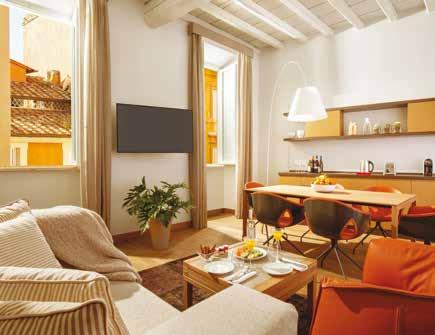




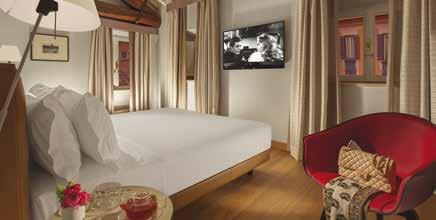
205
ANTONIO SIGNORINI
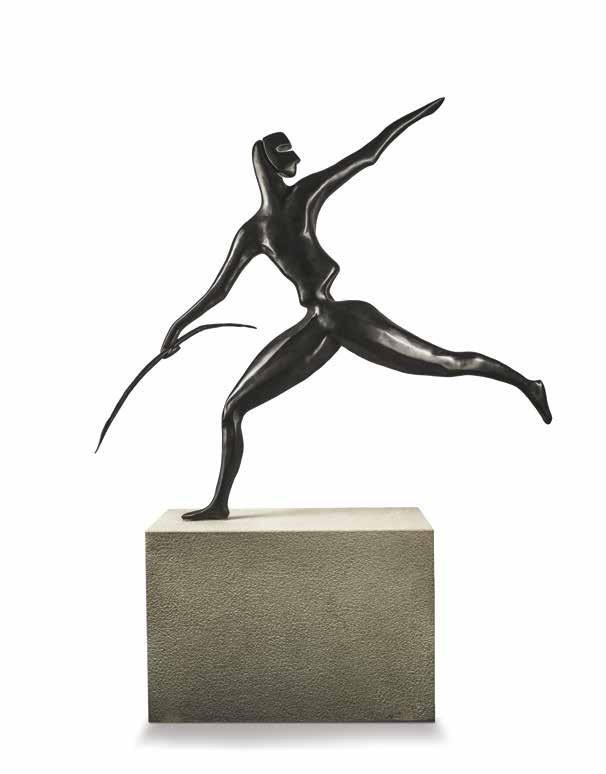
Dall’archeologia all’incanto
206
di/by: Giulia Filiè photo: Nicola Gnesi
Per meglio comprendere l’essenza dell’opera di Antonio Signorini, viene immediato citare cosa hanno scritto di lui gli architetti Ettore Mocchetti e Alessandro Ubertazzi, i curatori della mostra collettiva organizzata da Oblong Contemporary Gallery a Milano in occasione della settimana del Design 2021:

“Chi si incanta di fronte a una scultura di Antonio Signorini percepisce immediatamente che l’artista ha frequentato il misterioso e suggestivo mondo dell’archeologia: come esperienza diretta nei luoghi di scavo e di conservazione delle opere del lontano passato dell’uomo, e come desiderio di approfondire la storia, di proiettarla verso il futuro in un continuum
ininterrotto. Le opere di Signorini, il loro modellato che reinventa, stilizzandoli, i capolavori delle antiche civiltà testimoniano non solo della volontà di dare vita a una sorta di archeologia contemporanea, ma pure di una costante ricerca del senso dell’arte quale officina di bellezza per dimostrare capacità di modellare la materia, e come occasione per restituire, trasformati, i saperi accumulati”.
Artista di origine italiana, Antonio Signorini inizia uno studio approfondito dell'arte primitiva nel 2003. Le sue ricerche lo portano a visitare i siti archeologici europei e medio orientali, in particolare le regioni libiche, il Saudi Arabia e le grotte irachene che stimolano in lui un profondo interesse per i ritrovamenti archeologici più
207
antichi e ne sollecitano la creatività. L’artista si interroga su quel passato artistico. I disegni e i graffiti rappresentati all'interno delle grotte lo conducono a tradurre quei messaggi in sculture sottolineandone il processo creativo atemporale, infinito. Mentre la sua ricerca si dipana fra Europa e Mesopotamia, inizia a sviluppare le prime opere scultoree note come “The Warriors”. Scaturiti come miraggi dalle grotte della Libia sahariana, dal Regno dell'Arabia Saudita e da alcune regioni interne dell’Algeria, i “Guerrieri” si susseguono uno dopo l’altro come un antico racconto la cui narrazione usa il linguaggio figurativo, il segno tridimensionale e prende la sua forma attraverso l’arte, diventando simbolo dell’umanità tutta. I guerrieri sono guardiani del nostro Patrimonio culturale. Di ciò che condividiamo come uomini. Essi si schierano a difesa dei valori dell’umanità tutta. Segue e completa “The Warriors” un’altra serie scultorea, “The Dancers”. Le danzatrici per Signorini sono forza assoluta. La loro lotta per l’esistenza non necessita di armi. È una danza

che attraversa lo spazio, una musica antica che ne ripercorre la storia.
L’interesse dell’artista intorno agli archetipi non è però il solo protagonista della sua ricerca espressiva. Il suo studio, infatti, ruota sempre intorno al movimento, una perenne sfida alla forza di gravità. La vita non è grave, né gravosa. È proprio questa ricerca di leggerezza ad essere il cuore della collezione “The Flying Horses”. La vita è danza, lotta, corsa, movimento. Ogni cavallo vola, sfida la gravità proponendosi in un equilibrio impossibile: non necessitano punti di appoggio se c’è assenza di peso. Meteore provenienti da luoghi sconosciuti che attraversano galassie incuranti della materia che dà forma ma non sostanza ai loro corpi. L’artista per riuscire nella sua opera deve divenire ingegnere e architetto. Annullare il peso significa conoscerlo, ma non farsene carico. Signorini, attraverso le sue opere, racconta gli stilemi di antiche civiltà che si proiettano nell’oggi da un tempo passato dirigendosi verso l’avvenire: danzatrici, guardiani, cavalli, prendono forma
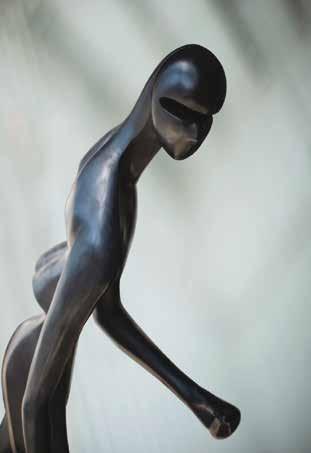
208
The Warriors
The Warriors
nello spazio, ma senza occuparlo in una leggerezza incorporea.
Signorini afferma, “L'arte è sempre contemporanea perché non tiene conto della convenzione del tempo che gli uomini hanno stabilito numerandolo. Le opere considerate “antiche” se fanno ancora parte dell’attuale, della vita di ciascuno di noi, sono sempre contemporanee. E questo vale per tutto ciò che continua a essere parte dell’attuale. Possiamo infatti ammirare opere di Michelangelo che conversano con l’architettura futuristica di Singapore. Questo intendo per contemporaneità dell’arte. I disegni di migliaia di anni fa mi hanno ispirato. Perché sono ed esistono nell’oggi. La necessità di quegli antichi uomini di scrivere le loro vite, di lasciare traccia del loro passaggio, di cercare risposte a questioni essenziali, rimangono ancora punti nodali della nostra esistenza. Il gesto artistico diviene un ricamo nel tessuto della vita, una pennellata in un quadro senza fine. Come gli antichi corriamo e combattiamo le nostre difficoltà, tra equilibrio e slancio, tra ostacoli e strettoie disegnando quadri inediti senza nemmeno accorgercene” . Signorini ama sperimentare ed esplorare sempre nuovi strumenti espressivi. Lavora secondo le maniere e gli strumenti dell’arte antica e si occupa personalmente di modellare le cere ed eseguire le patine delle sue opere. Non trascura mai la ricerca di tutti i materiali che utilizza. Predilige il bronzo, materiale eterno, da sempre forgiato dall’uomo, occupandosi anche della ricerca di leghe speciali come, ad esempio, quella particolare da lui utilizzata per opere esposte negli Emirati Arabi Uniti o un nuovo tipo di patina bianca creata appositamente per alcuni “Flying Horses”: una innovativa vernice per ceramica che si assorbe all’interno dei pori del bronzo e li sigilla. Ora l’artista si trova impegnato in una nuova ricerca: intende coniugare due materiali essenziali nella scultura ma tra loro antagonisti: il bronzo e il marmo.
Quella di Signorini è arte che intreccia tecnica, architettura e ingegneria. Equilibrio e forma, armonia e disarmonia, l’impossibile del movimento che l’artista stesso definisce “un rischio assoluto” . Tecnicamente complesse, le sue sculture sono un azzardo e una sfida alla gravità. Come asserisce il curatore Luca Beatrice “Nelle sue opere Antonio Signorini si pone fin da subito la questione di come riuscire a restituire corpo e sostanza a
una forma senza appesantirla, donandole leggerezza; per questo motivo le sue sculture si caratterizzano per essere figure sottili e ieratiche”.
Durante l’estate 2022 Forte dei Marmi ha ospitato la mostra “Attraverso”, un’esibizione di opere monumentali inedite che ha consentito all’artista di combinare, in modo esemplare, il lavoro creativo e il lavoro ingegneristico esito di molti anni di sperimentazione. Patrocinata dal Comune di Forte dei Marmi in collaborazione con la Galleria Oblong Contemporary Gallery attiva in Italia e a Dubai, la mostra ha visto l’esposizione di opere che sfidano la gravità. La città di Firenze ospiterà e celebrerà l’artista toscano con una mostra a cielo aperto che si svolgerà dall’8 ottobre 2022 al 31 gennaio 2023. Opere inedite di oltre 5 metri vedranno “Guerrieri” e “Danzatrici” correre e ballare nelle piazze del capoluogo toscano. Due ‘Cavalli Volanti’ di 10 metri ciascuno accompagnati da altre opere completeranno un itinerario artistico e culturale dedicato alla città.
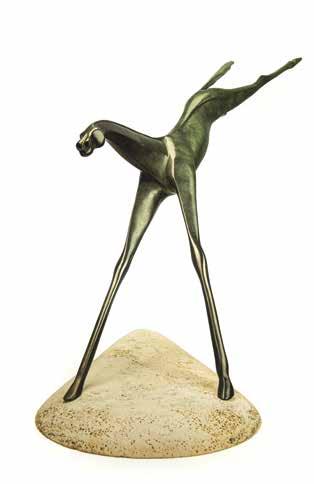
209
The Flying Horses
ANTONIO SIGNORINI From archaeologyto enchantment
To better understand the essence of Antonio Signorini, one cannot help think of what architects Ettore Mocchetti and Alessandro Ubertazzi have written about him, when they curated a group exhibition at Oblong Contemporary Gallery for Design Week 2021:
“To stand enchanted before a sculpture by Antonio Signorini is to immediately understand that the artist is familiar with the mysterious and evocative world of archaeology. He has direct experience at digs, and with the conservation of works of the distant past. He wishes to deepen history, to project it into the future in an uninterrupted continuum. Signorini’s works have a sense of shape that reinvents and stylizes the masterpieces of ancient civilizations, showing not only the will to bring forth a sort of contemporary archaeology, but also a constant search for the sense of art as a laboratory - one which generates beauty, demonstrates skillful modeling of materials, offering the opportunity to restore accumulated knowledge in a transformational way”.
Antonio Signorini is an artist of Italian origin. He began his in-depth study of primitive art in 2003. His research took him to archaeological sites throughout Europe and the Middle
East. Regions of Libya, Saudi Arabia, and caverns in Iraq, in particular, stimulated his profound interest in the most ancient archaeological finds, and spur his creativity. Through his work, Signorini asks himself questions about the art of the past. The drawings and carvings inside the caves lead him to translate those messages into sculpture, highlighting the timeless and infinite nature of the creative process. While his research proceeded in spaces across Europe and Mesopotamia, he began creating his first works known as “The Warriors”. Originating as mirages from the caves of the Libyan Sahara, Saudi Arabia, and certain parts of Algeria, “The Warriors” follow one another as in an ancient tale told with figurative language. The gestures are three dimensional and take their shape through the artwork, becoming symbols of all humankind. The warriors are guardians of our cultural heritage, of all that we share as human beings. They are standing up to defend the values of all humanity. Signorini followed “The Warriors” with another sculptural series, “The Dancers”. For the artist, the dancing figures represent absolute energy. Their struggle for existence
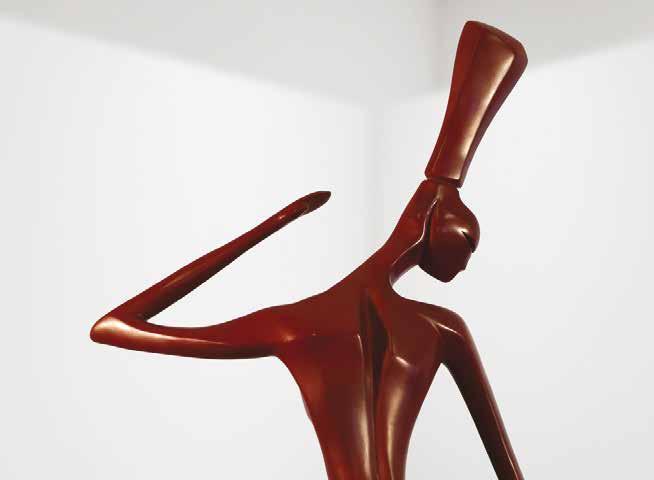
210
“The Dancers”
requires no weapons. It is a dance that moves through space, accompanied by ancient music threading through the story. Signorini’s interest in archetypes is not the only major theme in his expressive search. In fact, his study is oriented around movement, and is a perennial challenge to the force of gravity. Life is neither difficult nor burdensome. This search for lightness is at the heart of the collection “The Flying Horses”. Life is a dance, a fight, a race - movement. Each horse flies, and in so doing defies gravity and suggests an impossible balance. They require no supports if there is no weight. They are meteors coming from unknown places which cross galaxies, oblivious to the material that gives their bodies shape, but not substance. Signorini has had to become both engineer and architect in order to produce this work. Abolishing weight means recognizing it, but not assuming responsibility for it.
Through his work, Signorini narrates the various stylistic features of ancient civilizations which project themselves into our times, headed toward the future: dancers, watchmen, and horses take shape in space, with an intangible lightness that does not occupy space.
According to Signorini, “Art is always contemporary, because it does not keep track of time conventionally, as humans have done by numbering it. Artworks that are considered ‘ancient,’ if they are still part of our present, and part of our lives, will always be contemporary. This goes for everything that continues to be part of the present.
We can admire the works of Michelangelo, which are in dialogue with futuristic architecture in Singapore. This is what I mean by the contemporary nature of art. Drawings from thousands of years ago have inspired me. Because they exist today. The need of ancient humankind to write their lives, to leave traces of their passage, to seek answers to essential questions - these remain keystones of our own existence. The artistic act becomes an embroidering of the fabric of life, a brushstroke in a never-ending painting. The same as people in antiquity, we run and fight off our problems, from equilibrium to impulse, through obstacles and difficult situations, creating original works without even realizing it”.
Signorini loves to experiment with and explore new expressive tools. He works with ancient techniques and instruments and is personally involved in sculpting the wax models and applying patinas to his work. He researches every material he uses. His preference is for bronze, an eternal material, forged by humans throughout history. He is also interested in special types of alloys, such as the one used to create the works he has shown in the United Arab Emirates. He created a new type of white patina expressly for some of the “Flying Horses” - an innovative varnish for ceramics that is absorbed into the pores of the bronze, sealing it. The artist is now at work on a new project that will combine
two essential sculptural materials which are opposites: bronze and marble.
Signorini’s art interweaves technology, architecture, and engineering. Balance and shape, harmony and discord - the impossible nature of movement that he describes as “a total risk”. His sculptures are technically complex, a gamble, a challenge to gravity. As curator Luca Beatrice has observed, “Antonio Signorini’s works ask, How does one restore body and substance to a figure without weighing it down? How to preserve its lightness? His sculptures are characterized by their slenderness and their solemnity”.
During the summer of 2022 Forte dei Marmi hosted the exhibition "Through," an exhibition of never-before-seen monumental works that allowed the artist to combine, in an exemplary way, creative work and engineering work the outcome of many years of experimentation. Sponsored by the Comune of Forte dei Marmi, in association with Oblong Contemporary Gallery (Italy and Dubai), the exhibition consisted of monumental works that defy gravity. The city of Florence will host and celebrate Signorini, a Tuscan artist, with an open air exhibition from 8 October 2022 to 31 January 2023. New monumental works in excess of 5 meters in height will bring the “Warriors” and “Dancers” to run and dance in various piazzas of the Tuscan capital. Two “Flying Horses,” each over 10 meters in height, will accompany other works, creating an artistic and cultural itinerary dedicated to the city.
The exhibited works represent Signorini’s work in full flower, from a formal standpoint. They are the product of his consideration of numerous and diverse social and cultural stimuli, which have been brought together over a long period of time, inextricably linked to Signorini’s own biography.

211
“Through” exhibition in Forte dei Marmi


Mercedes-AMG SL 63 4MATIC+: WLTP combined cycle. Emissions CO2 (g/km): 283-294; Combined cycle consumption (1/100 Km): 12.5-13.0. Official Sales and Service Dealership Mercedes-Benz CASALECCHIO DI RENO - Via del Lavoro, 50 - T. 051.19936600 FERRARA - Via Trasvolatori Atlantici, 4 - T. 0532.067700 staremilia.penskeautomotive.it

VIA BAGUTTA, 28 • MILAN • ITALY • PH. +39 02 76319049 • RENECAOVILLA.COM
SANT’ANDREA LUXURY SUITE HOTEL & SPA un luogo destinato a rimanere nel cuore a place destined to remain in the heart

PRAIANO PICCOLO
214
Piccolo Sant’Andrea

Luxury Suite Hotel & SPA

CAMPANIA
215
LUSSO E RELAX in un panorama mozzafiato
Il Piccolo Sant’Andrea, hotel 5 stelle a Praiano in Costiera Amalfitana, non è un semplice hotel: è un luogo magico destinato a rimanere nel cuore e nei ricordi di chi lo sceglie per una vacanza. Un angolo di paradiso nella roccia, sospeso tra il blu del mare e l’azzurro del cielo dove l’aria ha il profumo inebriante dei fiori di zagara. Il panorama è mozzafiato e comprende l’intero litorale che va da Praiano a Positano, continuando fino a Punta Campanella, all’Arcipelago Dei Galli, per arrivare infine al profilo dell’Isola di Capri. Raffinate, informali ma sofisticate, le camere e le suite sono dotate di tutti i comfort e di una vista unica nel suo genere. Al loro interno, il bianco è il colore predominante ma viene spezzato da tonalità accese date da dettagli come i tessuti colorati, tipici della Costiera Amalfitana, per creare qualcosa di unico a metà fra le tradizioni locali e un design moderno. Il percorso spa con la spaziosa ed elegante piscina interna è un’unicità in Costiera. Fiore all’occhiello del Piccolo Sant’Andrea è il Ristorante: grazie alla creatività dello Chef Alessio Inno, con esperienze pluristellate, è un vero ambasciatore del territorio.
LUXURY AND RELAX IN A BREATH-TAKING PANORAMA
Il Piccolo Sant’Andrea, a 5-star hotel in Praiano, on the Amalfi Coast, is more than just a hotel: it’s a place destined to remain in the heart and in the memory of those who choose it for their holidays. A corner of paradise perched on a rock, suspended between the blue sea and the azure sky, where the air has the heady scent of orange blossoms. The panoramic view is breathtaking, encompassing the whole coast that goes from Praiano to Positano, continuing to Punta Campanella, the Archipelago Li Galli (Sirenusas) and going up to the profile of the island of Capri. Refined, informal and yet sophisticated, the rooms and suites are equipped with all the comforts and offer a unique view. Inside the rooms, white is the main colour, its predominance broken by bright hues in details fabrics, typical of the Amalfi Coast, to create something unique halfway between local traditions and modern design. The spa experience with the spacious and elegant indoor swimming pool, is a uniqueness on the Amalfi Coast. The jewel in the Piccolo Sant’Andrea is its Restaurant: thanks to the creativity of the Chef Alessio Inno, with multi-starred experiences, he is a true Ambassador of the territory.
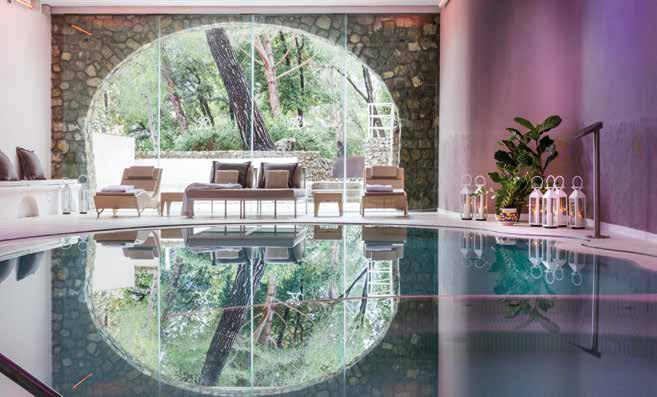
216

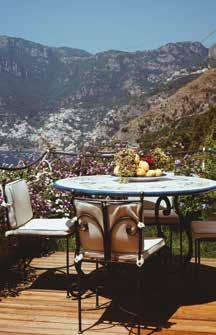
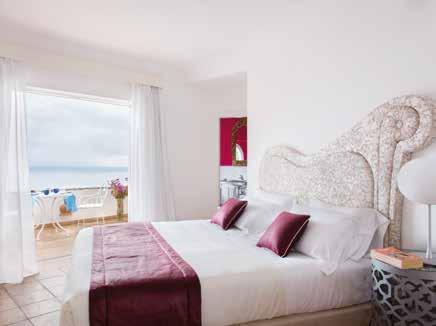
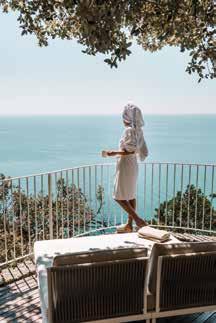



217
spettacolo naturale dei Faraglioni

natural spectacle of the Faraglioni

HOTEL PUNTA TRAGARA lo
the
CAPRI
Punta Tragara
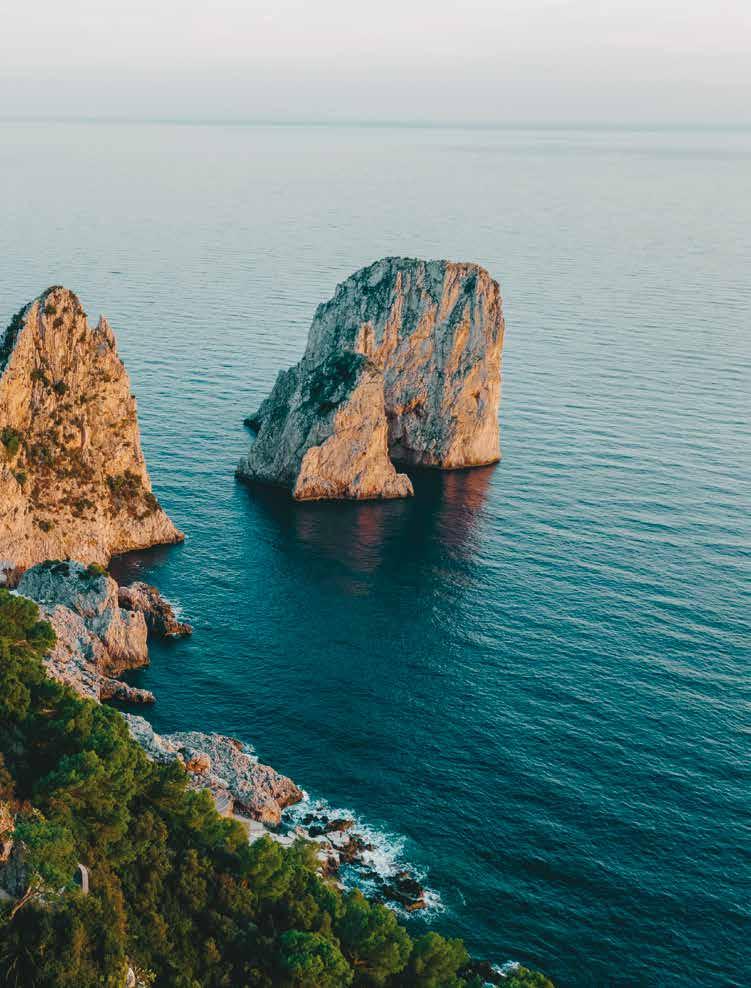
CAMPANIA
BELLEZZA INCOMPARABILE, sulla cima del mondo
Tra gli scorci più suggestivi dell’isola, a picco sul mare, vi è Punta Tragara, dove sorge l’omonimo boutique hotel della Manfredi Fine Hotel Collection: una villa mediterranea che sembra scolpita nella roccia, celebre per la sua posizione panoramica e per l’accoglienza di charme. Lo spettacolo naturale dei Faraglioni, il fascino di Marina Piccola, il bianco profilo di Capri, la luce dell’alba che accarezza il mare, la rossa quiete del tramonto dalla bellezza incomparabile. Questo è il panorama incantevole che è possibile ammirare dalle terrazze di Punta Tragara. La villa fu commissionata dall’imprenditore Vismara al celebre architetto Le Corbusier negli anni 20, che la immaginò come “una specie di fioritura architettonica, un’emanazione della roccia, una filiazione dell’isola, un fenomeno vegetale”, e divenne ben presto una della strutture più iconiche dell’intera isola. A pochi minuti dalla storica Piazzetta di Capri, la villa offre una privacy pressoché assoluta ed uno stile di grande raffinatezza in cui gli echi della storia si coniugano con i colori e i profumi del Mediterraneo. Le volte, gli arazzi ed i mosaici raccontano la storia della villa e si uniscono armoniosamente al gusto contemporaneo di un interior design dallo stile eclettico, tra ceramiche tradizionali e fantasie mediterranee in sintonia con la magnificenza
del paesaggio circostante. L’offerta è completata dai due ristoranti dell’hotel, Le Monzù e Mammà - quest’ultimo situato a pochi passi dal “salotto del mondo”, la famosa Piazzetta - e dalla GILI Wellness Area, un’oasi dove concedersi massaggi, rituali di benessere e bellezza.
INCOMPARABLE BEAUTY, ON TOP OF THE WORLD
Originally designed as a grand Mediterranean Villa in the 1920s by legendary French-Swiss architect Le Corbusier, the property is seemingly sculpted out of rock with salmon-hued terracotta façade, making Punta Tragara one of the most distinctive properties on the island. The hotel offers a timeless setting with every angle delighting the eye, stylish yet refreshingly down to earth. Striking architecture and traditional design elements blend perfectly together with luxury furnishings and contemporary pieces of art, along with touches of marble woven throughout. The views from Punta Tragara are endless: the spectacular Faraglioni rocks, enchanting Marina Piccola, the white contours of Capri, the wonderful light of dawn embracing the sea and the quietly romantic sunsets. On-site, Le Monzù Restaurant and Mammà Restaurant offers the quintessence of Mediterranean cuisine a few steps from Piazzetta. The Gili Wellness Area & Hair Boutique offers a large variety of massages, manicure, pedicure and hair salon.

220
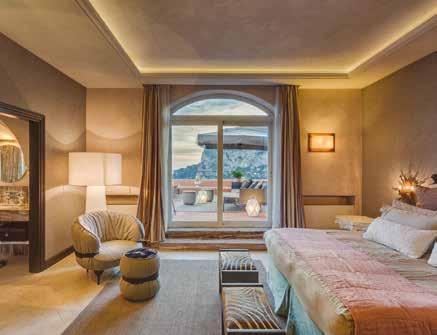




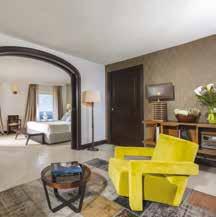

221
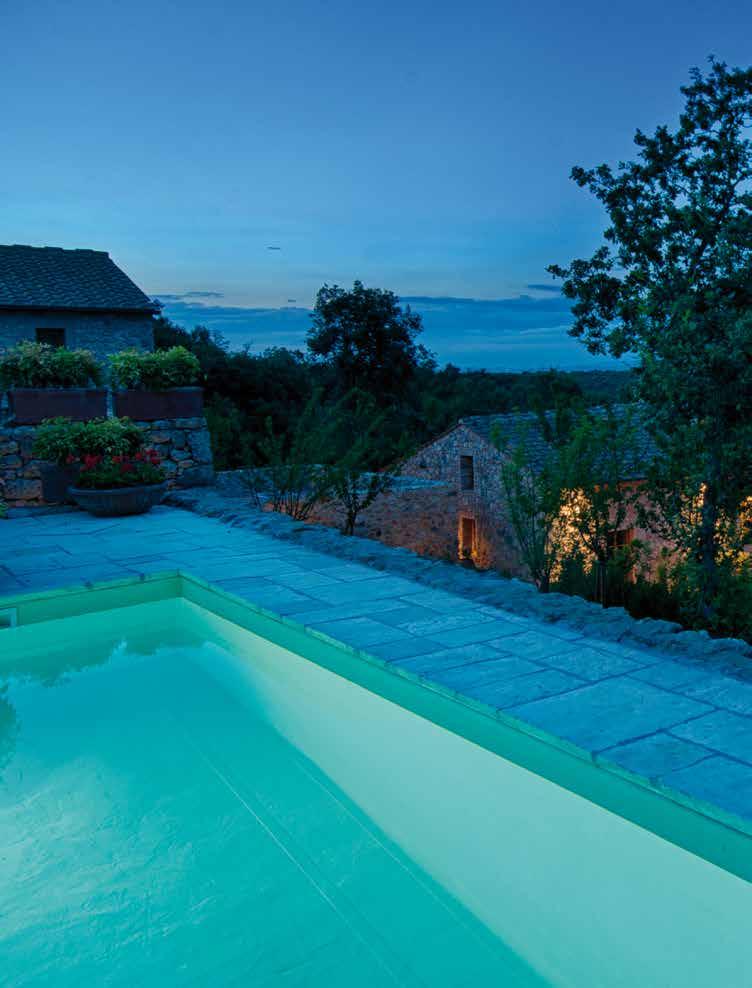
RELAIS LA COSTA meravigliosa Residenza d’Epoca dell’anno Mille a wonderful Historical Residence of the year 1000 SIENA 222
Relais La Costa


TOSCANA
223
L’ARTE DELL’ACCOGLIENZA In uno scenario da sogno
Cuore, Testa, Corpo. Silenzio e relax totale, lontano dalla frenesia quotidiana, vicino alle esigenze degli ospiti: questo è Relais La Costa. Una meravigliosa Residenza d’Epoca dell’anno Mille, punto di ristoro per i pellegrini sulla Via Francigena sin dal Medioevo. Oggi il relais dona un’esperienza unica ai suoi ospiti suscitando le stesse emozioni che nei secoli hanno riempito gli animi dei viandanti. Sensazioni di completa rigenerazione dei sensi in uno dei contesti più seducenti in assoluto. Il verde dei lecci, l’azzurro del cielo, la raffinatezza dello stile architettonico e il fascino della pietra millenaria, abbracciata dal bosco privato di 50 ettari, fanno risaltare il legame de La Costa con la vocazione di un luogo nato per offrire ospitalità. Il trionfo di storia e natura completato dalla vista spettacolare su Siena regala un’emozione indescrivibile: all’orizzonte la città si staglia come un dipinto rinascimentale, tra intense sfumature boschive e dolci colline che tracciano i contorni di un paesaggio che pare fondersi con il cielo. Ampie suite, Spa Intima ed esclusiva, piscina esterna con vista e avvolgenti profumi e sapori tipici della cucina toscana serviti nel ristorante del relais rendono questo luogo unico per rigenerare il proprio essere.
THE ART OF HOSPITALITY IN A DREAMY SCENERY
Heart, mind & body. Silence and total relaxation, far from the daily frenzy, close to the needs of guests: this is Relais La Costa. A wonderful Historical Residence of the year 1000, a refreshment point for pilgrims on the Via Francigena since the Middle Ages. Today the relais offers a unique experience to its guests, arousing the same emotions that have filled the hearts of travelers over the centuries. Sensations of complete senses regeneration in one of the most seductive contexts ever. The green of the holm oaks, the blue of the sky, the refinement of the architectural style and the charm of the millennial stone, embraced by the 50-hectare private wood, highlight the connection of La Costa with the vocation of a place born to offer hospitality. The triumph of history and nature, completed by the spectacular view of Siena, offers an indescribable feeling: on the horizon the city stands out like a Renaissance painting, between intense woody hues and rolling hills that trace the outlines of a landscape that seems to merge with the sky. Spacious suites, intimate and exclusive Spa, outdoor pool with views, enveloping aromas and typical flavors of Tuscan cuisine served in the restaurant of the relais make this place unique to deeply regenerate.

224


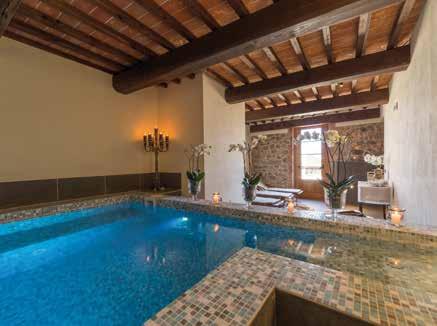

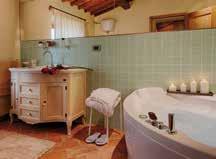



225
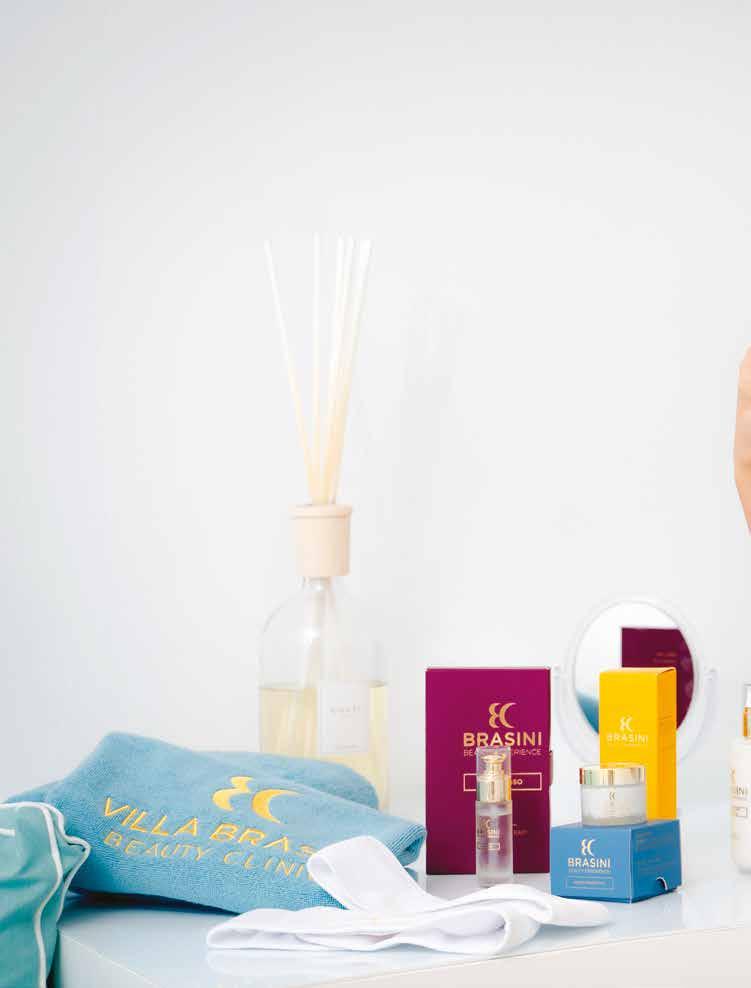
VILLA BRASINI
Virginia Zullo

BEAUTY CLINIC l’eccellenza al servizio della bellezza , di/by:
V
illa Brasini Beauty Clinic è un progetto imprenditoriale di successo nell’estetica e nella bellezza. Nato dall’idea della Dottoressa Diletta Siniscalchi, apre la sua prima sede a Roma per poi diffondersi nelle più importanti città italiane - Napoli, Milano, Forte dei Marmi - e nel Principato di Monaco.


La forza del progetto, in grande espansione grazie anche a diversi investitori, è l’eccellenza dei servizi e l’utilizzo di macchinari d’avanguardia - tra cui la criolipolisi per il trattamento delle cellule adipose, l’emsculpt utile a definire i muscoli, tonificare e bruciare i grassi ed il CFU lifting non chirurgico, adatto sia al viso che al corpo - che permettono di soddisfare le esigenze di ogni cliente. I centri Villa Brasini Beauty Clinic sono specializzati in medicina estetica, laserterapia, chirurgia plastica, dermatologia, tricologia e nutrizione. Grazie alla collaborazione con le migliori aziende, propongono le più recenti tecniche di medicina estetica per garantire ai propri pazienti trattamenti efficaci, sicuri e duraturi nel tempo. Tra i servizi più richiesti, la radiofrequenza, gli ultrasuoni, il Nir, la rimozione dei capillari, la carbossiterapia, l’epilazione definitiva e la rimozione dei tatuaggi, ma anche trattamenti per il viso, dalla cura delle cicatrici causate dall’acne alla rimozione delle macchie.
Con NERO Lifestyle abbiamo voluto approfondire i motivi di questo successo intervistando Diletta Siniscalchi.
228
Dottoressa, può raccontare ai lettori di NERO Lifestyle come nasce la sua idea imprenditoriale che gira tutt’intorno al mondo della bellezza?
L’idea di Villa Brasini nasce da me e da mio marito Riccardo Scifo, anche lui imprenditore nel settore sanitario. La prima clinica nasce a Roma nel 2015 in un ambiente ricercato e curato, in un edificio di pregio storico e architettonico denominato “Villa Brasini” in zona Ponte Milvio, una delle più esclusive della città. Avevo deciso di aprire una mia clinica che rispecchiasse me stessa e la mia visione della bellezza ma soprattutto che mantenesse sempre il paziente al centro. Offriamo a 360 gradi tutti i servizi che riguardano la cura e il benessere in modo che i pazienti si sentano seguiti nel raggiungimento dei loro obiettivi. Credo questa sia stata la carta vincente che ci ha permesso in poco tempo di replicare Villa Brasini Beauty Clinic con successo in altre città.
Da una laurea in biologia alla medicina estetica, come è accaduto?
Ho iniziato a lavorare per Alma Lasers, una delle aziende più importanti al mondo nei laser medicali, prima come product specialist, poi come formatrice per i medici e poco dopo ho seguito la gestione di una clinica affiliata, ed è stato proprio lì che ho capito che cosa avrei voluto fare da grande! Ascoltare le necessità dei pazienti, creare protocolli specifici per ognuno di loro, ancora oggi sono le cose che mi appassionano maggiormente e che mi hanno spinto alla decisone di fare qualcosa di mio.
Quanta importanza date all’interior design, all’illuminazione e all’arte nell’ambiente in cui vengono eseguiti i trattamenti?
Sono fondamentali! Tutte le nostre cliniche sono arredate con gusto ed eleganza, non si respira di certo l’idea di clinica ma piuttosto di un posto accogliente e piacevole.
Cosa è la bellezza per lei? Ho sempre pensato che la bellezza stia nel mantenere le proprie caratteristiche semplicemente esaltandole. Ho cercato di improntare le nostre tecniche verso il “non invasivo” ed è proprio per questo che sono sempre alla ricerca di nuove tecnologie che possano dare risultati duratori in tempi brevi.
Di solito mi documento osservando cosa viene proposto all’estero, dove su alcune cose sono più avanzati rispetto all’Italia. Quando trovo qualcosa di interessante lo
sperimento su di me per provare e vedere che risultati si ottengono, non proporrei mai ai miei pazienti qualcosa di cui non sono pienamente convinta.
Da un anno ho creato anche una linea di creme che potesse soddisfare le esigenze di tutti coloro che non possono raggiungermi nelle mie cliniche, per avere ottimi risultati anche a casa.
La sua clientela è molto esigente e sappiamo che molte donne dello spettacolo si rivolgono a Villa Brasini Beauty Clinic, ci può fare qualche nome?

Tra le più famose Belen Rodriguez, Chiara Ferragni, Melissa Satta, donne bellissime che mantengono la loro identità di bellezza. Anche molti uomini però si sono avvicinati al mondo dell’estetica e frequentano le nostre cliniche.
Quale è la sua filosofia di approccio al cliente?
Il cliente è al centro di tutto, studiamo protocolli specifici che comprendano la medicina estetica, la nutrizione e l’utilizzo dei macchinari laser per risultati più immediati e poco invasivi.
Quanto è importante l’etica nella chirurgia estetica?
Molto. Ormai si abusa della chirurgia sia da parte dei pazienti che dei chirurghi stessi che è come se perdessero il senso del buon gusto. La vera bellezza è quella naturale, la medicina estetica è solo un aiuto a mantenerla più a lungo possibile.
229
VILLA BRASINI BEAUTY CLINIC, EXCELLENCE AT THE SERVICE OF BEAUTY
Villa Brasini Beauty Clinic is a successful venture in the field of aesthetics and beauty. Born out of the idea of Dr Diletta Siniscalchi, its first clinic was opened in Rome and from there spread to Italy’s most relevant cities - Naples, Milan, Forte dei Marmi - and in the Principality of Monaco. The strength of the project, currently undergoing an intense expansion also thanks to several investors, is the excellence of the services provided and the use of state-of-the-art equipment, including cryolipolysis for the treatment of adipose cells, Emsculpt, used to define muscles, tone and burn fat, and nonsurgical lifting CFU, suitable for use on the face and on the body - which can meet the requirements of any customer.
The Villa Brasini Beauty Clinic centres specialise in aesthetic medicine, laser therapy, plastic surgery, dermatology, trichology and nutrition. Thanks to its collaboration with the best companies, they offer the most recent aesthetic medicine techniques to ensure their patients get results that are effective, safe, and long-lasting. Some of the most popular services are radio frequency, ultrasound, Nir, capillary removal, carboxytherapy, definitive depilation, and tattoo removal, but the list also includes face treatments that range from spot removal to treatment of acne scars.
With NERO Lifestyle we wanted to go deeper into the reasons for this success, in this interview with Diletta Siniscalchi.
Doctor, could you tell NERO Lifestyle readers how your entrepreneurial idea fully focused on the world of beauty was born?
The idea of Villa Brasini was mine, together with my husband Riccardo Scifo. He, too, is an entrepreneur in the health sector. The first clinic was founded in Rome in 2015, in an elegant and sophisticated venue, in a historical and architecturally relevant building called Villa Brasini, in the Ponte Milvio area, one of Rome’s most exclusive locations.
I had decided to open a clinic of my own that would reflect myself and my vision of beauty, but in particular a place that would keep patients always in the spotlight. We offer an all-round range of services involved in treatment and well-being, so that patients feel they are being followed closely in the pursue of their goals. I believe this was the successful card we played and that allowed us to replicate Villa Brasini Beauty Clinic in other cities with excellent results, in a very short time.
From a degree in biology to aesthetic medicine. How did this happen?
I began working for Alma Lasers, one of the world’s most
relevant companies in the field of medical-use laser, first as a product specialist, then as trainer for medical professionals, and soon after that I began following the management of an affiliated clinic. It was there that I understood what I wanted to do when I grew up!
Listening to the patients’ needs, creating specific protocols for each patient, are still the things that make me tick the most, and those that drove me to decide to do something by myself.
How important are interior design, lighting and art in the venues where the treatments are performed?
They are crucial! All our clinics are decorated with taste and elegance. One certainly does not feel like they’re in a clinic, but in a welcoming and pleasant place.
What is beauty, in your opinion?
I have always thought that beauty means maintaining one’s own characteristics by simply enhancing them. I have attempted to focus our techniques on non-invasive treatments, which is why I am always on the lookout for new technologies that can provide long-lasting results in a short amount of time. I usually prepare myself by observing what is currently available abroad, in some aspects things are more advanced than in Italy. When I find something interesting, I try it on myself to see how it feels and to observe the results achieved. I would never offer anything to my patients that I am not fully convinced works. In the past year I also created a line of creams that could fulfil the needs of all those who cannot come personally to my clinics, so they can get excellent results in their own homes.
Your clientèle is very demanding and we know that many showbiz women are habituées of Villa Brasini Beauty Clinic. Can you drop us some names?
Some of the most famous are Belén Rodriguez, Chiara Ferragni, Melissa Satta, incredibly beautiful women who maintain their beauty identity. But there are also many men who have inched closer to the world of aesthetics and come to our clinics.
What is your philosophy when approaching a client?
We put clients in the centre of everything. We study specific protocols that include aesthetic medicine, nutrition and the use of laser machines, for more immediate and less invasive results.
How important are ethics in aesthetic medicine?
Very much. Today surgery is abused by patients and by surgeons alike. It seems that people have simply lost their good sense and good taste. True beauty is natural beauty. Aesthetic medicine is just a little helping hand, to make it last as long as possible.
230

231
 Cerrado
Cerrado
PIQUADRO BECOMES CARBON NEUTRAL

Our main goal is to create a better future for the next generations. Every day we are building it. Today for tomorrow. We measure our impact, then we take actions to reduce and offset it by supporting certified emission removal projects as reforestation of degraded forests. As a result, we have achieved carbon neutrality within our operations as the Piquadro Group for our FY 21/22 emissions. (Scope 1 and 2)
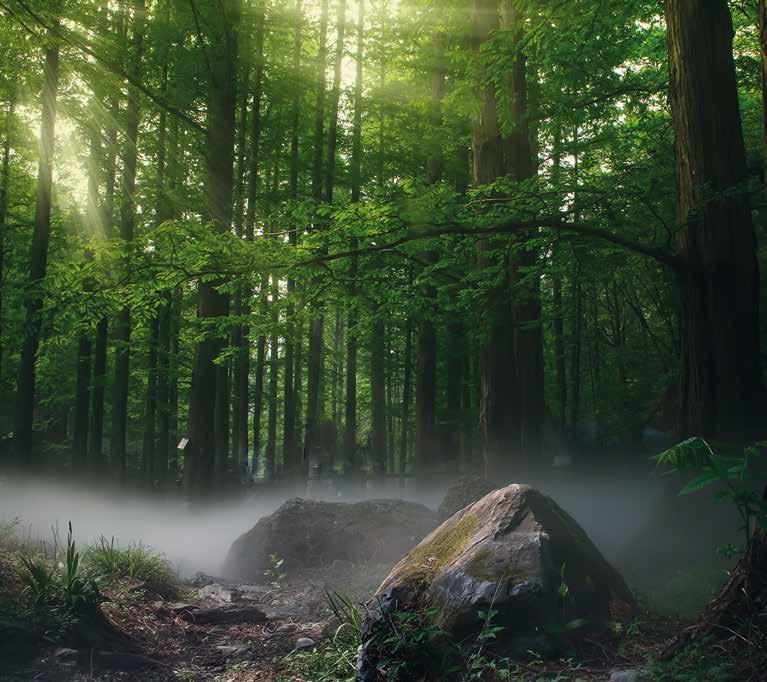
233
Bioma
Brasil
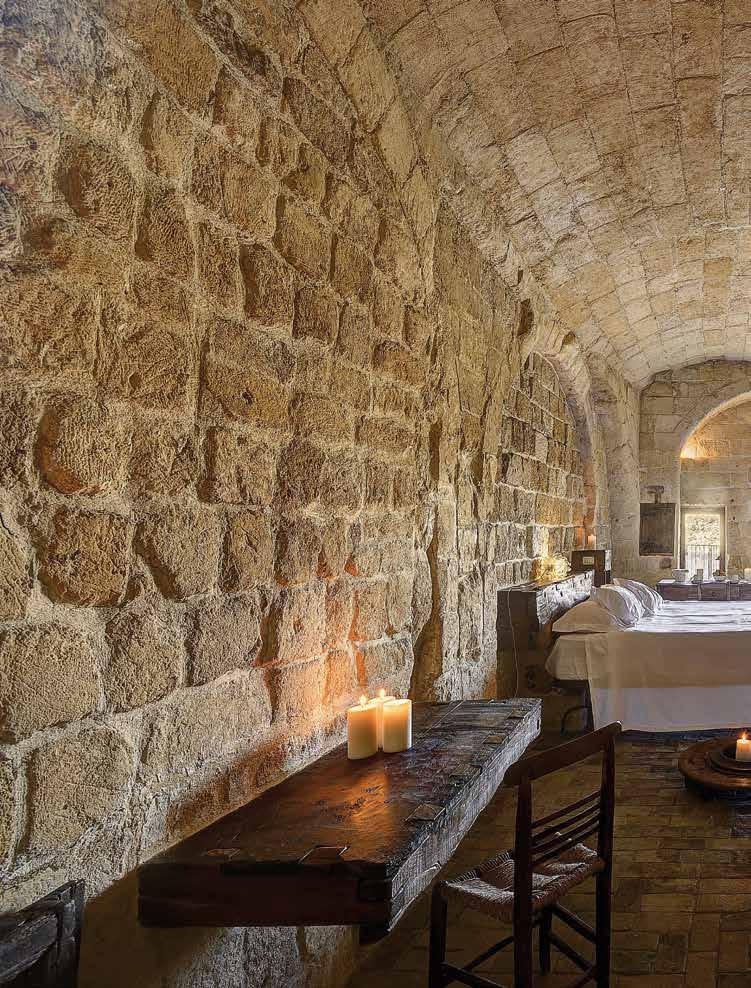
MATERA SEXTANTIO LE GROTTE DELLA
CIVITA
un’esperienza di ospitalità irripetibile an unforgettable experience
of
hospitality
Sextantio
Le Grotte della Civita

BASILICATA
TRA LE PIÙ STRAORDINARIE destinazioni al mondo
Le Grotte della Civita, all’interno dei Sassi di Matera - Patrimonio dell’Umanità UNESCO dal 1993 - è un progetto ricettivo nato per proporre un’esperienza di ospitalità irripetibile, non classificabile in stelle e lontana da qualsiasi concetto tradizionale di lusso: il New York Times lo ha giudicato tra le più straordinarie destinazioni al mondo, il Times tra i dieci alberghi più belli del panorama internazionale e la guida Tatler di Condé Nast l’ha inserito tra i cento alberghi più belli del pianeta. A strapiombo sul fiume Gravina, di fronte alla drammatica scenografia del Parco della Murgia, sorge una struttura alberghiera unica, con diciotto stanze all’interno di enormi grotte, caratterizzate da un restauro conservativo estremo, utilizzando unicamente materiale secolare di recupero, dai pavimenti agli arredi, fino alla biancheria, proveniente dagli antichi crolli nuziali. Inoltre, per coerenza ai principi che hanno ispirato il progetto nelle stanze non sono previsti televisori e frigobar. La struttura, che ha una capienza complessiva di quaranta ospiti, si sviluppa su tre livelli, collegati da uno scalone e da un sistema di terrazze dalle quali si accede indipendentemente alle singole stanze.
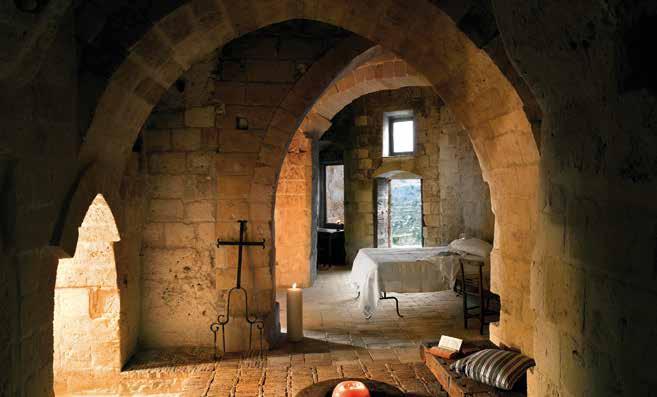
ONE OF THE MOST EXTRAORDINARY DESTINATIONS IN THE WORLD
Le Grotte della Civita, into the Sassi of Matera - UNESCO World Heritage Site since - were conceived with the intention of offering a unique hospitality experience which cannot be classified in stars and which is far from any traditional concept of luxury: the New York Times judges it to be one of the most extraordinary destinations in the world, the Times considers it one of the 10 most beautiful hotels of the international panorama and Condé Nast’s Tatler guide has placed it among the one hundred most beautiful hotels on the planet. Overhanging the river Gravina and looking out onto the dramatic scenery of the Parco della Murgia, it is a unique hotel structure with eighteen rooms built inside ancient caves and it is characterized by preservative restoration using exclusively centuries-old salvaged materials, from the floors to the furnishings. Even the linens come from antique wedding dowries. In coherence with the principles which have inspired the project, there are no televisions or frigobars in the rooms. The structure, with a capacity of forty guests, plays out on three levels connected by a stairway and by a system of terraces from which each room can be entered independently.
236

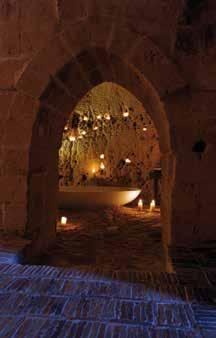






237
SIKELIA


personalizzata
and personal
PANTELLERIA
un’accoglienza attenta e
the warm
welcome
Sikelia


SICILIA
DETTAGLI RAFFINATI di eleganza contemporanea

Suite raffinate ospitate in antichi dammusi, in cui convivono architetture interne dal rigore monacale e raffinati dettagli di eleganza contemporanea: questo è il Sikelia, luogo esclusivo senza tempo, sinonimo di lusso e tranquillità, capace di accompagnare alla scoperta dei mille contrasti dell’isola di Pantelleria. Un’accoglienza attenta e personalizzata, per sentirsi avvolti da un’atmosfera di casa. Una cucina elegante e ricercata per riscoprire gli antichi gusti della tradizione contadina. Un giardino arabo, per abbandonarsi agli antichi riti della cura dell’uva e riscoprire i ritmi lenti della terra. Pantelleria, la Perla Nera del Mediterraneo, da conoscere e rispettare, con le sue rocce scure disegnate dal vento, le sue forme taglienti addolcite dalle rotondità dei bianchi dammusi, le fonti naturali di acqua calda e i fanghi rigeneranti, preziose eredità del vulcano che le diede origine. La musica del vento, che si scaglia all’improvviso sulle scogliere quasi a voler ricordare che la natura, qui, è la padrona assoluta, ma anche la miglior compagna di vita. E infine il mare, di un blu intenso, in cui perdersi e sognare. E da cui farsi raccontare storie di un’Africa più vicina di quanto mai avremmo potuto immaginare.
REFINED CONTEMPORARY ELEGANCE
Stylish suites housed in ancient dammusi dwellings bring together strict monastic interior architecture and refined contemporary elegance: this is Sikelia, an exclusive, timeless place, synonymous with luxury and tranquillity, a place to discover the many contrasts of the island of Pantelleria. The warm and personal welcome will make you feel right at home. The elegant and stylish cuisine showcases the authentic flavours of rural tradition. And the Arabic garden is a place to get lost in the ancient rituals of grape therapy and rediscover the slow rhythms of the earth. This is Pantelleria, the Black Pearl of the Mediterranean, a place to discover and respect, with its dark rocks carved by the wind, its sharp forms softened by the roundness of the white dammusi dwellings, its natural hot springs and rejuvenating mud, the precious legacy of the volcano from which the island originated. The music of the wind crashes dramatically on the cliffs, as if to remind us that here, nature is the absolute master, but also a friend. And finally the sea, an intense blue, in which to get lost and dream. A sea which whispers tales of an Africa that is closer than we ever could have imagined.
240



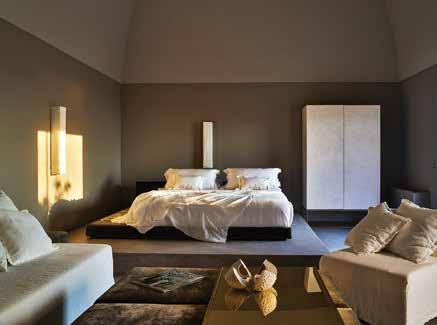


241

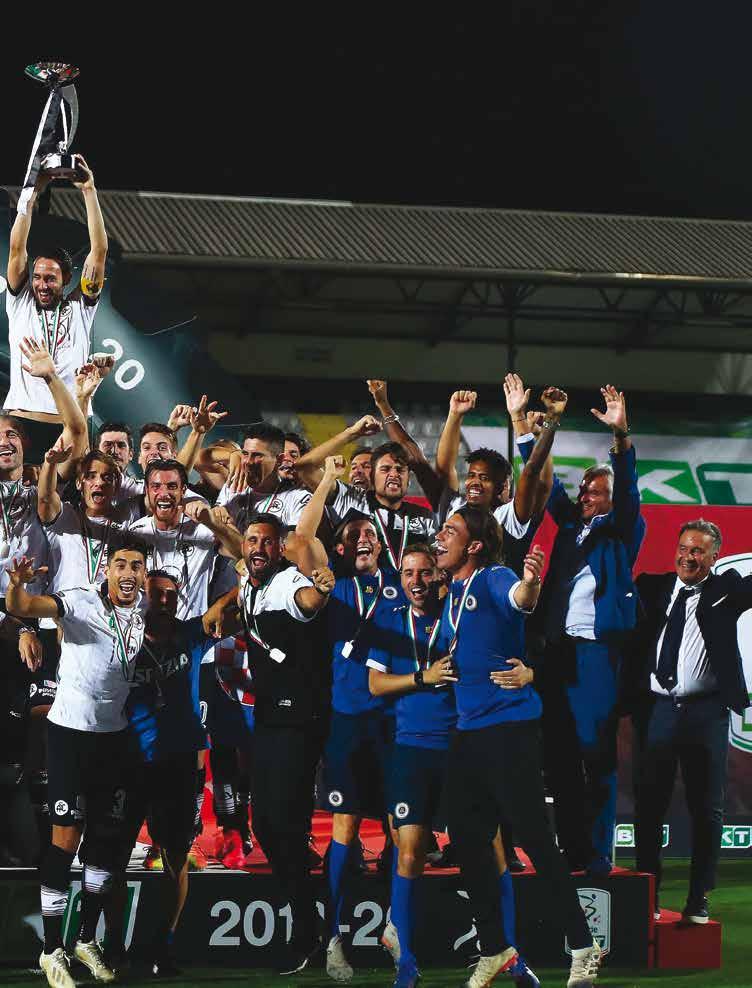
PER VOLARE IN ALTO LÀ DOVE OSANO LE AQUILE di/by: Enzo Millepiedi NERO LIFESTYLE SPONSOR DELLO SPEZIA CALCIO IN SERIE A
A
chi si chiede quale sia il segreto di una società e di una squadra come lo Spezia Calcio che non solo presidia caparbia la sua posizione nel Campionato di Serie A, conquistata tre anni fa, ma è considerata, anche dalle più blasonate, non una cenerentola di turno, che sale per improvvise fortune e che scende l’anno dopo, a rispondere sono la sua storia, il suo team di dirigenti e giocatori e la granitica passione dei suoi tifosi e di una intera comunità. Componenti che sono state determinanti nell’attrarre la famiglia di Robert Platek, come lui stesso ebbe a spiegare quando, il 15 maggio del 2021, acquisita la proprietà da Gabriele Volpi, si presentò alla città, come sempre affiancato dalla moglie Laurie, dal fratello Philip, vicepresidente del club aquilotto, e dai figli Amanda e Robert Junior. Resta memorabile la conferenza nella quale lui, polisportivo sul campo per passione tramutata in modello di investimento, con chiarezza pragmatica delineò valori, passioni, contaminazioni, progetti, investimenti e obiettivi “per poter competere in Serie A”, confermando la sua fiducia per il club delle Aquile che era tra i cinque che - parole sue - stava osservando da tempo in Europa. Dove è proprietario del Casa Pia AC, promossa nella Primera Liga, la Serie A del Portogallo, oltre alla
proprietà di una squadra all-star di basket a New York. E si confermava acuta e avveduta, la scelta di affidare la società alla famiglia Platek dopo la promozione in Serie A, un sogno che alla Spezia si rincorreva addirittura come riscatto sul campo al riconoscimento postumo (nel 2022) della conquista dello scudetto in tempo di guerra vinto dai giocatori spezzini, sotto il nome di Vigili del Fuoco Spezia, nel campionato Alta Italia (che sostituì nel 1943-44 la Serie A) con avversario diretto il Grande Torino. Oltre all’attribuzione di questo titolo onorifico, è stata poi conferita allo Spezia la possibilità di apporre permanentemente (fatto assai raro) sulle divise sociali un distintivo speciale in ricordo di quella memorabile impresa. Fu, nonostante i tempi, l’apoteosi, nonostante i bombardamenti sulla città base navale, di una compagine fondata il 10 ottobre 1906 per iniziativa di un commerciante svizzero, Hermann Hurny, come sezione football dello Sport Club Spezia, anche se la nascita ufficiale dello Spezia Football Club è databile al 20 novembre 1911, con Francesco Corio primo presidente eletto e con Alberto Picco, il nome dato allo Stadio, consigliere-tesoriere e anche calciatore-capitano della squadra. Carriera interrotta dalla chiamata alle armi. Alberto Picco prese parte alla Prima guerra mondiale come sottotenente nel Corpo degli Alpini, e

244
morì eroicamente nella conquista del Monte Nero, sulla riva sinistra dell’Isonzo, sopra Caporetto, il 16 giugno 1915, a soli 21 anni. Alberto Picco è considerato, al pari di Cesare Battisti, uno tra i più famosi e gloriosi alpini, insignito di medaglia d’argento “motu proprio” dal Re Vittorio Emanuele III di Savoia, dopo che, in soli venti giorni di guerra, aveva già ricevuto due medaglie di bronzo. È dunque da questa storia che viene lo Spezia Calcio ed è questa storia che si intende onorare con una squadra determinata a farsi valere e della quale, come ha esortato Robert Platek, “dobbiamo essere orgogliosi”. Ma è sul cambio di mentalità che ha insistito e che insiste Platek per spronare a pensare sempre in grande, per realizzare il progetto per una società forte, obiettivo che si ottiene andando a coprire con oculatezza e intelligenza tutte le competenze che deve avere un team ambizioso. Attento all’oggi ma con lo sguardo delle Aquile che guardano e vedono dall’alto avanti e lontano. Al sogno realizzato, tre anni fa, della A, dopo anni di dura attesa e senza tentennamenti o moti di rinuncia, ce ne è uno nuovo: diventare una squadra che conquisti quella parte della classifica “dove si sta sempre bene”.
La personalità del progetto Platek prevede e consente di fare sempre meglio e sempre di più anche perché se
è vero che lo Spezia è la squadra di una città piccola è anche vero che piccola poi non è se misurata sulla straordinaria passione dei tifosi e di tutta la comunità che si sente impegnata e parte di questo progetto. Progetto al quale ha aderito, due anni fa con entusiasmo, NERO Lifestyle. È entrato nel team degli sponsor certo per la condivisione delle fortune di una comunità nella quale opera, ma anche per l’identificazione di una mentalità che sente sua, quella dei valori e delle sfide, dell’impegno e delle giuste ambizioni, delle passioni e delle competenze, e con lo sguardo rivolto all’oltre l’orizzonte. Già dal primo incontro tra Mr Robert Platek e il nostro Presidente ed editore Andrea Delfini, entrambi con la carta di identità di self made manager, non ha avuto bisogno di molte parole la condivisione di valori, di progetti e di una mentalità pragmatica dell’uomo d’affari venuto dagli Stati Uniti che Andrea Delfini conosce e vive da vicino da Vice presidente, fin dal 2015, di NIAF Italia - National Italian American Foundation - e da componente, da quest’anno, del prestigioso Board of Directors NIAF USA. E che crede nei risultati che la contaminazione tra mentalità, quella italiana e quella americana, non può che arricchire proprio per le loro diverse caratteristiche e qualità.

245
Robert Platek
TO FLY WAY UP, WHERE THE EAGLES DARE TO GO NERO LIFESTYLE SPONSORS SPEZIA CALCIO IN THE A SERIES

Have you ever wondered what is the secret of a club and of a team like Spezia Calcio, which not only stubbornly defends its position in the A Series Championship, won over three years ago, but is also considered, even by the most prestigious teams, not just a Cinderella that shoots up thanks to unexpected luck, only to plummet the year after? The answer is provided by its history, by its team of managers and footballers, and by the rock-hard passion of its supporters and of an entire community. All these components were crucial to attract the family of Robert Platek, as he himself explained when, on 15 May 2021, he acquired its property from Gabriele Volpi, and showed up in the city, always flanked by his wife, Laurie, his brother Philip, vice-president of the Eagle Club, and his sons Amanda and Robert Junior. Who will ever forget the press conference at which Platek, a multisportsman in the field thanks to a passion that was transformed into a business model, with pragmatic clarity outlined values, passions, contaminations, projects, investments and objectives “to be able to compete in the A Series”, confirming his trust in the Eagle Club, one of the five European ones on which he had been keeping an eye, in his own words. In Europe, he also owns Casa Pia AC, promoted to Primera Liga, Portugal’s A Series; he is also the owner of an all-star basketball team in New York. A
smart and successful choice, that of entrusting the club to the Platek family after its promotion to the A Series, a dream that La Spezia had pursued even as redemption, in the field, for the posthumous acknowledgement (on 2022) of the championship won in war times by the Spezia players, under the name of Vigili del Fuoco Spezia (Firefighters), in the Alta Italia championship (which replaced the A Series in 1943-1944), having the Grande Torino as its direct adversary. In addition to the attribution of this honorific title, the Spezia was then granted the rarely given possibility to permanently add to its social uniforms a special badge to remember that memorable feat. Despite the historical moment, that was an apotheosis, even with the bombings of the Navy base city, hitting a structure founded on 10 October 1906 after the initiative of a Swiss tradesman, Hermann Hurny, as the football department of Sport Club

246
Platek Family
Spezia. The official establishment of the Spezia Football Club dates back to 20 November, 1911, with Francesco Corio as first elected president and Alberto Picco, after whom the stadium was later named, as counsellor and treasurer and also footballer and team captain. His carrier was interrupted when he was drafted. Alberto Picco fought in WWI as second lieutenant in the Alpine Corps, and met a heroic death in the conquer of Monte Nero, on the left margin of the Isonzo river, above Caporetto, on 16 June, 1915 - he was only 21 years old. Alberto Picco is, like Cesare Battisti, one of the most famous and glorious Alpines, given a “motu proprio” silver medal by King Vittorio Emanuele III of the Savoy, after he had already been granted two bronze medals in only twenty days of war. It is from this history that comes Spezia Calcio, and this is the story that is to be honoured with a team determined to hold its own and which, as Robert Platek himself stated, “we should be proud of”. But Platek has insisted on a change of mindset, to manage to think always big, to successfully carry out the project of a strong team, a goal that can be obtained by covering with prudence and intelligence all the skills necessary for an ambitious team. Mindful of today, but also with the Eagles’ eye view, looking and seeing up and far ahead. After the dream that came true three years ago - that of the A series -, after years of hard waiting and without hesitations or even a glimpse of surrender, Spezia Calcio now has a new one:
becoming a team that conquers that part of the ranking “where one is always fine”. The personality of the Platek project includes and makes it possible to always be better, to always do more, because yes, it is true that La Spezia is a small-town team, but it’s also true that it’s not exactly a small team, when measurements take into account the extraordinary passion of its supporters and of the entire community that feels involved and a part of this project. Two years ago, NERO Lifestyle enthusiastically joined the project as part of the team of sponsors, as we share the same fortunes of a community in which we operate, but also because we identify ourselves with a mindset we feel is similar to ours - that of values and of challenges, of effort and of the proper ambitions, of passions and skills, always looking beyond the horizon. From the very first meeting between Mr Robert Platek and our president and editor, Andrea Delfini, both selfmade managers, not many words were needed to solidify the shared values, projects, and a pragmatic businessman mindset originally from the USA, which Andrea Delfini knows well and lives with. He has been vice-president of NIAF Italia (National Italian American Foundation) since 2015, and this year he became a member of the prestigious Board of Directors of NIAF USA. Delfini believes in the results that this contamination of mindsets, the Italian and the American, can only but add value, thanks to their different characteristics and qualities.

247
A SWAN IS

more on nautorswan.com
A SWAN.

TENUTA LE CAVE
eleganza, sostenibilità relaxation, elegance, sustainable development

VERONA
relax,
Tenuta Le Cave

VENETO
RELAX, ELEGANZA sviluppo sostenibile
Immersa nelle terre dell’Amarone, la Tenuta Le Cave è una suggestiva terrazza naturale affacciata sulla valle più orientale della Valpolicella DOC e le prime vette del Parco Naturale della Lessinia.
La cornice di roccia bianca che l’avvolge è il ricordo della cava oggi trasformata in un suggestivo vigneto che si distende sul fianco della collina alternandosi con boschi ed ulivi. L’ospitalità in questo piccolo borgo diffuso è fondata su relax, eleganza e sostenibilità. Le camere, lussuose e di grande comfort, prendono vita in un’architettura eco-friendly e profondamente ispirata al territorio, che fonde sapientemente il legno, il ferro e le antiche pietre della Lessinia all’arte ed alla cultura italiana. La Villa, situata a circa 500m dalla struttura principale, è immersa nella quiete delle vigne ed ai margini del bosco: qui si trovano le Suite, corredate anche da eleganti salotti con camino, un giardino tra gli alberi ed una bio sauna. La natura e la sostenibilità ambientale sono al centro anche del piano architettonico, con molteplici soluzioni di risparmio energetico come i sistemi geotermici e fotovoltaici. Dotato di sauna, idromassaggio, bagno turco, grotta di sale, sale massaggi ed area relax, anche il centro benessere è ispirato ai principi che governano la Tenuta. I percorsi ed i trattamenti sono dedicati alla terra, alla natura e naturalmente al vino.
RELAX, ELEGANCE, SUSTAINABLE DEVELOPMENNT
Nestled in the Amarone wine making area, Tenuta Le Cave is a natural, evocative terrace facing the eastern valley of the Valpolicella DOC region and the first summits of the Lessinia Natural Park. The surrounding white stone setting is what remains of the old quarry, now turned into an enchanting vineyard stretching out along the hillside among woods and olive trees. Hospitality is founded on relaxation, elegance and ideals of sustainable development. Accommodation is purposely luxurious, with wonderfully comfortable rooms which come alive thanks to eco-friendly architecture and influences drawn from the surrounding region: it combines wood, cast iron and ancient Lessinia stones with Italian art and cultural references. The Villa, located 500m from the main building, is plunged into the calmness of the vineyards and to the edge of the woods: here we have the beautiful Suites, equipped with elegant sitting rooms with fireplace, a garden surrounded by trees and a bio-sauna. Nature and eco-sustainability are at the core of our architectural plan, with multiple energy saving solutions such as geothermal and solar panel systems. Equipped with sauna, hydro massage, Turkish bath, salt cave, massage parlours and relaxation room, the wellbeing centre is also influenced by the principles underpinning the Tenuta.
The programmes and treatments are devoted to the surrounding environment and naturally to wine.

252






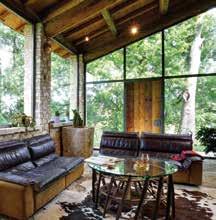
253
THE PLACE FIRENZE energia contemporanea nel cuore di Firenze contemporary power in the heart of Florence

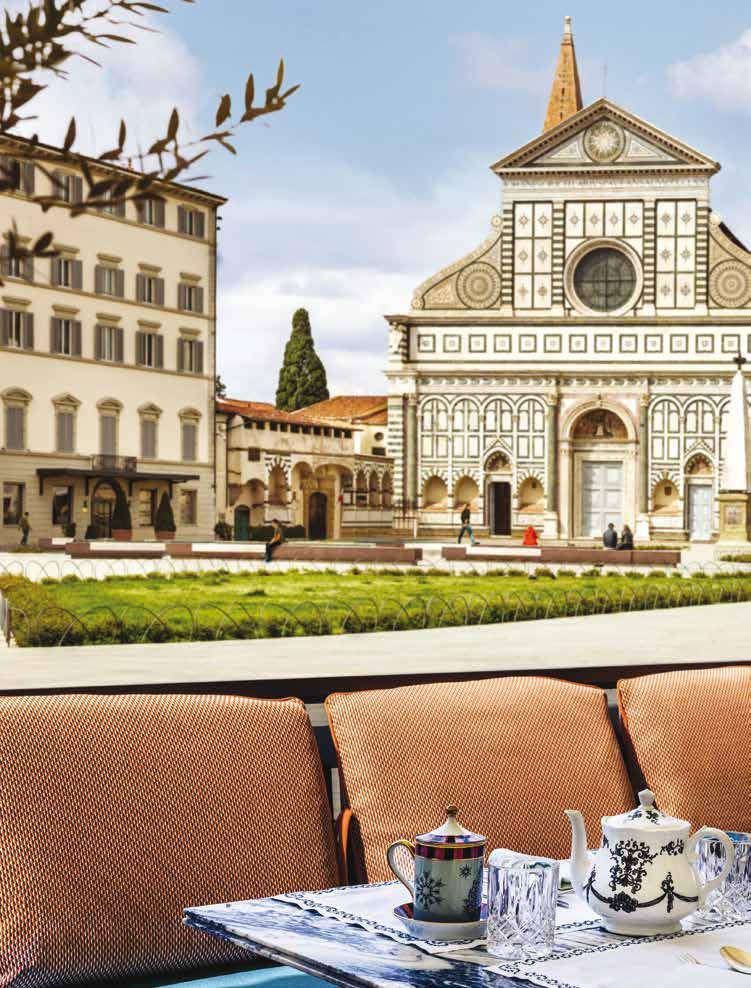
FIRENZE
The Place Firenze

TOSCANA
UNA DIMORA SENZA TEMPO nella vibrante città toscana
The Place Firenze mira a proporre una nuova e originale Ospitalità Italiana e a diventare un punto di riferimento per i viaggiatori che cercano non solo un luogo dove soggiornare, ma un elegante “chiave di accesso” che permetta loro di entrare intimamente nella vita della città, connettersi con le sue persone e condividerne momenti di arricchimento e conoscenza. L’hotel di 20 camere dalla meticolosa attenzione ai dettagli e dal servizio curato e su misura, sorge nella storica Piazza di Santa Maria Novella su cui si apre il nuovo e scenografico Dehor “The Terrace”, pensato per essere un luogo urbano e d’incontro fruibile durante tutta la giornata. L’interno è caratterizzato da scelte cromatiche sui toni degradé del verde con tocchi di colori forti a contrasto, quale il giallo becco d’oca o il rosso brick dei dettagli tessili. Sale e salette arricchite da camini e angoli lettura si aprono in successione, definendo uno stile di ospitalità unico. “The Kitchen & The Bar” infine, con la nuova e spaziosa Sala Ristorante i cui tavoli sono allineati lungo la galleria degli specchi, propone la raffinata cucina dello Chef Asso Migliore e un intimo ed elegante American Bar.
A TIMELESS HOUSE IN THE VIBRANT TUSCAN CITY
The Place Firenze aims to trace a new and original Italian Hospitality and to become a reference point for travelers looking not only for a place to stay, but an elegant “access key” that allows them to enter intimately into the life and the folds of the city, connect with its people and share moments of enrichment and knowledge. The 20-room hotel with meticulous attention to detail and person-to-person service, stands in the historic square of Santa Maria Novella, overlooked by the stunning al fresco space “The Terrace”, designed to be an urban all-day meeting venue. Inside it is by Chromatic choices in faded tones of green and textiles styled in strong, contrasting colours, including duckbill yellow and brick red. Shared spaces have been redesigned so that sightlines connect rooms embellished by cozy fireplaces and reading corners, defining a unique syle of hospitality. Finally, “The Kitchen & The Bar” with the new, sleek restaurant, whose tables are lined by a gallery of mirrors, offers the sincere and refined cuisin of Chef Asso Migliore and an intimate and stylish American Bar.

256


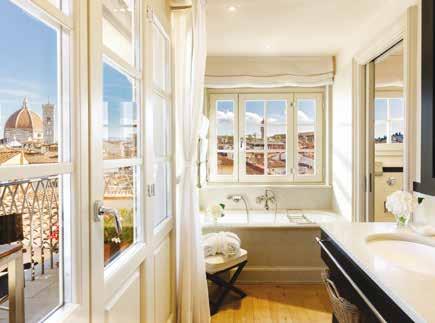
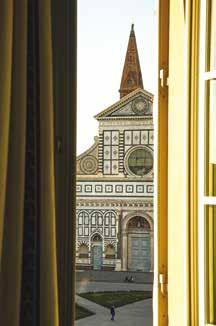



257
Fondazione COTARELLA

DI VITA
Dalla mente di tre cugine di sangue e “sorelle” d’amore, Dominga, Enrica e Marta Cotarella, figlie dei due enologi Riccardo e Renzo Cotarella, e oggi capitane del brand vitivinicolo Famiglia Cotarella con base nell’Alta Tuscia, a cavallo tra Umbria e Lazio, è nata da poco più di un anno la Fondazione Cotarella.
Fondazione Cotarella prende vita da una storia personale: una febbre reumatica da streptococco colpisce uno dei due figli di Dominga. Per fortuna cure tempestive lo salvano, ma il bambino dovrà proseguire con cure costanti fino ad oltre la maggiore età. Il bambino chiede però alla madre di trasformare quella esperienza in “una cosa bella”. E così nasce nell’aprile 2021 Fondazione Cotarella.
258 ALIMENTARSI
Dominga Cotarella
Il progetto si declina in tre aree con altrettanti obiettivi: tutelare e promuovere il territorio, anche dal punto di vista turistico; offrire supporto ai giovani con disturbi del comportamento alimentare, promuovendo stili di vita sani, dove il cibo e la natura sono centrali; facilitare le relazioni adulti e giovani.
Anoressia, bulimia e binge eating, o disturbo da alimentazione incontrollata, sono la seconda causa di mortalità fra i giovani, dopo gli incidenti stradali. I disturbi alimentari colpiscono soprattutto gli adolescenti e la cosiddetta prima età adulta, e si sono molto acuiti durante la pandemia. In Italia, circa 3 milioni di persone soffrono di disturbi alimentari, secondo un’analisi del 2021, e di questi il 96% sono donne.
Per la cura e la prevenzione dei DCA sono necessari la creazione di comunità terapeutiche, la ricomposizione dei nuclei di appartenenza e la presenza di qualcuno a cui chiedere aiuto.
Fondazione Cotarella nasce con questa mission: prendere per mano le persone ancora smarrite dopo la malattia, con un supporto scientifico, elaborando percorsi e interventi efficaci che portino al benessere delle persone e delle famiglie che si rivolgono a noi. Nasce in Umbria, ai confini con l’alto Lazio, in un crocevia di tradizioni e di segni che la storia ci chiede di conoscere e di tramandare.


259
Si avvale di uno staff di collaboratori che portano avanti progetti di riabilitazione e di cura, ma anche di sviluppo del territorio, finalizzati alla rivalorizzazione delle aree rurali, orientando nella corretta direzione le motivazioni che ispirano scelte alimentari disordinate e non funzionali, promuovendo la cultura di una sana genitorialità, capace di educare con l’esempio, e idonea a riconoscere, accogliere e correggere disfunzioni e abitudini tossiche o dannose.
La Fondazione si dirama in molteplici sedi: da Fattoria Tellus, la fattoria integrata inclusiva, che ospita attività ed esperienze dedicate ad alimentazione e natura, alle Residenze Esperienziali, che accolgono le persone bisognose di ritrovare se stesse all’interno di un rapporto più armonico con l’ambiente e il cibo, fino alla Scuola di Formazione, all’Osservatorio e al Centro Ricerche riservati a studi approfonditi sul tema sopracitato e ai disturbi correlati.

Grande attenzione viene rivolta alla prevenzione e a quella che definisce la fase successiva al termine del percorso terapeutico o clinico, al momento in cui per i ragazzi inizia la fase delicata del reinserimento in famiglia, a scuola o al lavoro. Per questo, vengono ad esempio realizzati laboratori di cucina per trasformare le materie prime in cibi sani e nutrienti tra cui possiamo citare quello con lo Chef Ciro Scamardella, l’altro con Riccardo Di Giacinto, quello con gli Chef Alessandro Negrini e Fabio Pisani. E l’ultimo da Gianfranco Pascucci. La Fondazione è anche all’opera nella raccolta di fondi per dare vita a un centro evoluto di ascolto per genitori e ragazzi e in merito alle comunità e allo sviluppo del territorio la Fondazione è promotrice e organizzatrice, insieme al Consorzio Orvieto Way of Life di “Orvieto città del gusto, dell’arte e del lavoro”.


260
Martina Colombari
Da sinistra/from left: Enrica, Dominga, Marta Cotarella
FONDAZIONE COTARELLA
FEEDING ON LIFE
Three cousins by blood and sisters by love, Dominga, Enrica and Marta Cotarella, daughters of two brothers, Riccardo and Renzo Cotarella, both enologists. Today, these ladies are the captains of the Famiglia Cotarella wine brand, with headquarters in Alta Tuscia, in Umbria, at the border with Lazio. From their minds stemmed Fondazione Catarella, a little more than a year ago.
Fondazione Cotarella stems from a personal story: one of Dominga’s two children was hit by a streptococcus rheumatic fever. He was lucky to have been treated early, but he will need constant follow-ups and treatment until he comes of age. But he asked his mother to turn that experience into “something beautiful”. This is how Fondazione Cotarella was born, in April 2021.
The project is articulated in three areas, each with its own goals: to protect and promote the territory, also from the standpoint of tourism; to offer support to young people with food disorders, promoting healthy lifestyles that focus on food and nature; to facilitate relations between adults and young people.

Anorexia, bulimia and binge eating, or uncontrolled eating disorder, are the second cause of mortality among young people, second only to road accidents. Eating disorders affect mainly adolescents and the so-called young adults, and they were exacerbated during the pandemic. In Italy, about 3 million people suffer from eating disorders, according to a 2021 analysis, and 96% of these are women. Treating and preventing eating disorders require the creation of therapeutic communities, the recompositing of families and groups, and the presence of someone to whom affected people can ask for help.
Fondazione Cotarella was created with this mission: to take the hand of people who still feel lost after the disease, with scientific support, creating effective trajectories and interventions that lead to the well-being of those affected and of their families, when they come to us for support. It was founded in Umbria, at the border with Lazio, in a crossroads of traditions and signs that history requests us to know and hand down.
The Foundation boasts a staff that work on rehabilitation and treatment projects, but also of territory development with the goal of once again appreciating rural areas, properly redirecting
261
Da sinistra/from the left: Tomaso Trussardi, Sara Farnetti
the motivations behind disorganised and non-functional diet choices, promoting the culture of healthy parenting that can educate through example and suitably recognise, embrace and correct dysfunctions and toxic or harmful habits.
The Foundation is articulated in various branches: from Fattoria Tellus, the inclusive integrated farm that hosts activities and experiences dedicated to nutrition and nature, to Experience Residences that welcome those in need of once again finding themselves within a more harmonic relationship with the environment and with food, all the way to our Training School, our Observatory and the Research Centre, dedicated to more detailed studies on the subjects above and to related disorders.
Much focus is given to prevention and to that which defines the
phase that follows the end of the clinical or therapeutic trajectory, the moment in which young people face the beginning of the delicate phase of returning to their families, school or job. With this purpose in mind there are, for example, cooking workshops to transform raw materials into healthy and nutritious dishes. Some of these workshops are led by Chefs Ciro Scamardella, Riccardo Di Giacinto, Alessandro Negrini, and Fabio Pisani. The last workshop is led by Gianfranco Pascucci. The Foundation is also working on raising funds to give life to an advanced listening centre for parents and young people. As for local communities and territory development, the Foundation promotes and organises, together with the Orvieto Way of Life Consortium, the “Orvieto, city of taste, art and work” event.
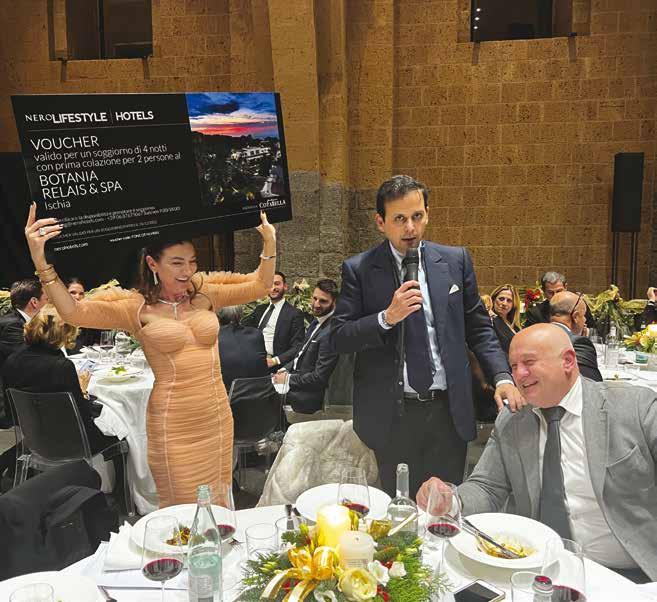
262
Da sinistra/from the left: Elisabetta Franchi, Andrea Gemma, Pierluigi Zagni
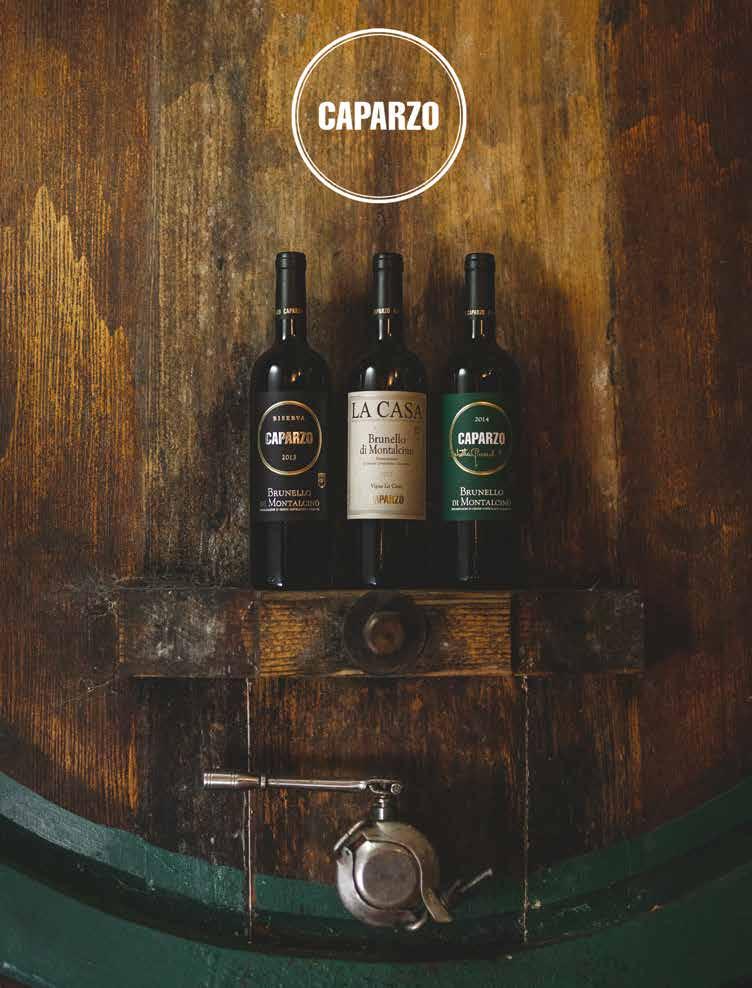

CATRINEL MARLON
TESTIMONIAL NERO LIFESTYLE, NUOVO DIRETTORE CREATIVO PER NANÀN
,
Nanàn, azienda Made in Italy di moda dedicata all’infanzia, nell’anno del suo trentennale ha scelto Catrinel Marlon come nuovo Direttore Creativo, per una comunicazione del brand più efficace, moderna e rivolta al futuro. Con una carriera di modella e attrice alle spalle, oltre che di ambassador per brand come Chopard e NERO Lifestyle, Catrinel Marlon è la persona giusta in grado di inserire il brand Nanàn nel contesto artistico contemporaneo ed internazionale. L’utilizzo di materiali organici, trattati con prodotti naturali, e la creazione di articoli destinati a durare nel tempo, in modo che vengano tramandati di generazione in generazione diminuendo l’impatto del processo produttivo, è l’obiettivo principale di Nanàn, che Catrinel contribuirà a perseguire: “ Portare il brand a un alto livello: vogliamo rendere Nanàn più green e sostenibile, utilizzando materiali destinati a durare, in modo che i capi possano essere tramandati e scambiati. Puntiamo a creare un abbigliamento comodo e morbido in cui i bambini possano sentirsi a proprio agio e che amino ”. Il nuovo Direttore Creativo guiderà la creazione di spot cinematografici e vetrine dall’aspetto scenografico, per offrire ai clienti del marchio un’esperienza che coinvolga arte e cultura a 360°. Il marchio trova la propria forza nella qualità del Made in Italy, che, grazie al profilo internazionale di Marlon, potrà essere esportata nel resto del mondo. All’attivo Nanàn possiede boutique e flagship store in 15 Paesi, tra cui Giappone, Emirati Arabi, Kuwait, Qatar e Albania. Il brand è stato fondato nel 1992 da Franca Mentana che insieme alla figlia Licia Angeli ha concepito e portato Nanàn al successo. Nel 2019 entra a maggioranza Annabel Holding di proprietà di Nicola Bulgari, dando inizio allo sviluppo internazionale.
CATRINEL MARLON, TESTIMONIAL OF NERO LIFESTYLE, NEW CREATIVE DIRECTOR FOR NANÀN
Nanàn, a Made in Italy fashion company dedicated to children, chose Catrinel Marlon as the new Creative Director in the year of its thirtieth anniversary, to promote more effective, modern and forward-looking brand communications. With a career as a model and actress behind her, as well as ambassador for bran ds such as Chopard and NERO Lifestyle, Catrinel Marlon is the right person to put the Nanàn brand in the contemporary and international artistic context. Nanàn’s mission is to manufacture garments using naturally processed organic materials so that they are handed down from generation to generation, reducing the impact of the production process, which Catrinel will help to pursue: " Bringing the brand to a high level: we want to make Nanàn greener and more sustainable, using materials designed to last, so that the garments can be handed down and exchanged. We aim to create comfortable and soft clothing that children can wear comfortably and love ”. The new Creative Director will guide the creation of TV commercials and showcases with a theatrical aspect, to offer brand customers an experience that fully involves art and culture. The brand’s strength is its innate Made in Italy quality, which, thanks to Marlon's international profile, can be exported to the rest of the world. Nanàn currently owns boutiques and flagship stores in 15 countries, including Japan, the United Arab Emira tes, Kuwait, Qatar and Albania. The brand was founded in 1992 by Franca Mentana who, together with her daughter Licia Angeli, conceived and led Nanàn to its current success. In 2019, Annabel Holding, owned by Nicola Bulgari, became the majority shareholder, initiating international growth.
265
VULCANO

THERASIA RESORT SEA & SPA di fronte ai faraglioni di Lipari overlooking the “faraglioni” of Lipari

Therasia Resort Sea & Spa

SICILIA
LA QUIETE INCANTATA dell’arcipelago eoliano
Sull’isola di Vulcano, circondato dalla natura incontaminata di Vulcanello, con l’orizzonte aperto sul mar Mediterraneo, sorge il Therasia Resort Sea & Spa, in cima al promontorio, di fronte ai faraglioni di Lipari, nella quiete incantata dell’arcipelago eoliano. I toni chiari in superbo contrasto con la nera pietra vulcanica, le linee armoniose dell’architettura mediterranea, uniti all’eleganza degli arredi, rendono gli ambienti caldi ed accoglienti. Il luogo ideale per vivere il mare intensamente ma anche per trascorrere vacanze in pieno relax circondati da un’atmosfera intima, elegante e raffinata. Una stupenda piscina sul mare dove rilassarsi lasciandosi andare all’energia dell’idromassaggio e un centro benessere con un’ampia gamma di trattamenti viso e corpo per rigenerarsi e ritrovare la forma migliore. Magnifiche terrazze per godere dei bellissimi panorami di giorno o per assistere a romantici tramonti di sera accompagnati dal dolce ritmo della musica dal vivo. Completano l’offerta una colazione all’insegna della tradizione e della ricerca e tre soluzioni ristorative, tra cui il ristorante Stella Michelin Il Cappero, che rielabora la generosa cucina locale con fantasia e sentimento.
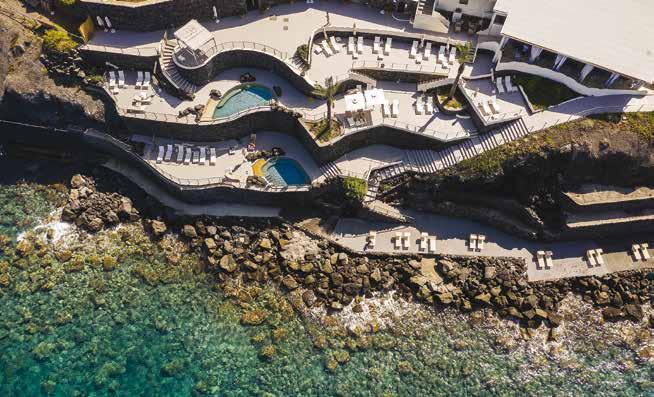
THE ENCHANTINGLY QUIET OF THE AEOLIAN ISLANDS
On the island of Vulcano, surrounded by the unspoilt nature of Vulcanello with the open horizon of the Mediterranean sea, lies Therasia Resort Sea & Spa. Set on a promontory overlooking the spectacular “faraglioni” of Lipari, the resort boasts enchantingly quiet surroundings and breathtaking views of the entire Aeolian Islands. Soft, light hues contrast with the black volcanic lavic stone, together with harmonious Mediterranean architecture united with elegant furnishings give a warm and welcoming atmosphere. The resort is the perfect place for whiling away the hours by the deep blue sea in a relaxing, intimate and elegant environment. A splendid pool with overlooks the sea, ideal for unwinding with the energy of the hydro-massage. The resort is also home to a Wellness centre offering a wide range of face and body treatments, helping you to rejuvenate and get back to shape. The resort’s magnificent terraces with breathtaking views boast memorable sunsets accompanied with the sweet rhythm of live music.
A daily breakfast is served, in a spirit of tradition and research. Three restaurants are also available, one of them is the Michelin starred Il Cappero, that re-invents the rich local tradition using sentiment and creativity.
268


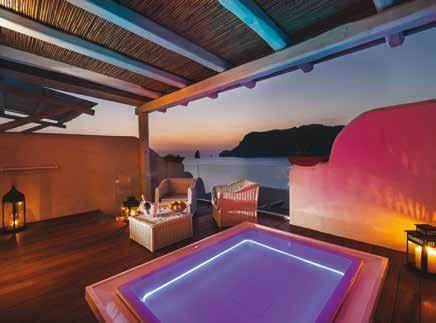



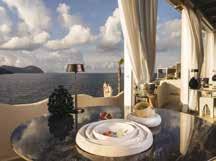
269
SIRMIONE
VILLA
and

CORTINE PALACE HOTEL romantica e preziosa precious
romantic
Villa Cortine Palace Hotel
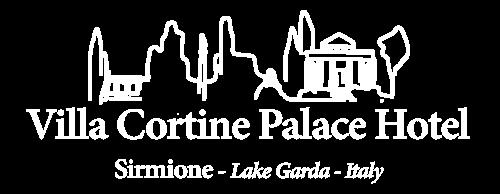

LOMBARDIA
UNA PREZIOSA DIMORA sul Garda, nel cuore di Sirmione

Il Villa Cortine, ufficialmente aperto come Hotel di lusso dal 1953, è la preziosa dimora sul Lago di Garda dove venire a trascorrere momenti di riposo, dove cercare l’ispirazione e ritrovare la carica, dove rinfrancare lo spirito, dove riscoprire il proprio lato romantico e dove festeggiare le ricorrenze più importanti per farle diventare istantanee indimenticabili della vita. L’orgoglio del Villa Cortine Palace Hotel è il grande parco di 5 ettari, completamente affacciato sul lago, che circonda per intero la struttura, rendendola invisibile ai passanti, garantendone così la massima riservatezza ed esclusività.
Grandi alberi secolari e maestose conifere riescono a coesistere, grazie al clima dolcissimo, con palme ad alto fusto, cespugli di lantana, ortensie, corbezzolo, mirto, corniolo.
Angoli inaspettati scavati nella roccia, percorsi romantici, luoghi da meditazione, magnifiche fontane, statue neoclassiche, e balconate naturali completano la magia di un luogo unico sul Lago di Garda.
L’hotel, oltre alle 54 camere tutte viste lago e arredate con gusto classico, vanta spazi comuni di grande pregio artistico, 3 ristoranti con differenti concept, una piscina panoramica riscaldata e un pontile privato di 500 mq.
A PRECIOUS HOUSE ON LAKE GARDA, IN THE HEART OF SIRMIONE
The Villa Cortine Palace Hotel, open as 5-stars luxury Hotel since 1953, is a precious house on the Lake Garda, where you can come and relax, where you can find new inspiration, recharge, refresh your spirit, rediscover your romantic side and celebrate the most important anniversaries and occasions to keep the memory of them forever.
The big park, 5 hectares, fully facing the lake, surrounding the whole venue, is the the pride of the Villa Cortine Palace Hotel, making it invisible to onlookers and thus ensuring maximum privacy and exclusivity.
Big centuries-old trees and conifer trees can coexist, thanks to the mild climate, with high palms, lantana bushes, hydrangeas and myrtle.
Unexpected alcoves carved in the rock, romantic paths, meditation places, magnificent fountains, neoclassical statues, and natural balconies complete the magic of a unique place on the Lake Garda.
The hotel, in addition to the 54 rooms all overlooking the lake and decorated in classic style, boasts artistically designed common areas, 3 restaurants with different concepts, a panoramic heated swimming pool, and a 500-square-meter private pier.
272





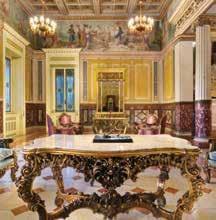

273

274

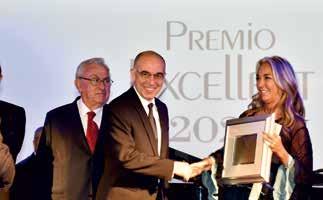






275


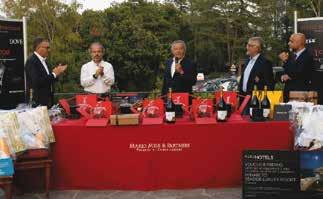

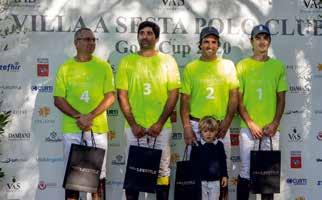
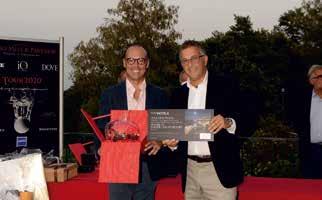


276



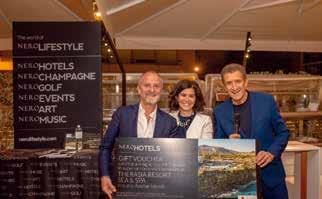



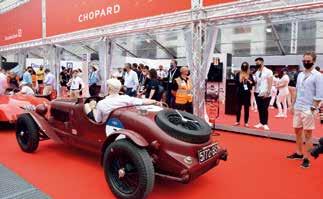
277
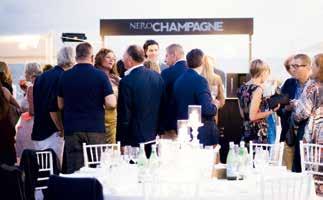

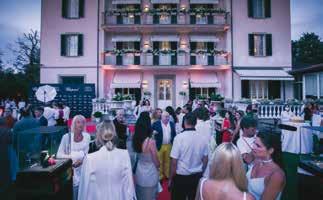





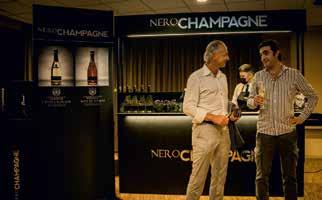
278

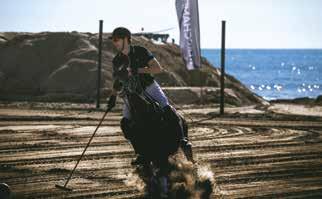



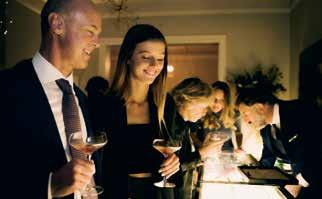
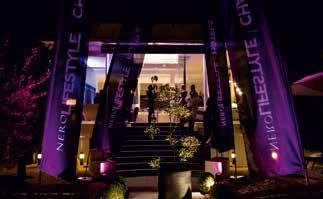
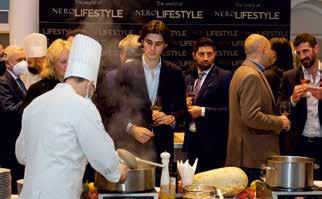
279








280


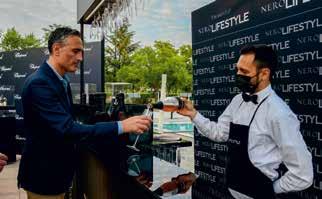


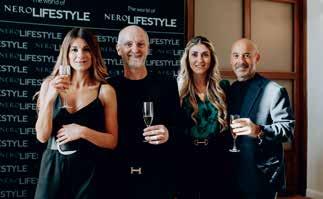

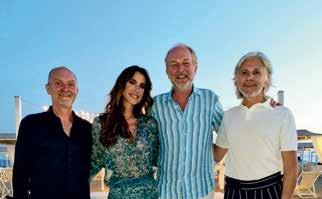
281







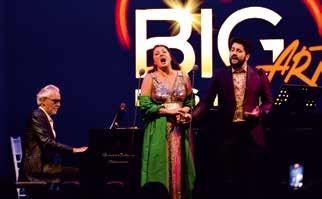
282

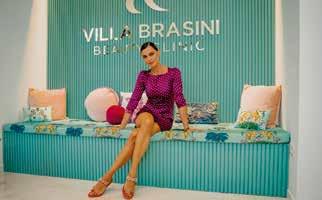

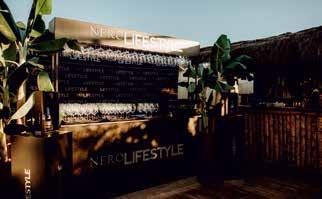

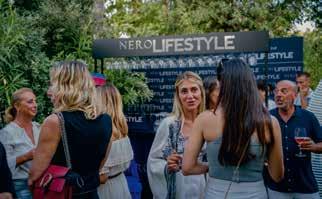


283

284

285









287






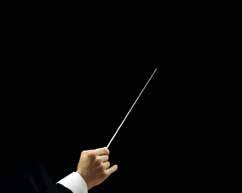



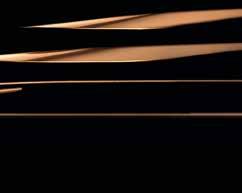















 di/by Enzo Millepiedi
di/by Enzo Millepiedi












































































































































































































































 di/by: Renato Palazzi photo: Lavinia Colonna Preti @lombardiasecrets
di/by: Renato Palazzi photo: Lavinia Colonna Preti @lombardiasecrets





























 di/by:
di/by:























































































































































































 Cerrado
Cerrado







































































































































































